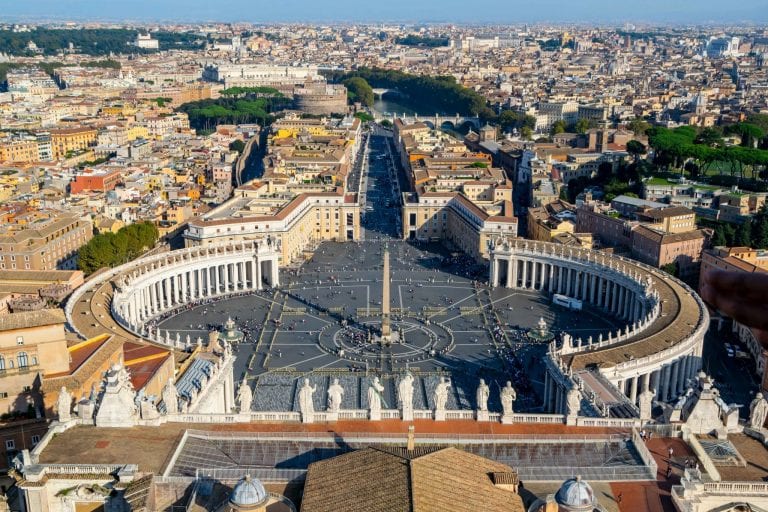

The Ultimate 4 Days in Rome Itinerary (+ Map & Tips!)
Dreaming of staring in awe at the Sistine Chapel, stepping inside the Colosseum, tossing a coin into the Trevi Fountain, and eating some of the best pasta of your life? If so–this 4 day Rome itinerary is for you!
The capital of Italy is an endlessly enchanting place, and one of our favorite cities in the world–and after spending 4 days in Rome, we think you’ll agree.
Home to incredible art, one of the most beloved cuisines on the planet, an endless number of neighborhoods to explore, and impressive history that has been folded into the very fabric of modern Rome–not to mention the fact that there’s literally another country nestled inside the city–it’s impossible to avoid finding something to love about Rome.
… That is, as long as you know where to look.
After many repeated trips to Rome (including 2 trips where we rented an apartment in Rome for an entire month), we have lots of advice to share–and luckily, a 4 day trip to Rome gives you quite a bit of time to work with!
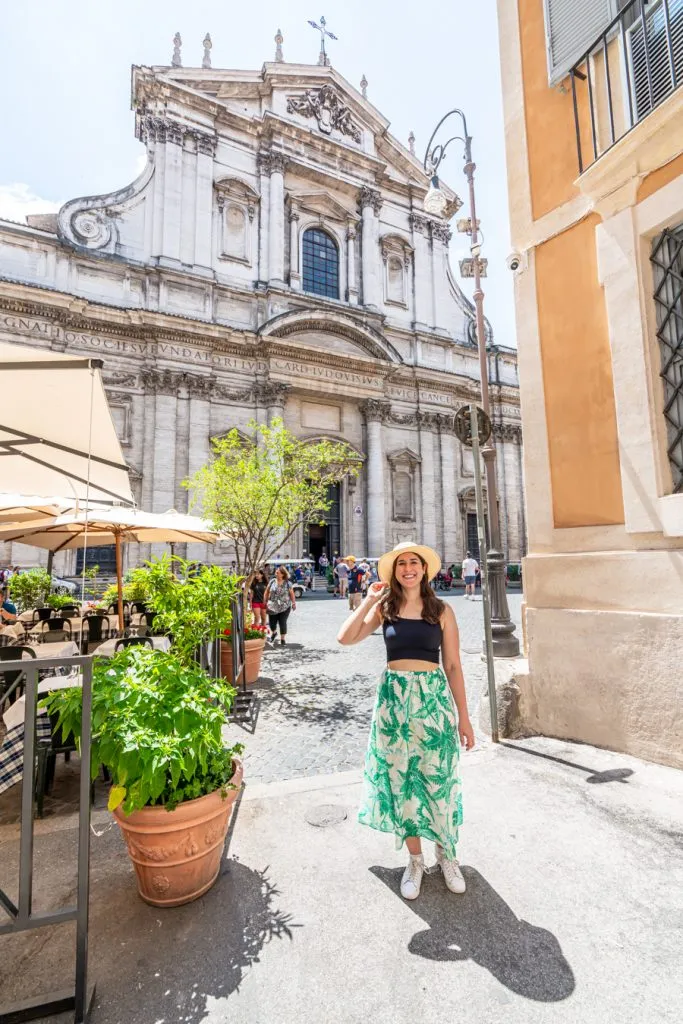
Some links in this post may be affiliate links. If you make a purchase through one of these links, we may earn a small commission at no extra cost to you. Please see our disclosure policy for more detail.
You’ll have the opportunity to see Rome’s iconic highlights and also weave in some more offbeat experiences, including some interesting under-the-radar spots that hide in plain sight.
This 4 day Rome itinerary winds its way through several neighborhoods and historical time periods, focusing on 1-2 geographic areas each day.
We’ve designed this itinerary for Rome in 4 days with a traveler taking their first trip to Rome in mind, but we hope even return visitors will find something new to love here!
(Also, thanks in part to the fact that I can’t always resist the temptation to point out nearby hidden gems and unique details, this is a very long Rome blog post! Feel free to use the table of contents below to navigate to the section you’re looking for.)
Table of Contents
How We Structured This Rome Itinerary
The perfect 4 day rome itinerary, where to stay for 4 days in rome, more than 4 days in rome.
- Getting Around During 4 Days in Rome, Italy
Safety Tips for Your Rome Itinerary
The best time to visit rome, what to pack for visiting rome, italy, map of your itinerary for rome, italy.
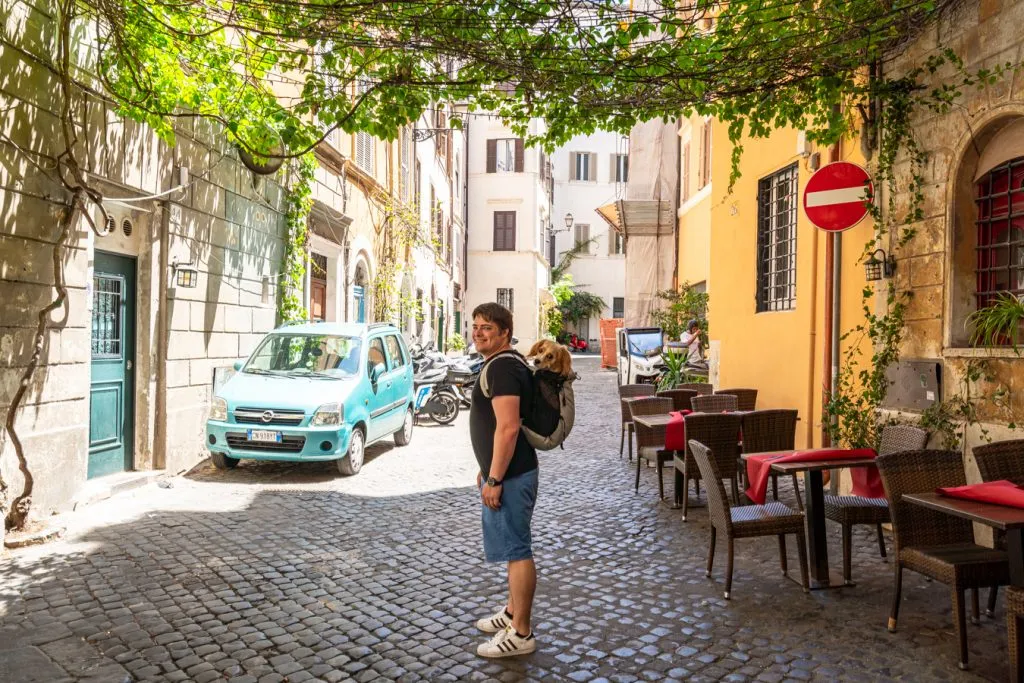
We’ve spent months playing tourist in Rome over the course of many, many trips–including twice where we stayed in town for a month straight!
We initially crafted this Rome itinerary after our first month-long stay in the city, and since then it has (like most of the other itineraries on Our Escape Clause ) been a living document, updated with each return visit to our favorite city.
From the best things to do in Rome to what attractions to skip, we’ve packed this travel guide with everything that we know about planning the perfect trip to Rome.
This itinerary is designed for first-time visitors to The Eternal City who are hoping to hit all the top attractions but also hope to see some of Rome’s many hidden gems too.
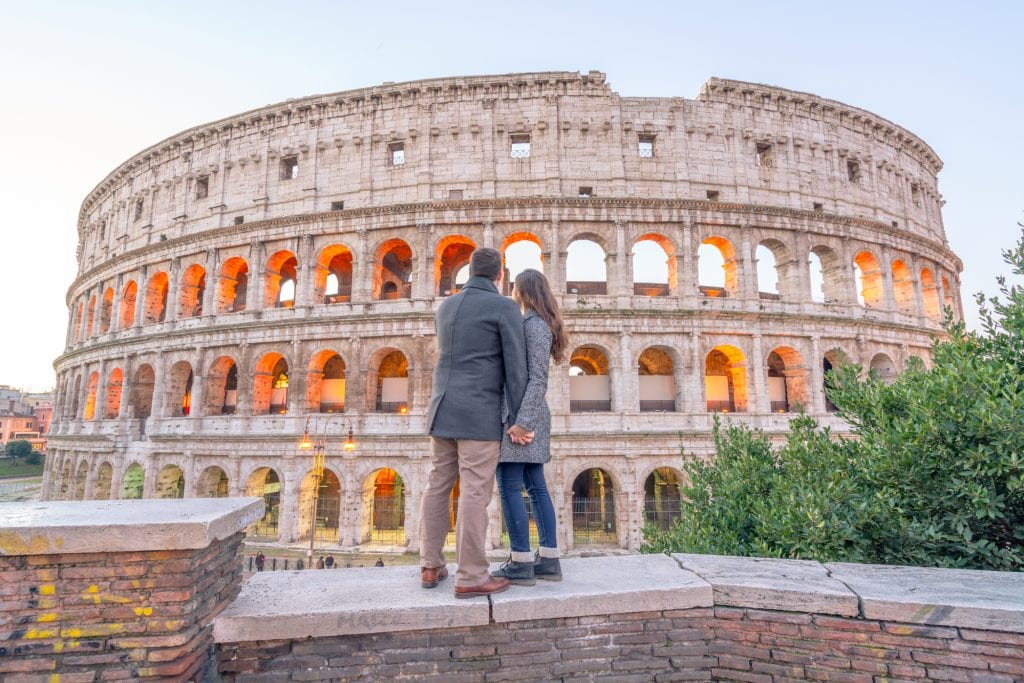
We’ve also included a downloadable map of each day’s route at the bottom of this blog post to help you navigate the city as you explore.
While 4 days in Rome is long enough that you could very reasonably take one day to enjoy one of the best day trips from Rome , there is simply no limit to the number of captivating things you can find within the city itself, and we’ve planned this itinerary with that in mind.
Once you finish this post, you may also want to check out our posts on what to eat in Rome , where to find the best views of Rome , and our top Rome travel tips !
If you’re interested in shorter Rome itineraries, we have 2-day and 1-day versions here on Our Escape Clause as well.
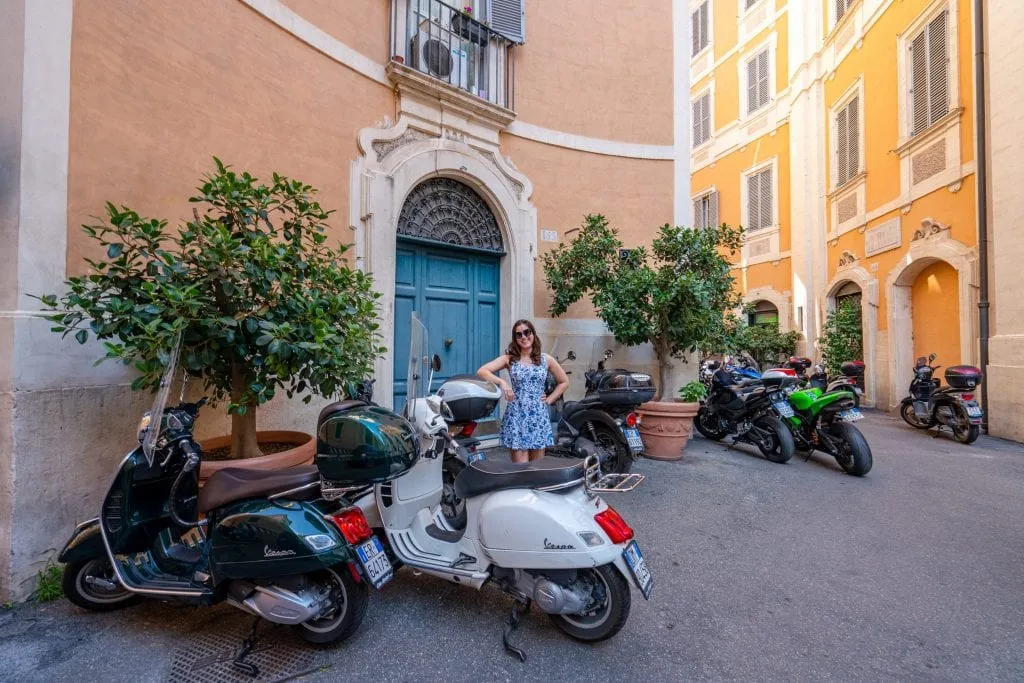
Day 1 in Rome: The Colosseum, Roman Forum, The Jewish Ghetto + Beyond
Start your trip to rome at the colosseum..
What better place to start your 4 days in Rome itinerary than at one of the most iconic sights in the world?
Step inside the Colosseum and marvel at the ancient history beating inside–but before you do, be sure to climb the steps on the north side of the Colosseum (turn left after exiting the Colosseo metro stop) and get those classic photos in front of the Colosseum’s exterior.
Before starting your day at the Colosseum, you’ll want to book tickets ahead of time to skip the (legendary) line.
With 4 days in Rome to work with, you may be willing to wait in what are often very long lines, but if you hate lines as much as we do, you’ll consider the small extra cost well worth it.
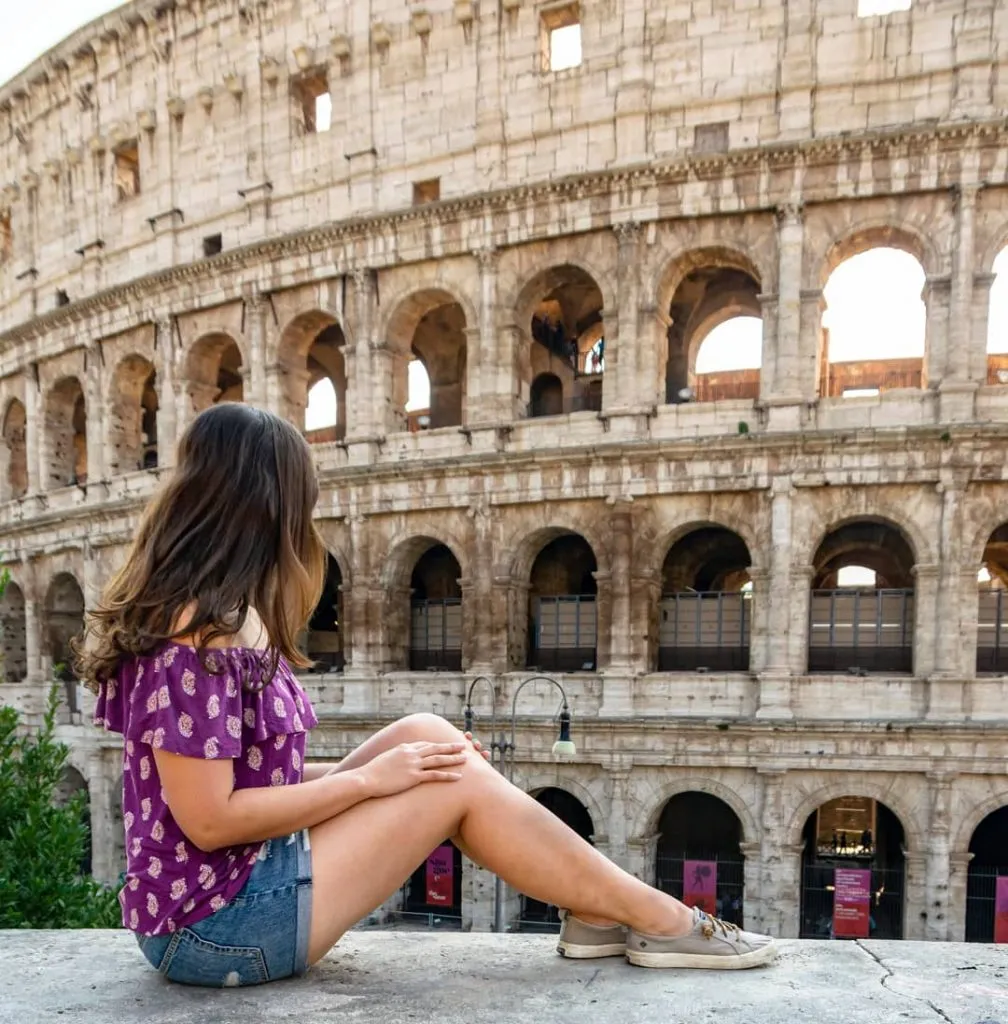
Trying to decide whether or not to take a guided tour?
Guided tours are typically sold as a package that includes the Colosseum, Roman Forum, and Palatine Hill.
Our personal take is that the tour of the Colosseum isn’t as necessary… but it’s absolutely worth it to have a guide for the Roman Forum and Palatine Hill, and therefore recommend signing up.
This is the tour we took and greatly enjoyed (though fair warning, our guide’s passion meant that the tour did run past its predicted time).
And, while we didn’t structure this itinerary for Rome this way, I do want to mention that we have also toured the Colosseum at night and loved it–if that’s something that appeals to you, you can easily adjust this itinerary to accommodate it ( this is the tour we loved ).
Book your tour of the Colosseum, Roman Forum, and Palatine Hill today! Prefer to explore independently? Grab your skip-the-line ticket now!
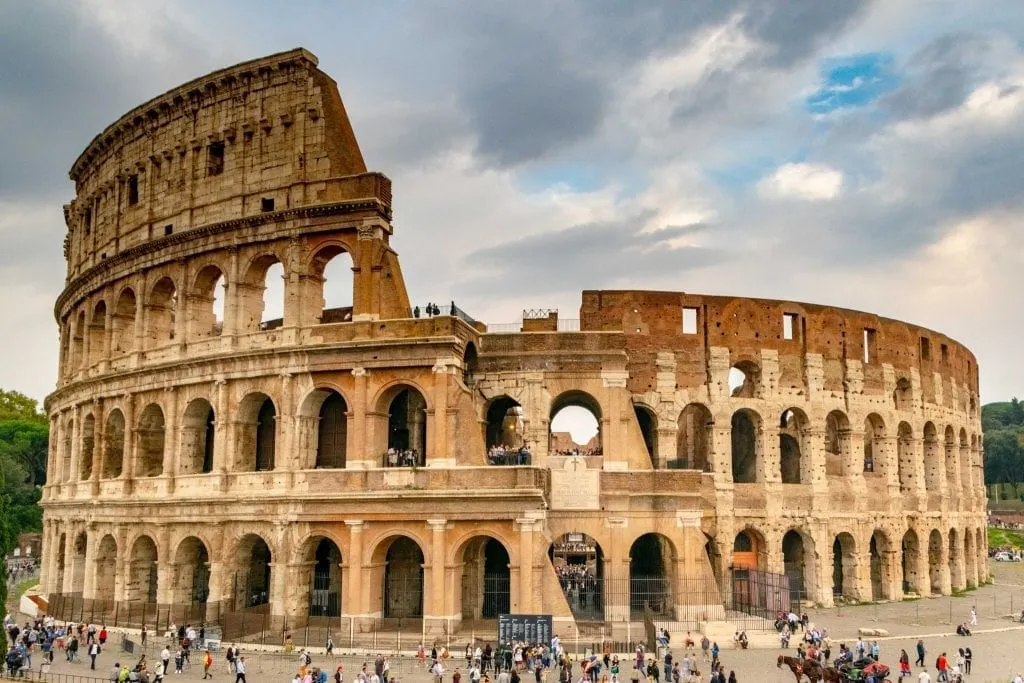
Head to the Roman Forum and Palatine Hill.
Less than a 5-minute walk from the Colosseum, depending on the entrance and exit used.
While the Colosseum is one impressive monument of Ancient Rome, the Roman Forum and Palatine Hill boast several!
From senate houses to public squares to palaces, these areas are archaeological and historical treasure troves.
They are absolutely best appreciated with a guide–I can’t even describe how much more we got out of our guided visit than our unguided ones, especially on the lower level of the Forum!
If all goes well, you should walk away in awe of both the depth and breadth of history in the Eternal City.
After touring the Roman Forum and Palatine Hill both with a guide and without, we strongly believe that the context given by a guide is well worth the price. We used and loved this tour –and while the Colosseum guide was less necessary, having the Colosseum skip-the-line portion and tour included definitely helped justify the cost! Book your guided tour of the Roman Forum and Palatine Hill today!
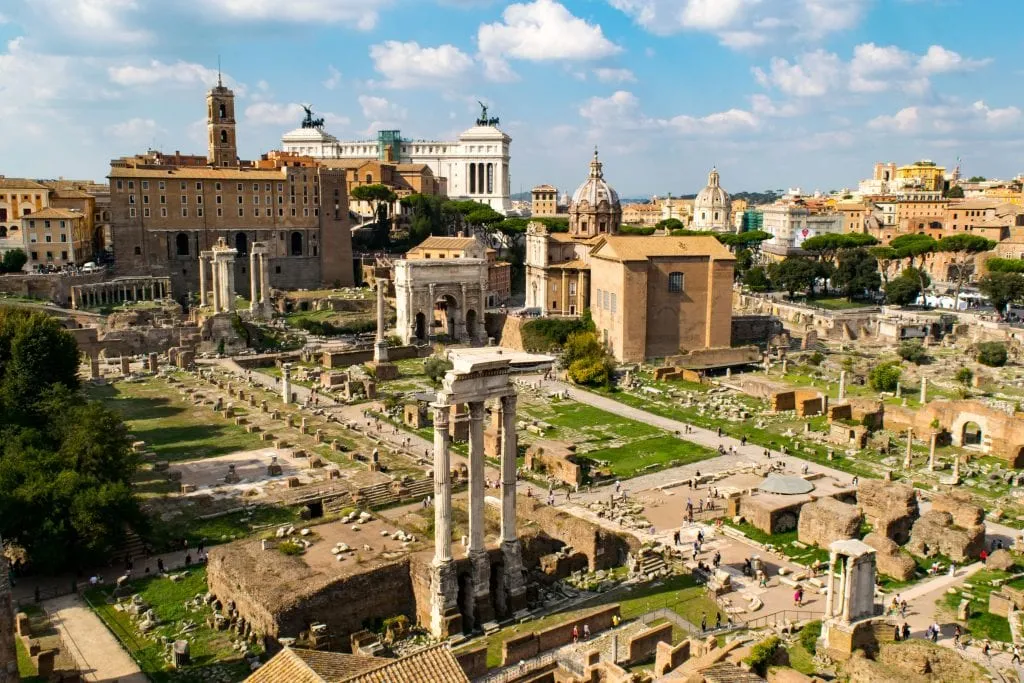
Check out the additional forums.
About a 10-minute walk from the Roman Forum, depending on the entrance and exit used.
Though the Roman Forum is the most popular to visit, it’s far from the only remaining forum of Ancient Rome visible in the city today.
The Imperial Forum, Forum of Augustus, Forum of Caesar, and more are all just a short walk away from the famous Roman Forum.
And, unlike the Roman Forum, all of the other ancient forums are free to enter.
Though visiting all the forums is probably a little much for all but a passionate Ancient Roman historian, be sure to at least slow down look enough to take a peek at one or two during your 4 days in Rome!
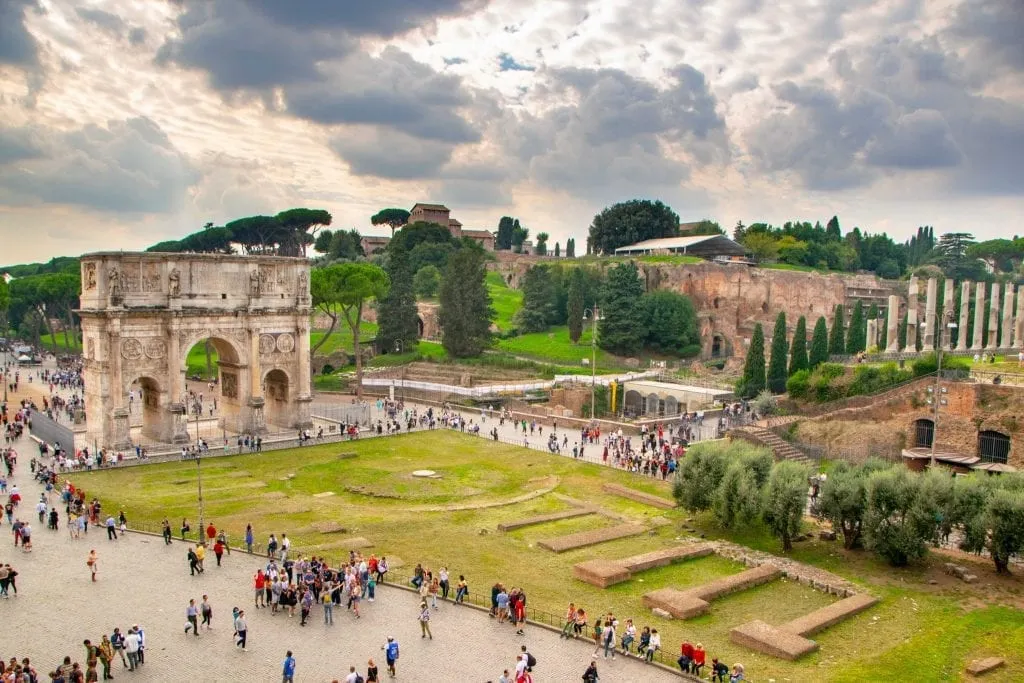
Stop by Piazza Venezia and Piazza del Campidoglio.
10-minute walk from the Forum of Augustus.
The Piazza del Campidoglio is one of my personal favorite piazzas in Rome .
Shaped into a perfect oval and surrounded by beautiful buildings, it is a peaceful place to relax for a moment and take in the fact that you’re in Rome.
If you stop by on a Saturday as we did during one of our trips to Rome, you’ll likely also have the chance to admire lots and lots of wedding parties!
The piazza’s beauty isn’t particularly surprising when you know who designed it: Michelangelo himself.
While we haven’t specifically included them on this 4 day Rome itinerary (sadly there’s not time for everything!), it’s worth pointing out that this is also where you’ll find the main section of the Capitoline Museums , which have an incredibly impressive collection of Ancient Roman statues, among other things.
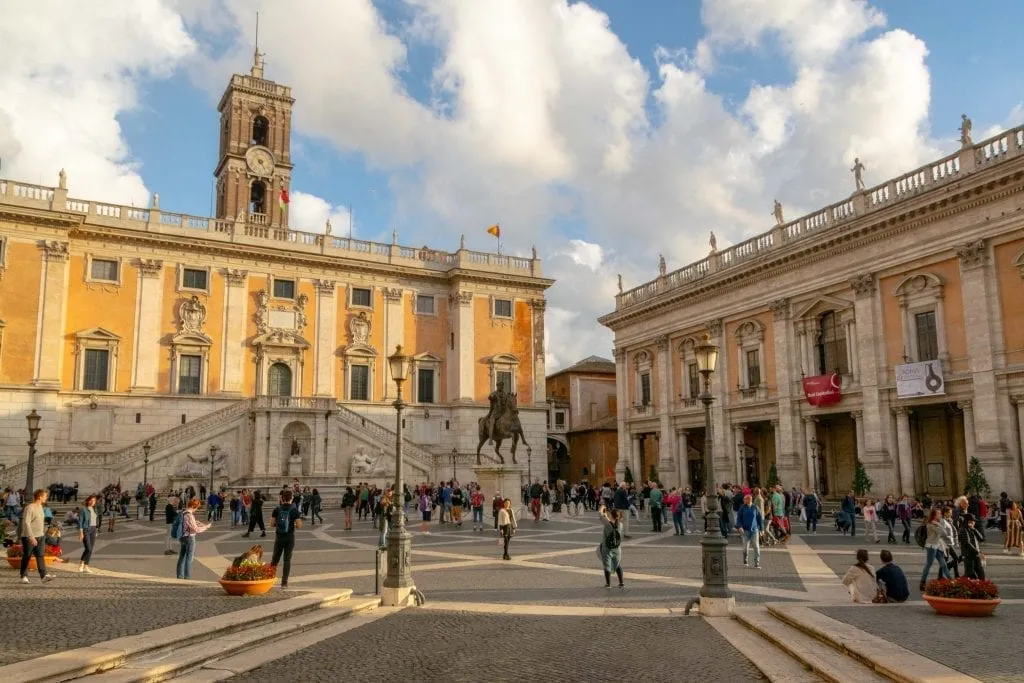
If you tend to prefer quieter museums, you can consider adding a visit here!
(In any other city, they’d be packed–but the Capitoline Museums have some legendary competition when it comes to museums in Rome to visit).
On your way to the Piazza del Campidoglio, you’ll also pass right by the Piazza Venezia, with the impressive Altar of the Fatherland (the enormous white building topped with chariots that is visible from just about every viewpoint in Rome) dwarfing everything around it.
Since you were just on Palatine Hill, climbing it isn’t necessary–but it is home to one of the best views of Rome if you’d like to see it for yourself!
The monument was built in honor of Victor Emmanuel II, the first king of unified Italy.
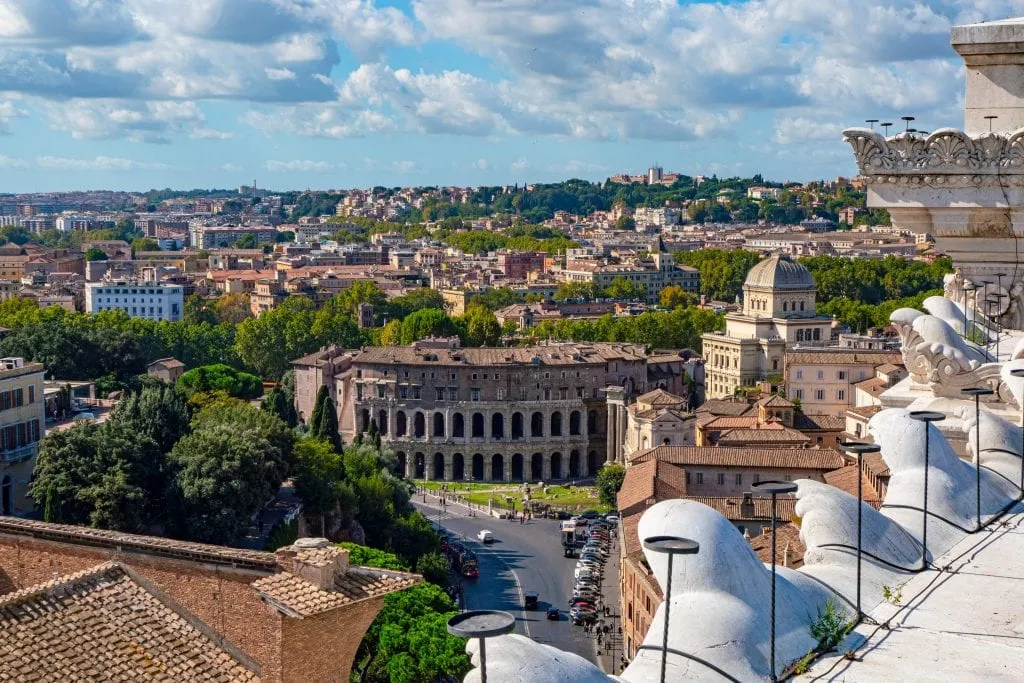
Pay a visit to the Campo de’Fiori.
14-minute walk from the Piazza del Campidoglio.
This market square may be touristy, but it’s also beautiful, bustling, and worth stopping by during your 4 days in Rome.
Markets are some of our favorite aspects of any city trip, and Rome is among the best of the best.
Of course, if you choose to purchase any Rome souvenirs or a meal at the market, you will pay a slight upcharge.
I f you’re particularly hungry, we did have tasty, if somewhat overpriced, pasta carbonara at (where else?) La Carbonara on the edge of the Campo de’Fiori.
If you’re looking for something more local, Da Sergio is just around the corner and a great option, but get there when they open, because it fills up ( Address: Vicolo delle Grotte, 27, 00186 Roma RM, Italy ).
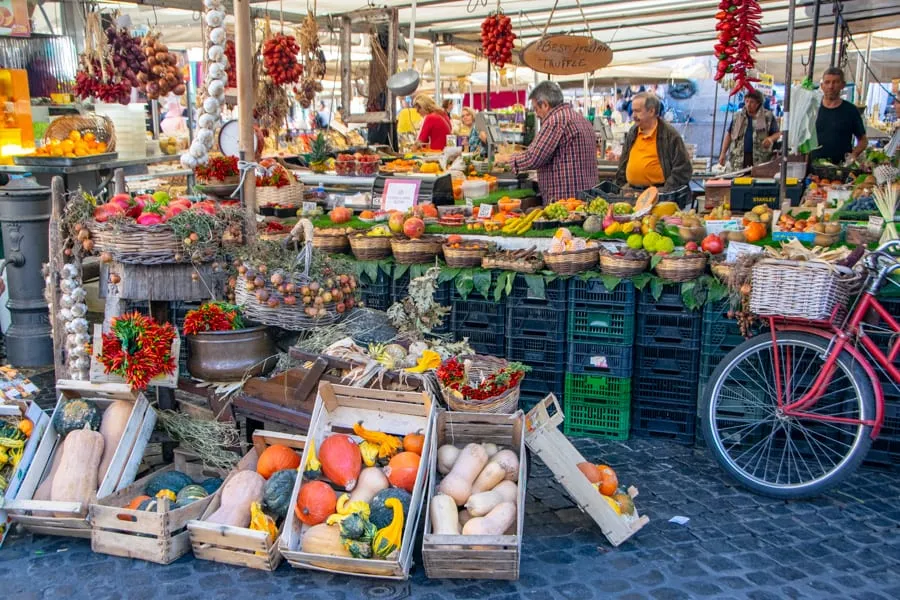
Visit the Largo di Torre Argentina.
7-minute walk from the Campo de’Fiori.
This set of ruins is home to two points of interest that are wildly different from each other: the place where Julius Caesar was assasinated, and a cat sanctuary.
The ruins are open-air, laid out in the center of the square, and are made up of the remains of several temples as well as part of Pompey’s Curia–the Roman Senate–where Julius Caesar perished just under 2,000 years ago.
As if that wasn’t enough of a reason to stop by during your 4 days in Rome, the archaeological site doubles as a cat sanctuary!
There’s an organization onsite that works to feed and care for them, and I can only imagine that they have a delightful life living in what is essentially the world’s most elaborate set of cat trees!
I’m sure it will come as no surprise to cat lovers that we’ve seen more than one cat perched on top of the remains of surprisingly tall columns.
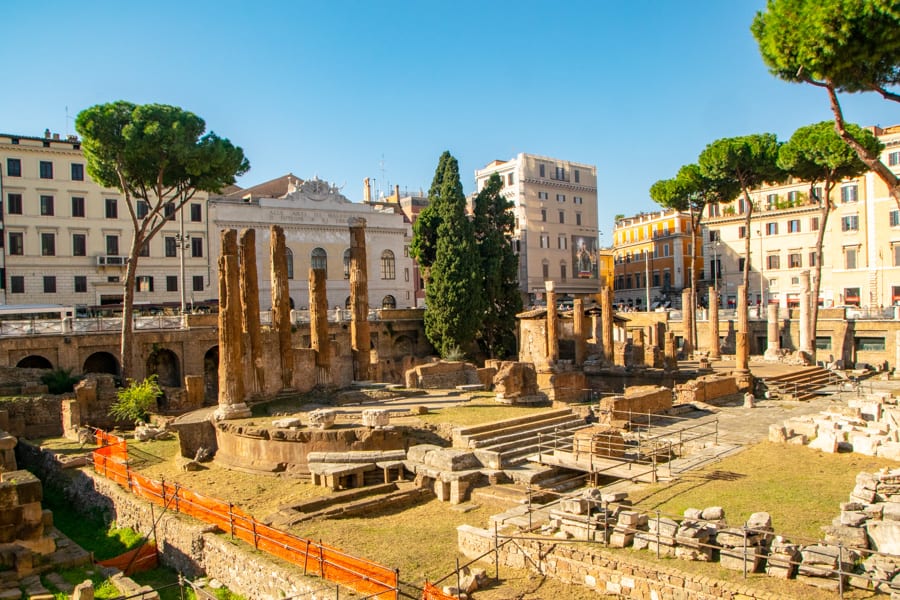
Explore the Jewish Ghetto.
About a 25-minute walk through the neighborhood, depending on how directly you travel.
Rome’s historic Jewish neighborhood is an incredibly peaceful place to get lost down the back streets.
Nestled against the Tiber, some of the smaller streets of the Jewish Quarter are quiet enough to almost forget that you’re within walking distance of the crowded madness of the Colosseum.
While you’re here, be sure to marvel at the exterior of the Great Synagogue, check out the Teatro Marcello (it looks a bit like a smaller Colosseum!), stop by the lovely Porticus of Octavia, and visit the charming Piazza Mattei with its adorable Turtle Fountain.
If you’re a fan of classic movies, channel your inner Audrey Hepburn with a visit to the Mouth of Truth (but fair warning, whether or not it’s worth visiting is a bit of a debate–all the better reason to find out for yourself, if you ask us!
And, of course, be sure to sample the fried artichokes that are synonymous with food in the Jewish Ghetto of Rome–even if you’re not a big vegetable fan, these are worth trying!
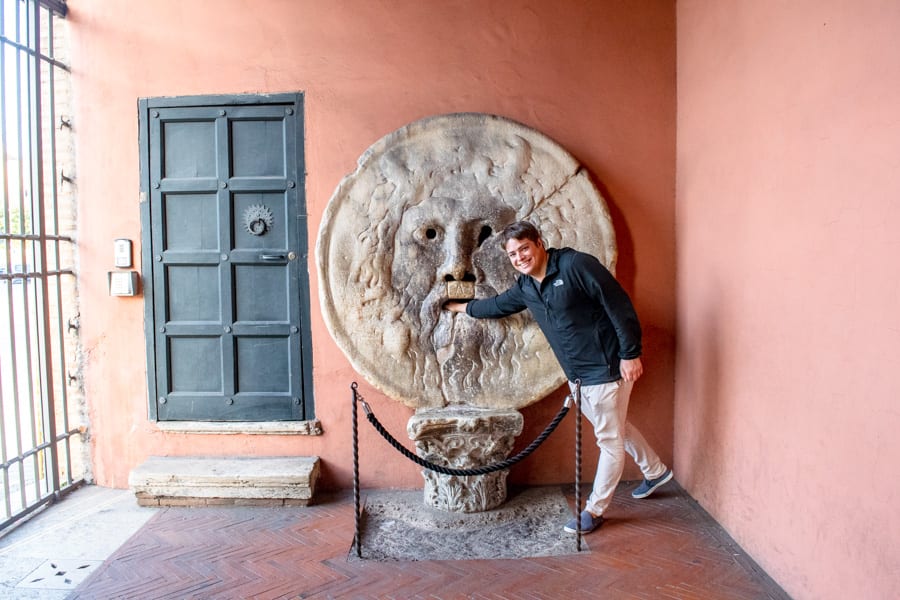
Hop over the Tiber River for a Trastevere food tour.
Trastevere is one of Rome’s most picturesque and beloved neighborhoods–and while this won’t be your last visit during your quest to see Rome in 4 days, it’s a good opportunity for a first (literal) taste.
We’re big fans of opening trips with food tours–off the top of my head, we’ve taken at least 6 in Italy alone–as they are not only a wonderful way to get to know a city, they also help you gain a lot of confidence with ordering local food!
We loved this food tour in Trastevere and can confirm that after taking it, you will walk away with a solid base knowledge for ordering food throughout the rest of your trip to Rome… and be extremely full.
From wine to cheese to Rome’s classic pastas to contorni (sides) to obligatory (incredible) gelato, every bite is a delight.
Book your Trastevere food tour today!
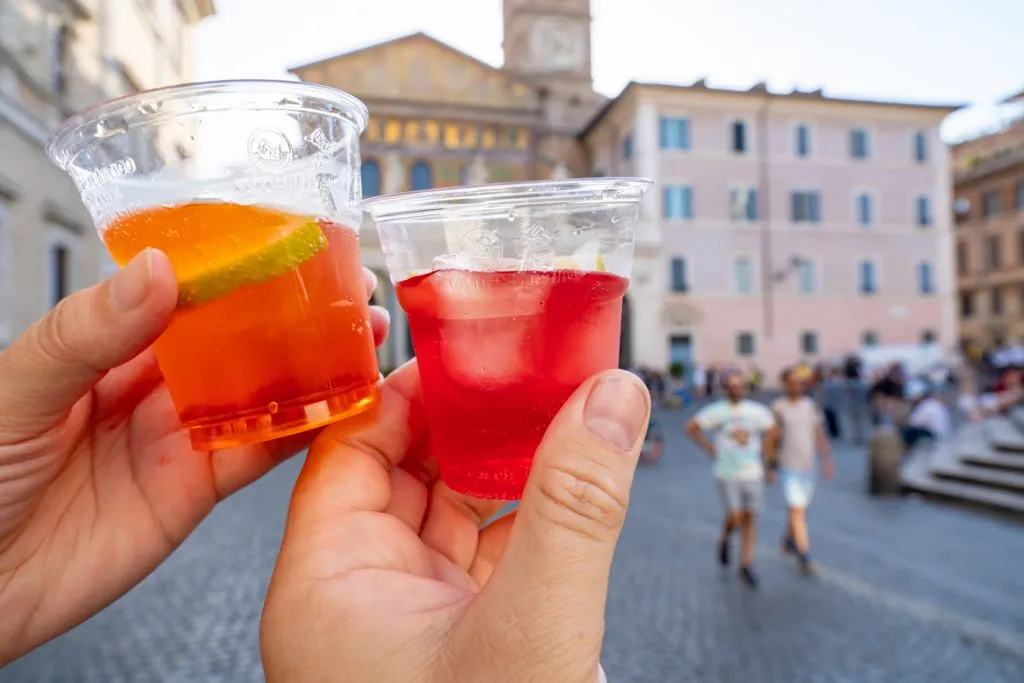
Day 2 in Rome: Centro Storico + Classic Rome Attractions
Start at the piazza del popolo..
The Piazza del Popolo is another one of my personal favorite piazzas in Rome, and is a great way to kick off the second day of your Rome itinerary!
You’ve probably heard the phrase that “all roads lead to Rome”–and specifically, they all led to Piazza del Popolo, which was once a traditional entrance point to the city.
Today, you’ll find the piazza filled with visitors, street performers, and of course, an obelisk.
The “twin churches” of Santa Maria in Montesanto and Santa Maria dei Miracoli that stand at one end of the piazza are beautiful, of course–but it’s the comparatively plain exterior of the Basilica of Santa Maria del Popolo on the other side of the piazza that art lovers should keep an eye out for, because it’s home to 2 Caravaggio paintings.
After exploring the Piazza del Popolo, be sure to climb up to Pincio Terrace for some beautiful views over the piazza and Rome itself !
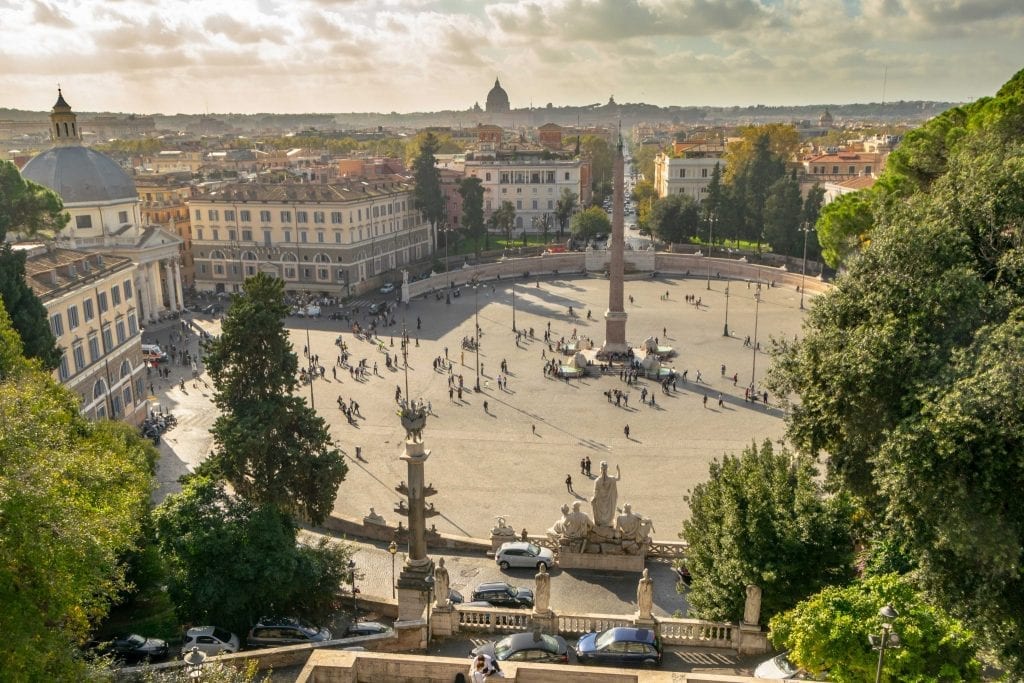
Tour the Galleria Borghese.
20-minute walk from Pincio Terrace.
A beautiful stroll from Pincio Terrace through the Borghese Gardens will lead you right to the Galleria Borghese and arguably one of the most impressive–though not one of the largest–art collections in Italy!
(The good news about it being a smaller museum, of course, is that it’s easier to squeeze into your vacation in Rome).
Housed in a former palace, the Galleria Borghese is absolutely stunning and worth a visit during your 4 days in Rome, especially for art lovers.
It is required to purchase tickets in advance to visit the collection, though, and tickets do book up.
I f you have your heart set on visiting the Galleria Borghese, be sure to get tickets ahead of time!
Reserve your tickets for the Galleria Borghese today! Prefer the context of a tour? This one gets rave reviews!
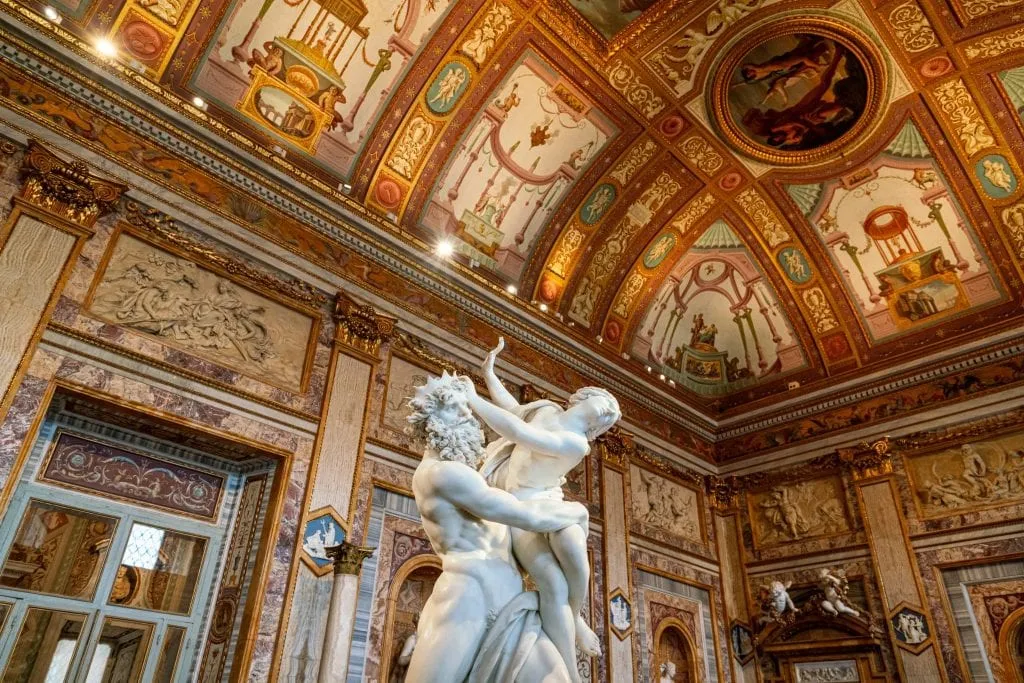
Optional: pay a visit to the Capuchin Crypt.
9-minute walk from the Spanish Steps.
I’ll be honest: this stop on our suggested 4 day Rome itinerary isn’t for everyone, but it is absolutely fascinating and I can’t resist pointing it out.
In the 17th century, the Capuchin Crypt was slowly built with the skeletons of the friars that died at this monastery.
Skeletons are arranged as works of art in several small chapels here, and including everything from full skeletons in the robes of a monk resting on a bed of bones, to chandeliers made of small human bones.
The chapels bear unsettling messages like: “As you are, we once were. As we are, soon you will be.”
Clearly, not a place for small children or those not comfortable around the dead–but the level of detail of the… art (for lack of a better word) is a sight to behold.
This is one of the least toured crypts in Rome (and of course, it’s technically an ossuary), but it is conveniently located to work in a stop during your 4 days in Rome, and if it sounds like something that might interest you, it’s definitely worth the short walk!
(And if you also find this fascinating, it’s worth noting that it’s not the only place of its kind in Italy– Milan , Palermo , Monterosso al Mare in Cinque Terre , and more are home to religious places decorated with bones).
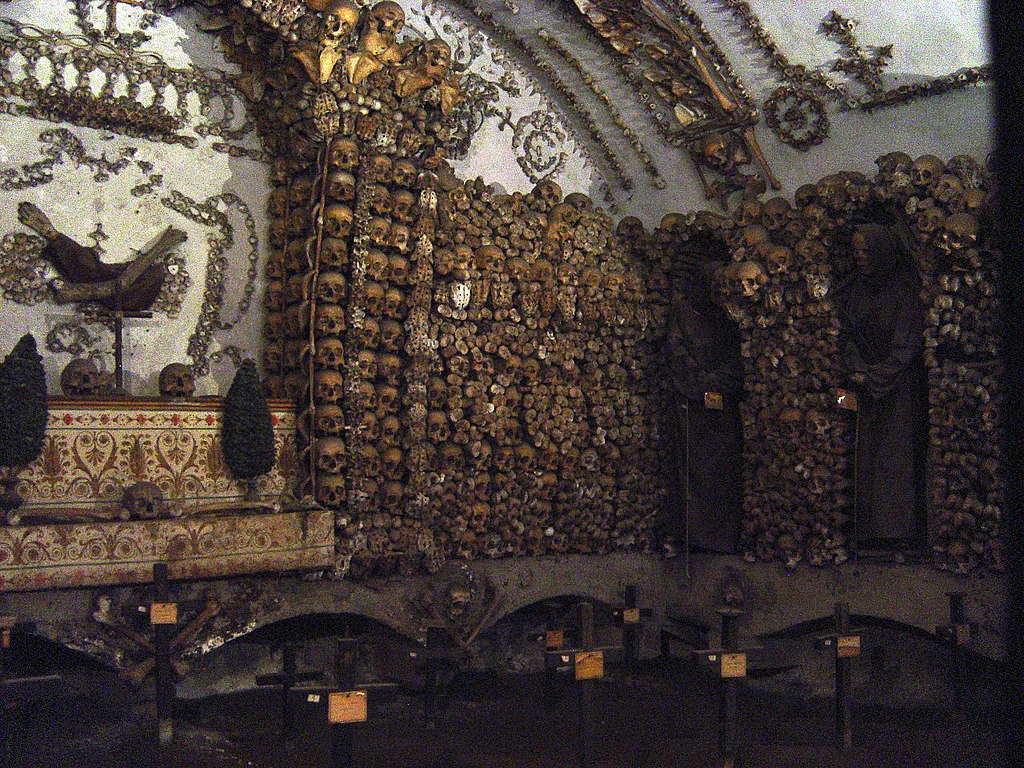
Stroll to the Spanish Steps.
21-minute walk from Galleria Borghese.
After a stop off at the Galleria Borghese and possibly the Capuchin Crypt, most of the second day of this 4 day Rome itinerary focuses on iconic Roman sights and popular tourist highlights, starting with the famed Spanish Steps.
The Spanish Steps, like many popular highlights in Rome, are almost always crowded, but there are options if you want to have them to yourself: we got up at dawn in February for the below photo!
Sadly, the tradition of sitting on the Spanish Steps was banned in 2019 (and as of December 2022, we can confirm it’s definitely still being enforced), but they’re still absolutely worth visiting during your 4 day Rome itinerary!
Depending on time, if you’re a fan of the Romantic poets, you may also want to tour the small Keats-Shelley Memorial House that overlooks the steps and functions as a museum of the Romantic poets (and also features great views of the steps and piazza).
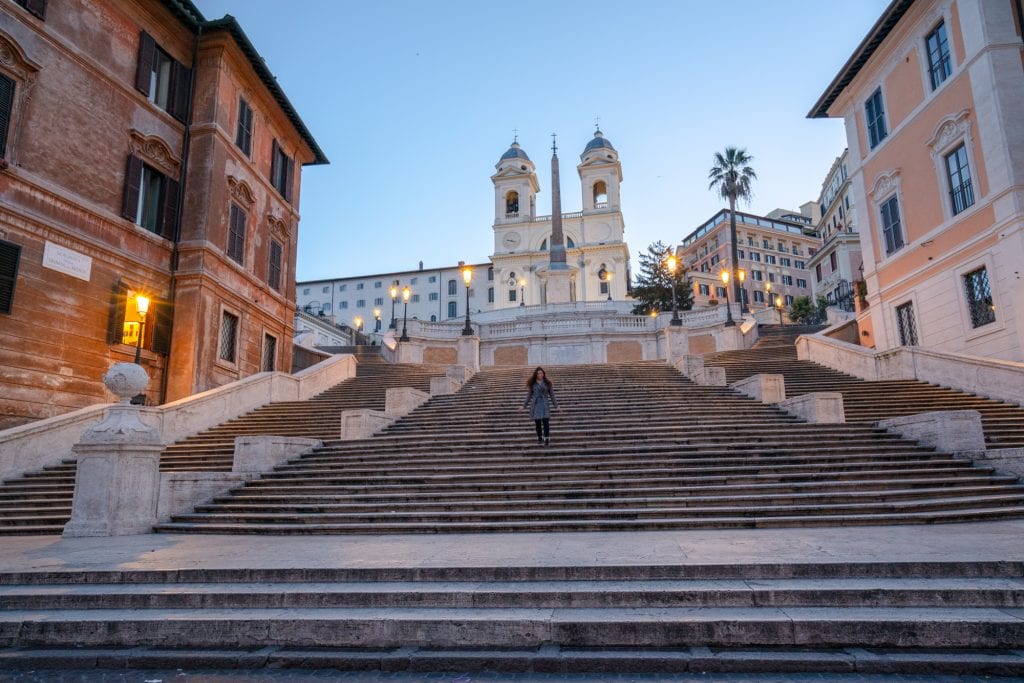
Throw a coin in the Trevi Fountain.
8-minute walk from the Spanish Steps.
What’s a Rome itinerary without a stop at the Trevi Fountain?
I’ll confess: on my first visit to Rome, I was more excited to see the Trevi Fountain than almost anything else, and it did not disappoint!
The fountain is truly magnificent, and after more than a dozen visits, I’m still in awe of how gorgeous it is (and also of just how many people can squeeze themselves around it, but hey, that’s just the reality of traveling to popular places in Rome).
Be sure to throw a coin in the fountain to ensure that you’ll always come back to Rome!
If you want to enjoy the view at bit but avoid (some of) the crowds, you can often grab a seat on the steps of the Church of Santi Vincenzo e Anastasio a Fontana di Trevi to relax for a minute.
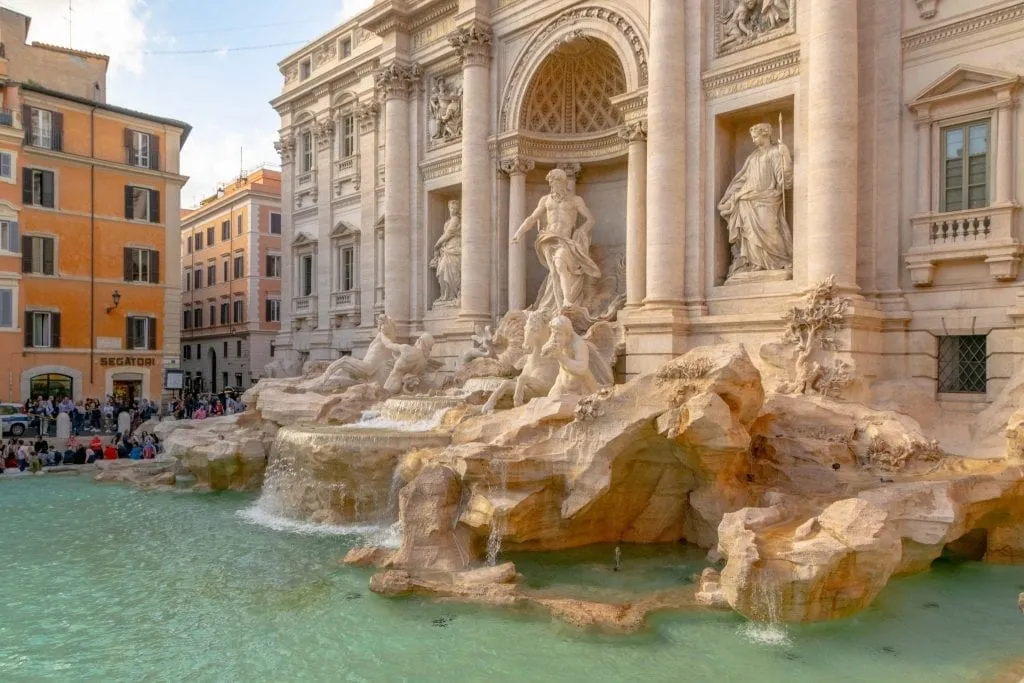
Stop by the Galleria Sciarra.
Located less than a 5-minute walk from the Trevi Fountain and yet almost never crowded, the Galleria Sciarra is an excellent way to escape the crowds of Rome’s popular tourist attractions and take a breather before continuing on to the Pantheon.
The Art Nouveau frescoes painted by Giuseppe Cellini in the late 19th century that adorn the walls are an excellent example of how beauty and exceptional artwork is truly around every corner in Rome.
The frescoes have a specific theme: women, or even more specifically, female virtues.
Feel free to take a moment to admire them for yourself–the courtyard will probably feel incredibly quiet and peaceful after the hectic crowds at the Trevi Fountain!
The building itself is used for offices today, so you can find the small courtyard open to visitors during standard business hours.
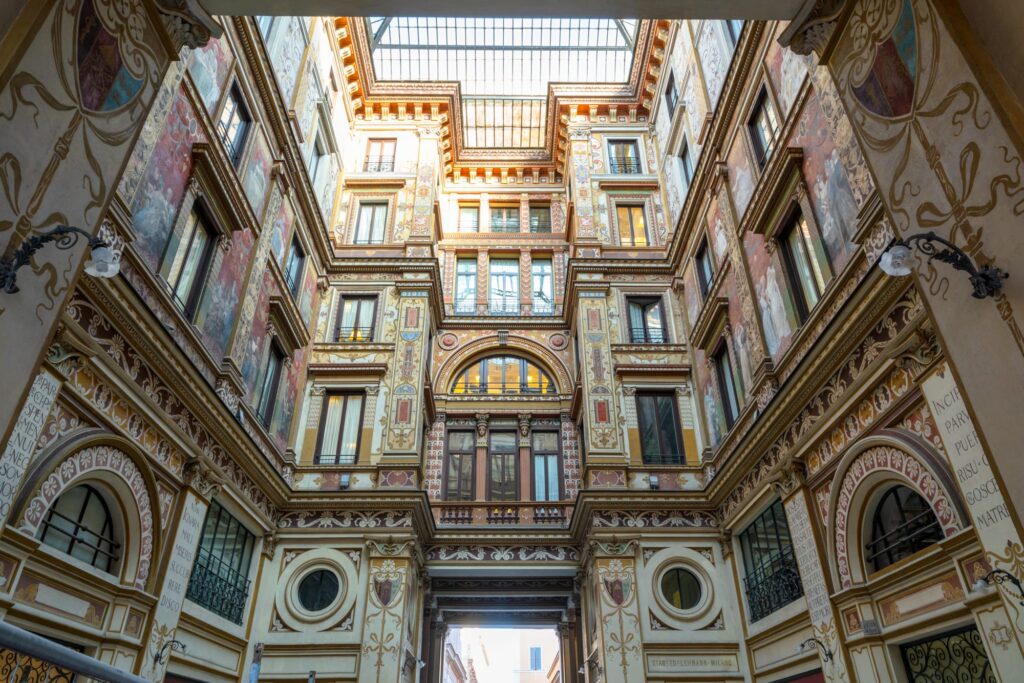
Step inside the Pantheon.
7-minute walk from the Trevi Fountain.
The Pantheon is nothing if not mysterious: its age, how it survived the Barbarian raids, and even what exactly it is made out of are all questions that remain unanswered.
Built originally as a temple to all gods and later turned into a church, the Pantheon is worthy of its status as one of the best-known sites of Ancient Rome left in the city.
No 4 day Rome itinerary would be complete without a chance to marvel at the Pantheon, so be sure to step inside and stare in awe!
While the Pantheon has traditionally been free to visit, the city of Rome introduced an entrance fee starting in 2023.
Today, base tickets for the Pantheon cost 5 Euro, purchased onsite or through this website .
Alternatively, you can purchase tickets to the Pantheon that include a downloadable audio guide .
Be sure to read the signs carefully when arriving at the Pantheon: there are separate lines for those who already have downloaded tickets and those planning to purchase one in-person.
Get your Pantheon tickets + audio guide now!
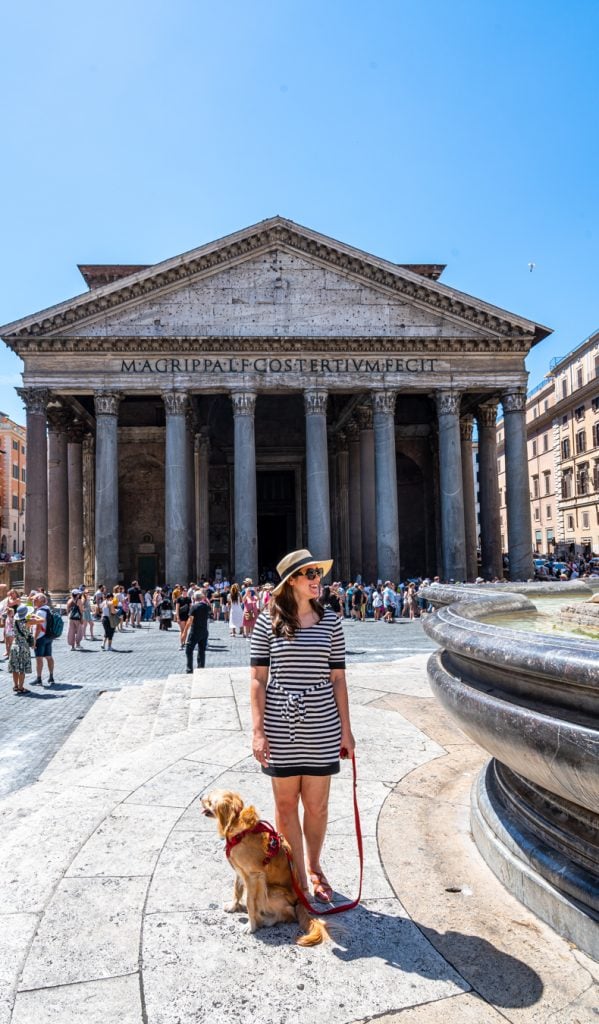
Check out the Piazza Navona.
5-minute walk from the Pantheon.
The beautiful, wide-open space known as the Piazza Navona has always been busy throughout Roman history.
It has served as a stadium, as a food market, and even as a spot for public water parties!
Today, it is known as one of the prettiest and most popular piazzas in Rome, boasting three ornate Baroque fountains that are perfect for perching on the edge of and watching the world go by.
It’s one of the most popular piazzas in Rome to visit, so expect crowds, especially near the baroque fountains–but it’s popular for a reason.
( Rome travel tip : want to escape the crowds for a second? Head around the corner to Piazza di Pasquino, see the talking statue, and grab a glass of wine from the expansive list at Enoteca Cul de Sac ).
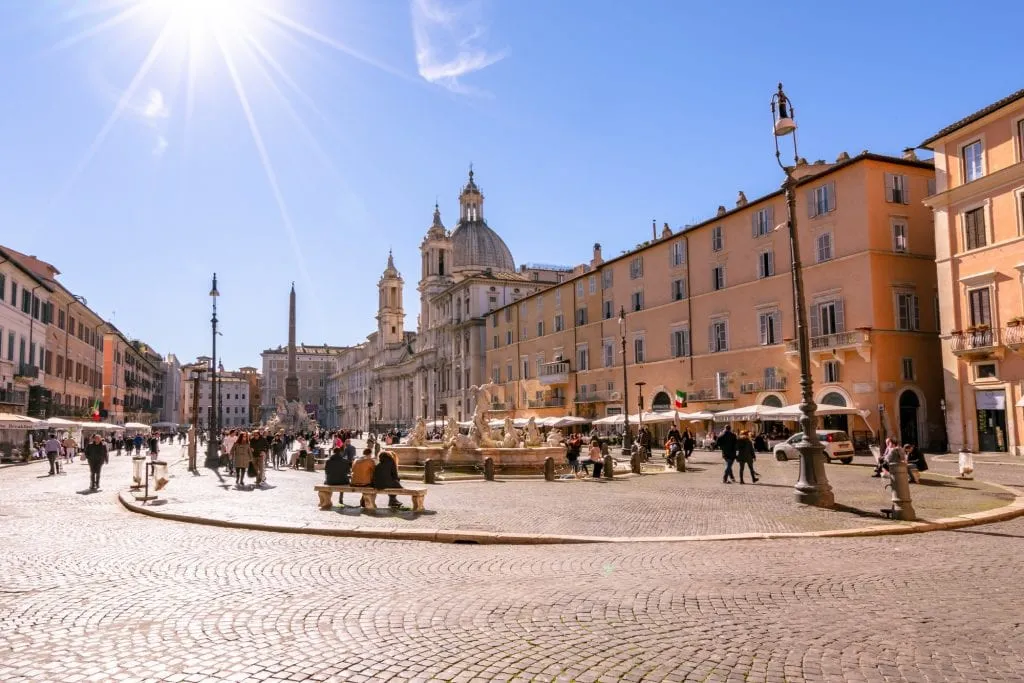
Head over to Castel Sant’Angelo.
11-minute walk from the Piazza Navona.
A walk from Piazza Navona to Castel Sant’Angelo will lead you through not only more of Centro Storico, but across the Bridge of Angels, one of the prettiest bridges in Rome, which dead-ends into the Castel Sant’Angelo.
Castel Sant’Angelo, despite its name, was never built to be a castle at all, but a mausoleum.
As the tomb of Emperor Hadrian and some of his family, Castel Sant’Angelo (in its original form, anyway), is an impressive nearly 2,000 years old–and it, whether or not you choose to go inside as part of your 4 days in Rome itinerary, is worth stopping by while in Rome.
(It also usually has genuinely impressive buskers out front–we usually stop to sit along the Tiber, enjoy the music, and admire the view at least a couple of times on every trip to Rome).
While you’re there, be sure to head to the nearby Ponte Umberto for a gorgeous view when you look back toward the Bridge of Angels and St. Peter’s Basilica.
If you time it right, this is a fantastic place to watch the sunset in Rome!
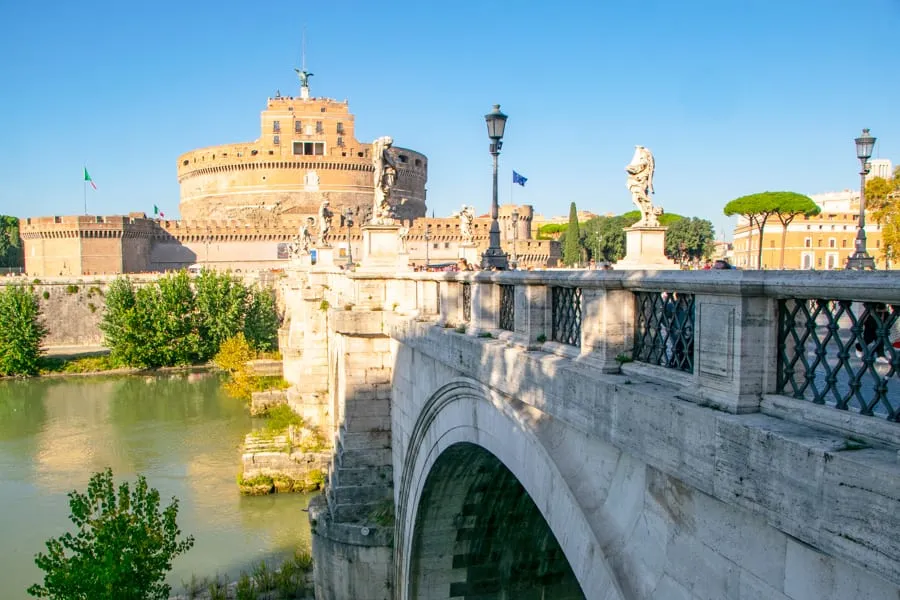
Day 3 in Rome: Explore Vatican City + Trastevere
Start your day bright and early at the vatican museums..
The Vatican Museums, with their magnificent art treasures, incredible map room, spectacular Sistine Chapel, and more, are an absolutely unmissable experience when planning to experience Rome in 4 days.
Plus, as a bonus, visiting means that you’ll actually be able to say you visited a whole other country!
Due to the severe crowds and ridiculously long lines, it is nearly essential to pre-book your visit to the Vatican Museums.
If you’d like to brave the odds on a rainy day in February, may the force be with you, but we once walked by the line to the museums nearly daily for a month as October bled into November, and the lines stayed at “Wow, okay, I’ll give that scalper whatever he wants to end this wait” levels.
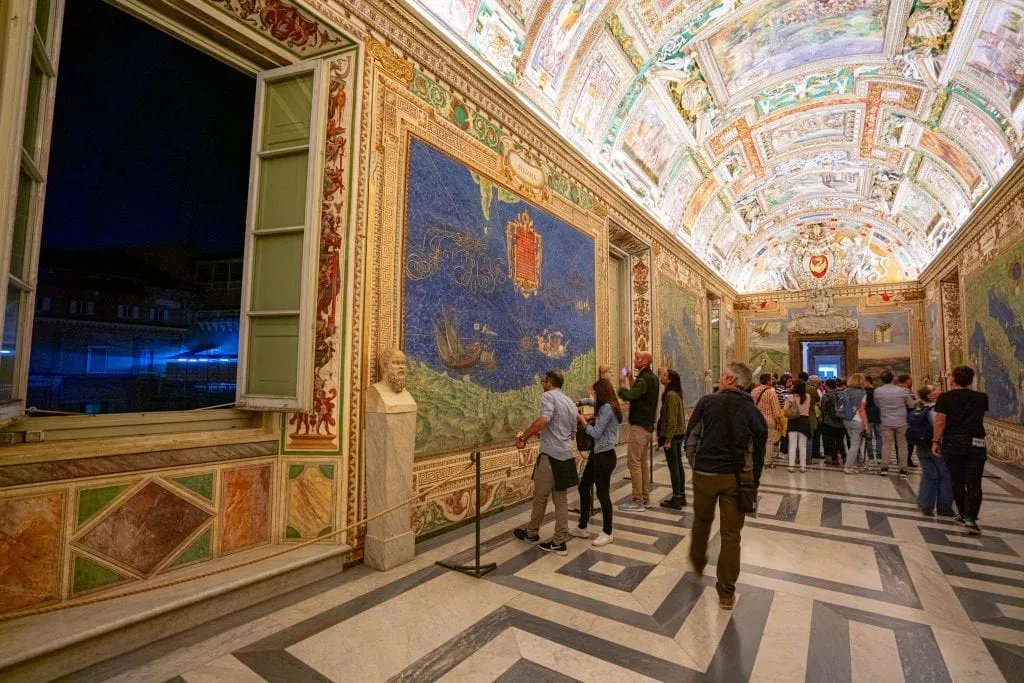
Definitely book ahead to help your 4 day Rome itinerary go more smoothly!
If you’re particularly interested in seeing the Sistine Chapel without a few hundred of your new closest friends, we’ve had friends of ours absolutely rave about the experience of the early access tour , where you can gain access to the museums and Sistine Chapel before they officially open for the day.
While it is a pricier option, word on the street is that if it’s in your budget, it’s 100% worth both the money and the effort spent getting out of bed early in the morning.
After personally touring the Vatican Museums both independently and with a guide, we’re personally of the opinion that a tour (especially one that takes place outside of peak hours) is enormously beneficial, and can highly recommend this one for an early-morning experience.
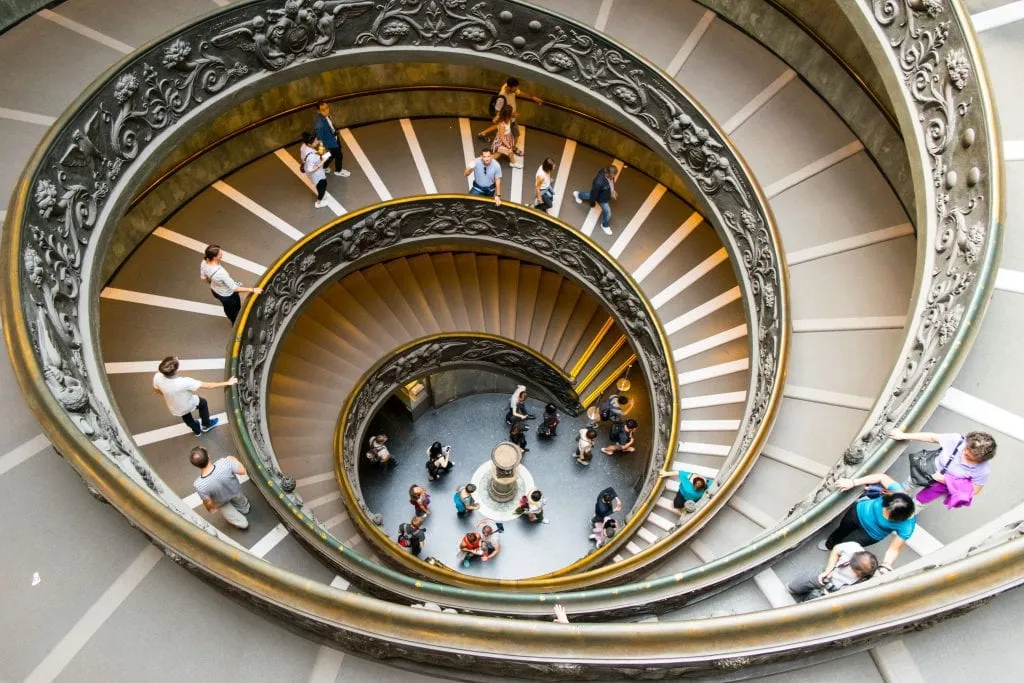
Also, bear in mind when planning your 4 days in Rome itinerary that the Vatican Museums are closed on Sundays, with the exception of the last Sunday of the month, when the museums are open and free to visitors who are able to enter before 12:30 PM (they then close at 2:00 PM).
From April to October each year, the Vatican Museums are also open on Friday nights, and we personally loved our Friday night tour .
Book your early morning or evening tour of the Vatican Museums today! Prefer to explore independently? Book skip-the-line tickets to the Vatican Museums and Sistine Chapel!
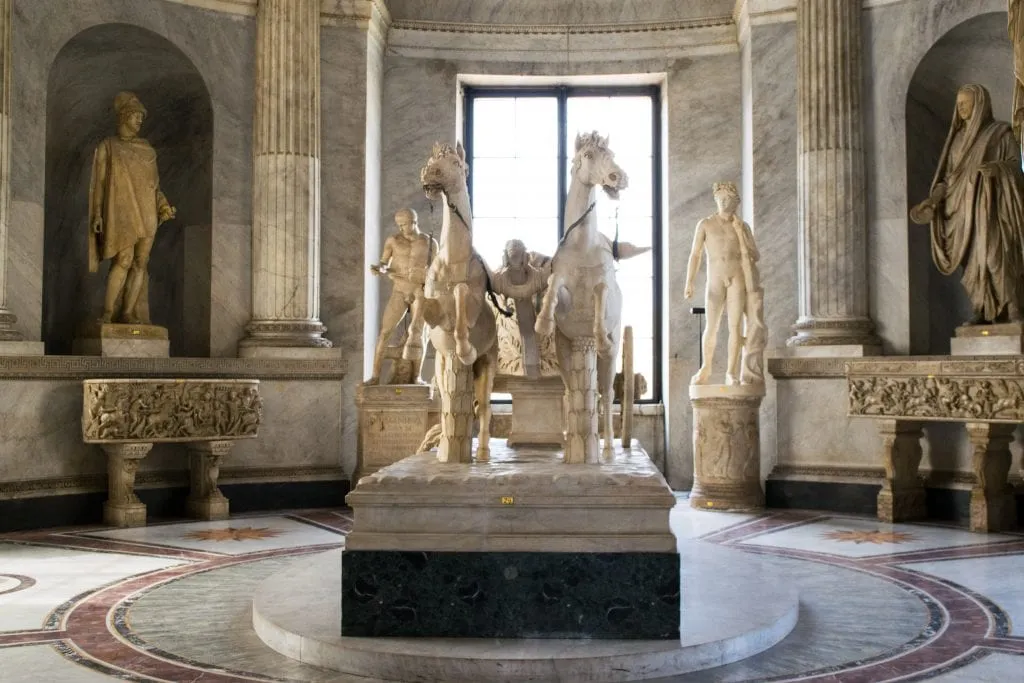
Step inside St. Peter’s Basilica.
11-minute walk from the Vatican Museums (depending on where you exit).
St. Peter’s Basilica is, hands down, the most impressive church we have seen in all of Italy (even if it technically isn’t in Italy at all).
Once you arrive out front, take a few minutes to admire the iconic oval Piazza del Pietro, and then hop in line to enter the basilica–and don’t worry, the line moves a lot faster than it looks.
The basilica itself is free to enter, but if your legs are up for it, we strongly recommend paying a bit extra to climb the dome (as long as you’re not particularly claustrophobic, that is).
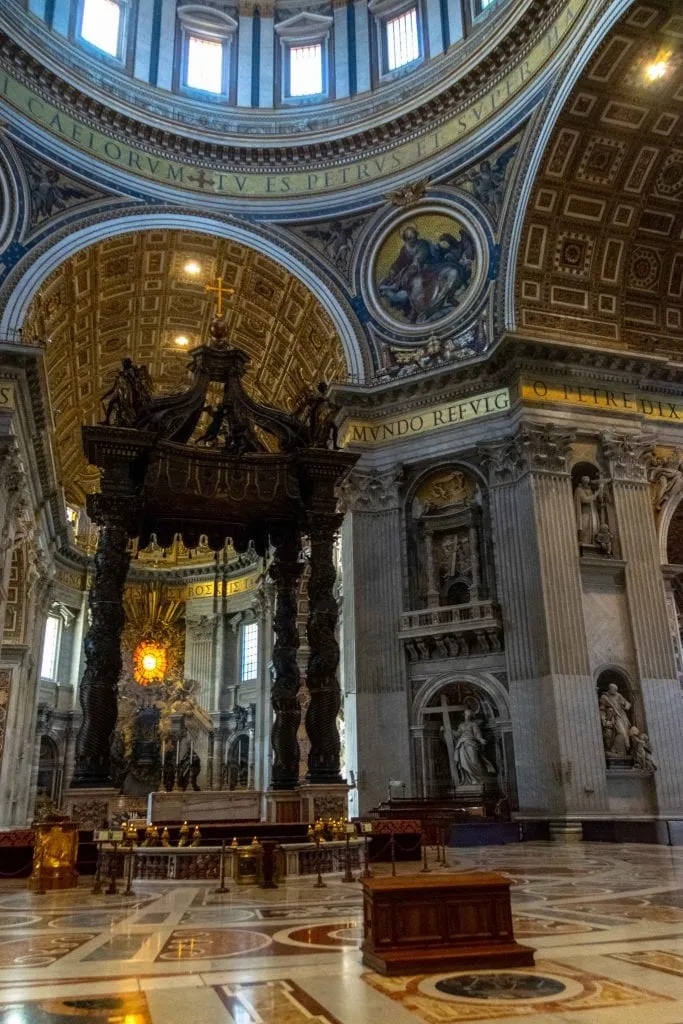
The views from the top, especially of the Piazza del Pietro, are fantastic (the first photo in this Rome blog post is of the view).
Once you get back down, head into the basilica itself.
Keep in mind that St. Peter’s Basilica does have a dress code that is enforced: cover your shoulders and knees, and avoid cleavage.
Push comes to shove, if you’re not dressed for the occasion, there are always plenty of salesmen hanging around the line to get into St. Peter’s that are more than willing to sell you a scarf to throw over your outfit.
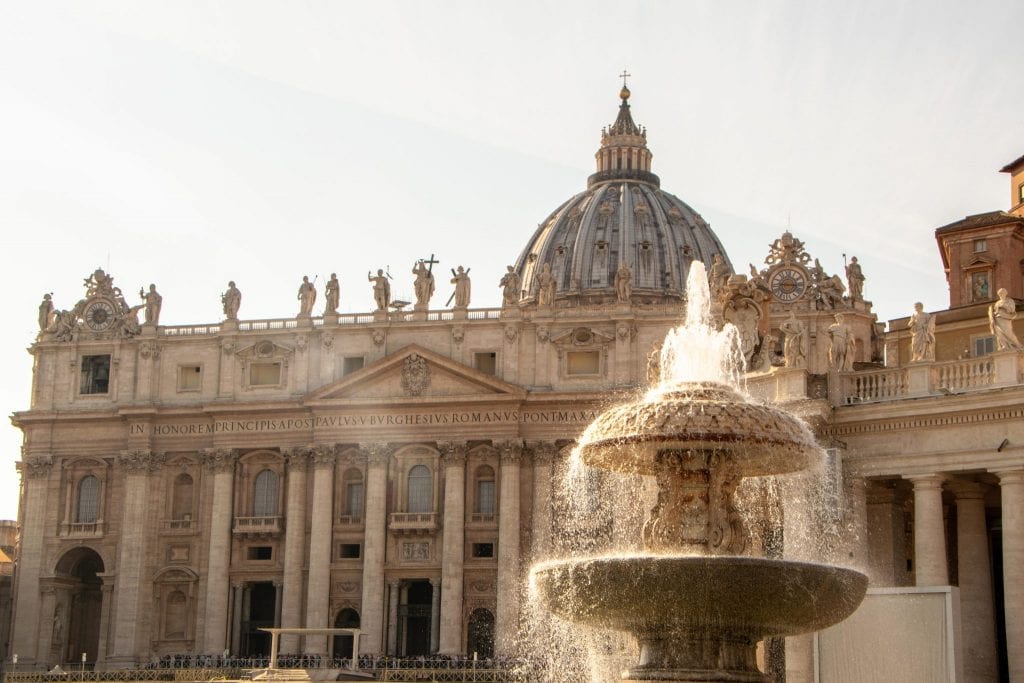
Stroll to the Villa Farnesina.
17-minute walk from St. Peter’s Basilica.
This fresco-covered Renaissance palace is a quiet, fresco-covered beauty, making it a distinct departure from the congested Vatican Museums from earlier in the morning.
Stop by to admire the artwork (Raphael’s frescoes are particularly celebrated), the loggia, and the ornate rooms of the palace.
If you’re “museumed-out” after a morning at the Vatican, you can easily skip the Villa Farnesina as well–but we love it for its much quieter atmosphere and a chance to escape the crowds.
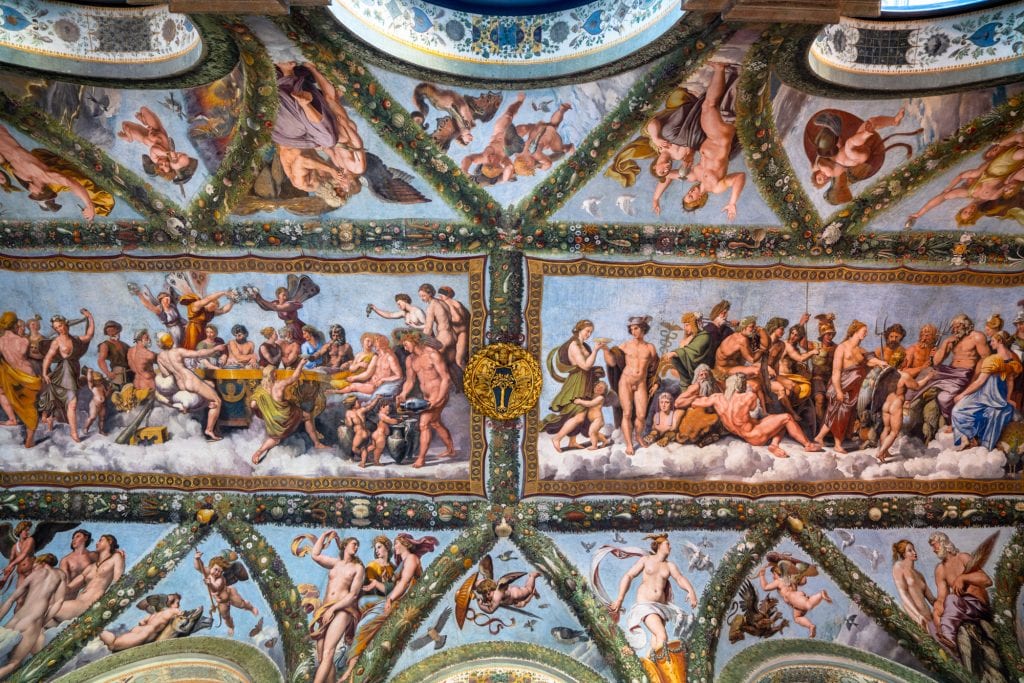
Explore Trastevere indepedently.
23-minute walk to Piazza di Santa Maria in Trastevere from Villa Farnesina.
You already had a taste during your food tour–with 4 days in Rome, once is not enough when it comes to enjoying Trastevere.
Trastevere is one of Rome’s most beautiful and–for lack of a better word–Roman-feeling neighborhoods.
This is where you’ll find some of the best examples of the iconic shuttered windows, colorful buildings, and narrow cobblestone streets that we all imagine when dreaming of visiting Rome, Italy.
Once considered an offbeat destination in Rome, the secret is out about Trastevere, and it’s a popular spot for visitors to grab a meal and wander.
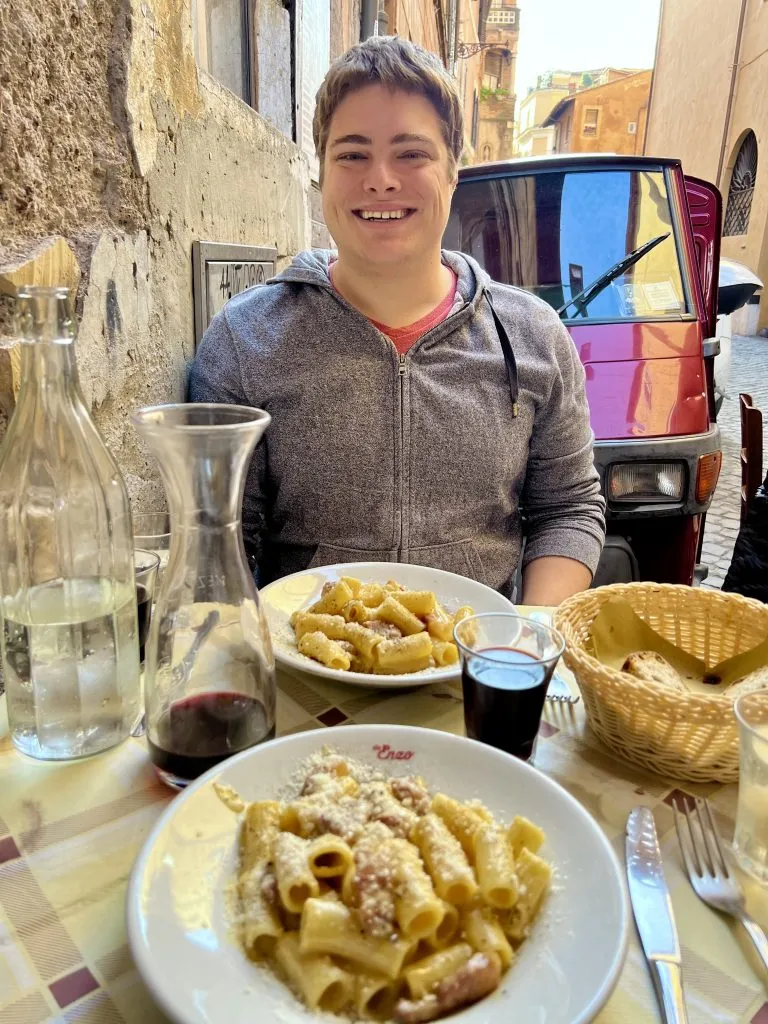
Though you’ll be far from the only visitors around, Trastevere is definitely still worth the stroll along the Tiber required to reach the neighborhood.
While you’re there, but sure to head to the Piazza di Santa Maria, which is an adorable piazza, and to duck inside the Basilica of Our Lady in Trastevere, which boasts some magnificent mosaics.
Trastevere is also a very popular place for aperitivo, so if you’re looking for that iconic spritz-on-an-outdoor-table-along-a-cobblestoned-street vibe, Trastevere is the place to be.

Ascend to the Janiculum Terrace.
15-minute walk from Piazza di Santa Maria in Trastevere.
It’s entirely possible that at this time in your Rome itinerary, your feet will be aching and the idea of climbing up to a viewpoint will sound completely terrible!
And, if that’s the case, no problem: find yourself a cute restaurant in Trastevere and start your evening aperitivo.
If you’re up for a bit more walking, however, head up to Janiculum Terrace (bear in mind that this does involve climbing a bit of a hill) for some incredible panoramic views of Rome, and perhaps even a beautiful sunset!
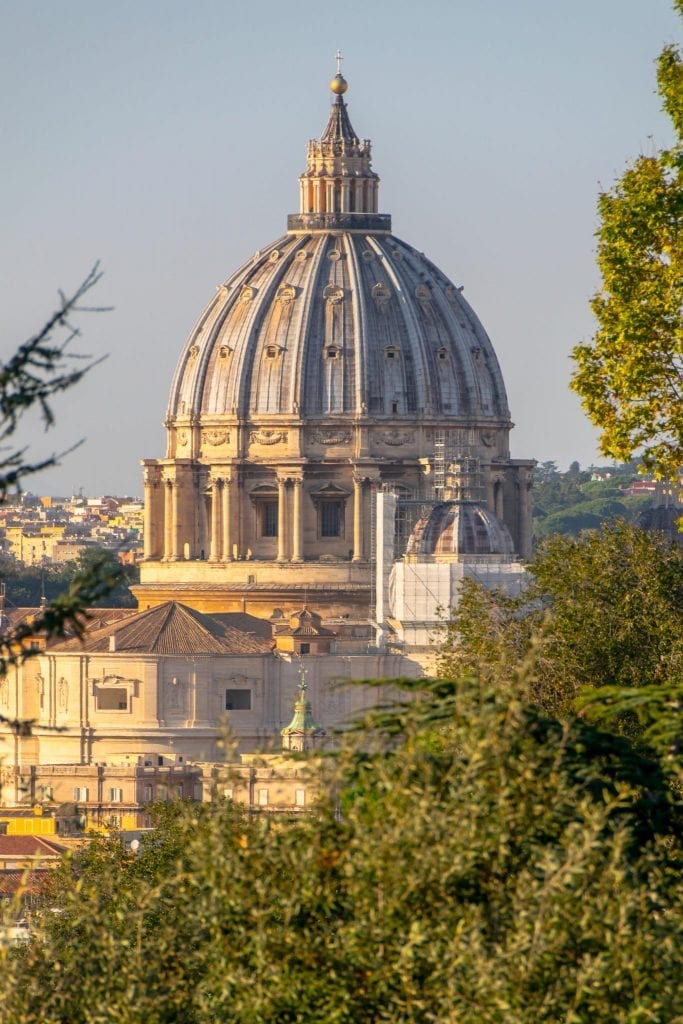
Day 4 in Rome: Testaccio , Aventine Hill + Some Hidden Gems
Start your day with a 2,000-year-old pyramid..
Pyramids aren’t exactly the first image that comes to mind when we think of Rome, but the impressive Pyramid of Caius Cestius has been standing proudly in Rome for 2,000 years!
Start the final day of your Rome itinerary by setting off to Testaccio to see both the Pyramid and several other unexpected attractions.
You’ll be able to catch your first glimpses of the pyramid after exiting the Piramide metro stop, but the best views are actually from inside the Non-Catholic Cemetery, so save most of your picture-taking for those spots!
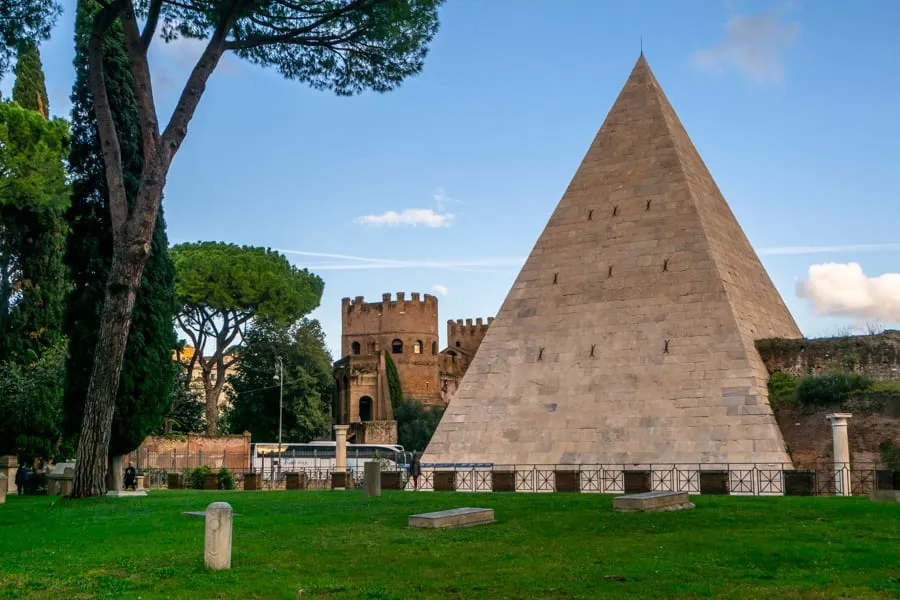
Visit the Non-Catholic Cemetery of Rome.
4-minute walk from the Pyramid of Cestius.
This beautiful cemetery is unique in the historically extremely Catholic city of Rome and houses some notable non-Catholics, including the poets Percy Shelley and John Keats.
It’s a lovely and peaceful place, and the views of the Pyramid of Cestius make an interesting contrast to the more recent headstones.
In addition to being the final resting place of plenty, the Non-Catholic Cemetery is also the home of some very lively cats!
Rome’s Non-Catholic Cemetery doubles as a cat sanctuary, and you’ll likely spot several beautiful felines resting amongst the headstones and prowling through the landscape.
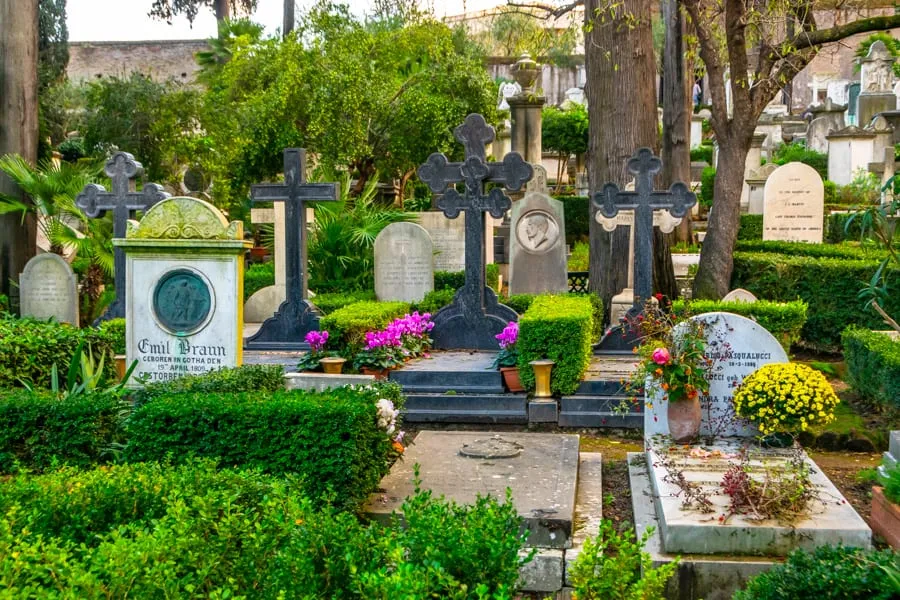
Head to the Testaccio Market.
11-minute walk from the Non-Catholic Cemetery.
As compared to the Campo de’Fiori market noted earlier on this 4 day Rome itinerary, the Testaccio Market (and Testaccio in general) has a distinctly local feel.
True, this neighborhood isn’t unknown to tourists–but it’s also far from overrun by them, and you’ll find plenty of Romans shopping among you at the indoor Testaccio Market.
Check out clothes, shoes, and housewares, or head right to the food–both prepared food and groceries are available in the market.

Stop by Piazza Testaccio.
5-minute walk from Testaccio Market.
You won’t necessarily need long in this quiet and small piazza–but that’s exactly why you should take a moment to stop by.
So many of Rome’s piazzas that you’ll see during your 4 days in Rome tend to be completely packed (did you know that the area around the Trevi Fountain is actually called the Piazza di Trevi? It’s definitely not peaceful these days…).
Strolling through Piazza Testaccio, on the other hand, is a great opportunity to enjoy a more laid-back version of this classic feature of Roman life.
If you want to relax and enjoy the piazza for longer than a quick look, we can recommend grabbing an aperitivo at Oasi della Birra!
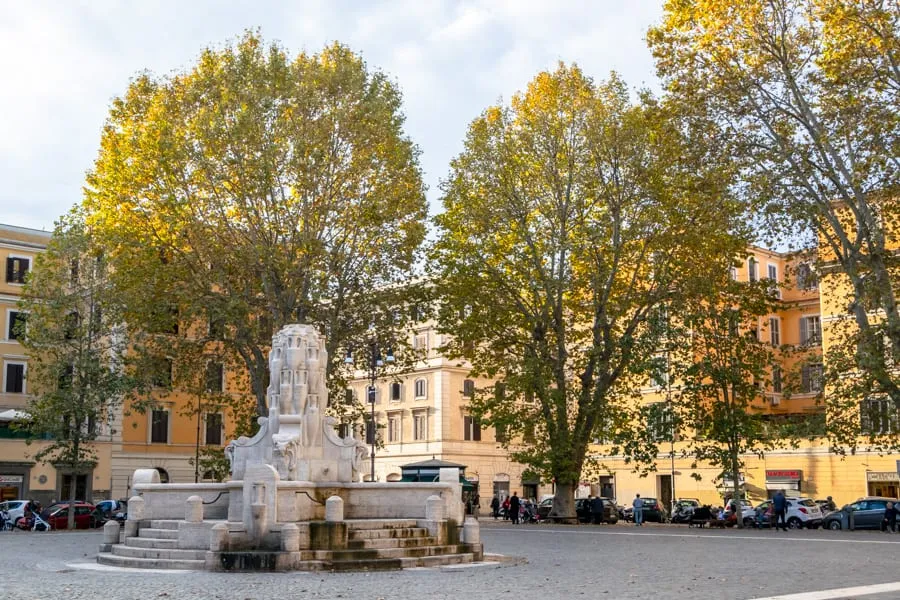
Snap a photo at the Keyhole on Aventine Hill.
12-minute walk from Piazza Testaccio.
If you peer through the keyhole on Aventine Hill, you’ll be greeted with a beautiful view: the dome of St. Peter’s Basilica, framed by garden hedges.
It’s a lovely spot… that we totally missed the first time we tried to visit on account of (apparently) skimping on research.
When I had seen the many photos of this spot in the past, I mistakenly assumed that the “keyhole” in the name was merely referring to the small break in the hedges that framed St. Peter’s–but no, you do indeed peer through a literal keyhole to see it.
Don’t make our mistake and end up walking right by without checking it out!
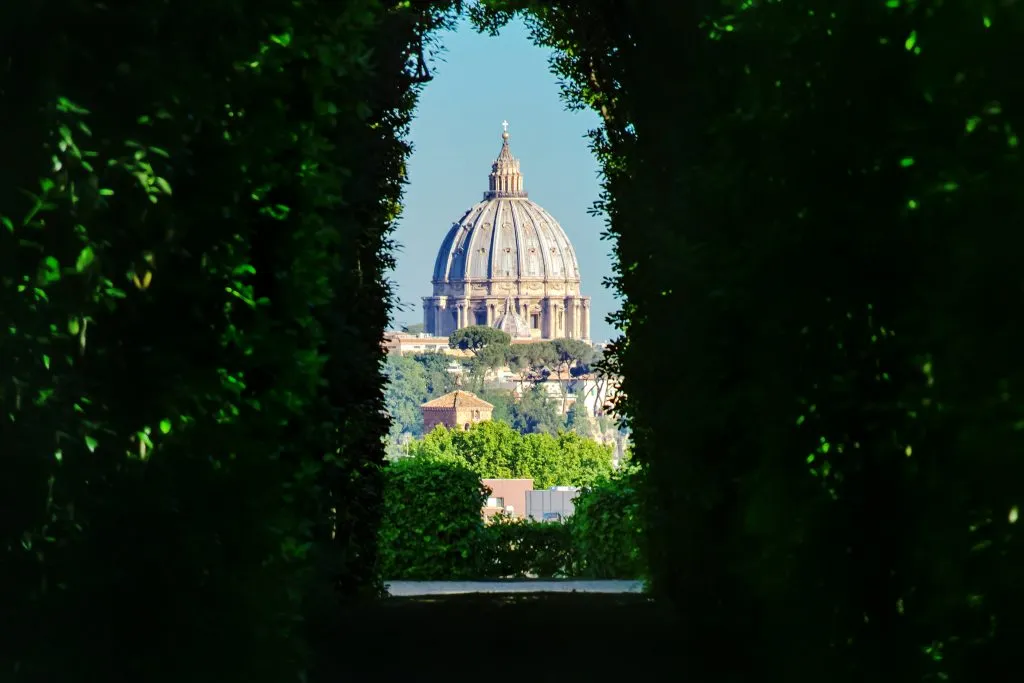
Stroll through the Orange Garden.
4-minute walk from the Keyhole on Aventine Hill.
The Orange Garden is a gorgeous place, and a perfect spot to pause and relax during your 4 days in Rome.
Home to–what else–a grove of orange trees, the garden is meticulously manicured and a very peaceful place to take in the stunning views of Rome that are available from the terrace at the back of the garden.
The Orange Garden is an incredibly relaxing place and a great spot for resting your feet and people-watching for a bit.
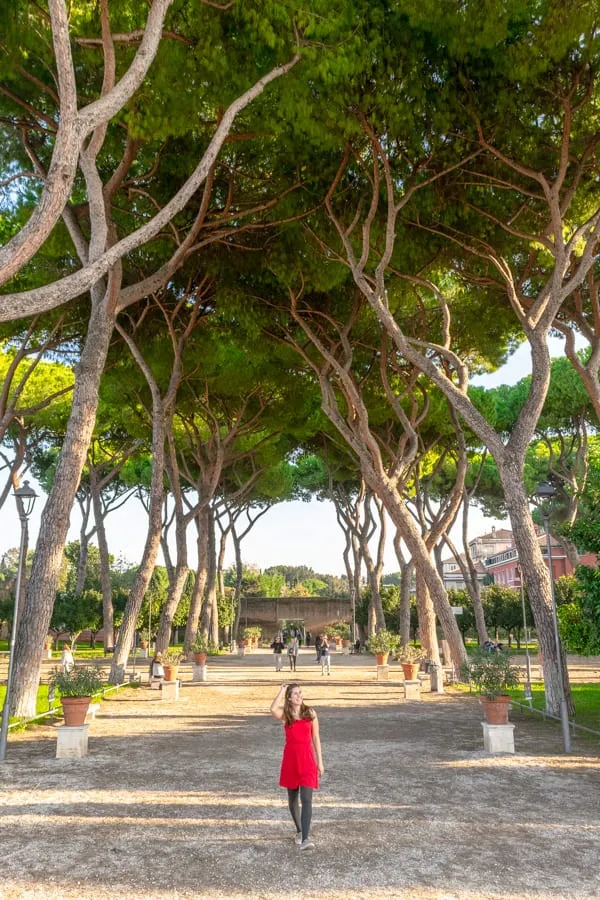
If you’re a history buff, stop by Circus Maximus.
8-minute walk from the Orange Garden.
I wouldn’t necessarily consider seeing Circus Maximus to be an essential stop on this itinerary for Rome in 4 days, but as it’s so close by, it’s worth mentioning for any Roman history buffs that are visiting!
Circus Maximus was the first stadium in Rome and was known for its chariot races.
Located between Aventine and Palatine Hills, you can still see remnants of ancient palaces staring down over Circus Maximus.
Today, the site is a public park and is essentially a field with very few ruins remaining, hence why I don’t think it’s an unmissable stop on your Rome itinerary.
But, that being said, it is very cool to see modern Romans exercising in the exact spot where chariots once raced!
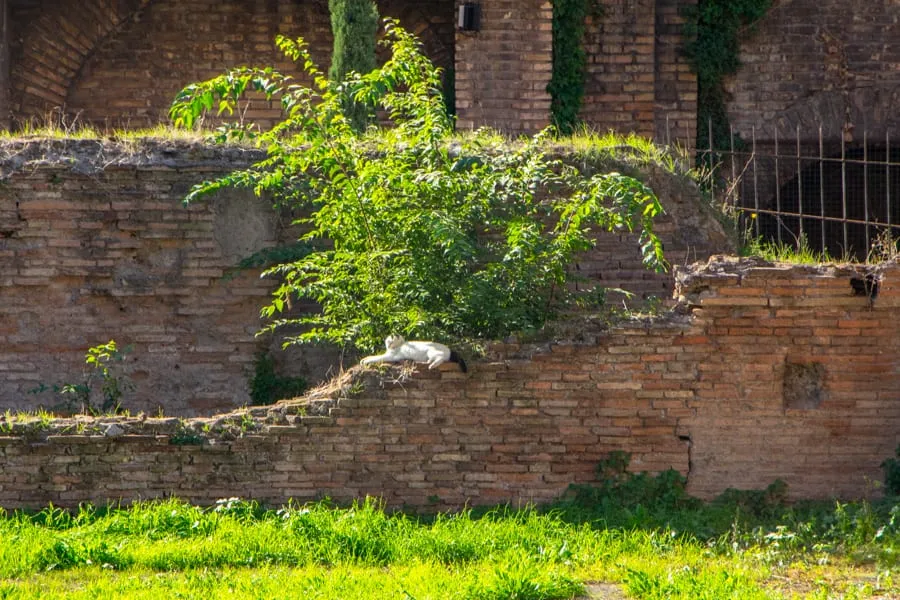
See a less-visited side of Ancient Rome.
By this time in your trip to Rome, you’ve had a chance to sample a wide variety of the Eternal City’s history, from the works of a Republic followed by Emperors in Ancient Rome, to the realm of popes and kings and beyond.
As you get close to the end of your trip, consider going back to the beginning and visiting one of Ancient Rome’s less crowded sites!
The Baths of Caracalla and Domus Aurea (Emperor Nero’s Golden House) are both incredible options.
Domus Aurea requires a bit of planning ahead, but you won’t forget the experience anytime soon!
If you’re curious about Ancient Rome but more interested in museum settings than archaeological ones, this is a good chance to loop back to the Capitoline Museums , as well.
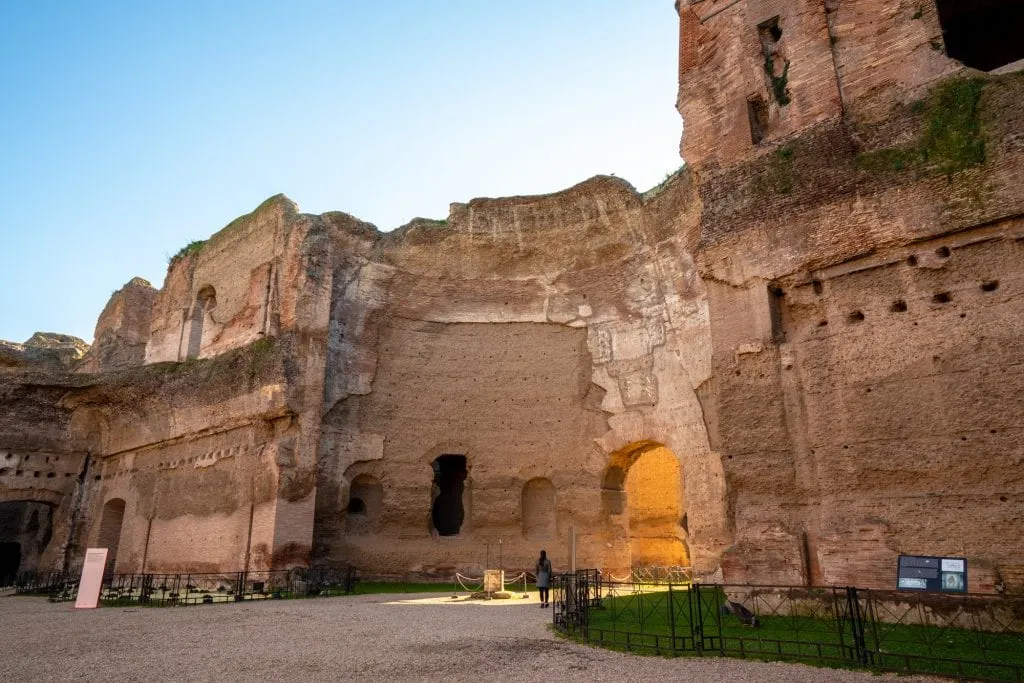
Close our your 4 days in Rome itinerary by stepping inside Rome’s catacombs.
Lurking underneath the surface of Rome are 60 catacombs, dug by early Christians in the days before the city as a whole converted–and of those 60, 5 are open to the public.
For a side of Rome that you definitely haven’t seen so far, descend underground for a visit!
Depending on how fast of a sightseer you are, you may want to choose between this and one of the attractions in the above section–or you may want to squeeze it all in!
When it comes to Rome’s catacombs, The Catacombs of St. Callixtus are the largest and most visited, though all are worth seeing.
While the various catacombs tend to be open until 5:00 PM, for maximum flexibility, consider signing up for this after-hours catacombs tour through Take Walks!
(Note that the tour also visits the Capuchin Crypt, so if you plan to take it, don’t visit the crypt as mentioned on day 2 of this itinerary for Rome).
Book your visit to Rome’s catacombs today!
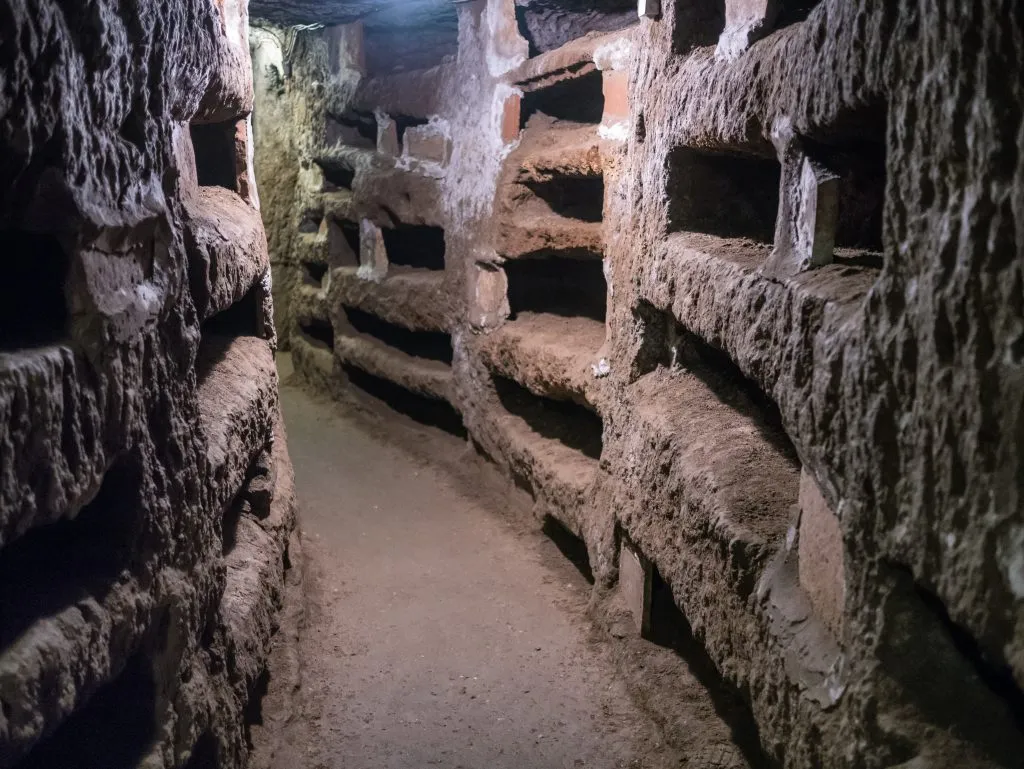
Where to stay for 4 days in Rome depends a lot on your priorities.
Do you want to be surrounded by a beautiful neighborhood? Trastevere is the place for you.
In the center of the action? Head to Centro Storico.
Save money? The furthest reaches of the metro lines.
With 4 days in Rome, though, we consider access to the rest of the city to be the most important deciding factor when deciding where to stay–in other words, choose somewhere within no more than a 10-minute walk to a metro stop.
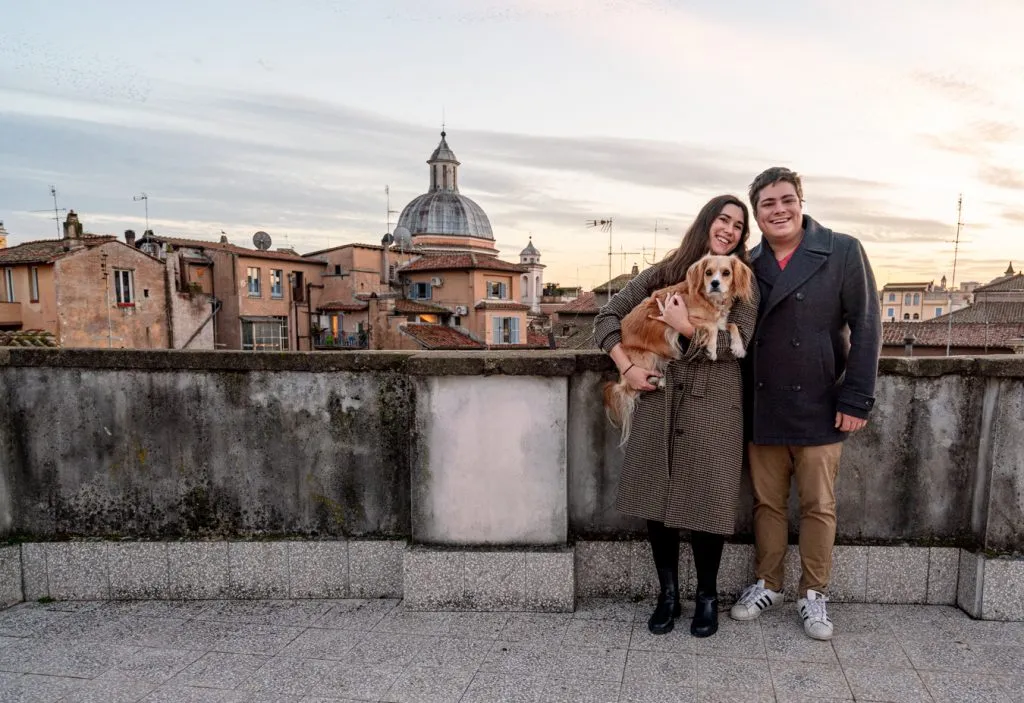
However, if it’s within your budget, we find Centro Storico or fairly close to it (the closer edges of Trastevere, Monti, or Prati/Vaticano, for example), to be the most convenient place to stay for this Rome itinerary.
When choosing a hotel or apartment, looking at its distance from Piazza Navona and the Pantheon is a good rule of thumb–in a perfect world, you’ll be within walking distance of those.
That being said, we’ve stayed all over Rome and loved each corner for different reasons!
Here are a few well-reviewed properties to keep in mind when deciding where to stay in Rome.
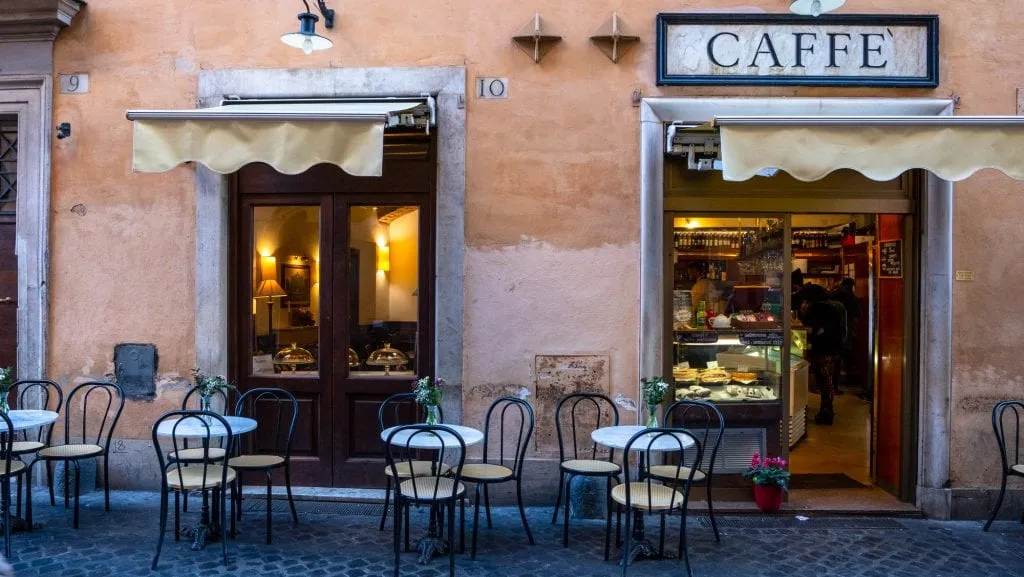
La Cornice Guesthouse — We loved this little guesthouse back in our budget backpacking days! It was extremely clean and comfortable, and very affordable for Rome.
La Cornice is set slightly outside the main tourist areas, but an easy 5-minute walk to the metro and a 20-minute ride got us to the Colosseum and other major sights.
Our favorite part of La Cornice?
Eating a nearby Joseph Ristorante for lunch, a restaurant we have returned to for years–and it all started with a recommendation from the clerk at La Cornice.
Just a 5 minute walk away, their lunch special offered a choice of about 10 main courses plus bread, wine, and one of several desserts for 8 Euros/person–it’s hard to beat that!
Check rates & book your stay at La Cornice Guesthouse!
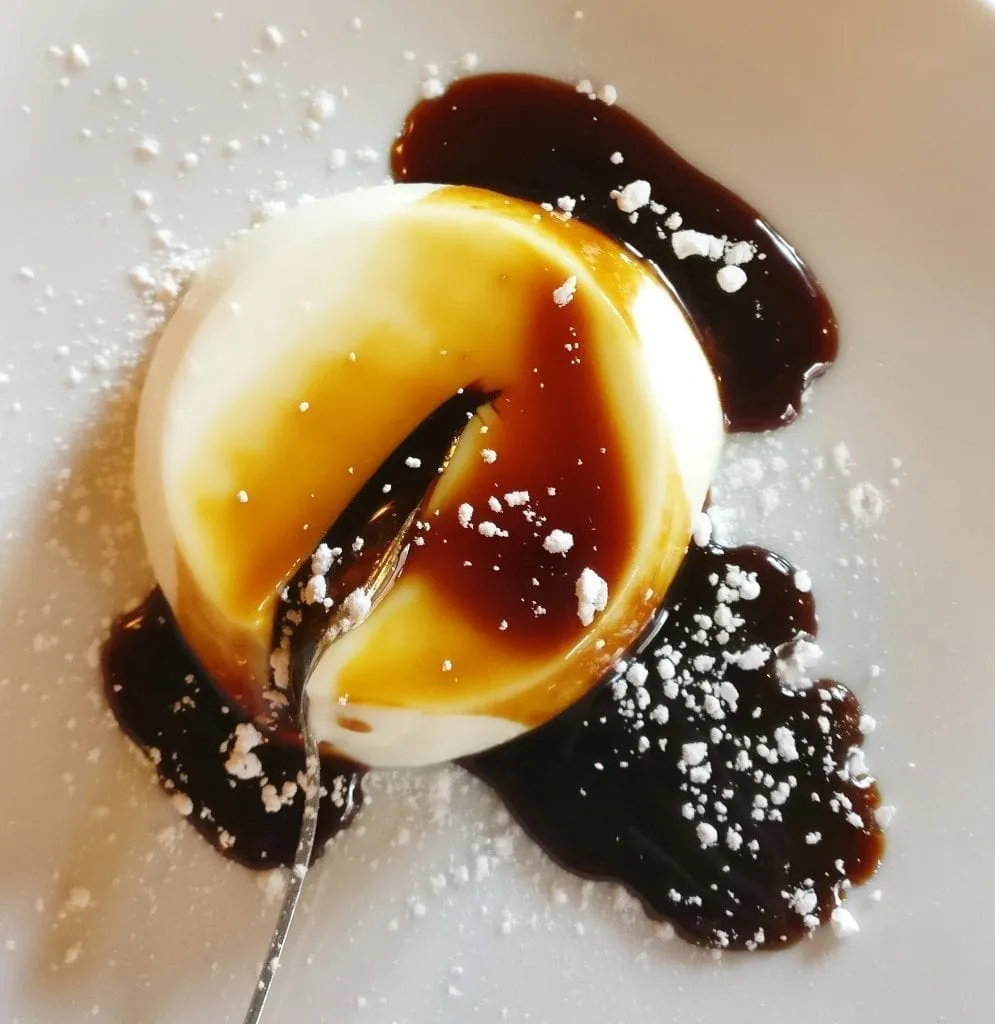
The Wesley — We adore this hotel! You can’t ask for a better location for exploring Rome, as it literally overlooks the Castel Sant’Angelo and is a short walk away from all the major Centro Storico sights.
It is a bit of a hike to a metro stop–you’ll probably need to take a taxi when you arrive/leave with luggage–but the location made it worth it for us.
For a mid-range property, The Wesley is a fairly simple one–expect small and extremely simple rooms, and shared bathrooms for some rooms.
Essentially, The Wesley as a guesthouse floats somewhere between budget and mid-range, with a luxury-status-worthy location.
Because of the fantastic combination of more affordable rates and a fabulous location, The Wesley sells out fast–if you want to stay there and see it’s available on your dates, we recommend booking immediately!
Check rates & book your stay at The Wesley!
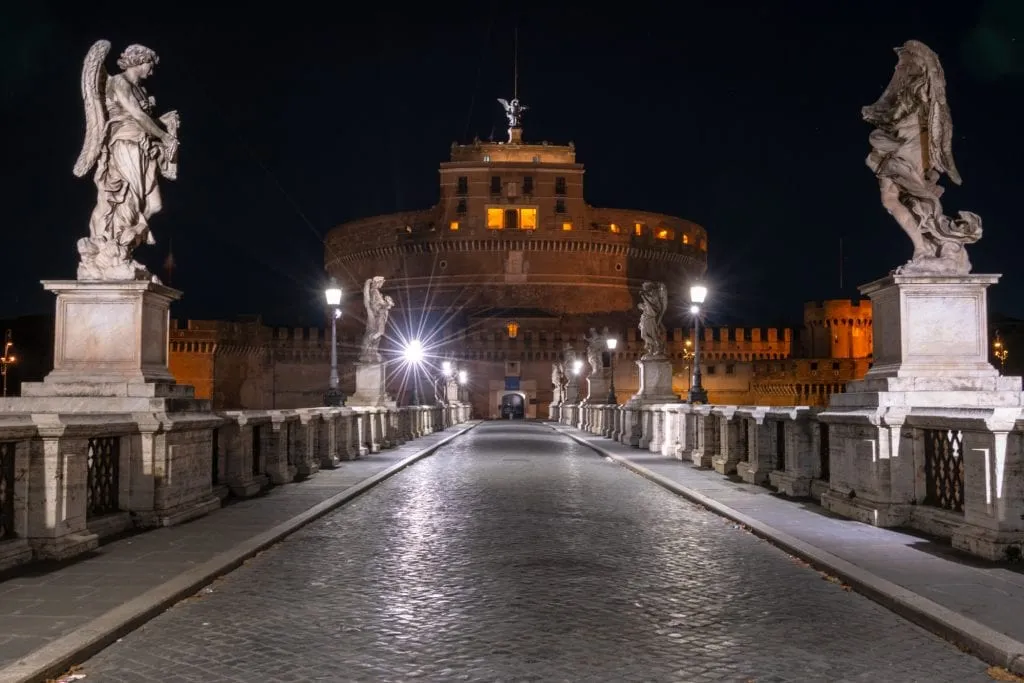
Hotel Condotti — Located just a couple of blocks from the Spanish Steps (and consequently the Piazza di Spagna metro station), you couldn’t ask for a better location in Rome!
Well-reviewed and boasting exceptionally clean rooms, Hotel Condotti is the perfect choice for a traveler with a midrange budget (or luxury traveler–this hotel also holds some impressive-looking suites!) who would like to be within walking distance to the best that Centro Storico has to offer.
Enduringly popular and perfectly positioned, you can’t go wrong with checking into Hotel Condotti.
Check rates & book your stay at Hotel Condotti!
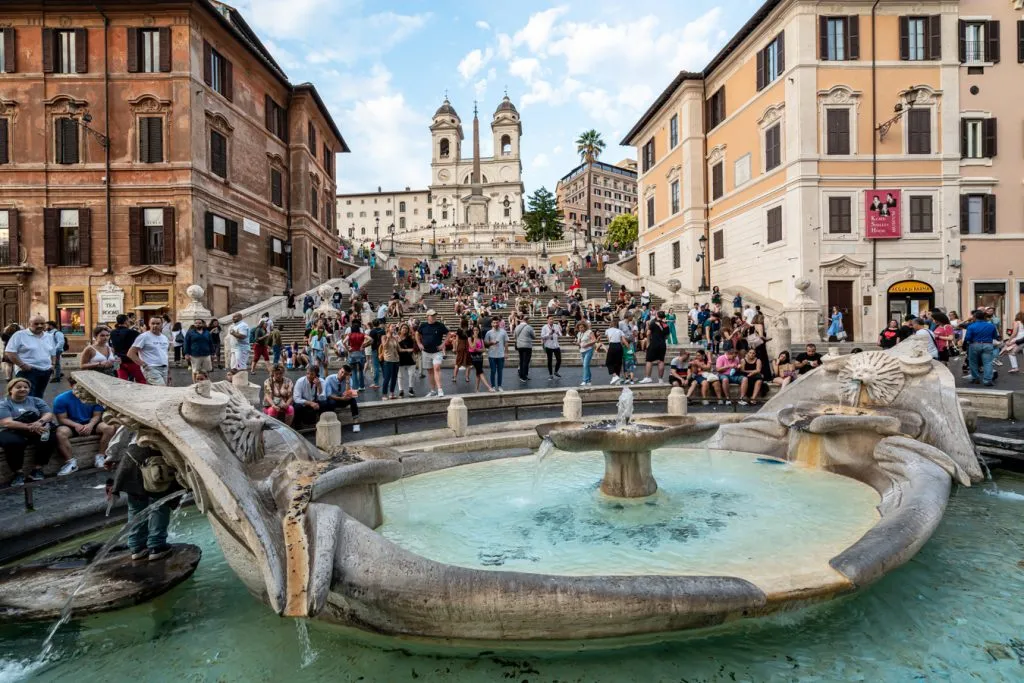
Pantheon Inn — If you’re looking for a building with classic Italian charm in the heart of Rome, this is it.
Located right behind the Pantheon and within reach, the Pantheon Inn offers a quiet, peaceful escape in the middle of bustling Rome.
You will need to walk a bit to the metro stop–but since the walk will take you through the heart of the beautiful Centro Storico, we doubt you’ll mind.
Check rates & book your stay at the Pantheon Inn!
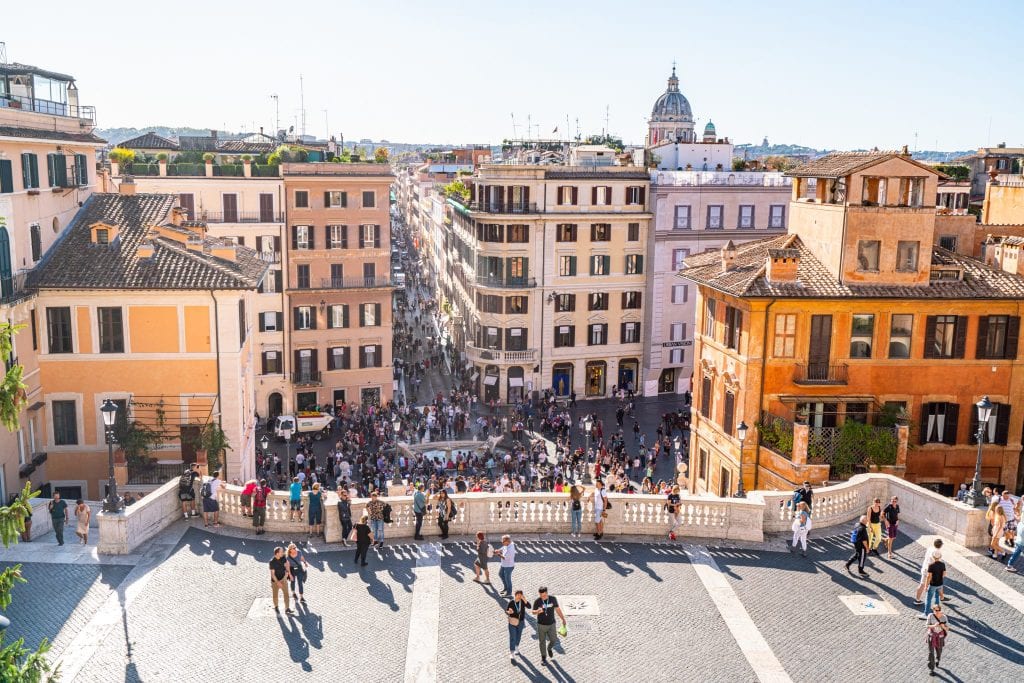
If you’re lucky enough to have more than 4 days in Rome, it’s time to start thinking about day trips!
Consider heading to the nearby Tivoli Gardens, to hilltop towns like Orvieto or Siena , or out on a wine-and-food-centered Tuscany day trip .
If you plan ahead and use the fast train, you can even take a day trip to Florence !
Pompeii is a popular–and worthy–side trip from Rome, but to accomplish it as a day trip, you really need a tour, and this one is among the best of the best!
Pompeii is about 6 hours of driving round-trip from Rome, longer (and more confusing) via train, and trying to also squeeze in Vesuvius on an independent day trip from Rome would be nearly impossible.
If you’d like to visit Pompeii and the Amalfi Coast from Rome, this extremely popular tour has been reviewed more than 2,500 times with Take Walks and is a safe bet to get you there!
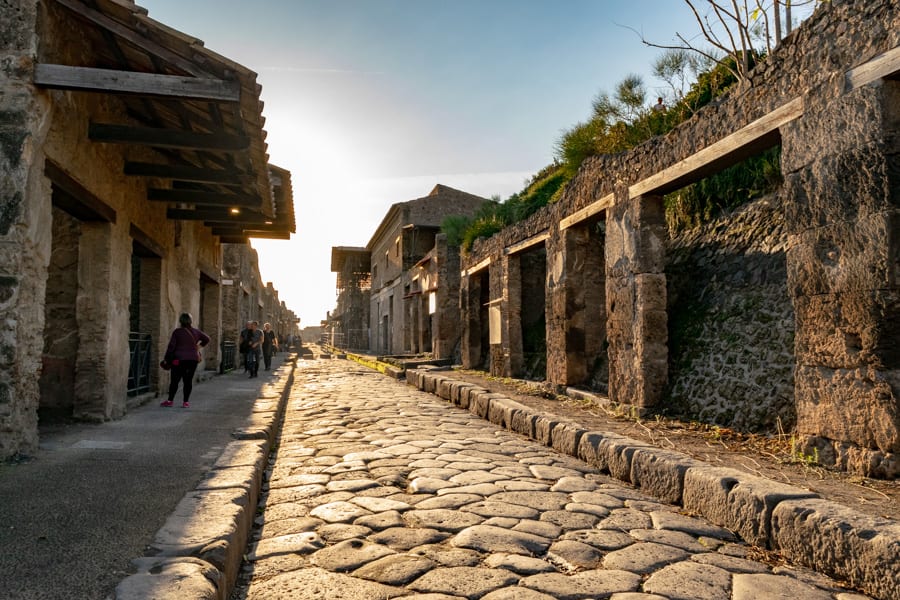
We highly recommend going, it’s an incredible place–just be sure not to overstretch yourself!
Within Rome itself, there’s also plenty to do with extra time!
Consider checking out the Baths of Diocletian, heading out to the Appian Way, visiting the over-the-top neighborhood of Quartiere Coppede , taking a cooking class, or touring more Ancient Roman sites like Santo Stefano Rotondo.
Lesser-known museums like the Galleria Spada and Palazzo Doria Pamphilj are among our favorites and also well worth a visit!
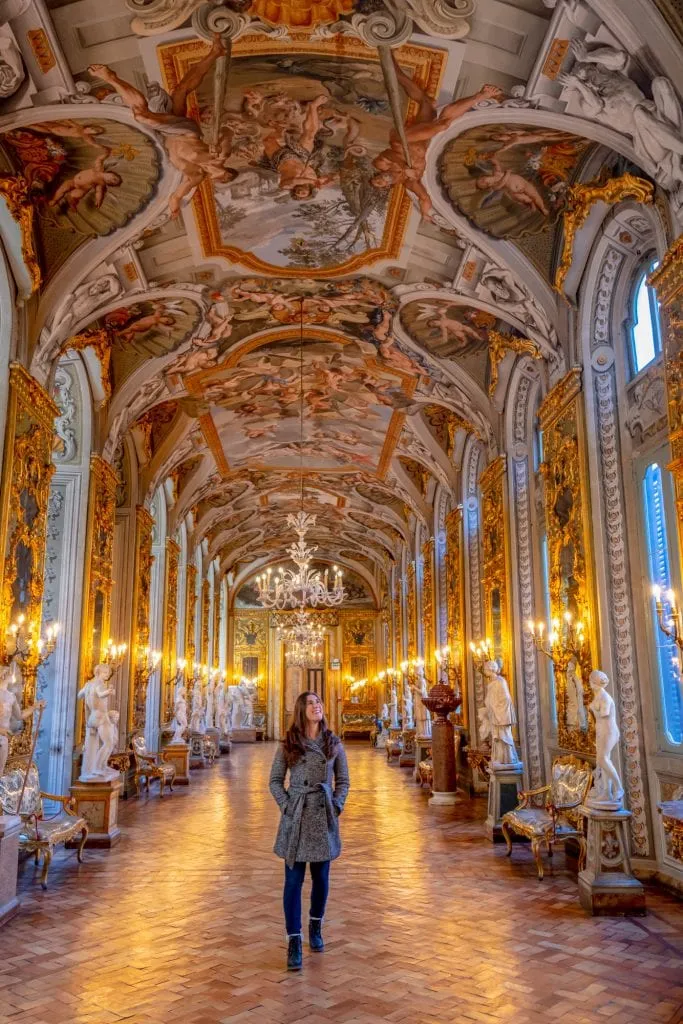
Getting Around During 4 Days in Rome , Italy
We designed this 4 days in Rome itinerary to be as walkable as possible, grouping destinations by geography where we could.
Even still, Rome is large enough that you will need to use other methods of getting around.
The easiest option is simply to use the metro–though Rome’s metro has a mere 3 lines (only 2 of which will likely be of interest to you as a visitor), it connects directly to many of the city’s highlights, including the Colosseum, Trevi Fountain, Spanish Steps, and more.
If you can swing it, your 4 days in Rome will be highly enhanced by staying within a short walk of a metro stop.

Rome’s bus system is also an option, though it can be slightly confusing and you cannot purchase tickets onboard.
Pick them up at a nearby tabacchi or metro stop before hopping on, or aim for simplicity and purchase a multi-day pass to the transport network.
Uber and taxis are both also present in Rome, but Rome’s heavy traffic and their high prices make these options best avoided if possible.
For the same reason, we don’t generally recommend Hop On/Hop Off bus tours in Rome, but they do exist if you prefer them.
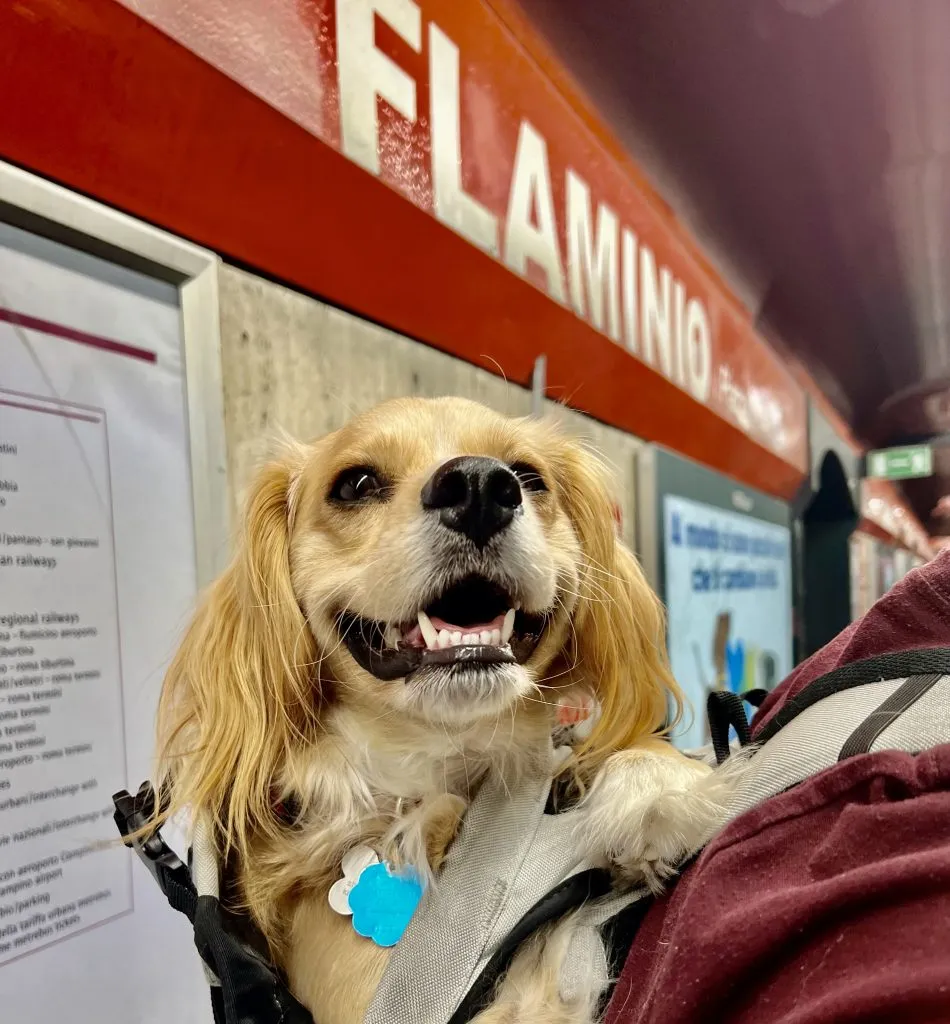
Despite Rome’s international reputation as a pickpocket hotspot, it is, on the whole, a very safe city.
Yes, you do need to keep an eye on your pockets and bags in crowded areas (pay especially close attention in crowded metro stops like Termini and at tourist hotspots like the Trevi Fountain and Colosseum), but we’ve never had so much as a close call during our visits to Rome.
You will see scammers present in Rome’s crowded areas, including men presenting women with roses to try to elicit payment from her companion, “friendship bracelet” offers for bracelets that are free (until they’re tied on your wrist), etc.
It’s best to ignore these scammers entirely, and brush them off with a polite but firm “no” if necessary.
Also, keep in mind that buying and selling fake designer goods is illegal in Italy as both a consumer and a seller.
Be sure to keep your hands off the bags being touted by salesmen in tourist areas, no matter how convincing the imposter might look from a distance.
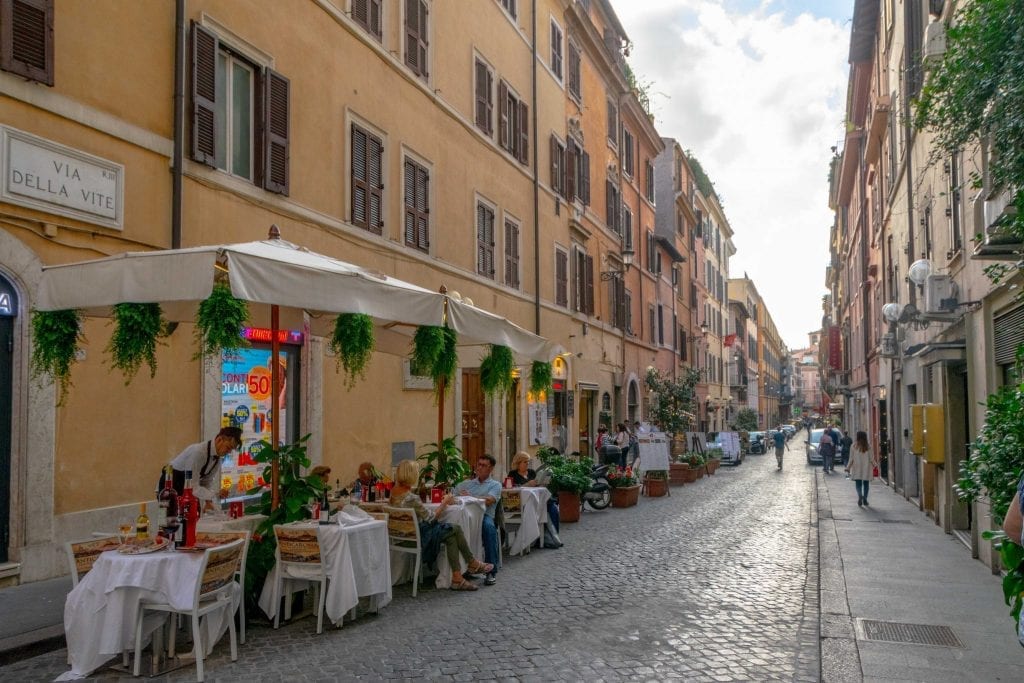
Each season brings a reason to spend 4 days in Rome, and we’ve seen them all in the city!
If you have your pick of dates, though, consider a trip in April or October–both offer high chances of beautiful weather while avoiding the worst of the crowds and prices of the summer high season.
Exploring Rome in winter also has its charms–winters are generally mild in Rome, so if you’re willing to bring along a coat, consider using a winter trip to explore Rome at its emptiest.
Our last choices of times to visit Rome would be July and August, when not only are the prices highest and crowds heaviest, but the weather is also boiling hot.
During summer in Rome, we tend to sightsee in the morning, retreat to air-conditioning in the afternoon, and then come out again starting in the early evening–but it’s not as relaxing as visiting during more mild weather!
(If you are planning a June, July, or August trip, here are our best tips for summer in Italy ).
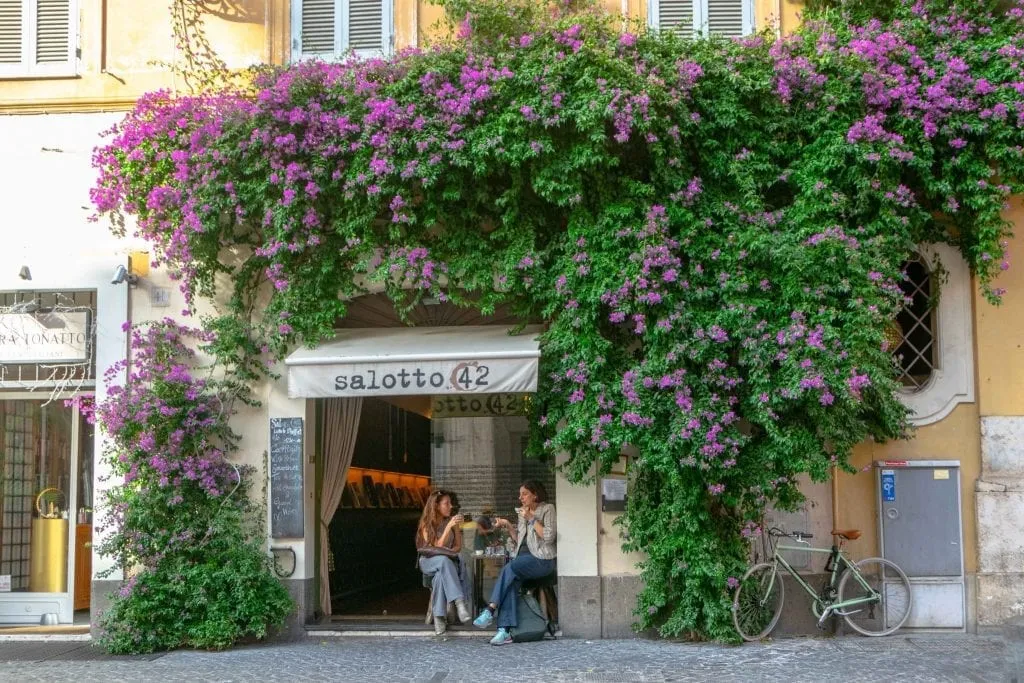
Don’t forget to include these important items when you pack for Rome!
Travel Insurance — We don’t ever suggest traveling without travel insurance–anything can happen, and this is definitely a case of better safe than sorry.
Bring a small pack of tissues, toss them in your day bag, and you won’t have to worry about it.

You’ll be so glad you brought along a Swiss Army Knife!
Option C: Hope you get lucky with the weather (but fair warning, we’ve never been to Italy and avoided rain entirely!).
Take This Map With You! Click each highlight to pull up the name of the destination. To save this map to “Your Places” on Google Maps, click the star to the right of the title. You’ll then be able to find it under the Maps tab of your Google Maps account! To open the map in a new window, click the button on the top right of the map.
[convertkit form=828904]
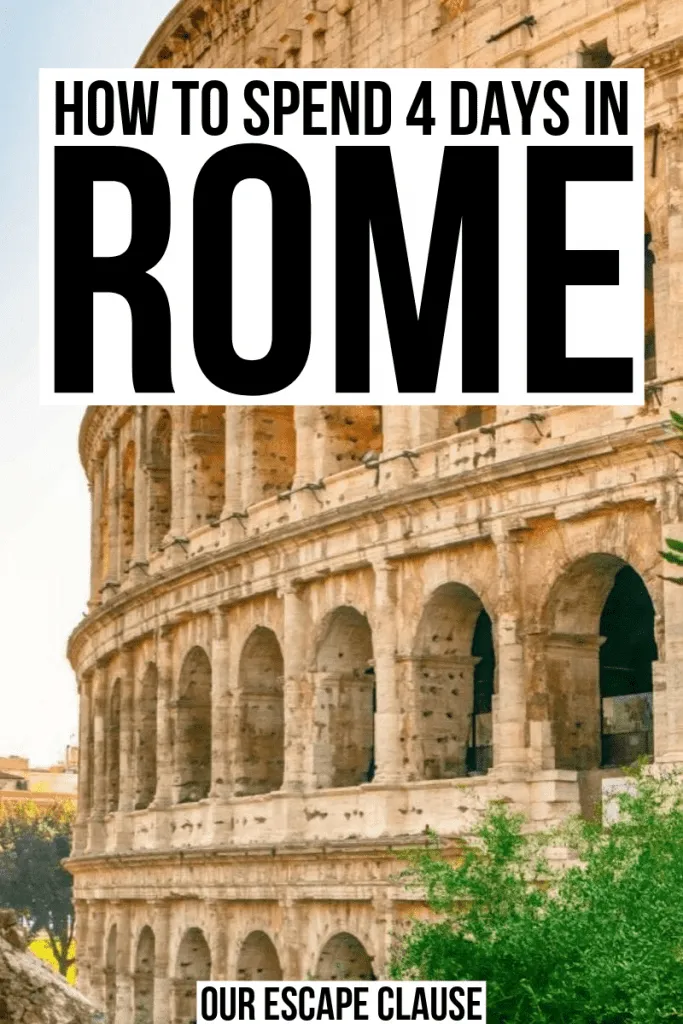
About Kate Storm

In May 2016, I left my suburban life in the USA and became a full-time traveler. Since then, I have visited 50+ countries on 5 continents and lived in Portugal, developing a special love of traveling in Europe (especially Italy) along the way. Today, along with my husband Jeremy and dog Ranger, I’m working toward my eventual goal of splitting my life between Europe and the USA.
31 thoughts on “The Ultimate 4 Days in Rome Itinerary (+ Map & Tips!)”
What an awesome guide! I love how complete it is – no stone unturned! I visited Rome back in 2014 and absolutely loved it. So much to see! Can’t wait to go back one day. Your blog is inspiring me to plan my dream trip: a full month travelling around Italy!
That sounds like an amazing trip! A month in Italy is a fabulous use of time. <3
Hello, Thank you for this! My wife and I spent 4.5 days in Rome in September 2017 and have not stopped taking about it since. The first trip was mostly a “pilgrimage” for us where we did visit many of the churches (though not nearly the 900). We are seriously considering heading back this September and look to do something a bit different. As much as I do love museums, my wife is not much of a fan so I will defer to her 🙂 . However, your itinerary can easily be adjusted to suit our needs (Wed audience in St. Peter Square vs Vatican museums, etc.) and is a super useful guide to areas I never would have considered before (Testaccio) and relatively structured days. Again, thank you!
Thanks so much, Michael! September 2017 was actually when we took our first trip to Rome too, and we can’t stop going back. 🙂 I’m sure you guys have already visited these on your pilgrimage trip, but just in case you haven’t and are looking for more church ideas, some of the coolest churches in Rome IMO that aren’t the completely obvious choices are Basilica di San Clemente and the Santo Stefano Rotondo. Hope you guys have an amazing trip back to Rome!
Thank you for this well-thought out, detailed, and diverse itinerary. Highly appreciated. Looking forward to following many if its stops next month in September.
Thank you so much, Wendy! Have a fabulous trip to Rome! 🙂
This was very insightful
Thanks, Yogita!
I just wanted to thank you because this guide really helped us to have a really awesome trip and saved us tons of time on planing, we did our 5 days trip to Rome on this guide, and the google maps itenerary was a life saver.
Rome was great and this made our trip easier
Best regards, from Lisboa, Portugal!
Thanks so much, Ruben! That is so wonderful to hear. So glad you had an amazing trip!
I travelled to Rome a couple of years ago and this is so close to my itinerary, its not funny. I am so glad to see itineraries like this on the internet that encourage people to go see the historical sights, vs. others that encourage people to ‘skip the important sites’ so as to not waste time.
Thank you for helping people experience the true beauty of Rome
Thank you, Pallavi! That is definitely our goal. 🙂
I just wanted to thank you because this guide will really help us on our 15th anniversary trip later this year. We have never traveled abroad and are so excited. This will save us so much time on planning.
So happy to hear that, Rachel! Hope that you guys have a fantastic trip, and Happy Anniversary!
Hi! My husband and I spent 4 days in Rome in late January 2020 and based our trip around this review. It was perfect for our first time. Thank you so much!
Thank you for sharing, Shareen, that makes my day to hear!
This guide is phenomenal. i was overwhelmed with the incredible options in Rome until I found this guide. We really want to do the food tour in Trastevere you recommend, especially since we are staying in Trastevere. , but there is not very much information about what is included. Is there a better description somewhere or could you give a a quick thumbnail? Thanks!
Thanks so much, John, that’s wonderful to hear!
Unfortunately, the exact Trastevere tour we took isn’t online anymore, but we do link a popular, comparable option in this post: https://www.ourescapeclause.com/trastevere-food-tour/
Trastevere is a popular neighborhood and while each tour will follow its own exact route, you can generally expect to a try a pasta, a cheese shop, gelato, etc–all the classics!
Kate & Jeremy thank you for being so kind and thoughtful to share thitineraries of Rome and additional travel information with the rest of us. I will be in Sorrento the last week of Feb. 2023. Do you know if the port has daily ferry tours to the Amalfi coast? Also travel by vehicle should I be concerned about luggage being stolen during stops as I am traveling. Also, would you have a recommendation on a name of a facility or location I could rent a vehicle. Thank you for your help.
Of course, glad it was helpful!
I’m not sure if the boats run daily during the winter, but I would think so.
For rental cars, we use and recommend Discover Cars–it’s a search engine that will pull up both local and international carriers.
As far as safety, it’s not recommended to leave anything at all visible in your car while parking it. Some people are comfortable with storing luggage out of sight in a vehicle, and others prefer not to take the risk. It’s a matter of personal risk tolerance, essentially.
Loved reading your 4 day guide to Rome, my wife and I are visiting mid August 2023, and aside from visiting the places you mentioned. It would be lovely to know some little restaurants off the typical tourist route that serve really nice Italian food. Hopefully you can send us in the right direction.
We have several, and are always adding new ones to our list!
I try to update them and include options near the attractions where we’re located, but a couple that we like that I don’t think are mentioned here include Osteria La Quercia (near Campo de’ Fiori), Cul de Sac (an enoteca with a huge wine list), Arancio d’Oro, and Antica Osteria Brunetti.
Hope you guys have a great time!
thanks for this information
You’re welcome, have a great time in Rome!
I have thoroughly enjoyed reading through this 4 day itinerary and planning for my stay in Rome. However, after a second look at my reservation I sadly realized I only have 3 days in Rome. Do you have a similar plan for a 3 day stay?
Not yet, though I hope to write one specifically for 3-day visits eventually!
The simplest way to rework this itinerary, though, would be to simply trim off the 4th day, as it covers the most off the beaten path spots of any given day on the route.
However, it depends on your interests! You can also opt to trim off whatever stops don’t sound interesting, and compress your days a bit to squeeze more in to a shorter time frame. For example, if you’re not much for art museums, you could skip the Galleria Borghese and/or the Villa Farnesina, and instead let the Vatican Museums shine as your big museum visit of the trip.
Yes, after looking at day 4, I thought trimming it off might work. Thanks very much for your response and for all the tips you’ve included here.
We were in Rome 10 years ago and are taking my daughter and her Fiance this Oct. This list is exactly what I was looking for! My husband and I would like a day trip to Florence while they do the Vatican (only need to see that once) and I have kept your guide for that as well. Is there a way to learn the bus routes etc? We walked EVERYWHERE on our last trip because we couldnt figure it out. We also used Rick Steves tours for a lot of it too and that was great!
Hi Melissa,
That’s wonderful to hear, thank you!
We don’t use buses a lot in Rome (we generally walk and occasionally take the metro), but you can plan your routes via the bus website! Here it is: https://www.atac.roma.it/
It’s still a bit confusing, but much easier than without any directions. As far as I know, the buses still require that you purchase tickets from a tabaccheria in advance, too–something to keep in mind!
Hi Kate, Love your post and has given me a great advice while we are planning our 21 day trip to Italy. I’m very curious to know what you do as a career/ or money to fund your lifestyle of travel. Would love to be able to see the world. I currently live and work in the US.
Thank you so much!
We’re professional travel bloggers, so our income comes from the ads you see when you scroll through the site and sometimes from a commission if you book something (like a tour or hotel) through one of our links. We don’t accept any sponsored travel and always pay for our own trips.
It did take us years to work up to blogging being a living wage, though! When we started, we were living off of savings from our 9-5 jobs back in Texas. We were one of those couples that quit to travel the world. 🙂
This blog post from years ago (that I’ve since updated) covers a bit of our early days: https://www.ourescapeclause.com/6-month-round-the-world-trip/
Leave a Comment Cancel reply
- Skip to primary navigation
- Skip to main content
- Skip to primary sidebar
- Skip to footer

The Mindful Traveller
Eco Travel Blog & Photography
5 Perfect Days in Rome, Italy: Complete Itinerary
1 April 2022 · In: City Guide , Italy , Rome

Welcome to the Eternal City and vibrant capital of Italy! From the Colosseum to the Pantheon and Vatican City, this Rome 5-day itinerary is perfect for first-timers and is ideal for any time of the year . It will show you all the best things to do and guide you through everything you need to know to make your Italian city break unforgettable.
I visited Rome at the end of December with my partner Matt on a short city break , and I truly fell in love with this city. It was a beautiful discovery, and I was amazed by its culture and history and loved wandering through its narrow streets. I could not recommend you visit it enough, even for a few days!
In this 5-day travel guide, I share the best itinerary covering the top attractions in Rome so you can make the most of your time away. I also provide you with easy eco-tips for travelling responsibility . Enjoy!
Disclosure : Some of the links below are affiliate links, meaning that at no additional cost to you, we will receive a commission if you click through and make a purchase. For more information, read our full affiliate disclosure .
4- Admire the Trevi Fountain
2- explore st peter’s basilica, 5- stroll through piazza navona, 2- visit villa borghese, overview: how to see rome in 5 days.
- Day 1: Colosseum, Altare Alla Patria & Trevi Fountain
- Day 2: Vatican Museums, Chapel Sistine & St Peter’s Basilica
- Day 3: Roman Forum, Pantheon & Piazza Navona
- Day 4: Trastevere, Piazza Santa Maria & Janiculum Hill
- Day 5: Piazza di Spagna, Piazza del Popolo & Villa Borghese
READ MORE: 40 Best & Prettiest Cities to Visit in Europe
Rome 5-day itinerary – Map
Click on the top left of the map to display the list of stops and locations.
Rome travel tips: things to know before you go
- Book tickets for popular attractions in advance.
- Avoid tourist restaurants.
- Always carry cash.
- Wear comfortable shoes to walk around.
- Bring a reusable water bottle to refill anywhere.
- Prepare your itinerary, but do not overplan.
- Do not try to see the Vatican and Colosseum on the same day.
- Keep museum closures in mind.
- Buy bus tickets before boarding.
- Museums are free every first Sunday of the month.
Shop the printable travel itinerary
Plan your dream city break & live a unique experience in Rome.

Detailed itinerary: 5 days in Rome
This Rome guide covers all the best things to do and see in 5 days and is perfect for travelling with family, friends or as a couple, whether it is your first time in the city or you have been there before.
On the other hand, remember that this itinerary is only a guide with recommendations. You can spend more days in the Italian capital or add other stops to your trip.
READ MORE: Rome Winter Guide: 10 Magical Things to Do
Day 1 – The Ancient Rome
1- visit the colosseum.

We began our journey with the Colosseum (Colosseo). I was super excited to discover this impressive monument, and I could not stop thinking about the film Gladiator (we watched it the next night).
Also known as the Flavian Amphitheatre, the Colosseum is an iconic ancient Roman structure located in the heart of Rome. Built during the Flavian dynasty, it was completed in 80 AD.
This colossal amphitheatre, made of concrete and sand, could accommodate 50,000 to 80,000 spectators and was renowned for hosting gladiator contests, animal hunts and other public spectacles .
With its distinctive oval shape and imposing exterior adorned with arches and columns, the Colosseum is a testament to the skills of Roman engineering and is a globally recognised symbol of ancient Rome – a must-visit on your city break!
UNFORGETTABLE EXPERIENCES I RECOMMEND
Once there, I was not disappointed – the outside looked incredible! However, even though we had booked our tour tickets in advance, we had to wait in a long queue to collect them, so I recommend arriving early in the morning.
Inside, we used audio guides to help us better understand the history of the Colosseum. You can also book a tour with a guide, but we wanted to do that ourselves. Plus, the audio guide will explain which way to go.
The inside of the Colosseum was just as impressive as the outside. I could not believe gladiators were fighting there more than 2000 years ago! I also could not believe the monument was still in such good condition – it is something you must see!

2- Discover Vittorio Emmanuelle II Monument
After finishing our tour, we went to eat and, unfortunately, it was too late for the Roman Forum (Foro Romano). Instead, we visited the Vittorio Emmanuelle II Monument (Altare alla Patria), an impressive building in terms of size, especially considering how long ago it was built!
The Victor Emmanuel II Monument, also known as Altare della Patria, is a grandiose national monument . Completed in 1925, it was erected in honour of Victor Emmanuel II, the first king of a unified Italy.
The monument is characterised by its massive white marble structure, grand staircase and an imposing central equestrian statue of Victor Emmanuel II. It is also home to the Tomb of the Unknown Soldier , symbolising the Italian soldiers who lost their lives in World War I.
With its neoclassical design, the Victor Emmanuel II Monument is a prominent landmark you should not miss. In addition, it offers panoramic views of the city from its terraces – especially great at sunset!
🎟️ Book your entrance to the terrace: Panoramic Glass Elevator Ticket with Audio App .
I was amazed each time we passed it during the week. We did not visit the museum part but went up into the building to admire the view.
You can also go on the roof with an elevator, but we found it a bit expensive for what it was (10€), especially when you already have a beautiful view for free.

3- Marvel at the Forums
We then walked down Via dei Fori Imperial to discover other Forums, including the Forum of Trajan, Forum of Augustus and Forum of Nerva . You can not go inside them, but you can often get quite close, and it was still lovely to see. It is something completely different from things you can see in other cities!
Via dei Fori Imperiali is a grand boulevard in the heart of Rome, connecting the Colosseum to Piazza Venezia. Built by Benito Mussolini in the early 20th century, it runs alongside the ancient Roman Forum and passes by several important archaeological sites , including Trajan’s Forum and the Imperial Forums.
I would recommend taking the time to see the Trajan’s Forum , a monumental complex built by Emperor Trajan between 107 and 113 AD. It consists of a large open space surrounded by a series of impressive buildings, such as the Basilica Ulpia , Trajan’s Column and Trajan’s Market .
The entire complex is a remarkable example of Roman imperial architecture and is considered one of the most significant and well-preserved forums from antiquity.
🎟️ Book your tour: Trajan Markets Experience with Multimedia Video .

Finally, we ended our day with the magnificent Trevi Fountain . On our way, everything was quiet, and suddenly it was there, in a small place.
The Trevi Fountain is a renowned Baroque masterpiece located in the historic centre of Rome. Completed in 1762 by architect Nicola Salvi, the fountain is a grandiose structure adorned with elaborate sculptures and reliefs .
The central figure represents Oceanus , the god of the sea, riding a chariot pulled by seahorses and tritons. The fountain is not only a captivating artistic display but also a popular and iconic attraction for travellers from around the world.
The blue colour of the water and the white status made it really special. Unfortunately, it was so crowded, but we still managed to make our way to the fountain. We did not throw a coin in, but you can do it – it is a tradition and brings luck!
🎟️ Book your tour: Uncover the Trevi Fountain and Underground Tour .

Day 2 – Vatican City
Vatican City is one of the emblems of Rome. We started to walk to the Piazza San Pietro, and the crowd was very impressive. Fortunately, we pre-booked tickets for a guided tour of the Vatican Museums and The Sistine Chapel , which made us skip the queue.
1- Tour the Vatican Museums & Sistine Chapel
The Vatican Museums constitute one of the most extensive and impressive art collections in the world. Established by Pope Julius II in the early 16th century, the museums house an array of masterpieces, sculptures and historical artefacts accumulated by different popes over the centuries.
Notable highlights include the Sistine Chapel with the iconic frescoes by Michelangelo , the Raphael Rooms and the Gallery of Maps . The Vatican Museums are undoubtedly an experience to add to your bucket list, as they offer a rich journey through the history of art and culture.
UNFORGETTABLE TOURS I RECOMMEND
Our guided tour was very helpful. Without it, I would have had no idea where I was or what I was observing. Moreover, it was not too long – I love museums but in small doses.
The Museums were gorgeous, and we were lucky enough to see some beautiful masterpieces by Michelangelo.
The Sistine Chapel was a masterpiece in itself. I did not even know where to look. And I was delighted to admire The Last Judgement by Michelangelo – a wonder. Unfortunately, you can not take photos.

After the tour, we continued our way to St Peter’s Basilica , a key religious and cultural landmark worth the visit, despite the crowd!
Small tip : where you are inside the Sistine Chapel, instead of turning left at the end, turn right and continue to the Basilica (for free).
St. Peter’s Basilica is one of the largest and most significant churches in the world. Designed by architects including Michelangelo and Gian Lorenzo Bernini, it constitutes a masterpiece of Renaissance and Baroque architecture .
The basilica is built atop the traditional burial site of Saint Peter, one of the twelve apostles of Jesus, and is a major pilgrimage site. Its notable features include the iconic dome , the Baldacchino canopy over the papal altar and numerous works of art , including the Pieta by Michelangelo.
We started our visit with the top: the Dome , designed by Michelangelo. You have the choice to take the elevator and some stairs, or only the stairs (good luck). The effort was totally worth it, and the view of Rome and the Piazza San Pietro was gorgeous.
After enjoying the scenery, we went back down and visited the inside of the Basilica, which was also beautiful.
We finished our day with the Piazza San Pietro by night: the colours were magical with the Christmas atmosphere.

Day 3 – The Roman Forum & Pantheon
1- visit the roman forum.
Since we did not have time to do the Roman Forum on the first day, we decided to go back on the morning of the third.
The Roman Forum, located in the heart of ancient Rome, is a vast archaeological site displaying the remains of a once bustling centre of political, religious and commercial activities. It served as the focal point of the city for over a millennium, with structures such as the Temple of Saturn , the Arch of Titus and the Senate House .
Surrounded by ruins, columns and triumphal arches, the Forum provides a vivid glimpse into the civic life and architectural grandeur of ancient Rome . It stands as a remarkable testament to the historical and cultural significance of the city.
I was amazed at all these ruins and how people lived before us. We used a map given at the entrance to understand what was there and where we needed to go. We also had a stunning view of the Colosseum and hiked on top of Palatine Hill.

2- Enter the Pantheon
We then headed to the Pantheon , a testament to the ingenuity and skill of ancient Roman builders. It is free and an attraction you need to see!
The Pantheon is a magnificent ancient temple and one of the best-preserved buildings from antiquity . Originally built by Emperor Hadrian around 126 AD, it was dedicated to all the gods of ancient Rome.
It is renowned for its massive dome with an open hole at the top , allowing natural light to illuminate the interior. Its classical design and engineering marvel make it a significant architectural landmark , and it continues today to be used as a Roman Catholic church, known as Santa Maria ad Martyres.
BOOK YOUR ENTRANCE
It was impressive to admire an Ancient Rome monument (the best-preserved) in the heart of the capital. The inside was also unique, with its architecture and hole in the middle of its cupola (we could not help but wonder how they made it).
The hole in the cupola (7,8m in diameter) is the only source of light and represents the connection between the temple and the Gods above (the Pantheon has a Greek origin, in fact, the word Pantheon means “honour all Gods”).

3- Stop by Church Saint-Louis-Des-Français
We continued walking to Piazza Navona and stopped on the way to the Church Saint-Louis-Des-Français (San Luigi Dei Francesi), a Catholic church dedicated to Saint Louis IX, the King of France
Built in the late 16th and early 17th centuries, the church is a fine example of Baroque architecture . One of its notable features is the Chapel of Contarelli , which houses three famous paintings by the Baroque master Caravaggio , depicting scenes from the life of Saint Matthew.
The interior was beautiful, like most churches in Rome. I recommend you go inside as many as you can, this is not something I usually do, but there is something special and unique about Romain churches. We were continuously amazed by their rich architecture and beauty.
4- Relax at Caffè Sant’Eustachio
On the way to Piazza Navona, we also stopped at a historic coffeehouse renowned for its traditional and high-quality espresso: Caffè Sant’Eustachio .
Founded in 1938, it has maintained a reputation for serving some of the best coffee in the city . The café is famous for its unique blend and preparation techniques , including the Gran Caffè method, using a special machine to create a smooth and rich espresso.
With its vintage ambience and a central location near the Pantheon, Caffè Sant’Eustachio is a popular destination for travellers seeking an authentic Roman coffee experience .
We enjoyed our café on the terrace as the weather was lovely – something I recommend.

We then finally reached Piazza Navona , a picturesque square known for its Baroque architecture and vibrant atmosphere . Built on the site of the ancient Stadium of Domitian, the square is home to 3 beautiful fountains, including the famous Fountain of the Four Rivers by Gian Lorenzo Bernini.
Surrounded by charming cafés, restaurants and historic buildings , Piazza Navona is a popular gathering place for locals and tourists alike. The square is also often animated by street performers, artists and musicians, adding to its lively and festive ambience !
The atmosphere was great: children were playing, and there was a cute Christmas market in the middle. I also found in this place a great leather shop named Cartoleria Pantheon dal 1910 that I recommend you visit for the superb quality of its products.
We ended our day by wandering through the little streets toward the Tiber. It was one of my favourite things to do, just because of how beautiful and authentic these streets were, with small shops and lights everywhere – such a great atmosphere.

Day 4 – Trastevere
Trastevere is a charming and historic neighbourhood , located on the west bank of the Tiber River. Known for its narrow cobblestone streets, colourful buildings and lively atmosphere, it retains a distinct medieval character .
The area is popular for its vibrant nightlife , with its many restaurants, bars and artisan shops . It is also home to several remarkable churches, such as the Basilica of Santa Maria in Trastevere , contributing to its cultural and architectural richness.
I recommend taking the time to explore the area. Trastevere offers a delightful mix of local Roman life and bohemian vibes , making it a perfect place for a relaxing stroll.
🎟️ Book your tour: Trastevere Guided Food and Wine Tour with 20+ Tastings .
Trastevere was the area where we were staying, and one of the best for its active life and beautiful streets. We decided to have a chill day there, and for sunset, we walked on a hill by following the road Passeggiata del Gianicolo to have a beautiful view over the entire city.

Day 5 – Piazza di Spagna & Villa Borghese
1- explore piazza di spagna.
We started our day at the Piazza di Spagna , an iconic and bustling square dominated by the famous Spanish Steps , a monumental staircase designed in the 18th century.
At the foot of the steps is the Barcaccia Fountain , designed by Gian Lorenzo Bernini’s father, Pietro.
Piazza di Spagna is also surrounded by luxury boutiques, cafés and art galleries , making it a lively and fashionable area, particularly ideal for shopping lovers!

We went down the stairs and walked to Piazza del Popolo . We could not find anything special to do there, so we went up to the Villa Borghese , a large public park.
Originally a private vineyard and garden of the Borghese family in the 17th century, it was later transformed into a public park in the 19th century. It now features lush greenery, walking paths, fountains and a lake , providing a peaceful retreat from the hustle and bustle of the city.
Within Villa Borghese, you will also find the Galleria Borghese , which houses an impressive art collection , including works by Caravaggio, Bernini and Raphael, making it a cultural haven amid the natural beauty of the park.
In addition, the park is a great place for families with children, as you can row boats on a small lake, visit a zoo or watch a play in front of a replica of Shakespeare’s Globe Theatre. We also had a lovely coffee on the terrace of Casina del Lago.
For sunset and our last evening, we again went to the top of the Vittorio Emmanuelle II Monument. The beautiful colours over Rome made it the perfect way to end our trip and say goodbye to this incredible city.

Cooking experiences I recommend
My top 6 pizzerias in rome.
As you may know, Italy makes incredible pizzas, so we challenged ourselves to eat one daily and rate them.
Here are our favourite 6 pizzerias in Rome:
- Bottega Rocchi, near the Pantheon
- Dar Poeta, in Trastevere
- Il Bersagliere
- La Bruschetta E, near the Borghese Park
- Ristorante Pizzeria Imperiale, near the Colosseum
- CasaRita, in Trastevere
How to get to Rome
The best way to get to Rome will depend on where you come from and your budget, but there are many options to reach the Italian capital.
One of the quickest ways to get to Rome is by plane . If you are travelling from another country or a distant city, you will likely arrive at Leonardo da Vinci Fiumicino Airport (FCO), the primary international airport well-connected to major cities in Europe and the world.
Another airport serving Rome is Ciampino Airport (CIA), mainly used by budget airlines. From both airports, you can take a taxi, bus or train to reach the city centre.
One of the most eco-friendly ways to get to Rome is by train . Italy has an extensive and efficient rail network, and Rome is well-connected to major European cities by train. Its main train station is Termini Station, which you will find in the city centre.
Finally, the most affordable option for getting to Rome is by coach . It is a great way to reach the Italian capital if you are exploring Europe on a budget, but it may take longer. Several international and national bus companies operate services to and from Rome via its main terminal, Tiburtina Station. In addition, check out the Eurolines bus service.

How to get around Rome
The great thing about Rome is that it is not a big city so you can easily do everything on foot . That is what we did during our five days there, and it was perfect. And because it can get hot in summer, bring a reusable water bottle to stay hydrated! Rome has plenty of free fountains offering fresh and cold water.
Rome also has a vast public transportation network consisting of buses, a subway and trams. For example, we used the bus once to reach the Colosseum with the app Moveit . You can also use TicketAppy . It will help you book your ticket on your phone and avoid wasting paper.
Another great way to travel around Rome is by bike . It is ideal for slowing down and appreciating your surroundings. And if you need a boost, rent an electric bike.
Finally, if you want to explore outside of Rome, I would look at buses, trains or small guided tours – depending on where you want to go and for how long.

Where to stay in Rome
The best neighbourhoods in rome.
Are you looking for the best place to stay in Rome? Here is an overview of the top neighbourhoods in the Italian capital:
- Centro Storico: the best area for first-time visitors
- Trastevere : the best area for couples
- Piazza di Spagna : the best area for luxury hotels
- Monti & Colosseum : the best area for history lovers
- Prati & Vatican : the best area for a quiet stay
- Esquilino & Roma Termini : the best area to stay on a budget
- Testaccio : the best area for food lovers
- San Giovanni : the best area for local vibes
🏨 READ MORE: Where to Stay in Rome: 8 Best Areas (& Green Hotels)
My experience
My partner Matt and I booked an apartment on Airbnb for five days in Trastevere , an ideal location with everything within easy walking distance. Plus, the view was incredible! We were also lucky to have a small terrace on the roof to enjoy the view of Rome on sunny days.

Best time to visit Rome
Spring (April to June) and autumn (September to October) are the best times to visit Rome, as the weather is mild and pleasant with fewer crowds, which is ideal for sightseeing.
In spring, the city comes alive with blooming flowers and diverse events, making it an excellent time for exploring and enjoying outdoor activities. Autumn also enjoys beautiful colours and is a great time to experience the city without the intense heat of summer.
Summer (July to August) in Rome can be hot, with temperatures often exceeding 30°c. It is also the peak tourist season, so popular attractions can be crowded. But despite the crowds, this season offers longer daylight hours, allowing for extended sightseeing and enjoying outdoor cafés.
Winter (November to March) is relatively mild compared to some northern European cities, but it can be chilly and rainy. And whilst it is the low season, you can discover the capital without the crowds – except around Christmas! In addition, some attractions may have shorter opening hours.
I visited Rome at the end of December with my partner Matt, as we wanted to experience the unique city of Rome in winter and spend New Year’s Eve. I loved it! The atmosphere was incredible, and the temperatures were not cold (around 13 degrees). It was busy, and we struggled a bit from time to time, for the Colosseum, for example. Otherwise, everything was perfect. Just book your tickets in advance, and you will be fine!

Sustainable travel in Rome
Sustainable travel means exploring the world whilst being aware of your surroundings and having a positive social, environmental and economic impact on the places you visit.
But how to make your next trip to Rome more sustainable?
Here are some sustainable tips for responsible travel in Rome:
- Book direct flights and offset your carbon footprint . But, do not use carbon offsetting as a complete solution. Combine it with other sustainable practices, like avoiding single-use plastic on the plane and mindfully packing your suitcase to be ready for your green adventure.
- Choose direct flights to reach Rome as it generally requires less fuel than indirect flights. ( Skyscanner has an option that only shows flights with lower CO₂ emissions).
- Select an eco-friendly accommodation . It is not always easy to determine whether a hotel has eco-conscious practices, but try to look on their website for green credentials. You can also use Bookdifferent to help you decide.
- Use public transport as much as possible or walk ! Rome is easily accessible on foot, and you will not produce any emissions.
- Eat at local Roman restaurants that use produce from the region. It will contribute to the local economy and reduce the carbon footprint by supporting restaurants where food does not come from long distances.
- Always respect the local heritage . Treat people and their surroundings with respect. Sustainable travel is not only about the environment but also about the local communities. So, always be respectful and try to learn a few Italian words!
More inspiration for your green vacation:
- Best Travel Apps for Exploring Sustainably
- 15 Travel Books to Inspire Your Next Eco-Adventure
- Best Ecotourism Activities Around the World
Eco-friendly gear you might love:
- 10 Best Sustainable Backpacks for Travel & Hiking
- 10 Best Reusable & Eco-Friendly Travel Mugs
- 8 Best Filtered Water Bottles for Travel & Hiking
Check out this page for more inspiration on eco-friendly products & gear.

Rome travel planning guide
🚑 Should I buy travel insurance to travel to Rome? Yes, buying insurance is always valuable when travelling abroad. Enjoy your city break in Rome stress-free with one of my favourite providers, Nomad Insurance .
💧 Can you drink the water in Rome? Yes, tap water is safe to drink all over Rome. However, I also recommend travelling with the UltraPress Purifier Bottle , a lightweight filtered water bottle perfect for reducing plastic and staying hydrated.
🚗 Is it easy to rent a car in Rome? Yes, renting a car in Rome is easy and a great way to explore the Italian countryside freely. I recommend booking yours with Rentalcars.com – they offer a variety of operators for all budgets.
🏨 How to book accommodation in Rome? The best way to book your accommodation in Rome is with Booking.com – my favourite platform to compare and reserve places to stay each night, from affordable guesthouses to luxury hotels.
✈️ What is the best site to buy a flight to Rome? I recommend booking your plane with Skyscanner . It has been my favourite platform for years, as it allows me to book the cheapest flights whilst lowering my carbon emissions.
5 days in Rome, Italy – FAQ
4 days are the perfect amount of time to discover Rome and see the core sights of the city. It will allow you to spend time at the Colosseum, Vatican City, Trevi Fountain, Spanish Steps and the vibrant Trastevere – without rushing. Visiting big sites like the Colosseum or Vatican City takes time and energy – and we often had to push back what we had planned afterwards.
Rome has become one of the most expensive tourist destinations in Europe due to its high number of visitors and attractions. However, it also all depends on how much you decide to spend, and there are still a lot of local and authentic places for small budgets.
Spring (March to April) and autumn (September to November) are the best times to visit Rome. These months offer nice mild weather (summer is hot!) without too many tourist crowds, which is the perfect combination to enjoy the best of Rome.
The best way to get around Rome is on foot. Rome is a very accessible city, and many of the best attractions are concentrated together in traffic-free areas. If some places are a bit far from your accommodation, the other best modes of transport would be buses or taxis.
Yes, Rome is considered a safe destination for tourists, including in the evening. Of course, it is always a good idea to stay informed and use common sense. But Rome is a popular and much-visited city, and many tourists take advantage of their evenings to explore its bustling streets and dine in its charming restaurants.
Shop the Rome eco-travel bingo
Learn how to live an unforgettable experience in Rome whilst respecting places and locals.

And you, have you ever visited Rome or would you like to go one day? Let me know in the comments below!
With love ♡ Lucie
- Share on Twitter Share on Twitter
- Share on Facebook Share on Facebook
- Share on Pinterest Share on Pinterest
You will also love

STAY INSPIRED
Join our community today to receive exclusive travel tips & behind-the-scene stories that will inspire your next adventures, directly to your inbox. Can't wait to see you inside ♡
Reader Interactions
13 December 2022 at 18:19
Thanks for this post. I am planning an anniversary trip to Rome next year and I’ve been planning what I want to see. Your posts have some many tips and spots worth to see!
Leave a Reply Cancel reply
Your email address will not be published. Required fields are marked *
Save my name, email, and website in this browser for the next time I comment.

The Lake District Sustainable Travel Guide
Follow the journey.

On the Blog
- Privacy Policy
Become an insider!
And receive exclusive travel tips & behind-the-scene stories ♡
Copyright Lucie Charpentier © 2024 · Theme by 17th Avenue
- Work with us
- Favorite travel blogs
- netherlands
- switzerland
- family travel
- food and wine
- trip planning resources
- accommodation guides
- travel gear guides
- itineraries
- packing guides
- travel gifts
- health and safety
europe , italy , itineraries
5 days in rome itinerary – highlights and secrets of the eternal city.
This article may contain compensated links. See our full disclosure here
Let’s go to Rome! It’s the city that once ruled them all. This 5 days in Rome itinerary shows you the very best of the city – centuries of history, a modern living metropolis and some of the best food in the world.
For the first time visitor, or even those returning after a long while, with 5 days in Rome, you have ample time to visit the classic sights and uncover some of the city’s lesser known secrets. You can marvel at some of humankind’s greatest creations, bask in the sun in a cobbled piazza and eat gelato beside baroque fountains.
You might even stand in the very spot Julius Caesar was assassinated. Doesn’t that give you goosebumps?
This itinerary is based on several trips we did to Rome with adjustments for what we learnt.
It includes:
- practical information to help you plan your trip
- tips for getting around
- ideas for where (and what) to eat including the best gelato stops
- recommended hotels
- ticket information and recommended tours
Traveling to Italy in 2023?
Make sure to check the latest travel restrictions and advice before making bookings. Purchasing travel insurance for your trip to cover mishaps and health emergencies is a good idea. Policy costs vary by your country of residence, what is covered, age, existing conditions and the insurer. Visit Worldnomads for a quick quote. We use this company for our family travels and find the cost, coverage and claims process to be good to excellent. Another option if you are in the United States is Safety Wing’s Nomad Insurance . Unfortunately neither option provides policies for those aged over 69. In this case you can try Travel Insurance Master – a service that allows you to compare quotes and insurance policies.
- 5 days in Rome overview and highlights
This itinerary is arranged so you have time to explore Rome and visit all the major highlights with stops for gelato, shopping and exploring in between.
We recommend keeping your first day in Rome low key so you can recover from your journey. That way you can see the big sights – Colosseum and Vatican – when you are nicely rested. There is a lot to take in!
There’s room at the end to explore your favorite parts of the city, some secret spots or even take a day trip to Tivoli or the medieval towns north of Rome.
We hope you enjoy our guide to Rome in 5 days.
What's in this article
Day 1 – Explore the Centro Storico
Day 2 – ancient rome, day 3 – villa borghese, the tiber and more, day 4 – vatican, day 5 – roman secrets or a day trip, practical information, our final thoughts on rome.
Planning a trip to Italy? Join our free Italy Travel Planning Facebook group and read our detailed guide for tips, information and advice for planning your travel to Italy
Once you have settled into your accommodation (you can see our recommendations below if you haven’t booked already), walk off your travel weary legs by taking a leisurely stroll around Rome’s centro storico – historic old town.
This is the cuore (heart) of Rome and it’s impossibly romantic. Cobbled streets open onto wide piazzas with gushing baroque fountains.
Around every corner there is an ancient monument waiting to be discovered. This is your day to wander and enjoy the sights, sounds and smells of Rome.
This area is very compact, and with a few exceptions, quite flat. So it is easy to walk around and enjoy. In any case, if you get tired you can eat a gelato or relax with a coffee. When in Rome right?
Must see sights of Rome
Of course you have probably seen all these places in photos but there is nothing quite seeing them up close. Make sure you have your camera ready!
- Spanish Steps – built in the 18th century, the Spanish Steps connect the Piazza di Spagna to Piazza Trinita dei Monti where a church of the same name overlooks the city. There are 135 steps to climb to reach the prize views of Rome.
- Trevi Fountain – immortalized in Fellini’s La Dolce Vita , this cascading baroque marble fountain is an icon of the city that must not be missed on any trip to Rome. Don’t forget to toss a coin over your shoulder into the water – they say it guarantees you will return to Rome!
Did you know.. over €3,000 is collected each day from the Trevi Fountain. The funds are donated to charities supporting Rome’s homeless and needy
- Pantheon – standing intact for over 2,000 years, the Pantheon was once a Roman temple before being consecrated as a Catholic church. Most impressive is the giant dome that sits on top of the structure. It is the largest unsupported dome in the world to this day and an incredible architectural feat. Light is let into the Pantheon by the giant oculus or hole in the dome. It has a very spiritual feel so it is not surprising that it caused Michelangelo to wonder whether it was the work of angels or humans.
- Piazza Navona – once the site of an ancient Roman stadium, this area was transformed in the 17th century into impressive Piazza Navona with its three ornate fountains. The most impressive is the central Fountain of the four Rivers with its Egyptian obelisk.
As you wander, make sure to duck into some of the 900 churches in the city – many hold priceless art. A favorite, the Chiesa di Sant’Ignazio di Loyola [Via del Caravita, 8a], is a baroque masterpiece.
Close to Piazza Navona, the area around Campo de’Fiori market square is a great place to stop for dinner. Once the market stalls are packed away, the area is bustling with tourists and locals enjoying their evening.
Suggested guided tours
Some people like to explore on their own, and others use a guidebook. We enjoy small group guided tours to hear about the stories, history and culture of the places we visit.
In fact, we love them so much we have a whole article on the best tours to take in Rome . But if you are interested in a highlights tour and introduction to Rome these are our favourites
- Free walking tour of Rome [expect a big group – tips expected] – > click here for info
- Welcome to Rome Twilight tour – lovely introduction to the Eternal City – > click for details
- Best for families – From Gladiators to Gelato (Withlocals) or try Rome4Kids – > read our full review
Our favorite tour companies in Rome
- Small group tours (up to 14 per group) – Take Walks
- Very small group tours (6 per group) – LivTours
- Private tours – Withlocals
- Food tours – Eating Europe
Where to eat
Try Roscioli [Via dei Giubbonari, 21] near Campo de’Fiori for their classic spaghetti carbonara or Pane e Salame near the Trevi Fountain [Via Santa Maria in Via, 19] for quick and delicious meat and cheese platters Roman style.
Gelato stop: Giolitti [Via Uffici del Vicario, 40] This classic establishment has been serving Romans gelato since 1900!
Once a small town on the Tiber river, Rome became the most biggest city in the world. Rome was the centre of the Roman Republic, and later the Roman Empire, that spanned 1,500 years.
At its peak the Roman Empire covered 5 million square kilometres and governed 70 million people – around 21% of the world’s population.
It is impossible to overstate the impact of this period on world history. Our language, architecture, art and political customs and institutions are all founded on Roman principles.
On your second day in Rome, it is time to walk in the footsteps of emperors and marvel at what they created.
The Colosseum
Rise early and beat the crowds to view the Colosseum. This huge stadium is the largest amphitheatre ever built and once held up to 80,000 spectators cheering on their favorite gladiator.
The Colosseum, also known as the Flavian Amphitheatre, is an iconic monument of the Roman Empire and is a must see site in Rome.
In its heyday the amphitheatre was clad in ivory travertine marble, though this was plundered throughout the centuries. What remains are the foundational materials made of concrete sand.
The Colosseum was used for mass entertainment. The people of Rome came there to watch gladiators in combat, animals fighting and it was even flooded for mock naval battles.
Must see sights at the Colosseum
- Arena floor – where all the action happened
- Hypogeum – underneath the floor where slaves and animals were held
- Special boxes – where the Emperor and Vestal Virgins sat
- Podium – reserved for the Senators
- Maenianum primum tier – where the noble class and knights sat
- Maenianum secundum tier – seating for ordinary Roman citizens
- Maenianum secundum in legneis – for women, slaves and the poor
The Roman Forum
Next to the Colosseum there is a huge field of ruins known as the Roman Forum . This was the center of ancient Rome and where all the important government buildings and temples once stood.
To the untrained eye it is a mound of ruins, but if you take a tour or use a guidebook (we recommend this one ) you will learn just how important this area was in Roman life.
Before you enter the Forum, admire the magnificent 1,700 year old Arch of Constantine dedicated to a famous battle between Constantine and Maxentius in 312AD
Must see sights at the Roman Forum
- Arch of Titus – celebrates the conquest of Jerusalem
- Maxentius’ basilica – a place for public meetings that inspired Renaissance architects
- Temple of Antoninus and Faustina
- Temple of Vesta – home to the sacred flame of Rome
Palatine Hill
Nearby Palatine Hill was a residential area for Roman nobility. This is one of the seven hills of Rome and provides incredible views of the city, Colosseum, Circus Maximus and ruins below.
Must see sights at the Palantine Hill
- Flavian Palace
- House of Augustus
- House of Livia
- Stadium of Domitian
Tickets for the Colosseum and ancient sites
Unless you are visiting the Colosseum in winter it is advisable to prebook tickets or a tour.
This is because when you have limited time you don’t want to waste it spending time in a line – and believe me, they are long (over an hour at peak times).
There are 2 types of tickets – both are the same price – €12 + €2 booking fee for adults if you book via the completely confusing official site
- Scheduled entrance – a set time starting from 08:30am (get there half an hour prior to your time slot)
- Open ticket – you must enter after 14:00pm
These tickets allow access to the ground, first and second tiers of the amphitheatre. If you want to visit the arena floor, underground area and belvedere (3rd level) you will need to do that as part of a tour.
Note – Both types of tickets to the Colosseum also include entrance to the Roman Forum and Palatine Hill. You can only enter each site once but the ticket is valid for 2 consecutive days.
The Colosseum is open from 8:30 am – 4:30 pm daily except January 1st, May 1st and December 25th. You can take advantage of later opening times in summer.
There is no charge for children under 18 but they still need a ticket that incurs a booking fee – more information
As I mentioned, I frequently visit the official Colosseum site and find it extremely confusing. We booked tickets via our favorite online tour booking system Get Your Guide and it was easy (read our full Get Your Guide review here )
BOOK: Colosseum skip the line tickets here or a basic guided tour here
Tips for visiting the Colosseum
Take the metro Line B to Colosseo, Line 3 tram or bus lines 75 – 81 – 673 – 175 – 204
Wear comfortable shoes and bring water and a snack. The site is open to the elements so if it is cool you will need a jacket or coat and in summer a hat and sunscreen are advisable.
Be prepared for lines for security checks. You may not bring large bags or backpacks into the site.
There is a lift at the Colosseum to take those with small children or mobility issues to the upper levels.
There are minimal catering facilities on site, bring some snacks.
Suggested guided tours of the Colosseum
You can absolutely visit these sites on your own, with a guidebook or audioguide. I have done that several times and enjoyed it.
But I learnt so much more when we took a guided tour and to access some areas of the Colosseum – arena, level 3 viewing area, underground – you must take a tour.
There are 1000s of tours offered for this area – here are the ones that are easy to book and cover the most exciting sights.
- Small group tour of the Colosseum, Forum and Palantine Hill – >click here for info
- Large group tour of major Roman sites – >click for details
- 2 hour arena and underground Colosseum tour – click for information” href=”https://www.untoldmorsels.com/recommends/click-for-information/” target=”_blank” rel=”nofollow noopener”> >click for information
- Virtual reality tour of the Colosseum (so cool!) – >more information
- Upper tiers (opened 2018) tour of the Colosseum – >click for more details
- For families – we joined Rome4Kids on their special Colosseum tour – read our review
BOOK: TakeWalks Colosseum tours are our favorite small group tours but they do sell out quickly.
Remainder of day 2
Expect your visit to the ancient Roman sites to take around 3 hours. After that, you might like to explore the delightful Monti district nearby.
Monti is perfect for wandering, stopping for a drink or gelato and browsing boutiques
Or continue your immersion into ancient Rome by visiting Trajan’s Market – the commercial hub of Ancient Rome. There is an interesting museum of artifacts here too – >more information
Lastly, go to Piazza Venezia to marvel at the Altar of the Fatherland, the huge classical style monument to Italy’s first king and soldiers who served in the first world war.
You can take a lift to the Terrazza delle Quadrighe for incredible views of the ancient sights of the city. Access is from the main entrance – >more information
If you want to stop for lunch near to the Colosseum, we recommend Alle Carrette [ Via della Madonna dei Monti, 95] a casual pizza restaurant in the Monti district near the Colosseum.
In the evening why not join a Twilight Testaccio Rome Food Tour . If you have never been on a food tour, you are in for a treat. They are a great way to discover the best places to eat and drink in any city.
In Rome you taste the famous local pasta and pizza and delicious wines from the region as your guide tells you about the city and vibrant Trastevere district. If you have food preferences or allergies, don’t worry, they work around this.
We’ve tried quite a few food tours around Rome. You can read about them in our guide to the best food tours in the city.
Gelato stop: Fatamorgana Monti [Piazza degli Zingari, 5] Classic and unusual flavors using the finest ingredients
On your third day in Rome, slow the pace down a little and take some time to explore some of the lesser known sights of the city.
Head to Piazza del Popolo, the site of the city’s north gate and where the largest obelisk in Rome stands. This huge cobbled square is an example of Renaissance town planning. Several large streets radiate from the piazza to form the backbone of modern Rome.
Depending on where you are staying, catch metro Linea A to Flaminio stop at Piazza del Popolo, one of several buses or even walk.
From the piazza take the stairs up to Terrazza del Pincio for impressive views over the rooftops of Rome. Try and count the church domes and spires, there are hundreds on the skyline. You can also see St Peter’s basilica and the Vatican in the distance.
Close to the terrace you can hire electric bikes to ride around the Pincio and Villa Borghese gardens. We enjoyed clearing our heads with this activity in these beautiful surrounds
Highlights of the gardens
- Fontana dei Cavalli Marini – beautiful fountain in the heart of the gardens
- Temple of Aesculapius – a 19th century structure built on the park’s artificial lake
- Globe theatre – a reconstruction of Shakespeare’s Globe right in the heart of Rome!
- Bioparco di Roma – Rome’s small city zoo – worth a visit with small children
- Playground near the Porta Pinciana gate useful with kids too
Galleria Borghese
The main reason people head to this part of the city is to visit the incredible collection of Renaissance and ancient treasures at the Galleria Borghese (Borghese Gallery)
Once the private residence of the powerful Borghese family, the 22 rooms of the villa are bursting with masterpieces by Titian, Raphael, Caravaggio, and Rubens.
What to see at Galleria Borghese
- Young Woman with a Unicorn – Raphael’s portrait inspired by the Mona Lisa
- Apollo and Daphne – exquisitely detailed marble statue by Bernini
- Sleeping Hermaphrodite – an ancient marble statue of a sleeping nude woman
Tips, tickets and tours for Galleria Borghese
Visitor numbers are strictly limited to the gallery and managed by pre sale time scheduled tickets. You need to book well in advance (around a month) to secure a time slot.
This is the official site but once again, it is complicated to navigate.
Here is a link to an English language site alternative – >click here for tickets
The gallery is open Tuesday to Sunday, from 08.30 to 19.30
This gallery is almost too much to take in. Although compact, there are so many brilliant pieces of art on display that if you are an art lover, a guided tour is recommended – >click here for details
Cameras and bags are not permitted inside the Borghese Gallery, but there is a cloakroom where they can be checked.
Unfortunately there is no lift inside the gallery so the visit is not suitable for those with mobility issues.
After the gardens and gallery it is time for lunch. There are lots of great places to eat in this area – our suggestions are below.
After lunch take a walk down the main street of Rome – Via del Corso.
This cobbled thoroughfare is also the city’s main shopping street with the usual European brands H&M and Zara well represented. If you want to browse the Gucci, Bulgari or Chanel designer boutiques, visit Via Condotti.
Otherwise continue your walk down picturesque Via dei Coronari where the only thing to do is soak up the atmosphere, browse antique and jewelry shops and stop for gelato at Gelateria del Teatro – details below.
A walk along the Tiber
I don’t know about you but viewing art and shopping always makes me tired. A walk along the Tiber river is just the thing to recharge the batteries before dinner. As an added bonus the sunset over Castel Sant’Angelo is absolutely beautiful.
From the Ponte Vittorio Emanuele II you can do a little circuit that takes you in front of the castle and across the ancient Ponte St Angelo or Bridge of Angels named for its ten beautiful statues designed by Bernini.
Elegant Dal Bolognese at Piazza del Popolo 1 serves traditional dishes from the Emilia Romagna region. Or for something less formal Ristorante Rosati Roma [Piazza del Popolo, 4/5a] is one of the original bars in the city.
Gelato stop: Gelateria del Teatro [Via dei Coronari, 65-66] 200 delicious flavors that rotate year round
On day four of your 5 day tour of Rome it is time to explore the area known as the Vatican.
The Vatican City is in fact an independent state within the city of Rome with its own government and political structure. The Pope is the head of the Vatican City State and members of the Catholic church hold the high positions of authority in the government.
You technically enter another country when you visit the Vatican which is pretty cool but unfortunately they don’t issue stamps for your passport.
While you are exploring the area, keep an eye out for the Vatican’s Swiss Guard. They are dedicated to safeguarding the Pope and wear a traditional Renaissance style uniform.
There are two main sites in the Vatican – St Peter’s Basilica and the Vatican Museums. You must visit both sites once in your lifetime even if you are not Catholic or religious. They are both incredible places to visit for their architecture, art and history.
Family travel tip – If you are traveling with kids under the age of 10 or who are easily bored and frustrated I would skip the Vatican Museums unless you book a special family tour. Spend your time at St Peter’s and Castel Sant’Angelo instead.
St Peter’s Basilica
Imposing St Peter’s basilica dominates the western side of the Tiber River and you can’t fail to be impressed by the grandeur of this monument to Christianity.
The Pope himself appears here in the Piazza san Pietro most Wednesdays to address the crowds. If you want to take part in the Papal Audience you should prepare yourself with these tips .
St Peter’s is free to enter and view its incredible artwork and beauty including Michelangelo’s Pieta sculpture and dome also designed by the artist.
If views are your thing, then climb the stairs or take the elevator part of the way to the top of the dome (saving 300+ stairs). To get to the very top there are over 230 more stairs. It costs €10 with the elevator and €8 without. You can buy tickets at the kiosk after you pass security to enter the basilica.
You can also visit the tombs of kings, queens and former popes interred inside the basilica’s crypt.
St Peter’s is open daily 7:00am to 19:00pm with exceptions for events.
The Vatican Museums
The Vatican’s collection of art and artefacts is one of the most extensive in the world.
Inside these walls are masterpieces by some of the most talented artists in history – Michelangelo, Raphael, and Leonardo da Vinci.
The Vatican Museums are a truly awe-inspiring place. It is the ultimate palace covered in gold, artwork, sculptures and other treasures.
This is the most popular sights in Rome and attracts millions of visitors a year. Expect to spend 2-3 hours in the museums before you reach the finale – the Sistine Chapel
The Vatican Museums are open from Monday to Saturday from 09:00 am to 18:00 pm. An adult ticket is €17 [2020] Note – they are closed on most Sundays and other days throughout the year – check their site for more information
Highlights of the Vatican museums
- Sistine Chapel with its famous ceiling painted by Michelangelo
- Spiral staircase designed by Giuseppe Momo
- The Raphael Rooms – frescoes by Raphael and Michelangelo
- Gallery of Maps – 120 metres of painted topographical maps
- Sala Rotonda – a smaller scale version of the Pantheon
Vatican Gardens
Unlike the rest of the complex, the Vatican Gardens are a haven away from the crowds. These stunning manicured gardens feature fountains, grottoes and statues and have sections with English, French and Italian landscaping styles.
The gardens are the only place from which you can see Michelangelo’s dome of St Peter’s in its entirety.
The only way to visit the gardens is on a 2 hour tour with a live or audio guide. Included in the price are fast track tickets for the Vatican Museum and St Peter’s so it is well worth considering
Tickets for the tours sell quickly. You need to book at least a week in advance. The official site is here but we can also recommend this combination tour of the Vatican sites on Get Your Guide where you can read exactly what you will be seeing and what others thought.
St Peter’s tomb
St Peter’s tomb is one of the most sacred sites for Christian’s around the world. The Vatican offers a one and half hour tour of the Necropolis way below the ground floor of St Peter’s to visit the tomb.
Only 250 visitors are allowed each day so you must book well in advance using a special form and process that you will find here
Tips for visiting the Vatican and surrounding area
Visiting St Peter’s and the Vatican Museums is a half day activity [3-4 hours] involving a lot of walking and crowds. We strongly advise that you prebook tickets to make the most of your time in Rome.
Prebook your Vatican Museum tickets – book tickets here or a guided tour here
The closest Metro stop is Ottaviano-S. Pietro on Line A. From there it is a 5 minute walk from to both St Peter’s Square and the Vatican Museums.
Lines to pass through security for St Peter’s average 45 minutes after 11:00am so plan to arrive early if you are there just to visit St Peter’s and not the museums.
If you are visiting the Vatican Museums there is a separate line. This one can be as long as 2-3 hours in the summer. We strongly recommend buying skip the line tickets or a tour of the Vatican – details are below. If you want to brave the lines you will need to arrive very early – around 08:00 before the tour buses arrive at 09:00am. Or wait until after midday when the lines are slightly shorter.
Mondays are usually the busiest day at the museums as they are closed on Sundays.
A strict dress code applies in both venues – knees and shoulders must be covered, no shorts and no hats can be worn.
Sistine Chapel – no photography is allowed and you must visit in silence
You may not bring large bags or backpacks into the basilica or museums but they can be checked at the cloakroom.
Recommended tours of the Vatican
As you might have guessed by now – we love tours! But I have to say, if there is one place where I think a tour is mandatory it is the Vatican. There is just simply too much history and symbolism to absorb and understand that you will completely miss without some explanation.
If you are an art lover, consider taking an early morning or evening tour of the Vatican Museums. That way you can enjoy the masterpieces in (relative) solitude.
- Best selling 3 hour tour covering the museums, Sistine Chapel and St Peter’s – >click here for info
- Vatican tour including a visit to the gardens – >click for details
- Early morning Vatican tour [07:30 – no crowds!] – >more information here
- Evening Sistine Chapel and Vatican tour – >learn more
Liv Tours are our favorite small group tours but they do sell out quickly. Get their Skip the line Highlights of the Vatican tour (small groups up to 6 people – 5% off with code – UntoldItaly)
After your visit to the Vatican
Depending on what sites you decided to visit and when, you will certainly be hungry. Catering on site at the Vatican is not brilliant so we suggest that you enjoy a long lunch or dinner nearby (suggestions below).
If you are looking for things to do, attractions close to the Vatican worth visiting include:
Castel Sant’Angelo ,
Otherwise known as Hadrian’s tomb, Castel Sant’Angelo is almost 2,000 years old and has served as a castle, fortress, and prison as well as the emperor’s tomb.
It is now a museum and view point for the sights of Rome. History buffs and children will enjoy the armour on display in the castle.
This attraction is free for children under 18 (adults €14) and there are usually buskers out the front too making this a great family friendly alternative to the Vatican Museums. It is open daily from from 09.00 to 19.30 – >click for ticket info
Vatican Post Office
Send a letter or postcard from the smallest country in the world. Complete with a Vatican stamp! This is a fun activity for kids and stamp enthusiasts. You can find the post office in St. Peter’s Square. It is open yMonday-Saturday from 08:30-18:30 all year round.
Tip – post your other postcards here too – the mail service is much faster than the general Italian mail
Passetto di Borgo
Who doesn’t like a secret passage? The Passetto di Borgo is an elevated passageway that links the Vatican City with the Castel Sant’Angelo. Constructed in the 13th century as an escape route for the popes, it has been used twice for exactly this purpose.
The corridor is approximately 800 metres (2,600 ft) long and while you can’t visit inside, you can walk its length along Via Dei Corridori.
Lunch suggestions – Secondo Tradizione [Via Rialto, 39, Roma] – classic Roman pasta dishes as well as gourmet cheese and cold cut meats or Osteria delle Commari [Via Santamaura, 23] – for a more traditional menu.
Gelato stop: Gelateria dei Gracchi [Via dei Gracchi 272] Home made organic gelato – yum
Having seen the Colosseum, Vatican, Trevi Fountain and Spanish Steps, you may think by now that you have “done Rome”. But actually you are just getting started.
Spend day 5 of your Rome itinerary exploring the lesser known areas of the city, take an in depth tour or even take a day trip out of the city.
Baths of Caracalla
Once the second largest public baths in Rome, the Baths of Caracalla were built in 212 and were in use for around 300 years.
Today you can visit the huge site, which was really more of a wellness centre with gymnasiums, athletics tracks, saunas and massage rooms. Even a library!
It is not hard to imagine scenes of Romans enjoying their bathing rituals in the ornately decorated bath houses even among the ruins.
This is also a working archaeological site so it’s interesting to watch the excavations happening in front of you.
The Baths of Caracalla [Viale delle Terme di Caracalla 52] are open Monday to Friday from 09:00 am to 13:00 pm and from 14:00 pm to 17:00 pm, Saturday from 09:00 am to 14:00 pm
How to get there: Metro: Line B stop Circo Massimo or Buses 760 or 628
Get your prepaid tickets for the baths plus an audioguide here
Bocca della Verita
At the entrance to the church of Saint Mary in Cosmedin you can visit the Bocca della Verità (the Mouth of Truth).
This unusual mask is thought to be of one of the pagan gods worshipped by the Romans, though which one is a matter of dispute.
Legend has it that if you place your hand inside the mouth of the mask and tell a lie then your hand will be cut off. Many people line up daily to test out this Roman story (and take a photo). Most leave with their limbs intact (including our kids!).
The church itself is very beautiful. It is covered in ancient mosaics and frescoes that reminded me of Byzantine churches in Eastern Europe and Greece.
The Bocca della Verita [Piazza della Bocca della Verità, 18] is open 09.30-17.00 daily and an hour later in summer.
How to get there: Metro: Line B stop Circo Massimo
Nearby – the Circus Maximus (Circo Maximo) the ancient chariot racing arena. It is a big open field, windswept and desolate. The city really needs to do something creative with this space!
Jewish Ghetto, and Theatre of Marcellus
The Jewish Quarter is a fascinating part of Rome worth taking a few hours to explore. We started at Isola Tiberina, a tiny island in the middle of the Tiber river that has some lovely cafes and views down the river.
Crossing over the river you can’t help by notice the Great Synagogue which is the focal point of the neighbourhood, one of the largest Jewish enclaves in Europe for centuries.
Close by there are some incredible ruins you must visit:
- Portico d’Ottavia built in the 2nd century was once home to a large market
- Teatro Marcello – predates the Colosseum and once held 20,000 spectators. It now holds luxury apartments but you can walk through the grounds
This area is also the place to eat and learn about the kosher influence on Italian cuisine. Head to Nonna Betta [Via del Portico d’Ottavia, 16] and order the artichokes!
All roads lead to Rome right? Well this is the original and the best. The Appian Way was the major route into Rome in ancient times and is a fun place to visit today.
The Appian Way is 10 miles of parkland where you will find many ancient monuments like the Catacombs of San Sebastiano and San Callisto.
You can rent bikes at the Appia Antica Café [Via Appia Antica, 175] and explore on your own. Alternatively join a tour of the catacombs and the Appian Way – your guide will be on hand to explain the sites and their significance in detail.
How to get there on your own: Take the metro to the Circo Massimo stop. Then catch the #118 bus – it runs every 40 minutes, seven days a week.
This wonderful vibrant neighbourhood on the western banks of the Tiber comes alive at night but is well worth exploring during the day.
Start in the pretty Piazza Santa Maria and admire the fountain. The church of the same name is one of the oldest in Rome. It dates from the 3rd century and it’s worth a look inside – the interior is covered in mosaics.
Climb up the hill for views of the city from Janiculum Hill. You might also like to visit some of Rome’s palaces – Palazzo Corsini and Villa Farnesina
Or just hang out on the steps in front of the Fontana di Ponte Sisto with the locals and watch the city go about its business.
If you are hungry, Dar Poeta [Vicolo Del Bologna 45] makes amazing pizza.
Day trips from Rome
There are a wealth of options if you want to do a day trip from Rome. These are our favorites.
Tivoli – Villa D’Este and Hadrian’s Villa
Explore the ruins and magnificent gardens of one of the most elaborate country palaces of Ancient Rome at Hadrian’s Villa as well as the Renaissance splendour of Villa D’Este .
You can get there by train and on foot from Roma Termini train station in just over an hour. Alternatively join a guided tour with transfers from Rome – >click for Tivoli day trip information
Wine tour of the Frascati Region
You can’t go to Italy without tasting the local wine. This half day wine tour takes you to the beautiful Frascati countryside near Rome where you learn about the centuries old tradition of wine making.
Explore the ancient vineyard and of course, taste some wine and local olive oil >Click for more info
Medieval towns
Visit Assisi and Orvieto on a day tour from Rome and you pass through rolling hills and olive groves before reaching the picture perfect medieval towns.
Explore the beautiful basilicas and enjoy incredible views as well as trying the local produce – olive oil, cheese and wine. This is Italy at its most charming in my opinion >Click for tour info
READ: our full guide to Day trips from Rome .
Where to stay in Rome
Upscale – Hotel Indigo Rome – St. George
5 star luxury hotel in the heart of the old city near vibrant Campo de’Fiori. Some rooms have balconies and there is a roof terrace
>click to see the latest prices
Midrange – Antica Dimora Delle Cinque Lune
Close to the Vatican and Piazza Navona, this hotel has a rooftop terrace with sweeping views of the city
>click here to see the latest prices
Budget – Eccelso Hotel
This small hotel close to the Vatican is clean and modern and delivers tons of value
Family – Hotel Cosmopolita
Offers quadruple rooms (queen plus 2 twin beds) in a great location close to the Trevi Fountain and Roman Forum
Getting to Rome from the airport
The express train between Fiumicino Airport and Rome’s main train station – Stazione Termini – costs €14 and the journey takes about 30 minutes.
The train arrives Termini station at track number 24 and runs every half hour at 23 and 53 minutes past the hour between 06:30am until 23:30pm. It is a 10-15 minute walk from the airport terminal to where you catch the train.
You can take a taxi from the taxi ranks at the airport. Prices are capped at €48 [2019] for journeys into central Rome. Bear in mind that taxis are small and can generally hold 3 adults and 3 large cases comfortably.
For peace of mind and if you are traveling in a group book an airport transfer. We use Blacklane for airport transfers in Italy and around the world. They are fairly priced and reliable >click here for information and prices
Transport in Rome
Rome is mostly a walkable city but you may need to access transport depending on where you stay.
The metro in Rome is small with only three lines. It is completely inadequate for the transit system of a major city so gets very crowded. Having said that, you can reach all the major attractions via Metro if needed.
Line A – Orange line – Vatican, Trevi Fountain, Spanish Steps, Villa Borghese
Line B – Blue line – Termini (train station), Colosseum, Fiumucino (airport)
The metro runs every day from 05:30 am to 23:30 pm. On Friday and Saturday, the metro runs until 01:30 am. Here is a map of Rome’s metro system .
We find the bus system to be slow and complicated and prefer to walk or use the metro. If you want to find a bus route we suggest using the free Citymapper app to plan routes using public transportation.
An individual ticket for bus, metro, tram and trains inside the municipality of Rome costs 1.50 € and is valid for 75 minutes.
You can buy tickets at metro stations, tabacchi or news stands. Remember to validate your ticket on the bus to avoid a fine.
We found it easier and faster to use taxis – they can be easily hired on the street. Just look for the taxi ranks. You can also book taxis using the MyTaxi app or try Uber for fixed price fares.
Where to eat in Rome
We love writing about our food experiences in all the destinations we visit but there is something very special about Rome.
Here you will find some of Italy’s most ancient pasta dishes, discover the impact of the Jewish culture on Roman cooking and enjoy the relaxed art of eating Italian style. In other words – savour every mouthful
We wrote a full guide to eating in Rome – you can read it here
What to pack for Rome
Your packing strategy will depend on the season and activities you will be doing. We have a full guide to packing for Italy – read it here .
The most important thing is to bring comfortable shoes as there will be a lot of walking. I like to carry a crossbody bag that carries all my essentials for the day including my camera, phone and wallet.
You will need a coat in winter and in summer a hat is useful.
Other items that are useful in Rome:
Collapsible water bottle
Travel adapter
Travel wallet
What to read before your trip
If you like to fully immerse yourself in your destination before you visit like I do, here is some suggested reading for Rome:
We’ve been using Lonely Planet guide books for years. Their practical information is excellent and thoroughly checked – buy the Lonely Planet guide to Rome .
DK guides are great for context and visualisation. They outline the history, culture and ideas behind the attractions you visit and are a valuable reference point with pictures and diagrams – buy the DK Rome guide
If you want to learn about the history of Rome and about the Roman Empire, Mary Beard’s SPQR: A History of Ancient Rome is a fantastic place to start. It’s an easy to read history that breaks down the myths, legends and main events of the city. I loved it! (Note – I am a history nerd) You can buy it on Amazon here
A vivid and uncompromising account of life in the Eternal City, Coins in the Fountain is the account of a American couple’s adventures in Rome – the food, the history and chaos. You’ll wish you were on the plane to Italy tomorrow – get it on Amazon
Italy is a modern country with an excellent healthcare system. That being said, you should consider buying travel insurance for your trip. Among other things it covers repatriation costs if you need to be flown home due to a health or family emergency.
Travel tips for Rome
The main thing to do is relax and enjoy yourself. Rome is a big city with the usual big city problems but we have always felt safe in the major tourist areas and neighbourhoods.
- Bring a refillable water bottle like this one so you can fill up at the city’s free drinking water fountains
- People dressed up as centurions will expect money if you want a photo taken with them
- Be respectful – knees and shoulders should be covered when entering churches
- Public restrooms can be hard to find – use the facilities where you dine and always bring tissues
- Learn a few words of Italian – a smile and ‘bon giorno!’ go a long way
You can read all our travel tips for Italy and Rome in this article .
After 5 days in Rome you are sure to be smitten with this wonderful city with its ancient ruins, baroque fountains, food culture and glorious piazzas.
Rome is a city we return to time and again for all of those reasons and more.
And what of the place of Julius Caesar’s assassination? Yes, you can visit the very spot where the great Emperor was overcome by senators in the Curia of Pompey on March 15, 44 B.C
Archaeologists believe that this was under where we find the Largo di Torre Argentina (pictured above) today.
Are you planning a trip to Rome soon? What highlights are you seeking out?
Disclaimer – Untold Morsels assists our readers with carefully chosen product and services recommendations that help make travel easier and more fun. If you click through and make a purchase on many of these items we may earn a commission. All opinions are our own – please read our disclosure page for more information.
The creator, writer and photographer behind Untold Morsels , Katy has been travelling and tasting the world since she was a teenager.
Now the proud mum of twins, she hopes they grow up to share her passions of great food, wine and travel. Favourite destination: Italy

4 Days in Rome: Detailed Itinerary (+Map & 2024 Planning Tips)
By Author Jurga
Posted on Last updated: March 5, 2024
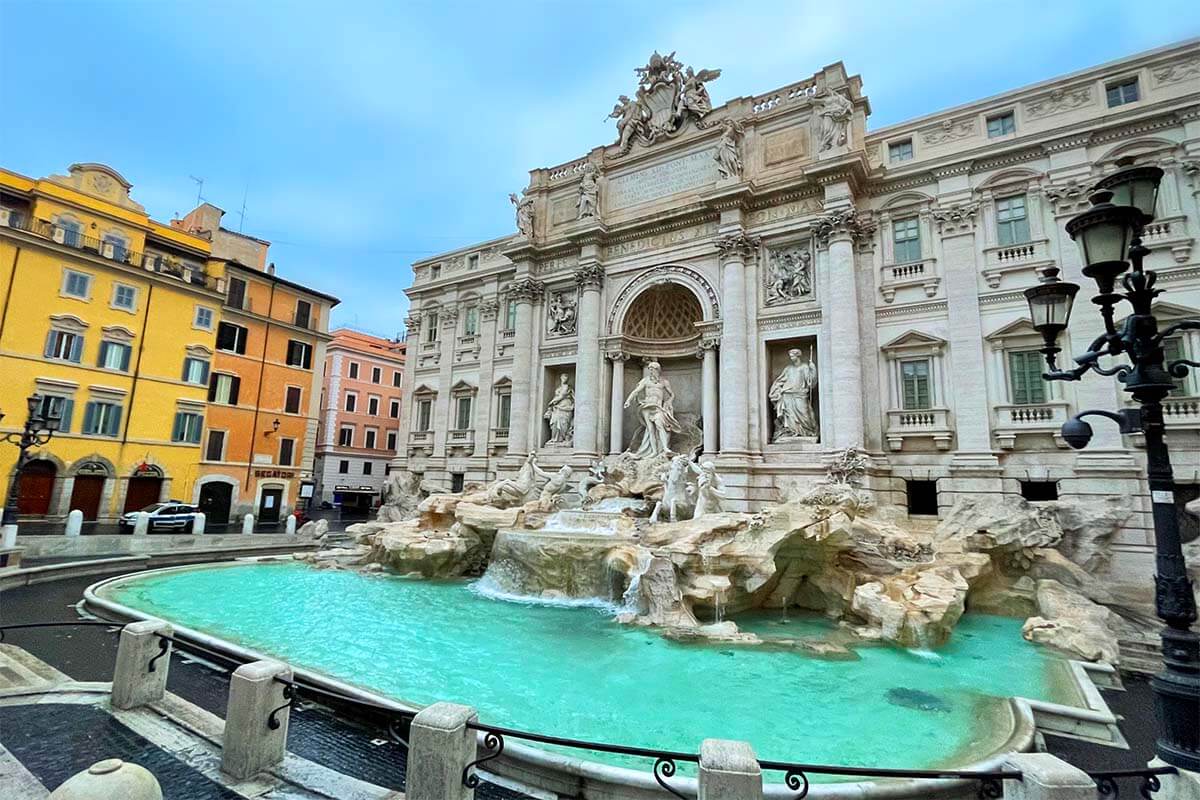
Visiting Rome for 4 days and wondering what to see and how to best plan your time? In this article, we share a perfect itinerary for 4 days in Rome , with maps, essential info, and tips to make the most of your stay in the Eternal City. Find out!
Rome is one of the most beautiful places to visit in Italy and an absolute must-see! Whether you are planning a city break in Rome or it’s part of a longer trip through Italy, it’s well worth taking a bit more time to explore this beautiful city and not just rush through the main attractions.
This Rome 4 days itinerary brings you to ALL the must-see places in the city . In addition, it also includes quite a few of Rome’s hidden gems , some of the best views in the city , and some amazing underground sites that will make your visit so much more memorable.
We also share hotel and restaurant recommendations and other useful tips that will help you plan a perfect trip and explore the city just a bit deeper than most standard itineraries.
Good to know: We recently spent 4 days in Rome and this itinerary is based on the trip that we did and is very detailed (including suggestions on where to eat or where to find the best gelato, etc.). In this guide, we share our experience-based tips and advice , the tickets we booked and tours we did, what we’d do differently, and why.
It should save you hours and hours of research and help you plan an amazing visit and make the absolute most of your four days in Rome. None of the activities, restaurants, or accommodations are sponsored, so if we recommend something it’s only because we actually liked it.
Top 4 Tickets & Experiences to Book in Advance:
- Vatican Museums & Sistine Chapel .
- Colosseum, Roman Forum & Palatine Hill .
- Local Food Tour .
- Appian Way, Aqueducts & Catacombs .
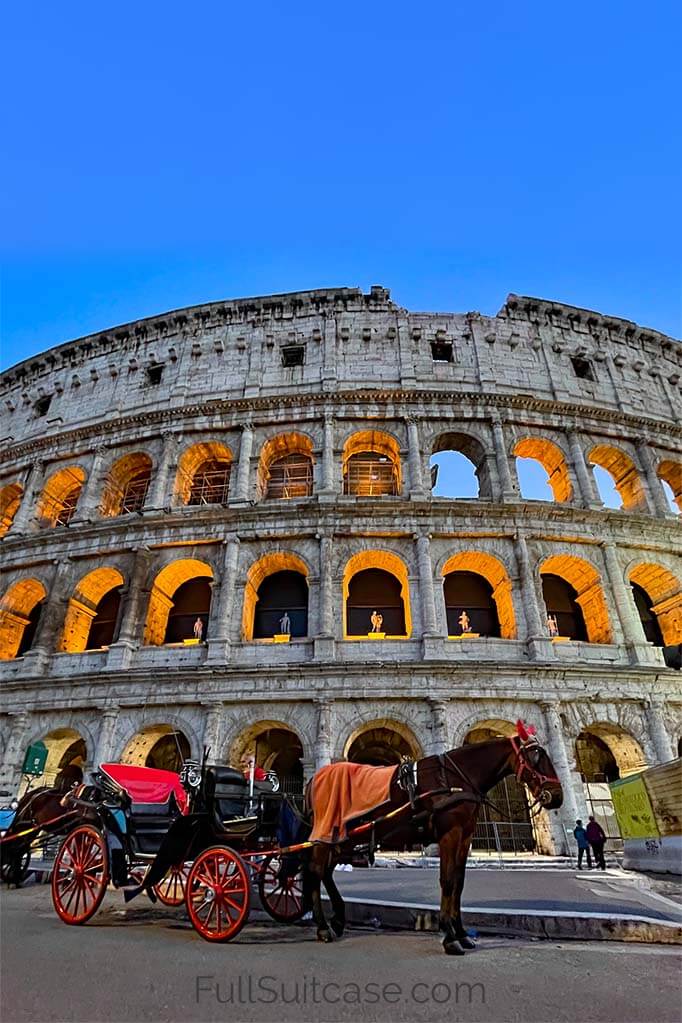
TIP: Use this itinerary just as an example of what can be done each day and switch the days around if you have to. Before deciding where to go on which day, be sure to check if all the places you want to visit are open!
For example, we had to adapt our 4-day Rome sightseeing plan because the Vatican Museums weren’t open on the day we wanted to visit.
PRO TIP: For the Vatican and the Colosseum, it’s essential to book your tickets or tours in advance , so be sure to check that first, before planning anything else! If you are planning on visiting top sites on your own, check out this digital Rome Tourist Card . It’s a combined ticket that includes entry to the Colosseum, Roman Forum, Palatine Hill, Sistine Chapel, St. Peter’s Basilica & its Dome.
This card allows you to choose time slots for all the top attractions in one go (so you can immediately see what’s available on which day). It saves you time and money, and it’s simple to use because all tickets are digital.
Below, you will find more information about tickets and tours for these and other sights in Rome.
READ ALSO: Tips for Visiting Rome
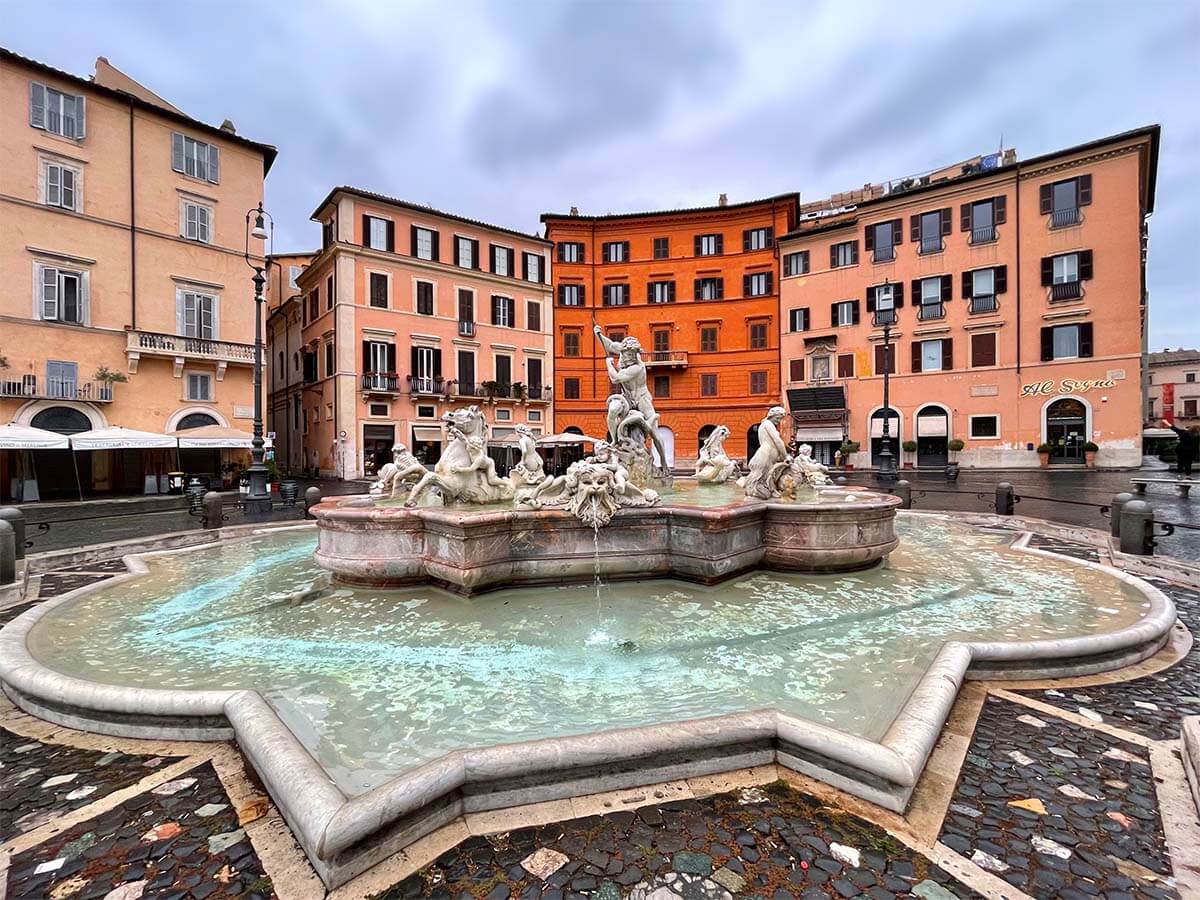
How to see the best of Rome in 4 days? With so many landmarks, must-see attractions, and countless interesting sights scattered in and around the city, there’s not one perfect itinerary.
But if you want to see the very best of Rome, this 4-day plan will not disappoint. I spent a lot of time creating this itinerary for our own trip and I’m quite confident that you’ll love it as well! At the bottom of the article, you’ll also find a MAP indicating all the places to see, restaurant suggestions, and even the meeting points of some tours we recommend.
Of course, you can just pick the places that interest you the most, see fewer places, and explore deeper. But this gives you an idea of what to see, how to plan your time, and what can actually be done in four days in Rome.
Good to know: Prepare to walk a lot (wear comfortable shoes!!!) and if you can, make an effort to get up early so that you can see some of the most beautiful places without the crowds. Also, stay in the heart of the city center! We stayed at 9HotelCesari , just a few minutes’ walk from the Pantheon and the Trevi Fountain. We always stay in this area when visiting Rome – it just makes everything so much easier and more enjoyable.
TIP: If you need airport transfers to/from the city center, you can find all the best options here (by train, bus, or pre-booked taxi).
- DAY 1: Historic Center, Colosseum, several hidden gems, Trastevere
- DAY 2: The Vatican, Food Tour & Jewish Quarter
- DAY 3: Markets, the Pantheon, Galleries, Crypts, Shopping, City Views
- DAY 4: Appian Way, Aqueducts & Catacombs Tour, most interesting churches, Colosseum at sunset
- Map & getting around
- Additional suggestions if you have more time
- Where to stay
Here’s what your four days in Rome could look like:
Day 1: Historic Center, Colosseum, Baths of Caracalla, Aventine Hill, Mouth of Truth, Trastevere
PLANNING TIP: Be sure to book the tickets or the tour of the Colosseum in advance! We did and recommend this all-in tour . If you rather go on your own, you have the choice between regular tickets or tickets that include Arena Floor as well . We recommend the latter as standing on the Gladiator Arena is really special.
Here’s what your first of the 4 days in Rome could look like:
7 – 8 AM: Trevi Fountain, Pantheon, Piazza Navona, Breakfast
Start your first day in Rome with an early walk through the city center. I recommend going to see the Pantheon and the Trevi Fountain first thing in the morning. These are the most visited landmarks in the center and they are always crowded. But if you come here early, you have a chance of seeing these places without too many people around.
If you stay in the heart of the city center, it’s really easy to see these places without the crowds. Our hotel was so centrally located that we woke up at around 6.30 AM, took a quick shower, dressed, and were at the Trevi Fountain just before 7 AM. It was magical to see it empty and actually be able to enjoy it and take the time to admire this masterpiece!
It’s also nice to see the Pantheon and Piazza della Rotonda without people. You won’t be able to visit inside the Pantheon this early, but you can come back for that later. If you have a bit more time, you can walk to Piazza Navona and see it without the crowds as well (it’s just a 3-4 minutes walk from the Pantheon, so really not a big detour).
Go back to your hotel for breakfast . Alternatively, you can have breakfast at one of the many cafés in the city center.
READ ALSO: The Best Area to Stay in Rome
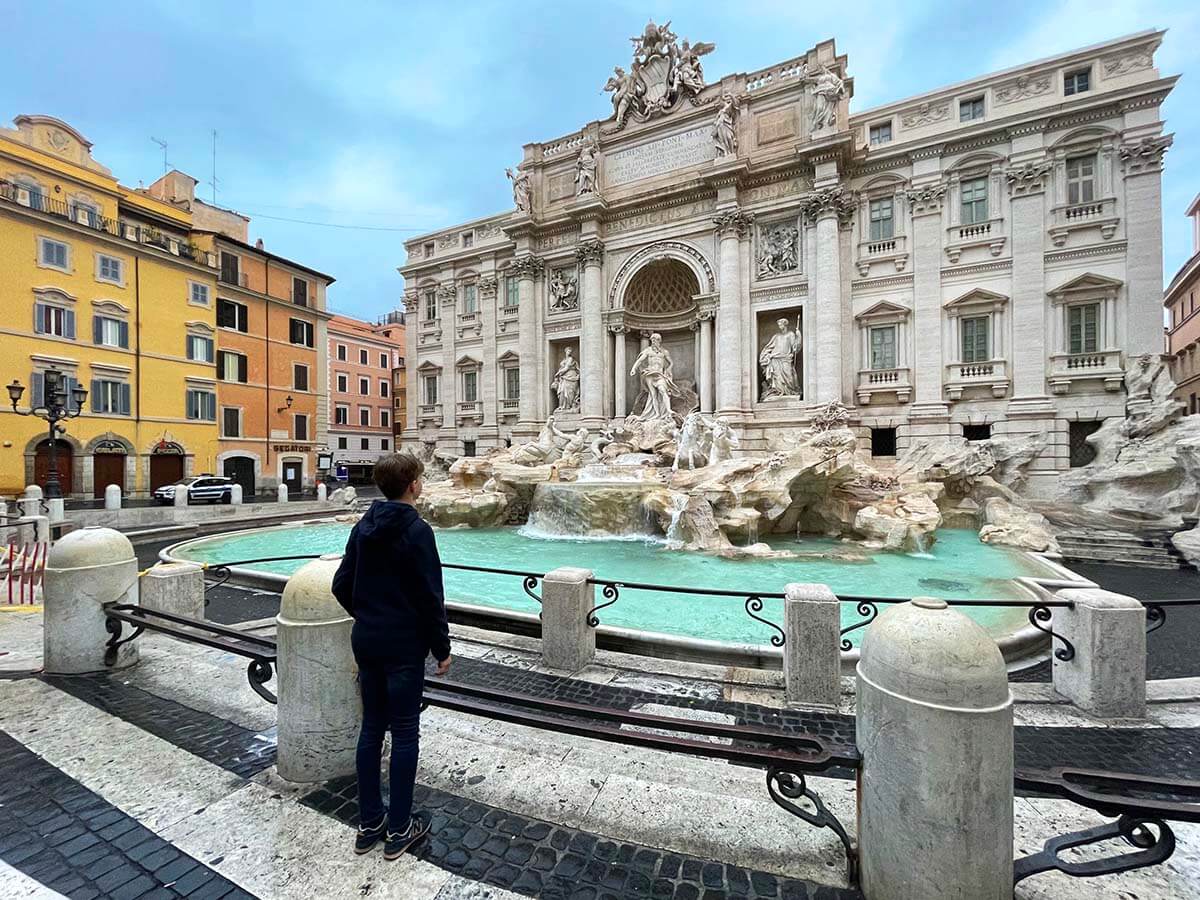
8.30 – 10 AM: Piazza Venezia, Capitoline Hill, Via dei Fori Imperiali
Next big stop – the Colosseum . It’s just a 20-30 minutes walk from the city center. You could take a taxi, rent an electrical scooter, or simply walk. We recommend walking because you can see so many other landmarks along the way, especially around Via dei Fori Imperiali .
On your way to the Colosseum, you’ll pass Piazza Venezia . This is a huge and very busy city square with a colossal monument (Altar of the Fatherland) and the equestrian statue of Vittorio Emanuele II. This is one of the must-see places in Rome!
TIP: If you have some extra time, you could visit the monument and take the elevator to the top . The panoramic views are stunning, but it’s not cheap and can take quite some time if it’s busy. Yet, it’s definitely possible to squeeze it in your itinerary if you plan well.
Then, take the wide staircase on the right side of the monument and visit Capitoline Hill (Campidoglio). This staircase and the square were designed by Michelangelo. On top of the stairs, you’ll see impressive palaces that house Capitoline Museums .
With just four days in Rome, you’ll have to be very selective about where to go and what to see. If you want to visit these museums and the Colosseum + Forum Romanum on the same day, it’s definitely possible, but you’ll have to skip most of the other suggestions for this day.
We recommend just passing by here. On top of the hill, check out one of the best viewpoints in Rome , Belvedere di Via Monte Tarpeo which overlooks the Roman Forum. On the other side of the Senatorial Palace, you’ll see a small statue of the Capitoline Wolf . This statue depicts an old legend, according to which a wolf saved and cared for Romulus and Remus, the twins that later founded the city of Rome.
After leaving Capitoline Hill, turn left and walk to the main street – Via dei Fori Imperiali and in the direction of the Colosseum. This road is like a museum in itself – with the Roman Forum on your right, the Forum of Augustus and other historic places on your left, and impressive statues of Roman emperors around you.
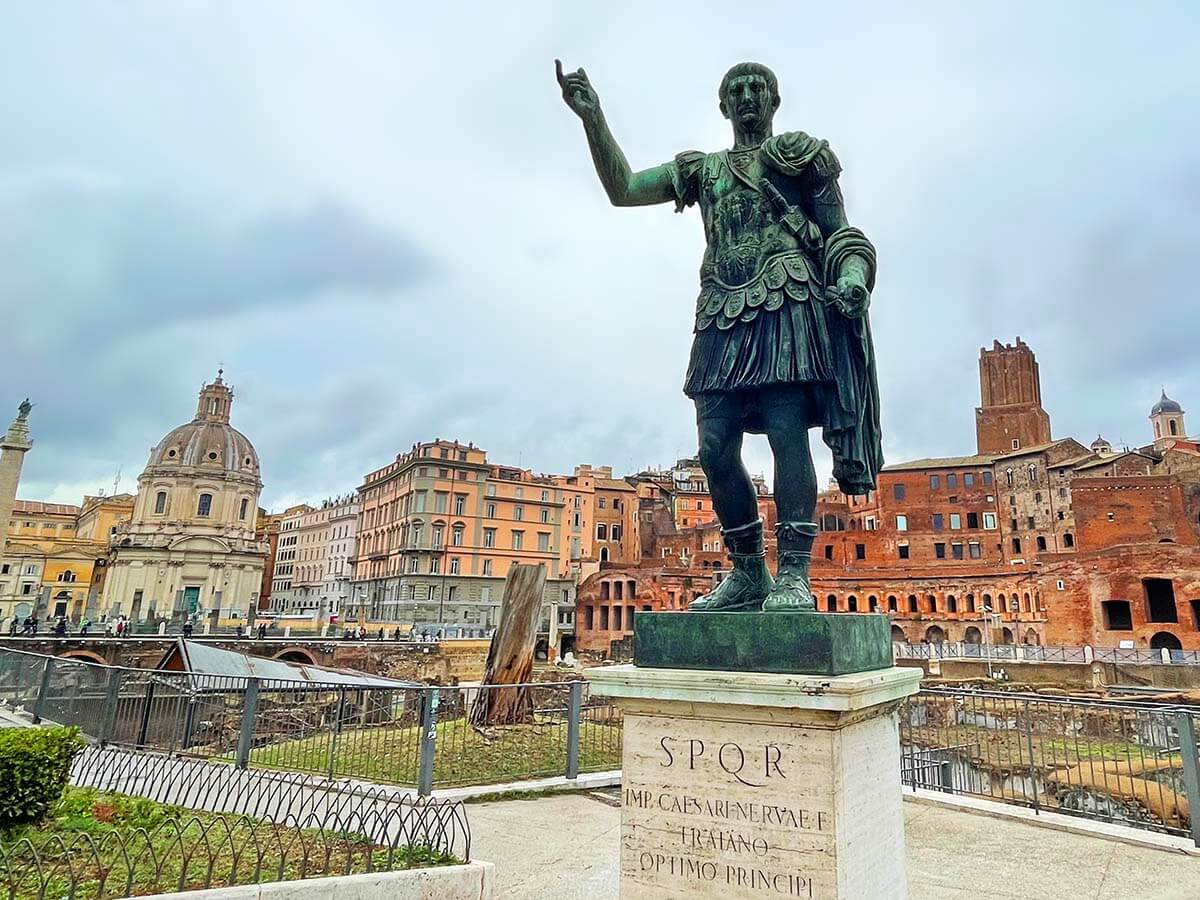
10.30 AM – 1.30 PM: Colosseum Tour + Roman Forum & Palatine Hill
If you booked your tickets or a tour of the Colosseum , you can now visit the Colosseum inside. All tickets also include an entrance to the Roman Forum and Palatine Hill . So plan on spending the next 2-4 hours here. In fact, the tickets include a few other places, but those are not a must. Just as with so many other places in the city, you could spend the whole day here, but with just 4 days in Rome, we recommend only focusing on the musts.
There are several options for the Colosseum. Most people just get a regular ticket and visit on their own, but you should also know that there is a slightly more expensive ticket that includes Arena Floor . In addition, I recommend visiting the underground level as well. And for that, you need a guided tour.
I’ll spare you all the details about all the ticket and tour options and to keep things short, just say that after lots of research, we booked a tour like this that includes Colosseum (all levels), Palatine Hill, and Forum Romanum . It was absolutely worth it and I highly recommend it.
Good to know: We booked a tour at 10.30 AM. You could also rush and come here first thing in the morning, but it’s ALWAYS busy at the Colosseum anyway, so it won’t really enhance your experience. And if you prebook your tickets in advance, there’s no need to hurry or worry about anything.
Going with a tour, we didn’t have to stress about where exactly to go, which line to stand in (we actually skipped most of the lines except the security check), or where exactly to go once we were inside the Colosseum.
We saw all the levels of the Colosseum – the Underground, the Arena Floor, and all the regular areas accessible to everyone. It was an amazing experience and our guide made it a smooth, informative, and very enjoyable visit.
Afterwards, we walked to the nearby Palatine Hill and the Roman Forum . Once again, it was great to have a guide here. I’ve been to these places before, without a guide, and it’s only now that I realized how much I missed.
These areas are so vast and there’s so much to see that it’s easy to get overwhelmed and miss some of the highlights. Also, the guide tells you stories and anecdotes and helps put things into perspective and better understand what you are seeing. Our tour ended at the Roman Forum, giving us more time to explore it further on our own.
READ ALSO: Guide to Colosseum Levels & Tickets
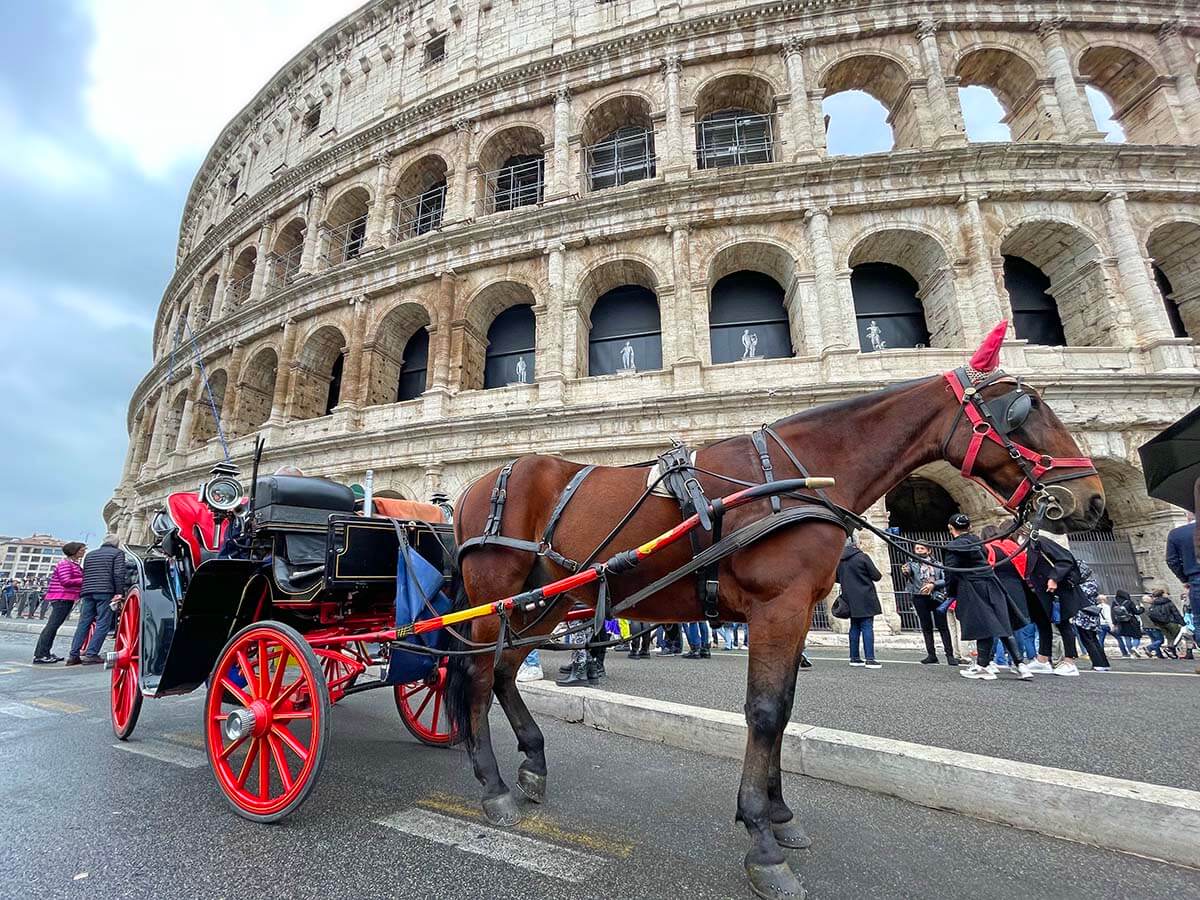
1.30 – 2.30 PM: Lunch near Colosseum
After all the walking and sightseeing, you’ll want to sit down for lunch! So find a nice restaurant near the Colosseum and enjoy a quiet lunch. We thought that we’d just get something quick for lunch and go on, but it was actually nice to take a break and I highly recommend you do the same!
We headed to the small neighborhood east of the Colosseum – this is where you’ll find lots of restaurants and cafes. And yes, many of them are really touristy, but there are some good places to eat here as well. The biggest problem is finding a table here in the afternoon…
For a quick bite, you could try L’Antico Forno . If you have some time to sit down, check out Trattoria Luzzi . This is one of the most popular and good-value restaurants near the Colosseum, but if you want to find a table here at lunch, try to reserve in advance.
We had lunch at La Pace del Cervello , which didn’t have the best reviews, but had a free table outside and we didn’t want to waste more time looking around. The service was super fast and friendly, the pizza was one of the best we had in Rome, and the prices were very correct as well.
TIP: The best way to find where to eat in Rome is to simply take a look at the reviews on Google Maps of the nearby restaurants and pick a place that looks more local (to start with, no pictures on the menu). But – once again – it’s usually so busy near the Colosseum at lunch that you will be happy to find a free table. And if you just get a pizza and some drinks, as we did, you can’t really go wrong anyway.

3 – 3.30 PM: Baths of Caracalla
If you want to get a bit off the beaten path in Rome, I highly recommend visiting the Baths of Caracalla . Located about 20 minutes walk from the Colosseum, this is one of the most remarkable Ancient Rome sites that most tourists never see. Yet, it’s absolutely worth a visit!
Caracalla Baths were built at the beginning of the 3rd century and were one the largest Roman public baths. It’s a huge complex that used to house several baths, saunas, an Olympic-size swimming pool, sports facilities, and even a library. The baths were heated via a series of underground ovens and it’s absolutely impressive to see how advanced and luxurious this place was.
Nowadays, it’s an archeological site/ outdoor museum. Some parts are still very well preserved and restored, with some stunning mosaics that give you a glimpse of how grand and decorative these baths were.
To us, the Baths of Caracalla is one of the most special places in Rome. And yes, it’s not an absolute must, but I highly recommend including it in your Rome itinerary. This is one of those places that will make your visit more special. And it’s also a nice place to escape the crowds.
Good to know: The Baths of Caracalla are open daily except on Mondays and some public holidays. Here you can find more info and also get tickets online, but it’s not an absolute must – normally, you can just buy a ticket at the entrance. You can also visit here with a tour ; obviously, it’s quite expensive compared to just the ticket price, but going with a guide always gives you a very different perspective.
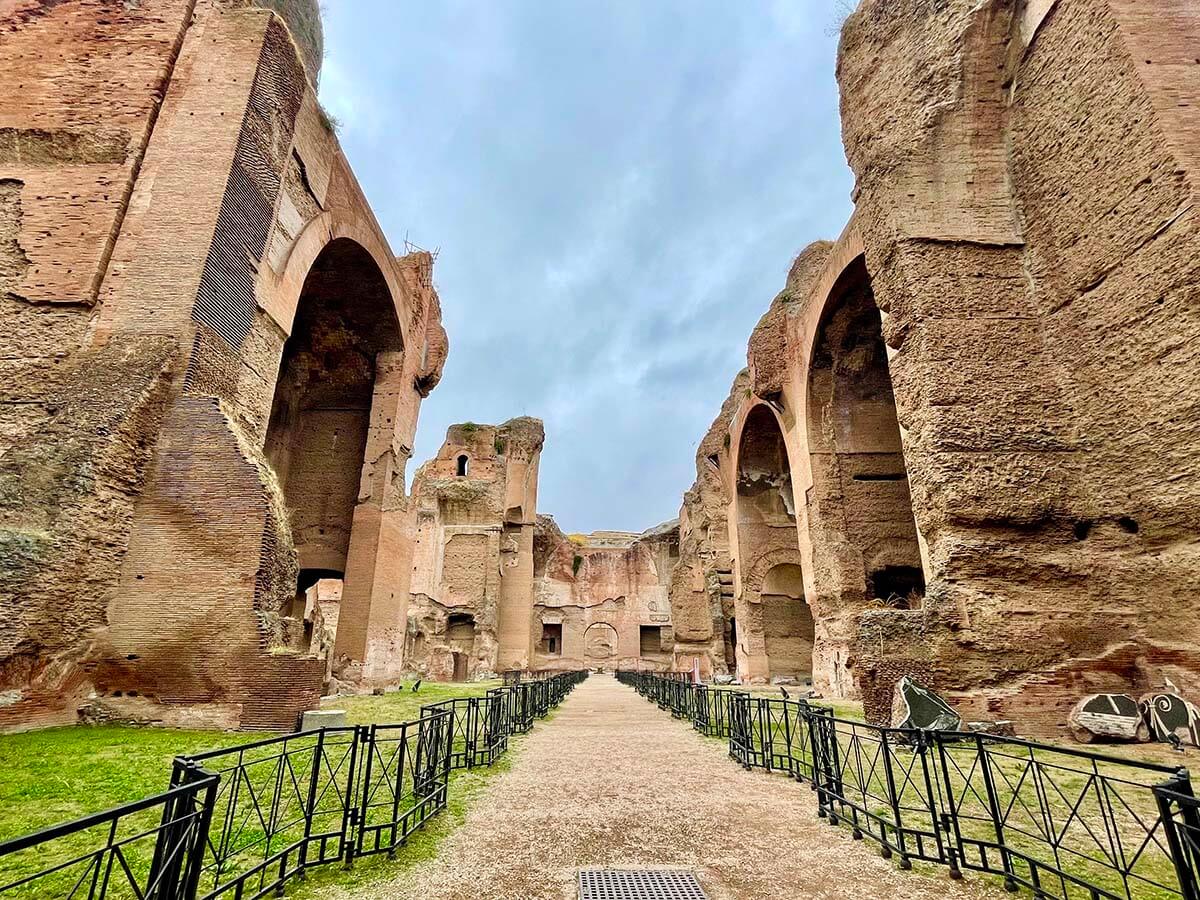
After visiting the Baths of Caracalla, you could see some of the lesser-known places in Rome . None of these is a must, but nice to do if you don’t mind a lot of walking and have some time to spare. You can visit all of them or just pick the ones that interest you the most.
TIP: You could also rent one of the electric scooters that you’ll find all over Rome for getting to these places. It would make it much quicker and easier.
4 – 5 PM: Pyramid of Caius Cestius and/or Aventine Hill
The Pyramid of Caius Cestus is about 20 minutes walking distance from the Baths of Caracalla, and you pass some very local areas of the city. The Pyramid looks like the ones you see in Egypt and was actually built as a tomb in 18-12 BC. It is possible to visit the Pyramid inside, but it’s only open a few weekends per month and requires an advance booking, but you can just see it from the outside, as we did.
Next to it, there’s also an old 3rd-century city gate, Porta San Paolo , part of the old city walls. There’s a small museum here and you can walk up to the top of the tower for nice views.
Next, head to Aventine Hill . Best known for the Knights of Malta Keyhole , there are also several churches here and the Orange Garden ( Giardino degli Aranci ) offering nice views of Rome.
The keyhole is the main attraction here and it is exactly as it sounds – a keyhole in an old door. But what makes it special is that through it, you can see the view of the green garden pathway with St. Peter’s Basilica perfectly framed in the middle.
This is one of the more popular hidden gems of Rome and often, there’s a long queue of people waiting to look through this keyhole. I’ll let you decide if it’s worth your time waiting in line for it, but a visit to Aventine Hill is worth it either way. The three churches are really interesting to see, especially Basilica di Santa Sabina all’Aventino , and also the city panorama from the nearby gardens is really nice.
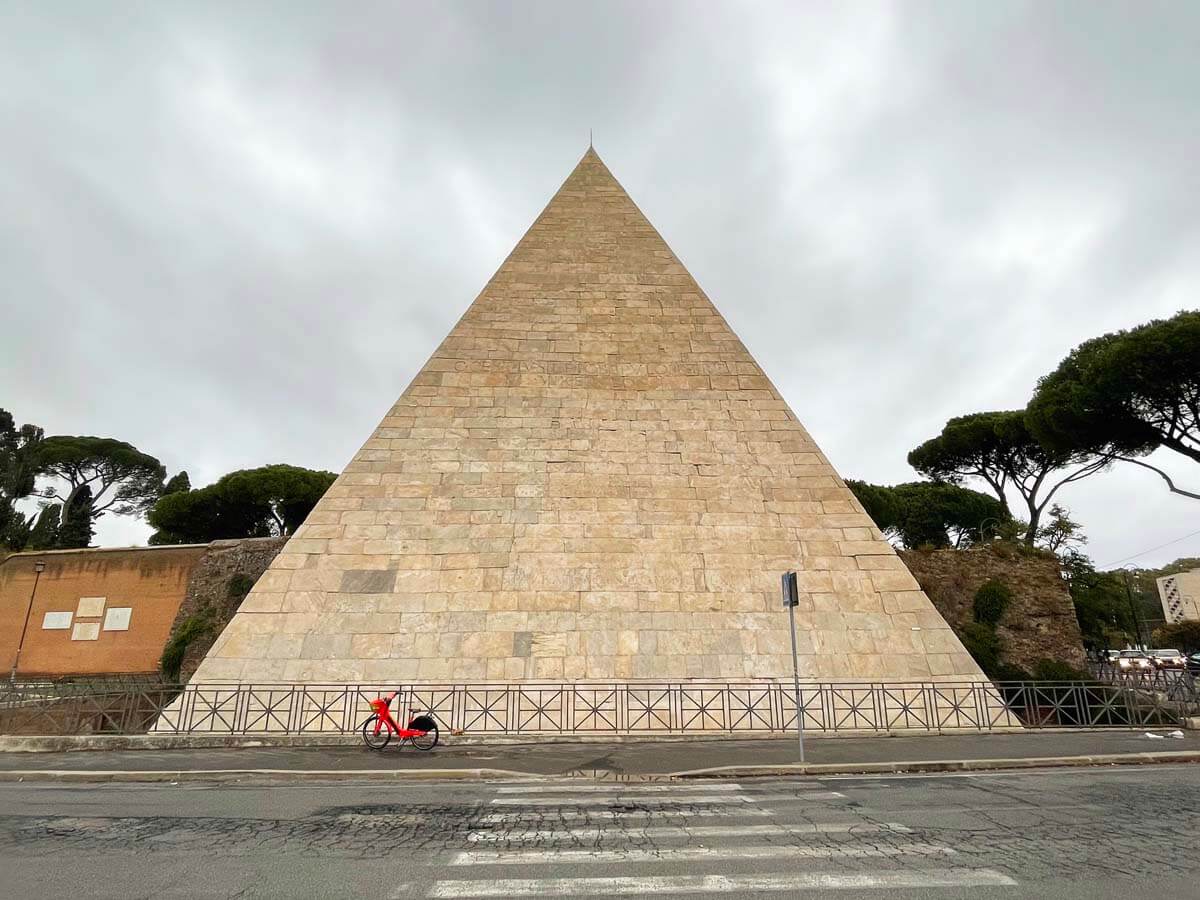
5 – 5.30 PM: Mouth of Truth
Finally, head back towards the river and the city center and stop at Santa Maria in Cosmedin church . Here you’ll find the Mouth of Truth ( Bocca della Verita ), a marble face with an open mouth. The legend has it that the mouth will bite off the hand of any liar.
In the past, you could just stop by here, put your hand in the mouth, take a picture, and move on. However, it’s become a very popular tourist attraction, and so also here, you’ll have to stand in a long queue in order to take a picture with your hand in it. There’s now even a small gate, a donation box, and staff keeping an eye on the crowds and regulating ‘traffic’.
We chose not to waste our time in line and took a picture of the mouth through the gate (you can see it from the street). The church itself is also nice to see, and there’s also an underground crypt of Pope Adrian I (8th century) that’s quite interesting as well. If you don’t have to stand in line for the Mouth of Truth, a visit here will only take 5-10 minutes.

6 PM: Trastevere & Dinner
Trastevere is one of the nicest (local) neighborhoods in the center of Rome. The name Trastevere comes from ‘ trans Tiberim ‘, which means ‘beyond the Tiber’. And indeed, it’s located on the other side of the river, just over the bridge from the Mouth of Truth.
This is a really nice area with narrow cobbled streets, colorful houses, countless restaurants, cafes, and bars. If you are looking for a nice place to have dinner, Trastevere is the best foodie area in Rome!
Before heading to dinner, you could also visit a few churches here. The most famous is Basilica di Santa Maria in Trastevere , located on the most picturesque little square. Don’t miss it!
Also check out Basilica Santa Cecilia in Trastevere – a real hidden gem, best known for the sculpture of St. Cecilia that was originally found in the Catacombs of St. Callixtus (and that we recommend visiting – see day 4 of this itinerary).
TIP: If you like exploring with the locals, you could book a food tour of Trastevere . It covers some of the landmarks of the neighborhood, plus you get to taste some delicious food as well. There are normally tours starting at around 5-7 PM, so it’s possible to fit it into this itinerary.
Or simply find a nice restaurant and enjoy a quiet dinner – you definitely deserve it after all the walking! Some of the best places to eat in Trastevere are Trattoria Da Enzo al 29 (close to Basilica St Cecilia) or Osteria Nannarella (close to Basilica St Maria). Be sure to try fried artichoke ( carciofi alla giudea ), one of the local specialties.
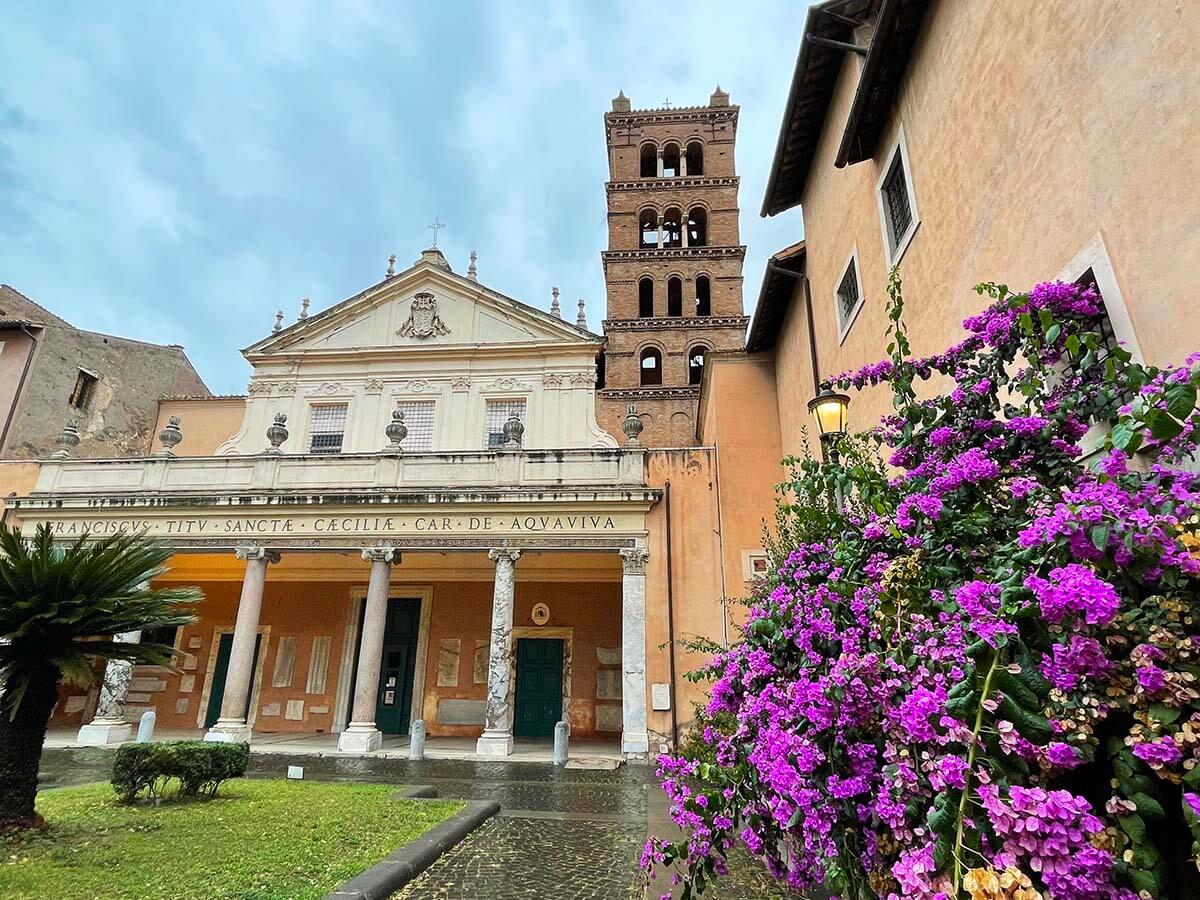
Day 2: The Vatican, Food Tour & Jewish Quarter, Historic Center
PLANNING TIP: Be sure to check if the Vatican is open on the day you want to visit and reserve your tickets / tour for the Vatican Museums (Sistine Chapel) online! See below for the best tour suggestions. The tickets are timed and they always sell out at least a few days in advance. Also, be sure that you wear clothing that covers your knees and shoulders! Also be sure to book the food tour in advance!
Here’s how you could plan your day:
Early morning: St. Angelo Bridge & Castel Sant’Angelo
If you walk to the Vatican from the city center, you’ll pass the Sant’Angelo Bridge and Castel Sant’Angelo . This area gets crowded during the day, but if you come here early, you’ll be able to enjoy it without the crowds.
TIP: Some of the best views of the St. Angelo bridge with St. Peter’s Basilica in the background are seen from the Umberto I Bridge and the southern side of the river between the two bridges.
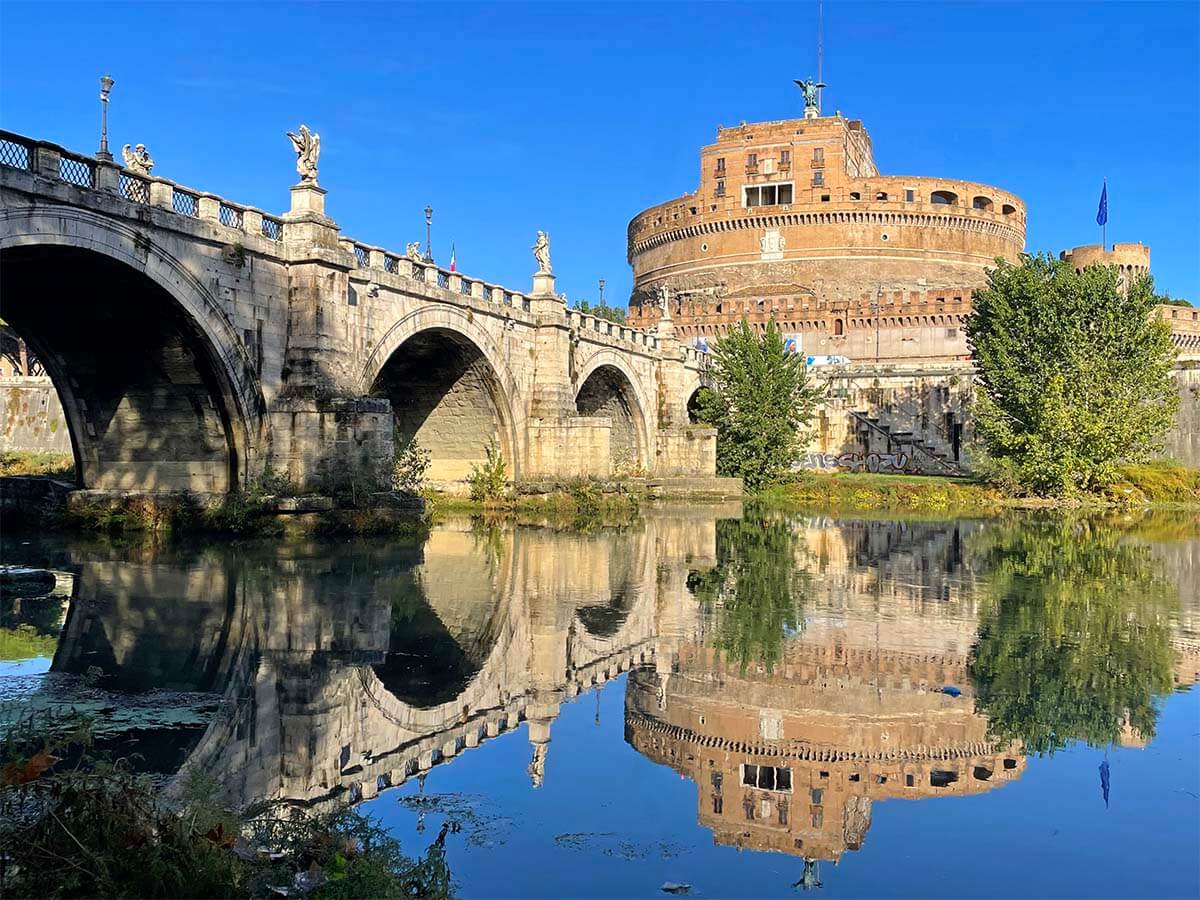
Morning: Vatican Museums & Sistine Chapel
Together with the Colosseum, the Vatican Museums (where you’ll find the famous Sistine Chapel ) is the most popular tourist attraction in Rome. It’s essential to book your tickets (or a tour) in advance!
Sometimes, if you didn’t think to book in advance and all the regular entrance tickets are sold out, you can still visit with a tour (they have separate access to tickets).
We have been to the Vatican Museums with a tour in the past, and so on this 4-day Rome trip, we just got the regular tickets instead of taking a guided tour. Big mistake! Next time, I’d definitely go with a tour. Here’s why.
Our experience: Once you enter the museums, you find yourself in a beehive with a labyrinth of halls and corridors and staircases… And yes, you get a plan and there are signs pointing to some parts of the museum, but it’s absolutely not clear where to go. All the routes point to Sistine Chapel and so eventually, you do get there (and see a lot along the way), but you have no idea what exactly you are seeing, whether you have missed something or not, and what’s worth it the most…
TIP: So if you want to save yourself all the stress and be sure that you see the best that the Vatican Museums have to offer, consider going with a guided tour . I’m a bit hesitant to recommend a guided tour with the official guide of the museum because we saw lots of frustrated people inside who were sent from one place to the other, looking for the official group tours. Instead, you can book a tour with one of the local companies (see below). That way, you meet your guide outside, enter the museums together, and can actually relax and enjoy your visit.
Here are 3 of the best tours of the Vatican:
- Early Entry to the Vatican & the Sistine Chapel . If you want to see the Sistine Chapel at its quietest , this is the best tour. It starts very early but gives you an extraordinary experience, incomparable to any regular daytime tours. In addition, this tour visits St. Peter’s Basilica and enters it directly through the museum saving you lots of time.
- Skip-the-Ticket-Line Vatican Tour and Sistine Chapel . This is the most popular (and great value) tour of the Vatican Museums & St Peter’s Basilica. A good alternative to visiting on your own.
- Early morning tour that includes everything + the dome . This tour includes ALL the musts of the Vatican : St. Peter’s Basilica with a visit to the underground crypts and the dome climb + the Vatican Museums & Sistine Chapel.
UNIQUE EXPERIENCE: VIP Key Master’s Tour – on select days, it’s possible to visit the Sistine Chapel with a Key Master as he opens the galleries of the Vatican Museums. You spend two hours inside with just a handful of people in your group – it’s a very unique experience (but also with a very high price tag and limited availability). A similar tour is also available through this company but it’s only bookable once or twice a month.
Good to know: The Vatican Museums are closed on Sundays, except on the last Sunday of the month when they are also free to visit (expect even bigger crowds if you visit on a free day). The museums are also closed on most religious holidays and on some other occasions.
When you pre-book your tour or tickets, you’ll immediately see if the date of your choice is not available, and can adjust your itinerary at that time.

Noon: Lunch near the Vatican
After your visit to the Vatican Museums, you’ll definitely want to sit down and rest your legs. All that slow walking is really tiring…
There are several restaurants and a café inside the Vatican museums, so you could have lunch there. But there are also quite a few nice restaurants in the nearby neighborhood. We chose to dine at one of the local restaurants.
We had lunch at La Locanda di Pietro , just a few minutes walk from the museum. It’s a very nice local restaurant with very friendly staff and truly good food. There are quite a few good restaurants in this area. For low-key simple Italian dishes, check out Ristorante dei Musei , or – if you prefer something different- head to La Cucaracha which serves Mexican food.
TIP: Try to go for lunch at around noon. When we visited, most restaurants were still quiet at 12, but half an hour – an hour later, there were hardly any free tables left (and only inside).
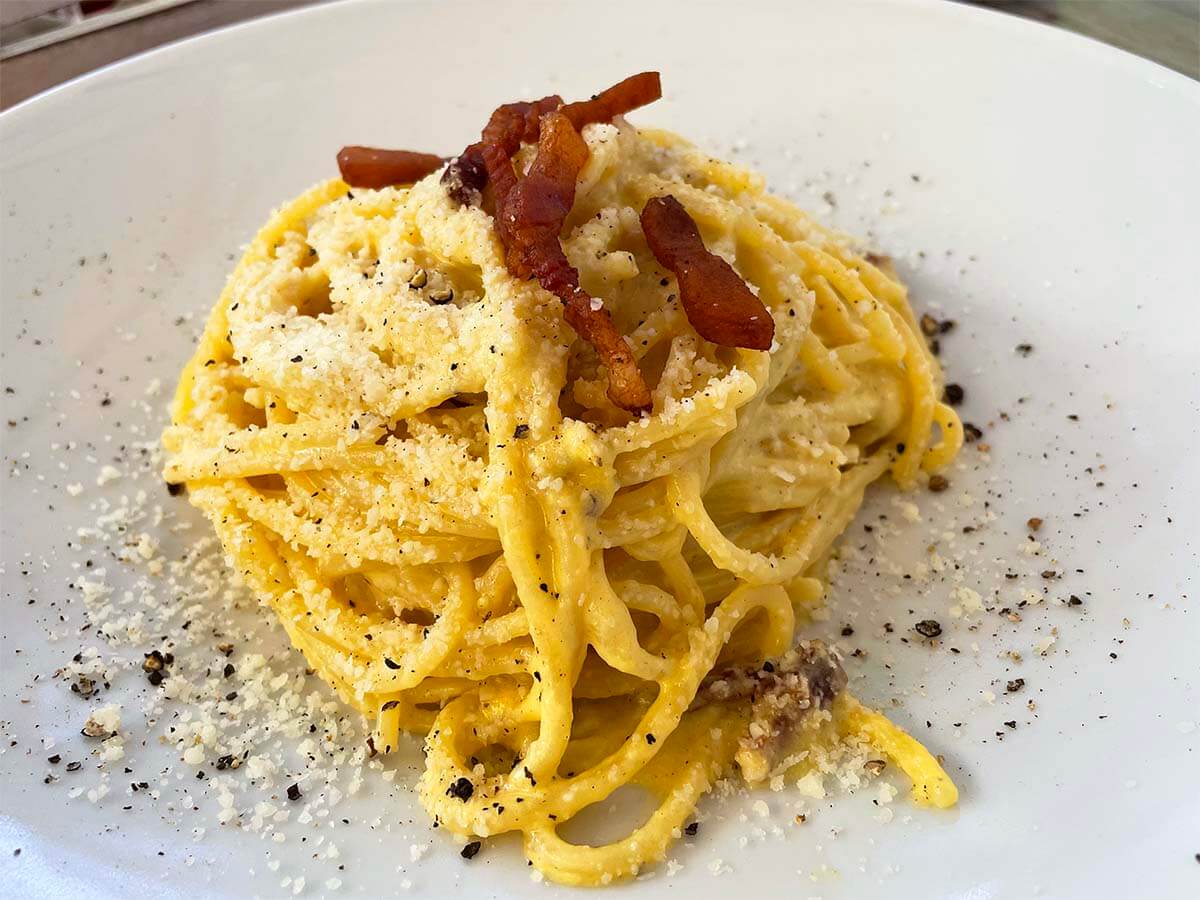
1.30 – 4 PM: St. Peter’s Square & Basilica
Unless you book a tour of the Vatican Museums and St. Peter’s Basilica together, I recommend visiting St. Peter’s in the afternoon. In fact, the later in the afternoon you go, the quieter it usually is.
We booked this tour of the Basilica that included a Dome Climb and the Underground , and it started at 2 PM. So after lunch, we headed to St. Peter’s Square , explored it a bit on our own, went to see the Swiss Guards , and sent some postcards from the Post of the Vatican .
At 2 PM, we met our guide and waited for about 15-20 minutes (security line) to enter the Basilica. The lines weren’t nearly as bad in the afternoon as they were in the morning. While you don’t really need a guide to visit the church (and the entrance is free of charge), we actually enjoyed having a guided tour here. Our guide told us so many stories and explained so many things that we would have totally missed otherwise (and actually did miss on the previous visits here).
TIP: If you go without a tour, consider getting an audioguide – that way, you can better appreciate what you are seeing.
We then visited the crypts where some of the Popes are buried. You can also see St. Peter’s Tomb here, but only the tomb that’s officially accessible to the public (the actual St. Peter’s tomb is located yet deeper under the Basilica and can only be visited with official Vatican tours if/when they run and are very limited in numbers).
After exploring the church, you can opt to go to the top of the Dome . Our tour included this, but if you go on your own, you can do this as well. The entrance is located on the far right side of the church and you can buy a ticket here. You can opt for the stairs or the elevator. We suggest taking the elevator to the rooftop because you’ll still have to do over 330 steps to the actual top of the Dome.
A visit to St. Peter’s Dome is one of the most special things you can do at the Vatican. So if you are fit enough for the 330 stairs (up and then down again), don’t miss it! Not only can you see the rooftop of the Basilica and stunning views of the Vatican and the city from the Dome, but you also get to walk inside the actual dome with the whole church right under your feet. People look like little ants from this height and you realize once more how colossal the building is.
A very unique experience!

4.30 PM: Campo de’ Fiori
After the Vatican, head back to the city center and walk to Campo de’ Fiori . It’s about 25-30 minutes walk.
Campo de’ Fiori is one of the nicest town squares in Rome and a bustling market. Visiting here in the afternoon, you can actually see the square and not just umbrellas and the food stalls.
In the center of the square, you can see a statue of Giordano Bruno . He was a 16th-century philosopher who was burned here for his progressive thinking.
However, it’s also a special experience to see the Campo de’ Fiori market when it’s open. So if there’s no market anymore when you visit here in the afternoon, I recommend coming back here the next morning as well. See more info on day 3 of this itinerary.
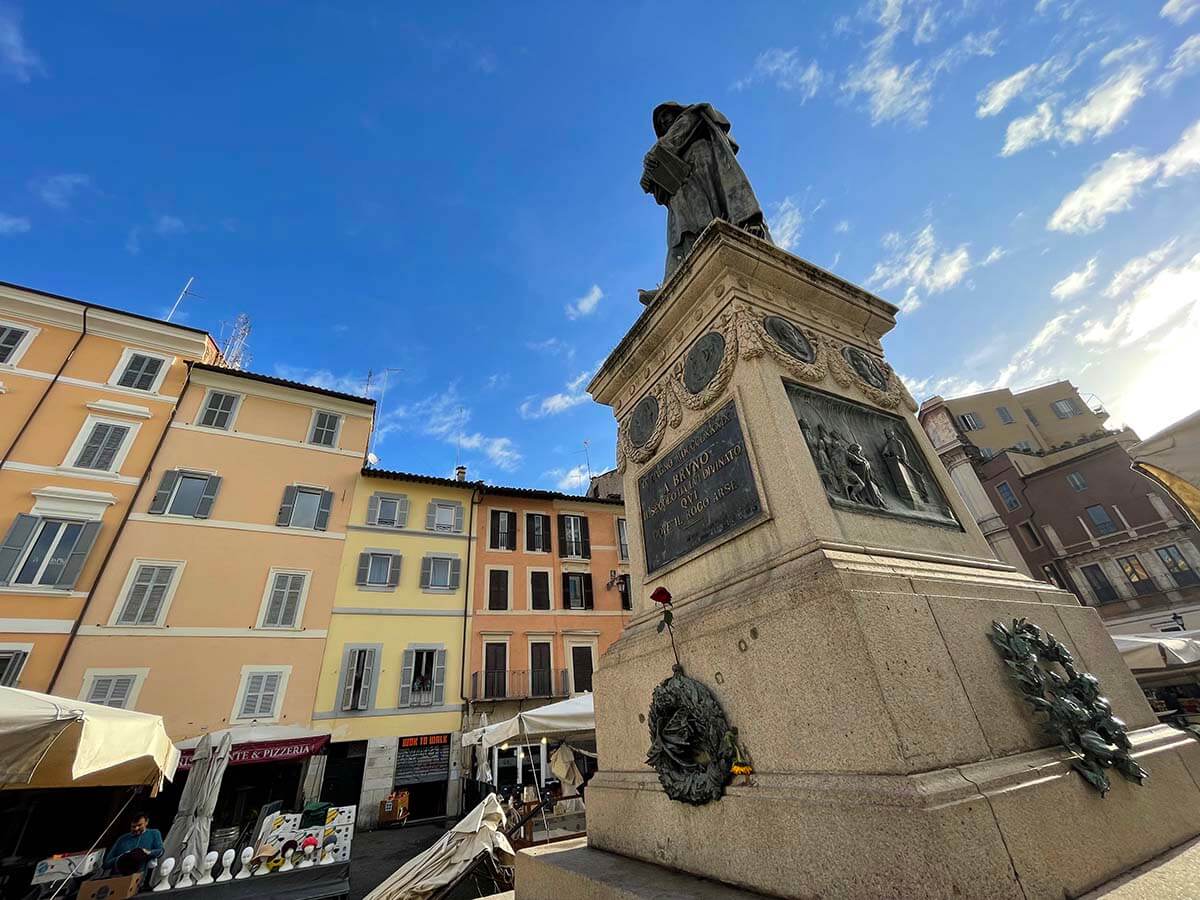
5 – 8 PM: Street food tour & Jewish Quarter
The street food tour was one of the best experiences of our 4-day visit to Rome. If you want to discover a more local side of Rome, I highly recommend taking a food tour! It’s such a great way to get a bit off the beaten path and taste some local specialties.
We’ve been to Rome many times before, but we still learned new things, tasted some of the most delicious food, and saw some places we would have never seen on our own.
We took this highly-rated food tour and I can highly recommend it! The tour starts at 5.15 PM at Piazza del Biscione, which is a tiny town square right at the northeastern corner of Campo de’ Fiori. Be sure to check the starting times and location at the time of your visit, in case something would have changed!
On this tour, you visit a traditional food store from the 19th century and still run by the same family, have Roman pizza, and try other regional specialties at several excellent local restaurants. Our tour also included a tasting of Italian wine, local beer, and delicious gelato. They can also cater to people who have special dietary requirements and, of course, alcoholic drinks can be replaced by water or soft drinks.
We also passed some really nice local areas and also visited the Jewish Quarter (Ghetto) . Together with Trastevere and Testaccio (a bit further away from the center), this is one of the best neighborhoods for food in Rome. If you are still hungry after the tour (can’t imagine you would be, but you never know), this is a nice place to come back for dinner. Or come here at another time, as we did.
The tour also visits Largo di Torre Argentina and ends close to the Pantheon. It takes about 2.5 hours.
LEARN MORE: Rome Street Food Tour: Review & Tips
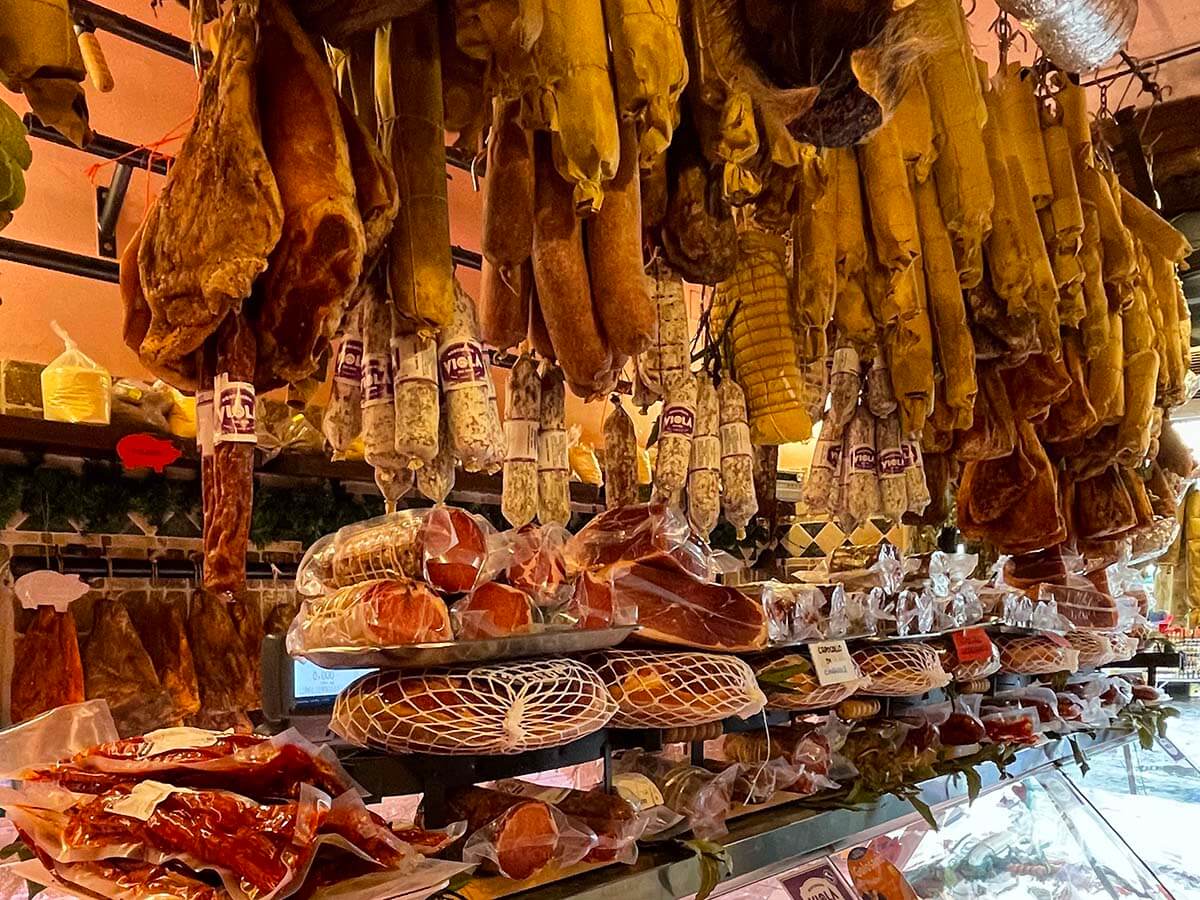
Evening: Explore the historic city center in the dark
If you still have some energy afterwards, walk around the city center and see Piazza Navona, the Pantheon, and Trevi Fountain nicely lit in the dark .
How dark it actually is will, of course, depend on the season when you visit. In November, it gets dark at 5 PM, whereas in June, it stays light until after 9 PM.
TIP: If you still have some space left for another gelato, check out Giolitti or Gelateria Della Palma – these are the two best places for ice cream in Rome. We stopped for ice cream here every time we were around…
We ended our day with some drinks on the beautiful rooftop terrace of our hotel . I think you can also come here for drinks even if you are not a guest at the hotel, but I’m not 100% sure. The drinks are quite expensive compared to the prices at the nearby restaurants though. But if you aren’t having dinner (not likely you’ll still be hungry after the food tour), it’s actually not easy to find a restaurant that will want to seat you just for the drinks. So for that, this bar is perfect.
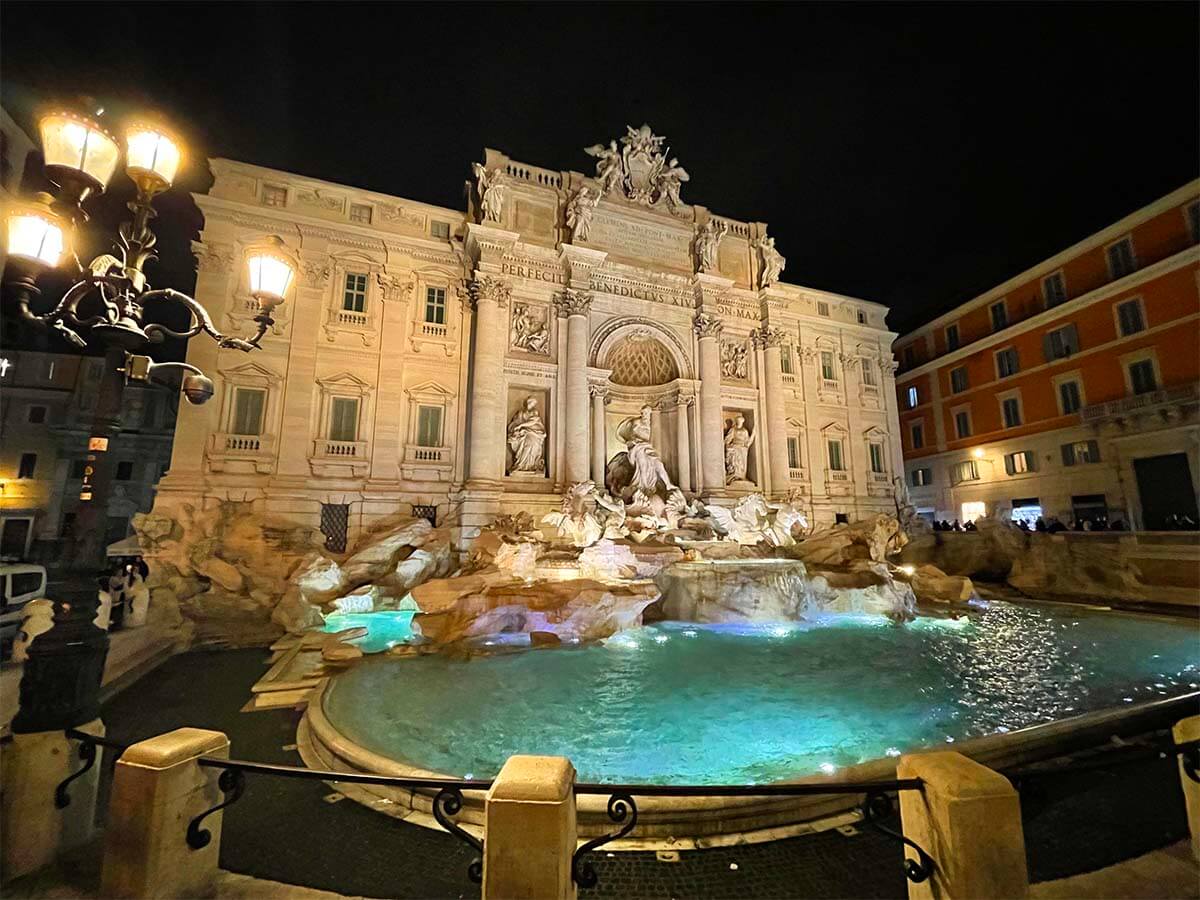
Day 3: Campo de’Fiori, Pantheon, Doria Pamphilj, Capuchin Crypt, Villa Borghese, Terrazza del Pincio, Piazza del Popolo, Shopping, Spanish Steps
PLANNING TIP: Reserve your tickets or a tour of the Borghese Gallery in advance! You may also want to prebook a timed-entry slot for the Pantheon .
Early morning: Campo de’Fiori
In the past, a field of flowers (thus the name), nowadays Campo de’ Fiori is a bustling food market. The market is open Monday to Saturday, usually from around 7 AM to 2 PM.
The market is really touristy, but locals shop here as well. You’ll find stalls selling fruits, vegetables, cheese, meat, pasta, Italian limoncello (and other colorful drinks), and also flowers.
It’s always a nice place to visit when in Rome. The market is lively and colorful, you can buy all kinds of food, fruit, and also stock up on some (edible) gifts to take home.
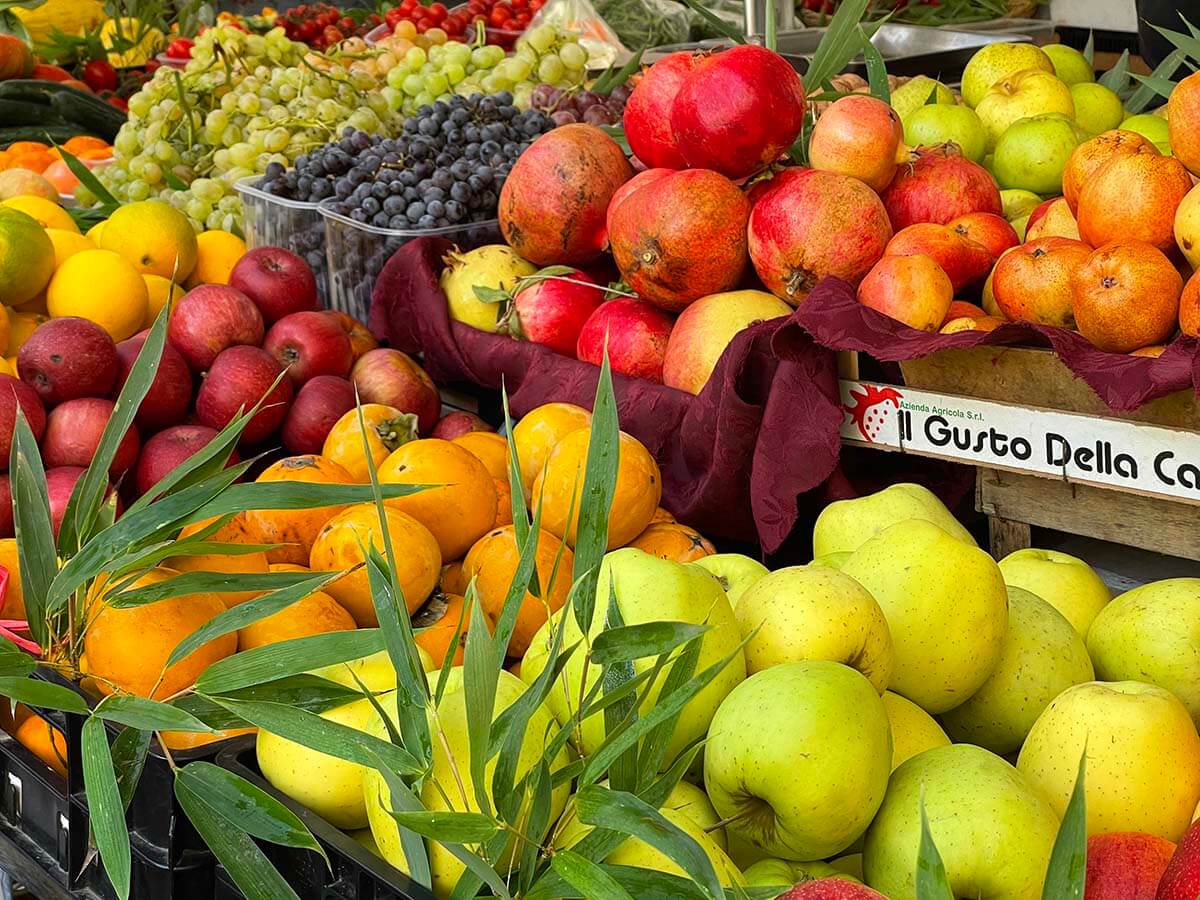
9 AM: Pantheon
You will have passed the Pantheon several times by now, but it’s one of those places that you really should visit inside. Seeing the famous dome with a hole (oculus to the sky) in the middle is a must when visiting Rome!
Originally built in 27 BC and rebuilt in the 2nd century, the Pantheon is probably the best-kept monument from the old Roman times. The name ‘Pantheon’ means ‘temple of all the gods’ and – originally – it was a pagan temple indeed. In 609, Roman emperor Phocas gifted the Pantheon to the Pope, and it was turned into a church. This is one of the reasons why it’s still so well preserved.
A visit to the Pantheon doesn’t require much time. However, it’s always busy here, so if you don’t want to waste too much time, be sure to come here well before it opens.
Good to know: Nowadays, there is an entrance fee to visit the Pantheon. It’s also possible to book a timed-entry ticket in advance, however, getting the earliest time slots is not easy. You may want to check the official website and also Tiqets and GetYourGuide to see what’s available for your travel dates. In any case, keep in mind that you have to pick up the actual ticket at an external location (they do like to complicate things more than necessary…).
Alternatively, you can just stand in line and hope to get in without too much of a wait (in that case, arrive at least half an hour before it opens). Or make it easy for yourself and book a guided tour (likely later than 9 AM though, so you’ll have to adjust this itinerary accordingly).
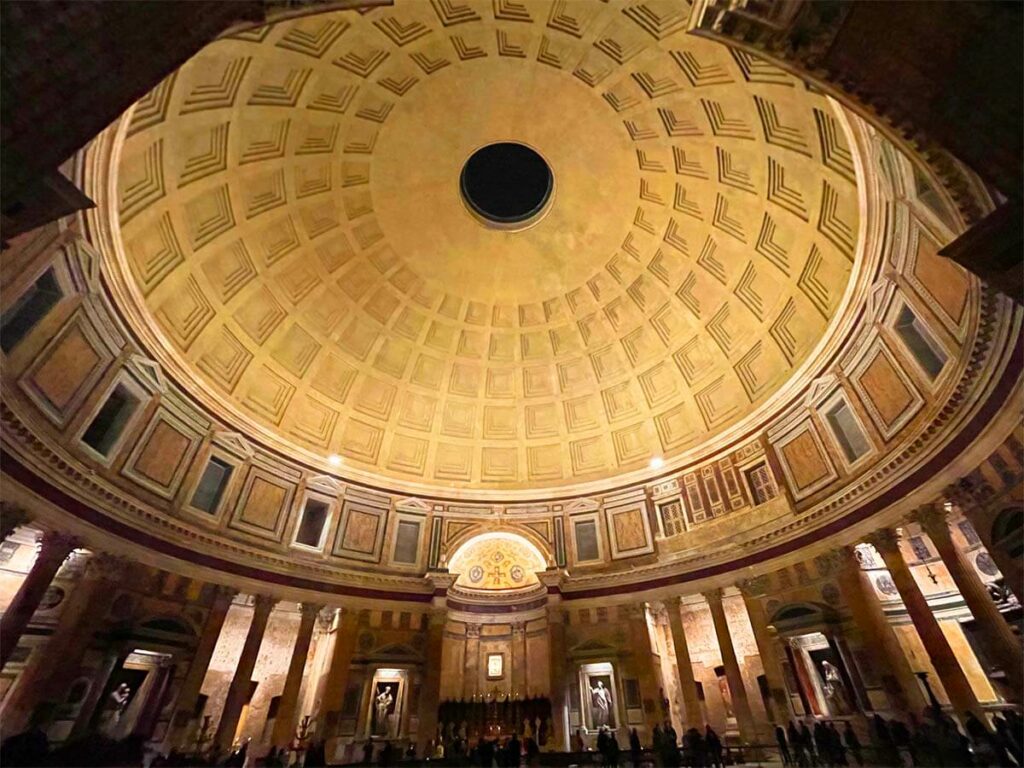
10-11 AM: Doria Pamphilj Gallery
One of the hidden gems right in the historic city center, Doria Pamphilj Gallery is a private art collection that belongs to the princely Doria Pamphilj family. This is one of the largest and most impressive private art collections in Rome and it’s open to the public.
This vast art collection was started in the 16th century and contains a large number of paintings, furniture, and sculptures. You can see various works by Caravaggio, Raffaello, Velázquez, and many other famous Italian artists. But what makes it truly special is the sheer number of pieces of art covering the walls from the floor all the way to the ceiling.
TIP: Be sure to pick up an audio guide at the entrance (included with your ticket). It’s a great way to learn more about the palace, the art collection, and the family behind it. The English narrative is spoken by Jonathan Doria Pamphilj, and he shares some fun stories and anecdotes about the family as well.
Good to know: Doria Pamphilj Gallery is located in a 17th-century Palazzo Doria Pamphilj, about halfway between the Pantheon and the Trevi fountain, about 7 minutes walk from either of the two. It’s open daily from 10 AM. Their website says that you need to prebook the tickets in advance (and they are non-refundable). In the low(ish) season, we were able to visit without an advance booking. During busy times, you may have to wait for a while if you don’t have a reservation.
TIP: If you want to be sure to visit when you want to, but also have the flexibility to cancel, you can book cancelable tickets here .
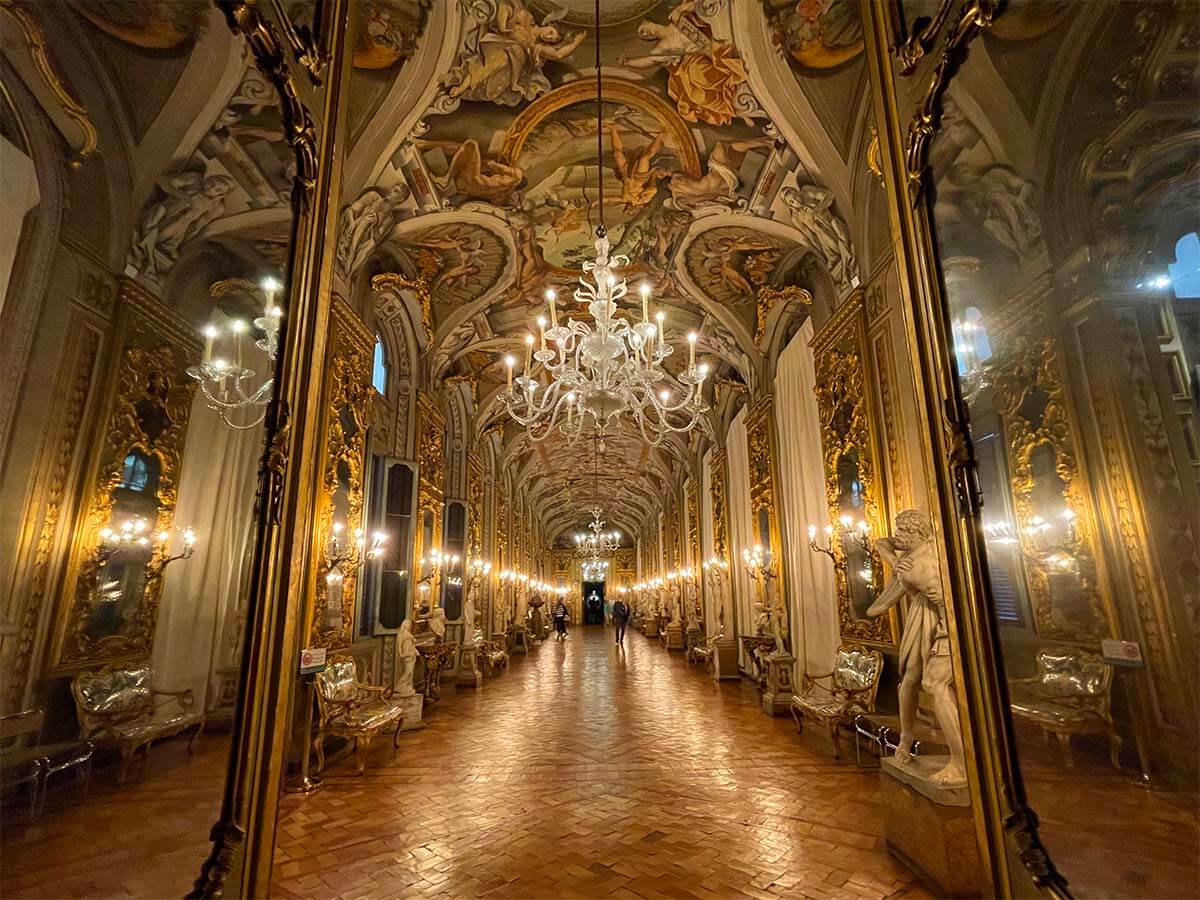
11 AM: Galleria Sciarra
As you walk from Doria Pamphilj Gallery to the Capuchin Crypt (about 15 min walk), you’ll pass another nice secret gem of Rome, Galleria Sciarra . Located just steps from the famous Trevi Fountain, this beautiful place is completely overlooked by most tourists.
Galleria Sciarra is a small glass-covered gallery/patio with beautiful frescos pained on all the buildings surrounding the courtyard. It dates from the late 19th century and is a fine example of the Art Nouveau style.
Good to know: The courtyard is always open, accessible, and free. A visit here only takes a minute or two, so definitely take a look inside!
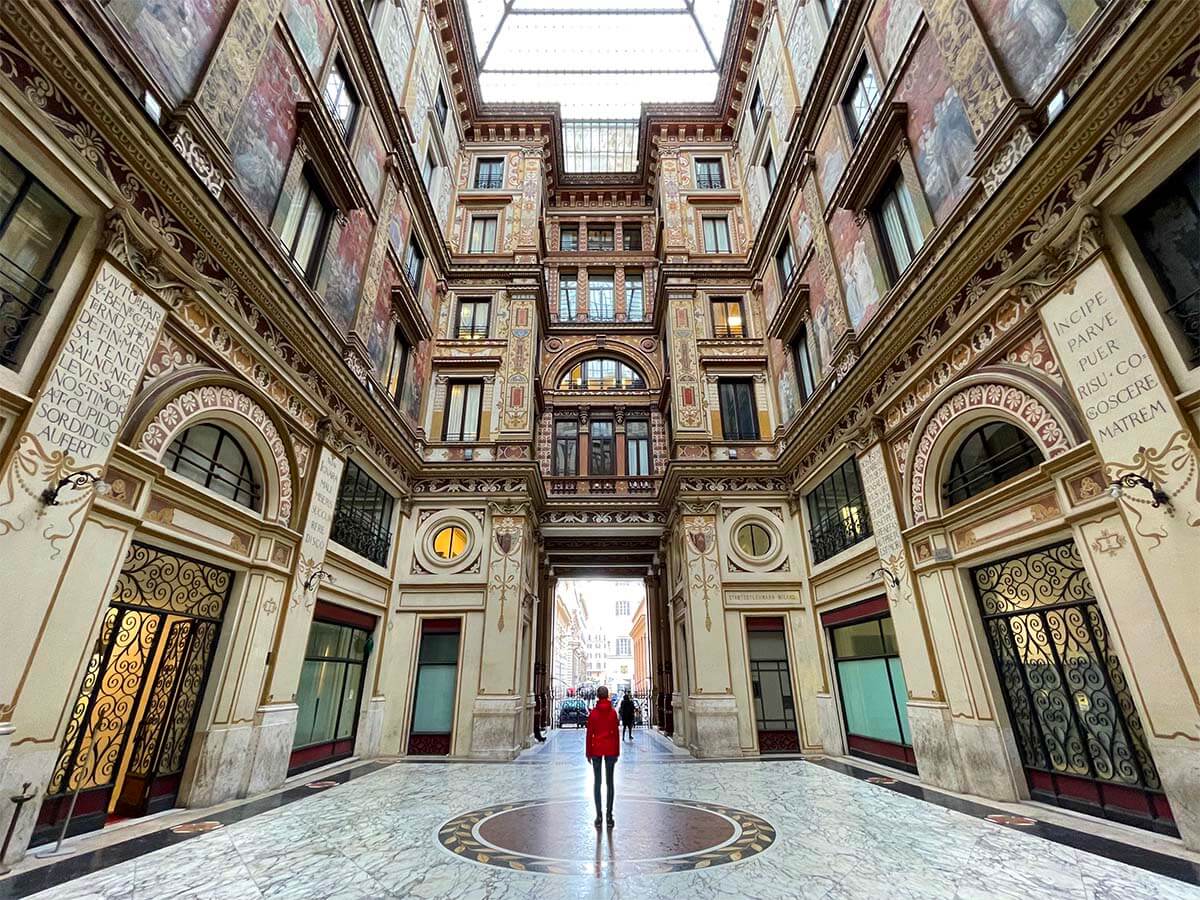
11.20 – 11.50 AM: Capuchin Crypt
If you like quirky places, you may want to check out another interesting hidden gem of Rome, the Capuchin Crypt (Museo e Cripta dei Frati Cappuccini).
The 500-year-old monastery houses a small museum telling more about the Capuchin monks and the history of the friary. But the main highlight are the underground crypts that contain really special and artistic creations made of human skeletons.
We’ve been to several bone chapels in various places in Europe in the past, but this one really stands out from the rest. There are several different crypts, each with its own unique ‘composition’, and it’s fascinating to see how someone created real art from human bones… It doesn’t even feel creepy or spooky, but more artsy…
Good to know: Capuchin Crypt is open daily from 10 AM to 7 PM, except on some public holidays, and you can just get a ticket at the entrance. More information on their website . They have an audio guide available and also run guided tours.
Lots of organized city tours include a visit here together with some other crypts and catacombs visits in Rome. But if you just want to see the crypts and the museum on your own, 20-30 minutes is more than enough time here.
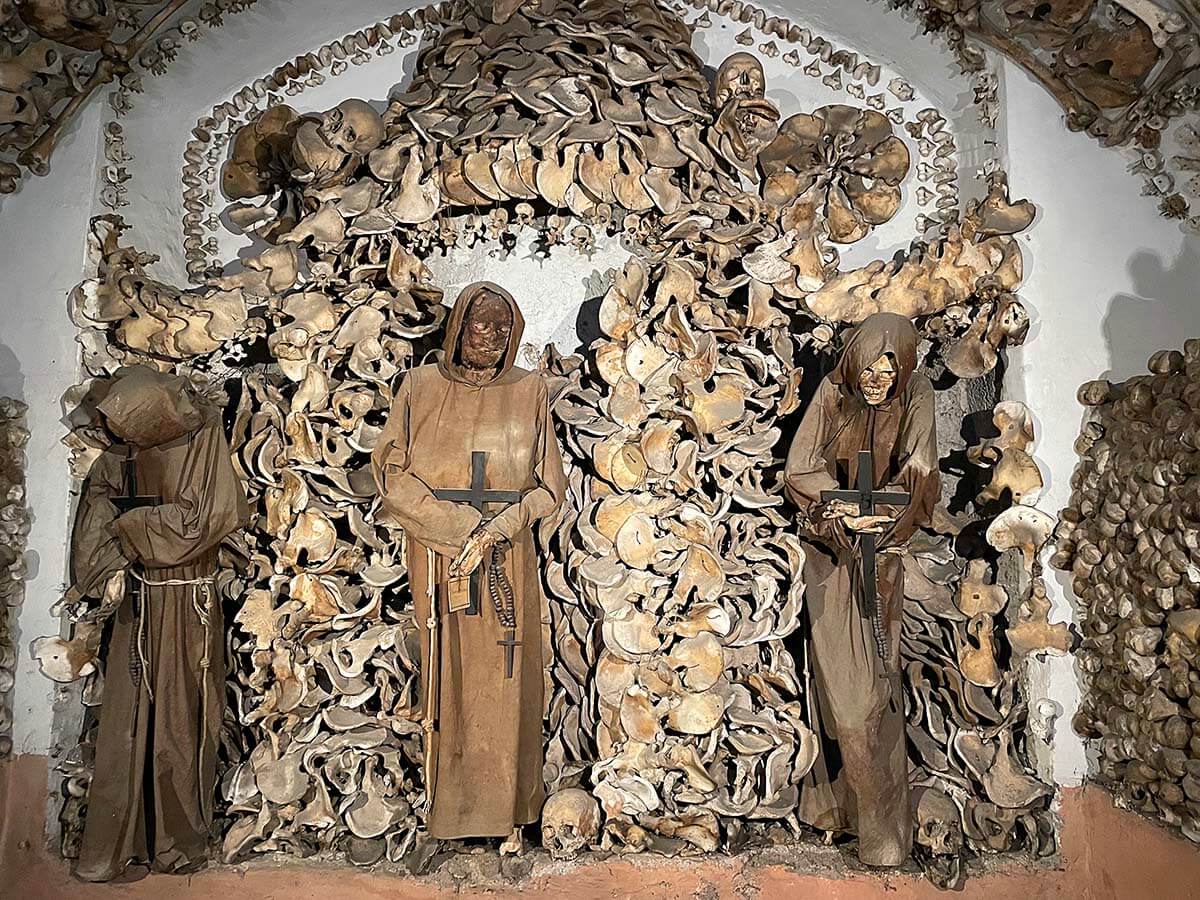
12 – 1.30 PM: Lunch
After visiting the Capuchin Crypt, continue in the direction of Villa Borghese Gardens (about 10 minutes walk to the entrance of the park or 15-20 minutes walk to the gallery).
On the way, you’ll pass several restaurants. If you are feeling nostalgic for some American food, you can stop at the Hard Rock Café.
Alternatively, there are plenty of local restaurants as well. If you don’t mind splurging a bit and are looking for something special, check out the historic Harry’s Bar . And there are lots of other cheaper and simpler places to eat in this area.

2 – 5 PM: Borghese Gallery & Gardens
Villa Borghese is a large landscaped garden, one of the biggest and most beautiful public parks in Rome. There is a lot to see and do in the park and you could easily spend half a day here, but the most famous place is the Borghese Gallery .
If you are interested in art, this is one of the best museums to visit in Rome ! Here, you can see a big collection of masterpieces by Caravaggio, Raphael, Canova, and many others. Also, the interior of the palace is absolutely impressive!
Good to know: The Borghese Gallery is very popular, the tickets are timed, and usually sell out long in advance (especially if you are visiting in high season). So if you want to be sure to visit here, it’s essential to reserve your tickets in advance!
You can opt for a regular entrance ticket , and there are also guided tours available that cover the museum as well as the beautiful gardens. A tour might actually be a good idea here since the gardens are really large and there’s a lot to see.
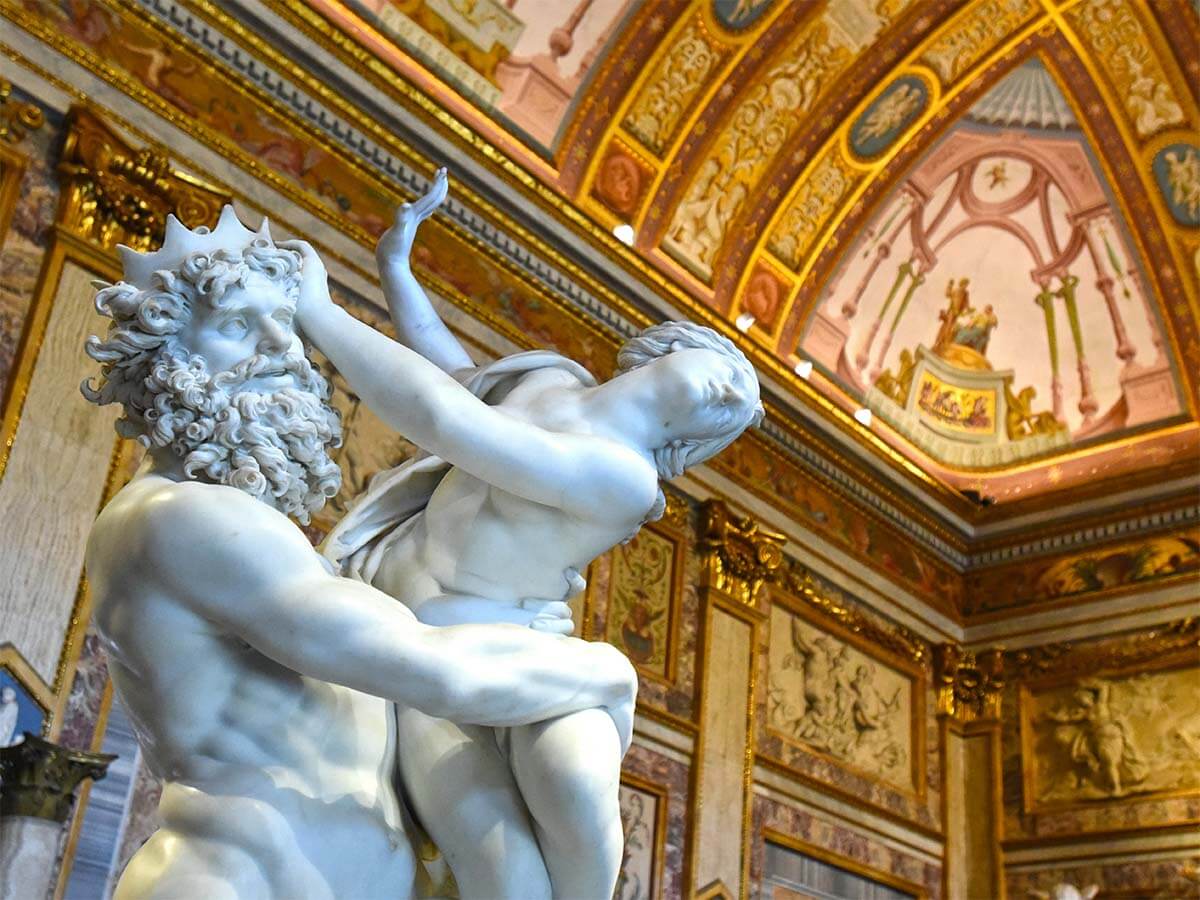
Alternative suggestion: If you are not interested in the museum or the gardens, or want to see as much as possible and don’t mind walking quite a bit more, you could also visit the Quartiere Coppedè nearby.
It’s a small neighborhood with some of the most special architecture you can find in Rome. You can read more about it in our guide to Rome’s hidden gems .
This beautiful but rather compact neighborhood is located about 20 minutes walk from Villa Borghese (so you need about 1 hour in total to walk there and back and see the highlights). However, if you could rent an electric scooter, you could probably visit in about 30 minutes.
It’s also easy to combine it with a visit to the Coppede district and that of the Borghese Gallery. It really depends on your interests and how much you are willing to walk.

5.30 PM: Terrazza del Pincio
Terrazza del Pincio is a popular viewpoint offering nice views of Piazza del Popolo, the city center of Rome, and St. Peter’s Basilica in the distance. This is a popular place to come at sunset too.
There are, in fact, two viewpoints here and the views are nice from both (the other one doesn’t have an official name and is located right under Terrazza Viale del Belvedere, but is often confused with Pincio Terrace). Anyway, I indicated them both on our map.
These viewpoints are located about 15-20 minutes walk from the Borgese Gallery, and the walk through the park is really nice in itself.
From Terrazza del Pincio viewpoint right above Piazza del Popolo, take the stairs on the right side and walk down to this town square.
READ ALSO: Best Views & Viewpoints in Rome
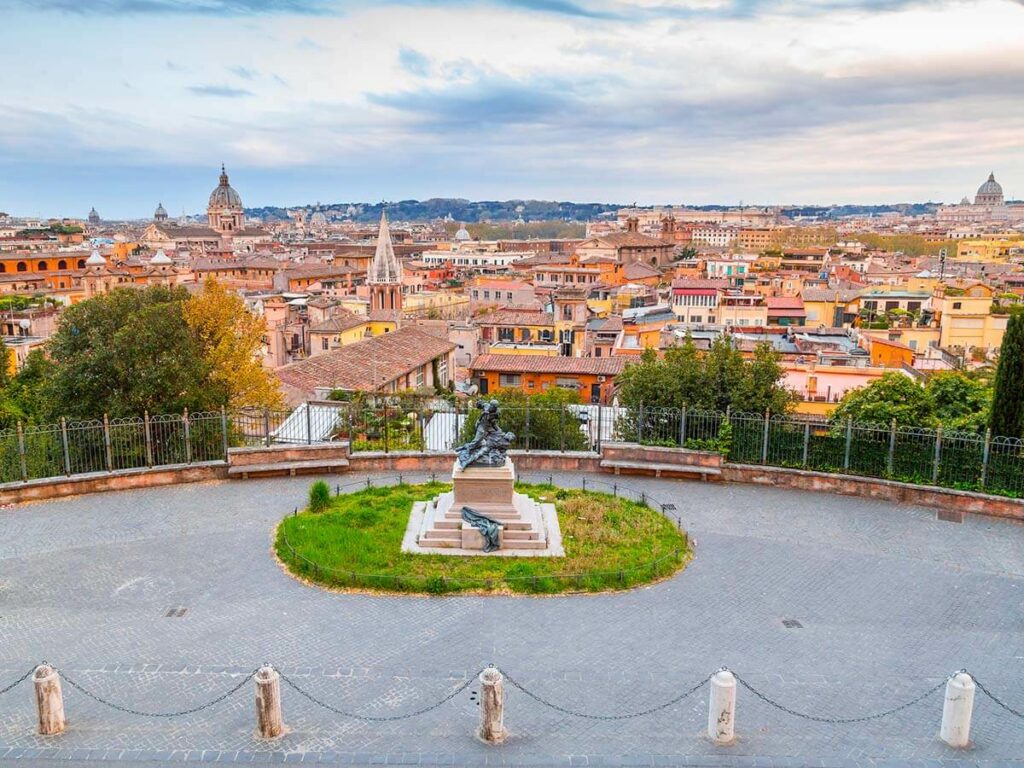
6 – 7 PM: Piazza del Popolo & Shopping Streets
Piazza del Popolo (the People’s Square) is one of the largest and best-known town squares in Rome. Located at the Aurelian city walls, there’s still an impressive city gate here.
If you are coming from the hill at Terrazza del Pincio, the city gate will be on your right. If you want to experience the ‘wow’ effect of the square as first-time visitors to Rome did in the past, you can walk through it and come back to the square that way, but it’s really impressive either way.
Piazza del Popolo is a place where three big streets come together. In the center of the square, you can see an Egyptian Obelisk and the Fountain of the Lions . There are two other fountains with impressive statues at the sides of the square. And it’s also flanked by two impressive churches Santa Maria dei Miracoli and Santa Maria di Montesanto .
The area to the south of Piazza del Popolo is one of the most popular shopping neighborhoods in Rome . You’ll find all kinds of fashion stores here – from the cheaper main street brands to the most expensive designer stores like Gucci, Prada, Dolce & Gabanna, Tiffany & Co, and pretty much any other big name in the fashion industry.
The most famous shopping streets are Via del Corso (popular brands) and Via dei Condotti (high-end designer shops), but the whole area is really a shoppers’ paradise. If you are more interested in sightseeing than shopping, check out Via Margutta . It’s a very picturesque and much quieter street that became famous thanks to the film Roman Holiday .
Good to know: Most stores here are open until 7.30-8 PM, but if you are planning to do some shopping here, you’ll probably want to come earlier. You could easily spend an entire day here too, but with just 4 days in Rome, I’d only come here to do some window shopping.
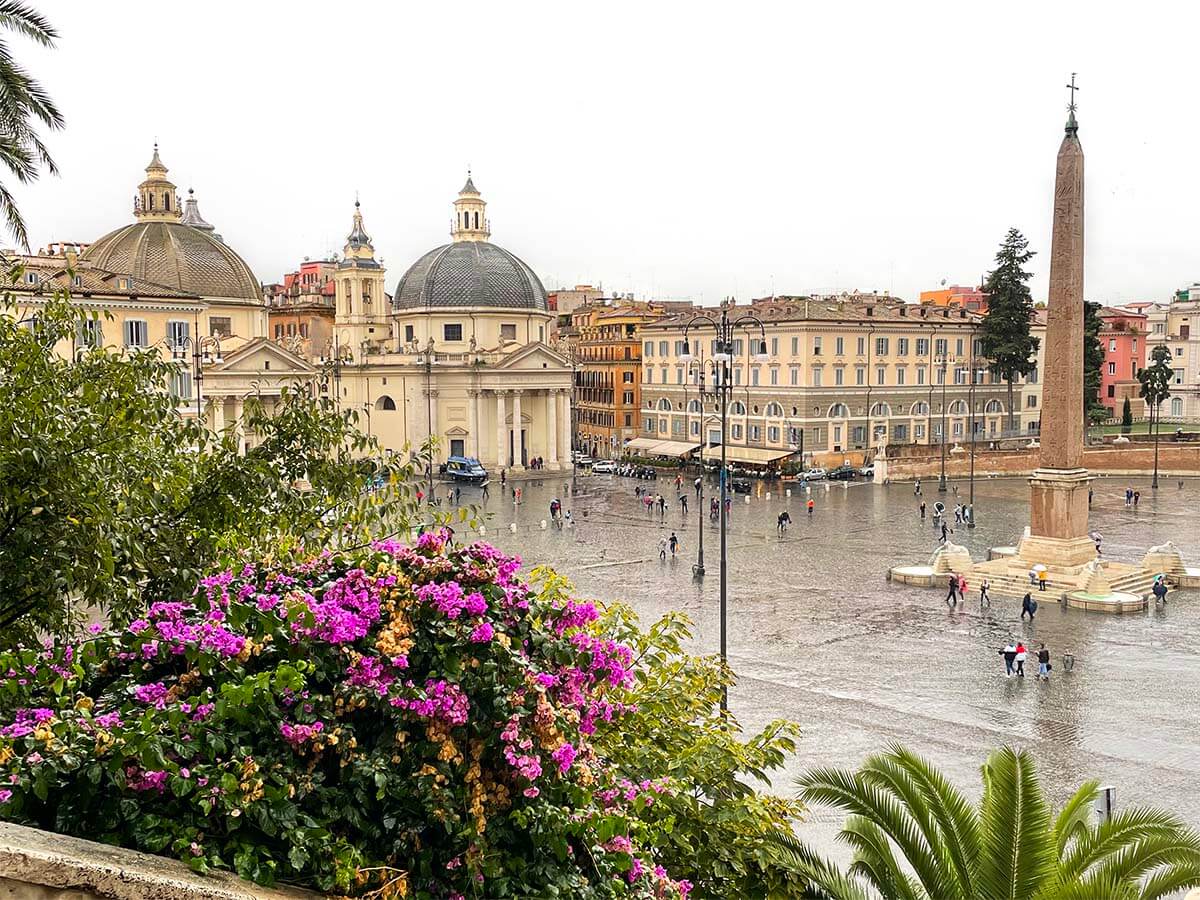
7.30 PM: Piazza di Spagna, Spanish Steps & Dinner
Piazza di Spagna and the famous Spanish Steps is one more of the ‘must-see’ landmarks in the historic city center that you really shouldn’t miss in Rome.
Surrounded by all the shopping streets, this is a very popular area that’s always crowded. In the summer, it’s often difficult to even see the staircase through the crowds. It is now, therefore, forbidden to sit or eat on the stairs.
If you take the staircase up, you’ll be walking in the direction of the Villa Borghese Gardens that you visited earlier today. At the top, there’s also a church – Trinità dei Monti – and you could visit inside if it’s still open.
But, frankly, the stairs are the most impressive when seen from the bottom and the interior of the church is not that special. There are some nice viewpoints at the top, but if you already visited Terrazza del Pincio viewpoint before that, going up the stairs is not really a must. Unless you are here at around sunset and want to see some nice twilight views from above – in that case, definitely go up.
TIP: For dinner with a view, check out Caffè Ciampini di Marco Ciampini , a short walk to the left at the top of the stairs. Otherwise, you will find lots of nice restaurants in the historic city center. I indicated a few nice restaurants on the map.
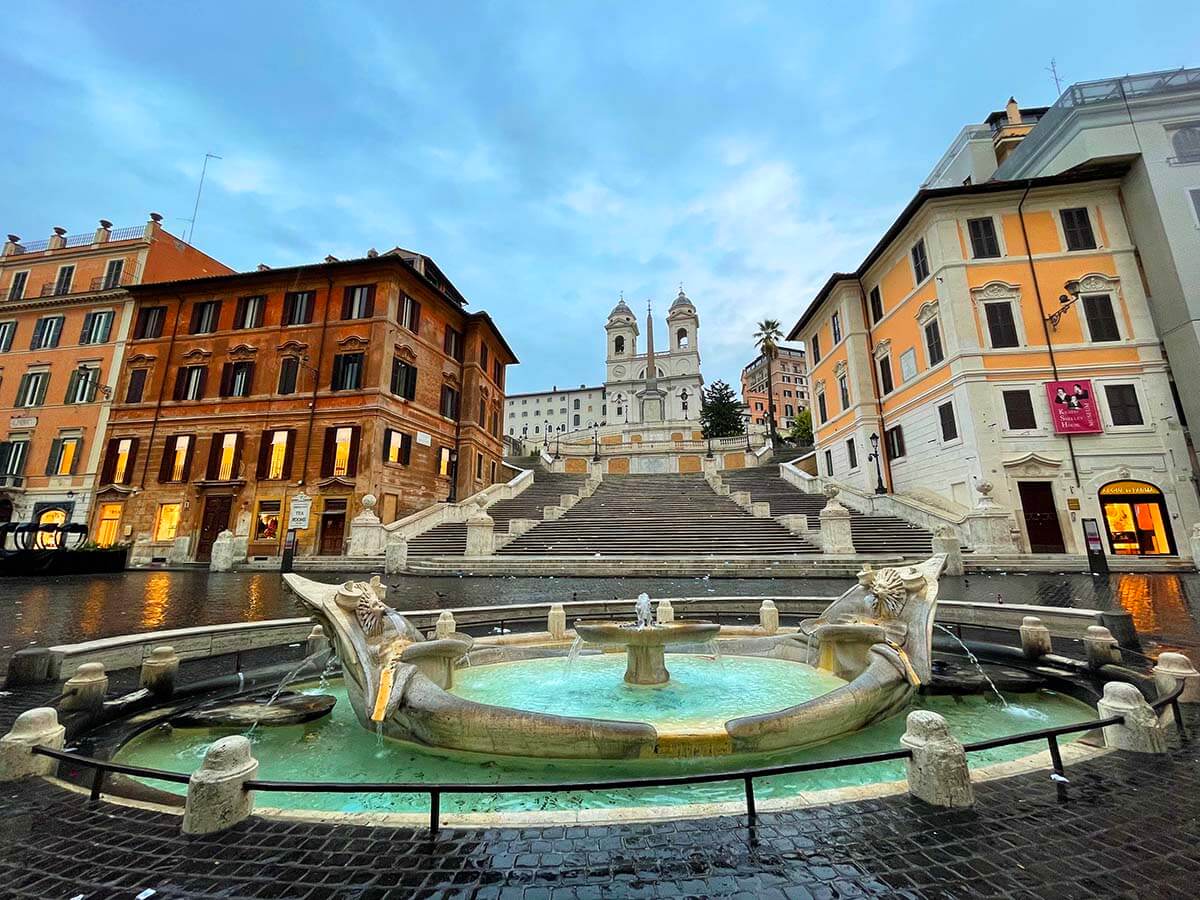
Day 4: Appian Way, Aqueducts & Catacombs tour, San Giovanni in Laterano, St. Clement Basilica, Basilica di San Pietro in Vincoli, Colosseum at sunset
PLANNING TIP: Book this e-bike tour in advance (possible for all ages). If biking isn’t your thing, this bus/ walking tour has a very similar itinerary and takes less time, but – at least at the moment, it only runs a few times a week and only in high season. Also, keep in mind that St. Callixtus Catacombs are closed on Wednesdays. You can still do the e-bike tour, but you’ll likely visit the Catacombs of Saint Sebastian instead.
9 AM – 3 PM: E-bike Tour of the Appian Way, Aqueducts & Catacombs
On the fourth day in Rome, we recommend that you get a bit outside the city and visit some of the ancient Roman sites nearby. The main highlights that are worth it the most are the Appian Way , the Park of the Aqueducts , and the Catacombs of St. Callixtus (or the nearby Catacombs of Saint Sebastian).
Hands down, this was one of our favorite days of the 4-day visit to Rome! So if you are comfortable on an e-bike, I highly recommend considering this tour .
There are other similar bike tours as well, but we chose this one because it has the most complete itinerary, includes (delicious warm) lunch, uses good quality electric mountain bikes, and has the best reviews. Also (take my word for this), you really don’t want to do the Appian Way with a regular bike!
I’m not going to list the complete itinerary of this tour, but below are some pictures that will give you a short overview of what you can expect to see. Since you go with a local guide, you have nothing to plan or worry about. Just enjoy the day and soak in the incredible 2000-year-old sights.
We loved every minute of this tour and I’d do it again in a heartbeat. Also, my teenage son said that it was the absolute best thing we did on the entire trip (and he really enjoyed the rest of Rome as well, with the food tour on day 2 of this itinerary being his second favorite).
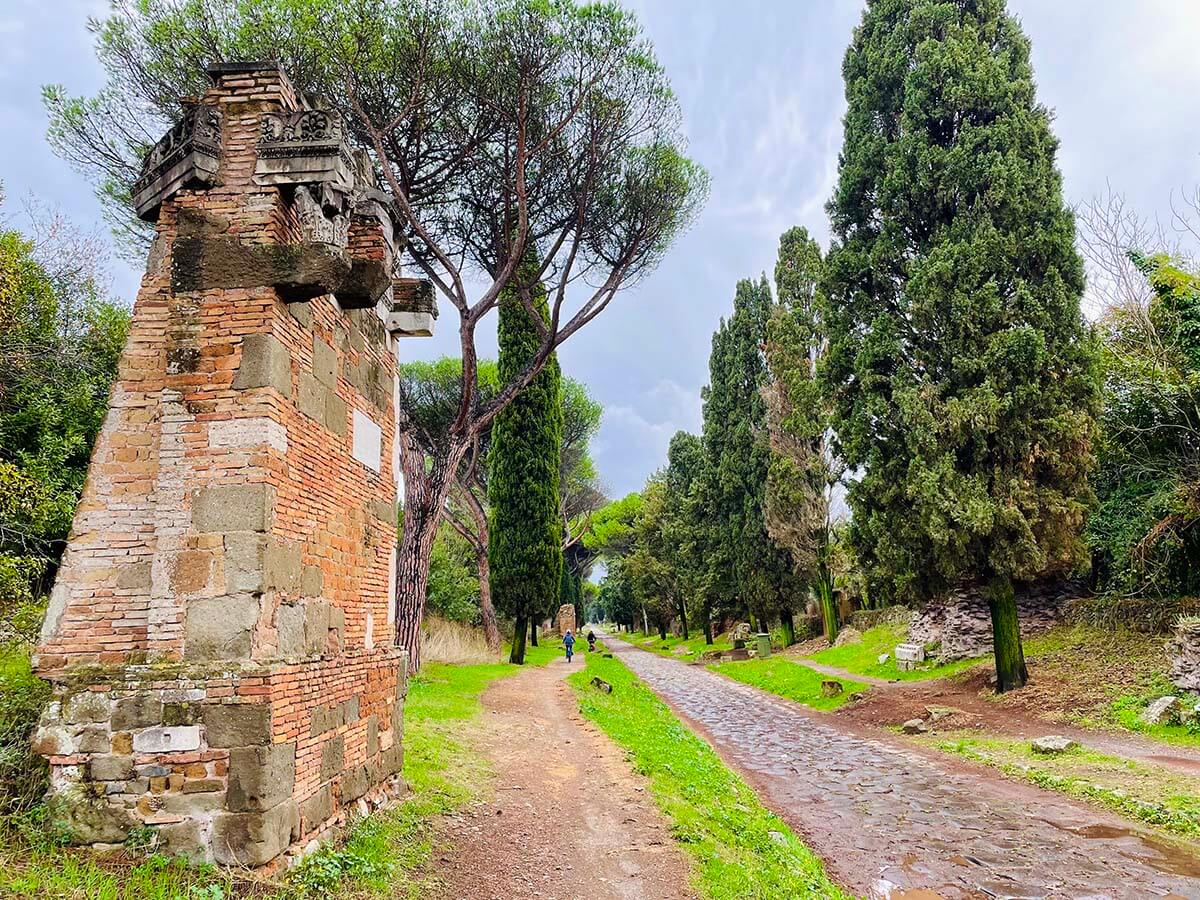
3.30 – 4 PM: Basilica di San Giovanni in Laterano
Just 10 minutes walk from where your bike tour ends, you can visit the main church of the city, the Cathedral of Rome, Basilica di San Giovanni in Laterano . It is this church (and not the St. Peter’s Basilica in the Vatican) that is considered as the ‘Cathedral of Rome and of the World’. The Pope is the reigning bishop of the city of Rome.
The reasoning behind this is quite simple – while the Pope stands above the cardinals and the bishops, St. Peter stands above the Pope. So St. Peter’s Basilica is a whole other league compared to any other church, and Rome – just as any other city – deserves its own cathedral, of course.
Anyway, the Basilica di San Giovanni in Laterano is absolutely impressive. The cathedral is massive, very richly decorated, and the statues of the Apostles inside are just as majestic as the ones at St. Peter’s. In the middle, you can also see the tomb of Pope Martino V , and on the far left corner of the church, there’s an entrance to a 13th-century cloister . You have to pay a few euros to visit here, but consider it as a donation to the church and be sure to check it out.
It took me quite a few visits to Rome before I finally made the time to visit this church, and I can tell you that it’s absolutely worth a detour. And since the bike tour ends just nearby, it’s really easy to add it to your 4-day Rome itinerary. A visit is free of charge, and it’s incomparably quieter here than at the Vatican.
TIP: While you can visit the Cathedral itself for free, you need a ticket to visit the cloisters. You can get this all-in ticket which includes everything there is to see at the Basilica and at the Scala Sancta across the street (more info below).

4 – 4.15 PM: Scala Santa
Just across the street from the Basilica, there’s one more little-known gem of Rome, Scala Santa (the Holy Stairs ). This is a small catholic sanctuary with a papal chapel and three impressive staircases leading to it. The middle of the three staircases is the Holy Stairs.
According to a Christian tradition, Jesus Christ climbed these stairs before his crucifixion . It’s believed that these stairs have been brought from Jerusalem to Rome in the 4th century. This staircase is considered sacred and is reserved for pilgrims who come here to pray and climb to the top on their knees hoping for a plenary indulgence. Millions of people have climbed these stairs on their knees, including many popes.
On top of the right staircase, there is a nice chapel, with an adjacent smaller papal chapel in the middle.
The papal chapel Sancta Sanctorum (the Holy of the Holies) itself is normally closed to the public and can only be seen through a small opening at the end of the middle stairs. It was exceptionally open when we visited, but I’m not sure if it will remain open to the public in the future. It contains lots of relics, some of which have been moved to the Vatican.
Even if you can’t visit the Holy of the Holies, a visit here is more than worth a few minutes of your time. The staircases are really impressive and so is the bigger chapel. And you can see the other one through a small opening too.
Good to know: Scala Santa is open daily in the morning and in the afternoon. There’s no fee to enter and no reservations are needed and you only need a couple of minutes. If you want to visit the papal chapel of Sancta Sanctorum (and it’s open), there’s a small fee (or you can get this ticket for the Cathedral and the Holy Stairs, as mentioned before). You can find more info about this sacred place and the opening times on their website .
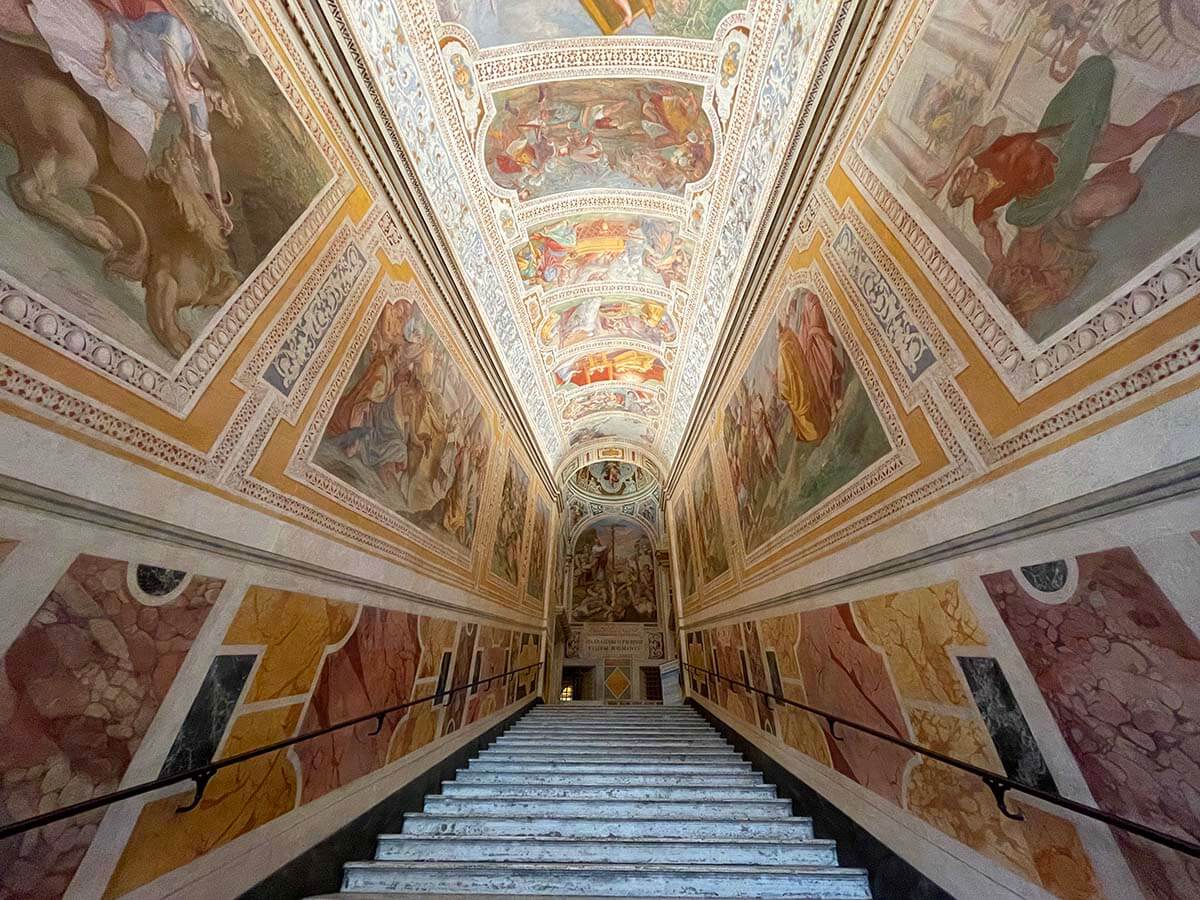
4.30 – 5 PM: St. Clement Basilica
After a visit to Basilica di San Giovanni in Laterano and the Holy Stairs, walk back in the direction of the Colosseum, and be sure to stop at St. Clement Basilica . From the outside, it might look just like any other of 900+ churches in Rome, but it houses a lot of secrets inside. This is one of the most unique places you can visit in Rome ! Yet, despite its proximity to the Colosseum, only very few tourists know about it or ever come here.
St. Clement Basilica was constructed in the 12th century. With its cozy interior and beautiful mosaics, it looks really nice, but – not that special, you’d think. There are tens of other very similar churches all over the city…
What makes it extraordinary is that underneath there’s an archeological site containing two underground levels. Right under the church, there’s the original Basilica, built in the 4th century. AND – yet another level deeper – there are 1st and 2nd- century buildings used by the members of the cult of Mithras. This seemingly ordinary church actually has three layers that literally take you back in time through centuries of Roman history.
There are several places in Rome where you can literally touch the 2000-year-old walls, but this is probably one of the most authentic sites (it probably feels like that because there are very few tourists) AND it’s so easy to visit! You don’t need any advance reservations, there are no queues, and it’s just a stone’s throw from the Colosseum! So even if you are not doing the bike tour and plan your Rome itinerary differently, you could easily come here when you are visiting the Colosseum.
Good to know: The Basilica’s Archeological Excavations are open daily except on Christmas Day. You can check up-to-date info for the opening times and buy a ticket on their website . Or pay a few euros more and simply get a ticket at the entrance. Kids under 16 are free of charge.
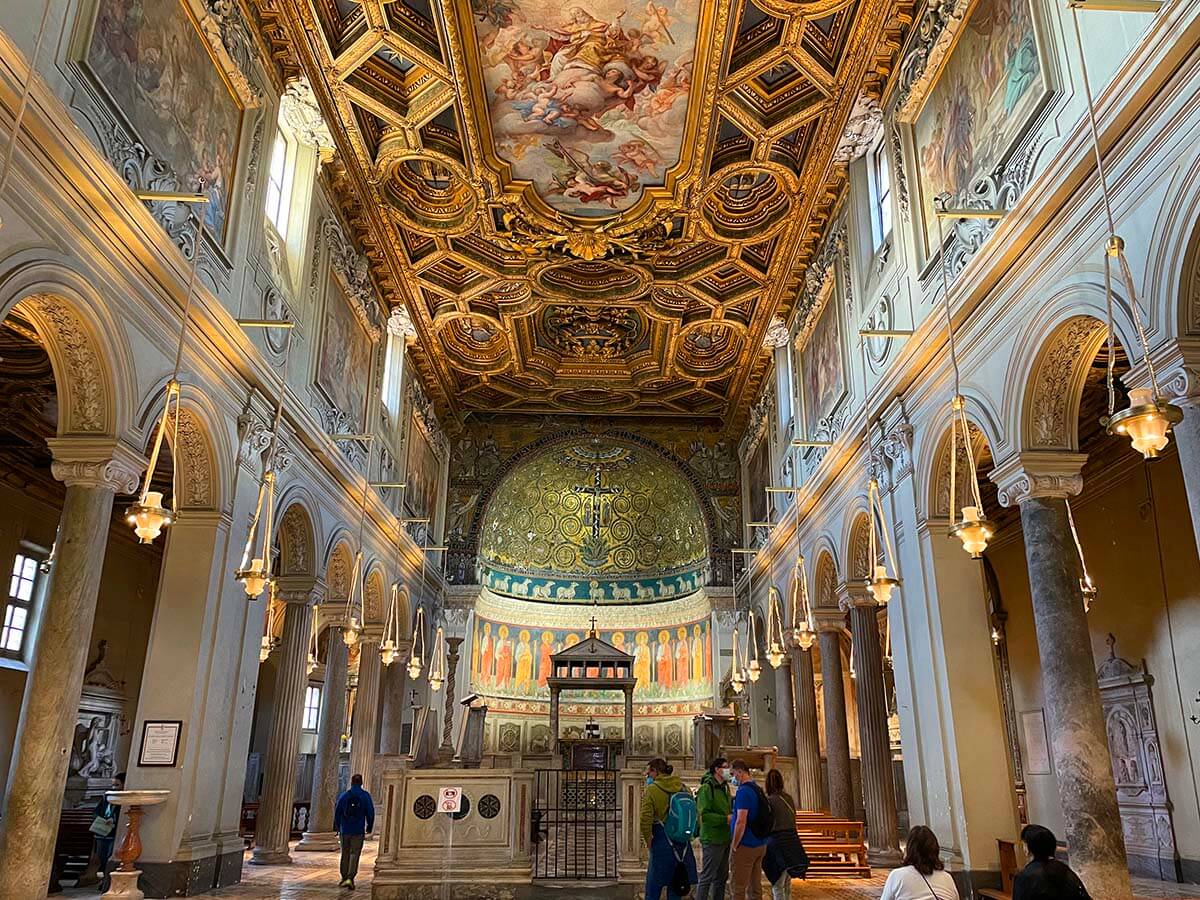
5.15 – 6 PM Domus Aurea
Domus Aurea , aka the Golden House of Emperor Nero, is located just next to the Colosseum and is well worth a visit as well. It’s an ancient archeological underground site where you can see the remains of the extravagant villa built by Nero after the Great Fire in 64 AD had destroyed a large part of the city.
The Golden House was huge, with over 200 rooms, pavilions, gardens, and even an artificial lake in the center, and was built to impress and entertain.
The most remarkable feature was the Octagonal Room with five rooms around it and waterfalls cascading down the walls. The main dining hall – the Octagonal Hall itself – has a big concrete dome with an oculus which is believed to have inspired the architecture of the Pantheon. This room also had a revolving floor – an impressive engineering achievement at that time.
Nero wasn’t loved and his impressive palace was looted and destroyed soon after his death. It was covered in earth and several other structures were built on top of it, including the Baths of Trajan and Titus. The Colosseum was built at a place where Nero’s lake used to be and it also got its name from the Colossus statue that used to stand at the entrance of Domus Aurea.
Good to know: Domus Aurea is normally open daily until 6.30 PM. However, at the moment of writing, it’s only open on the weekends and just a few hours a day. All visits are guided and normally also include a VR experience that gives you a good insight into how grand this palace was. Since it’s an underground site, it’s quite cold inside so you may want to take a sweater.
If you absolutely want to visit here, check the current opening times and reserve your tickets in advance. Normally, you can find info and reserve the tickets on this website , but it’s not always updated and can be somewhat unclear too. In the low season, you could probably just walk to the entrance and see if there are tickets available too. And otherwise, check out this organized tour – they’ll only show the dates and the times when a visit is actually possible.

6.15 – 6.30 PM: Basilica di San Pietro in Vincoli
Basilica di San Pietro in Vincoli is a 5th-century church best known for its relic – the chains of St. Peter and Michelangelo’s statue of Moses that is part of the tomb of Pope Julius II.
Normally, a visit is free of charge and the church is open daily until 7 PM. It’s located just 5 minutes walk from the Colosseum in the direction of the city center. Well worth a few minutes of your time.
TIP: After leaving the church, go to the right and you’ll find a small passage with a staircase on via San Francesco di Paola. It’s a nice hidden gem. If you walk to the center, you can continue via this staircase. Alternatively, head back to the Colosseum for sunset.
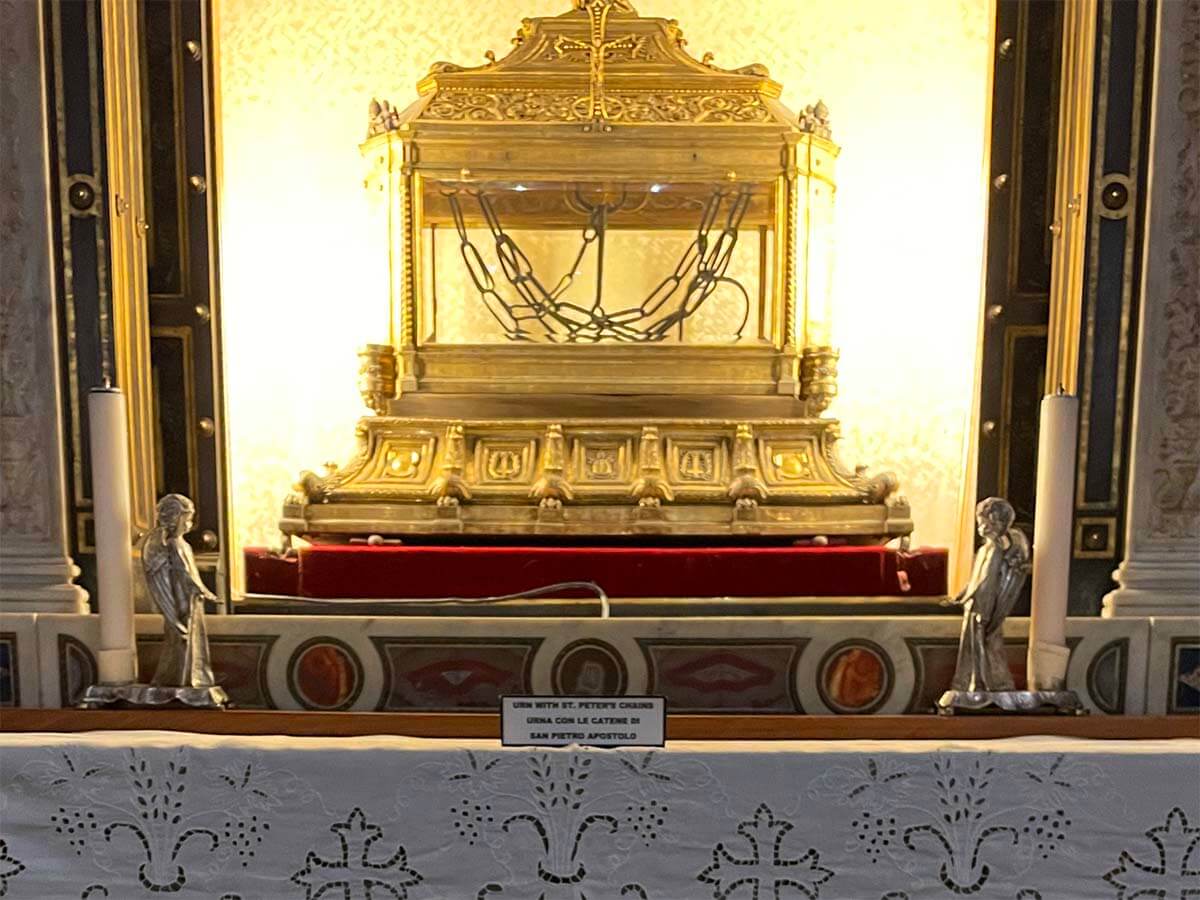
Sunset at the Colosseum
Depending on the time of the year (and the time of the sunset), you might find yourself close to the Colosseum at around twilight .
Seeing this landmark in a different light (and usually without the crowds of daytime visitors) might be a nice way to end your Rome city trip.
This itinerary is based on our most recent visit to Rome in November . At that time, the sunset was around 5 PM. So we came to the Colosseum after a visit to St. Clement Basilica, and could indeed enjoy the beautiful light. It wasn’t busy either.
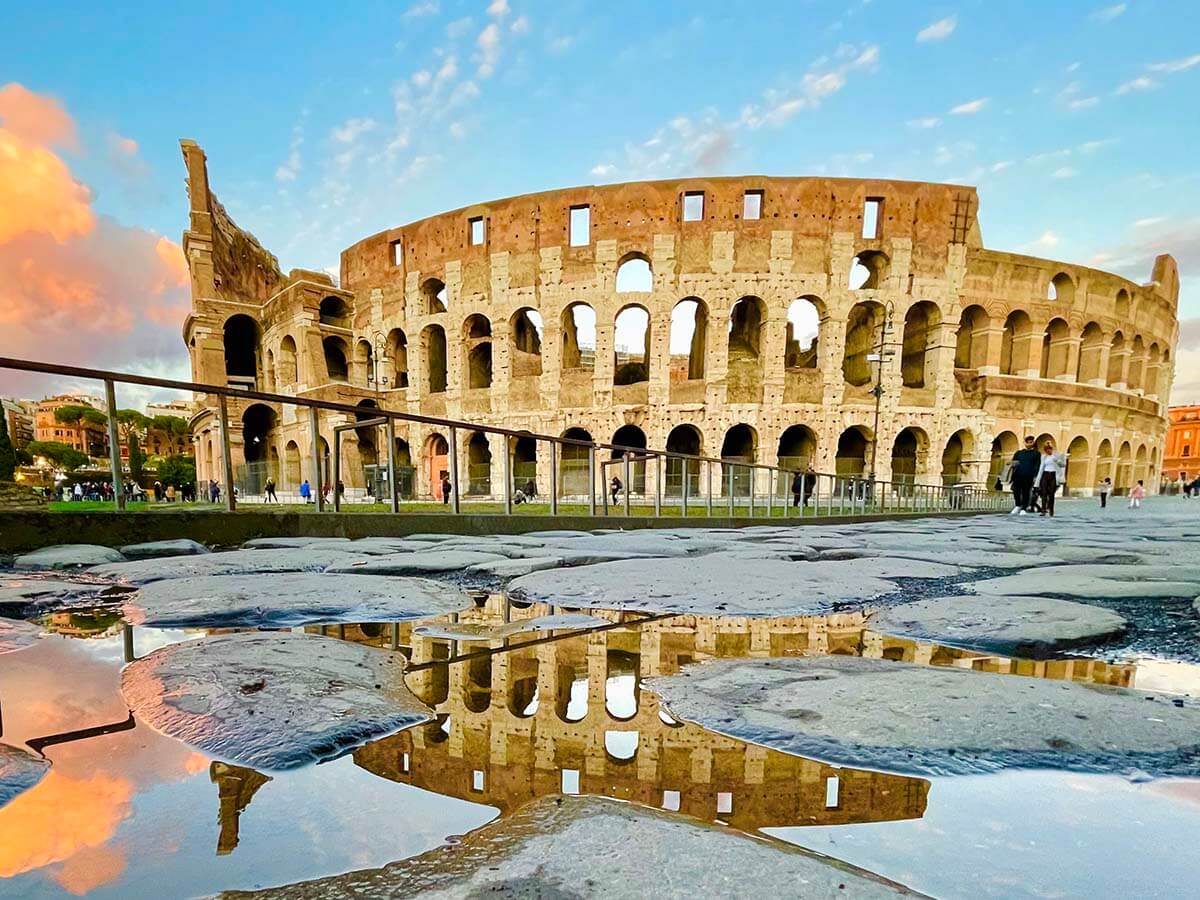
There are many restaurants in the Colosseum area too, so you could have dinner here. We walked in the direction of the Jewish Quarter – there are some really good restaurants serving traditional Italian food here, but you have to reserve most of them in advance, definitely in the high season.
Here are some restaurant suggestions for this area that we got from our food tour guide: Giggetto , Sora Margherita , or Al Pompiere Roma (for local Roman dishes), Emma (for pizza and Roman appetizers).
Since the other restaurants opened for dinner even later, we went to Emma’s and were glad to get one of the last available tables (had no idea it would be fully booked on a weekday in November).
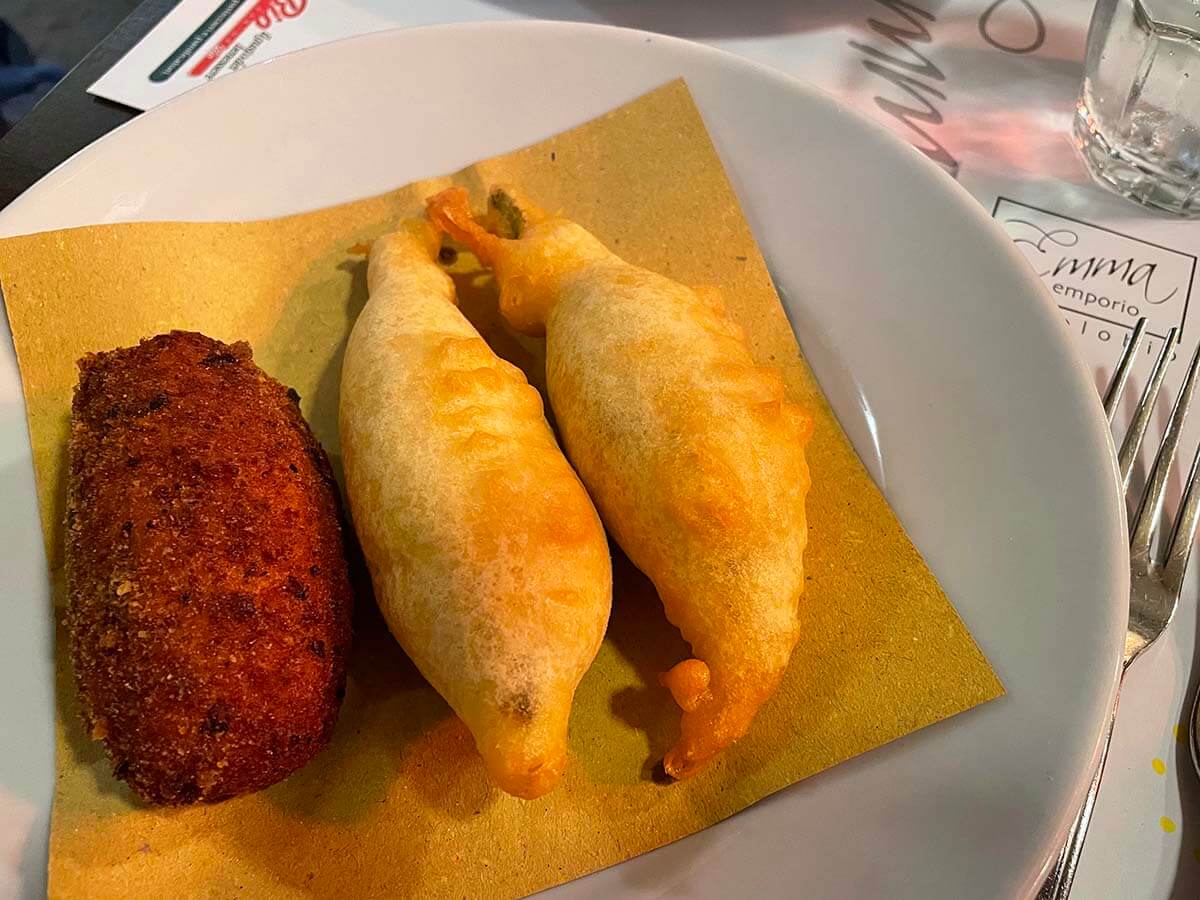
Map & Getting Around
Below, you can see a map of this 4-day Rome itinerary .
It contains all the places mentioned in this article, including restaurant suggestions. You can save this map to your phone and use it during the trip. To make it easier, we used four different colors – one per day.
Getting around: For this itinerary, we simply walked everywhere (except for the airport transfers and the e-bike tour, of course). This is definitely doable if you stay in the city center, plan well, and wear very comfortable shoes. However, prepare to walk A LOT .
You could also cover some of the bigger distances by public transport (buses, metro), take a taxi , or – probably the easiest and quickest – rent an electric scooter . They are scattered all over Rome and it looked like it shouldn’t be a problem to find one where and when you need it. Just drive carefully because the traffic is crazy.
LEARN MORE: Rome Airport Transfers
How to use this map: Use your computer mouse (or fingers) to zoom in or out. Click on the icons to get more information about each place. Click the arrow on the top left corner for the index. Click the star next to the map’s title to add it to your Google Maps account. To view the saved map on your smartphone or PC, open Google Maps, click the menu and go to ‘Your Places’/’Maps’. If you want to print the map or see it in a bigger window, click on ‘View larger map’ in the top right corner.
If you have more time
If you have more than 4 days in Rome, you could, of course, take it easier and visit some of the places we indicated in our itinerary on different days. There are also many more museums, churches, etc.
However, if you want to make the most of your visit , I recommend booking a few day tours that take you outside the city.
Here are some of the most popular options for the best day trips from Rome :
- Villa D’Este & Hadrian’s Villa in Tivoli
- Pompeii & Mt. Vesuvius OR Pompeii & Amalfi Coast
- Tuscany Taster Tour: Day Trip with Lunch & Wine
- Florence & Pisa in a Day
Where to stay for 4 days in Rome
For this 4-day Rome itinerary, we recommend staying in the heart of the historic city center. Our favorite area to stay in Rome is around Pantheon, but pretty much anywhere between Piazza Navona and the Trevi Fountain is great.
Staying here, you can easily walk to the main landmarks, and pretty much all the main areas of interest are within 15-30 minutes walking distance.
Here are some of the best-rated hotels close to the Pantheon for all budgets (although low-budget options are scarce in this area):
- €€€€€+ The Pantheon Iconic Rome Hotel, Autograph Collection (a very luxurious 5* boutique hotel).
- €€€€ 9Hotel Cesari (a very centrally located 4* hotel; this is where we stayed).
- €€€ Hotel Navona (a popular 3* hotel).
- €€ Hotel Primavera (highly-rated 2* hotel; one of the best lower-budget choices in the historic center).
READ ALSO: Where to Stay in Rome

So, this is our 4 days Rome itinerary. I hope that all the time indications and the details will help you plan an unforgettable trip to the Eternal City and explore a bit deeper, beyond the main attractions.
Have a great trip!
TIP: If you are looking for more information and tips for your trip to Rome , be sure to check out this article with Rome travel tips for your first trip . It contains all the useful info and info that will help you plan a more enjoyable visit. Take a look!
READ ALSO: Best Things to Do in Rome
More travel inspiration for Rome:
- Hidden gems of Rome
- Where to eat in Rome
- 1 day in Rome
- 2 days in Rome
- Best views in Rome
- Best underground sites in Rome
TIP: If you are visiting Italy for the first time and are wondering where to go and how to plan your time, check out this Italy trip itinerary that includes all the must-sees.
If you found this post useful, don’t forget to bookmark it and share it with your friends. Are you on Pinterest? Pin these images!
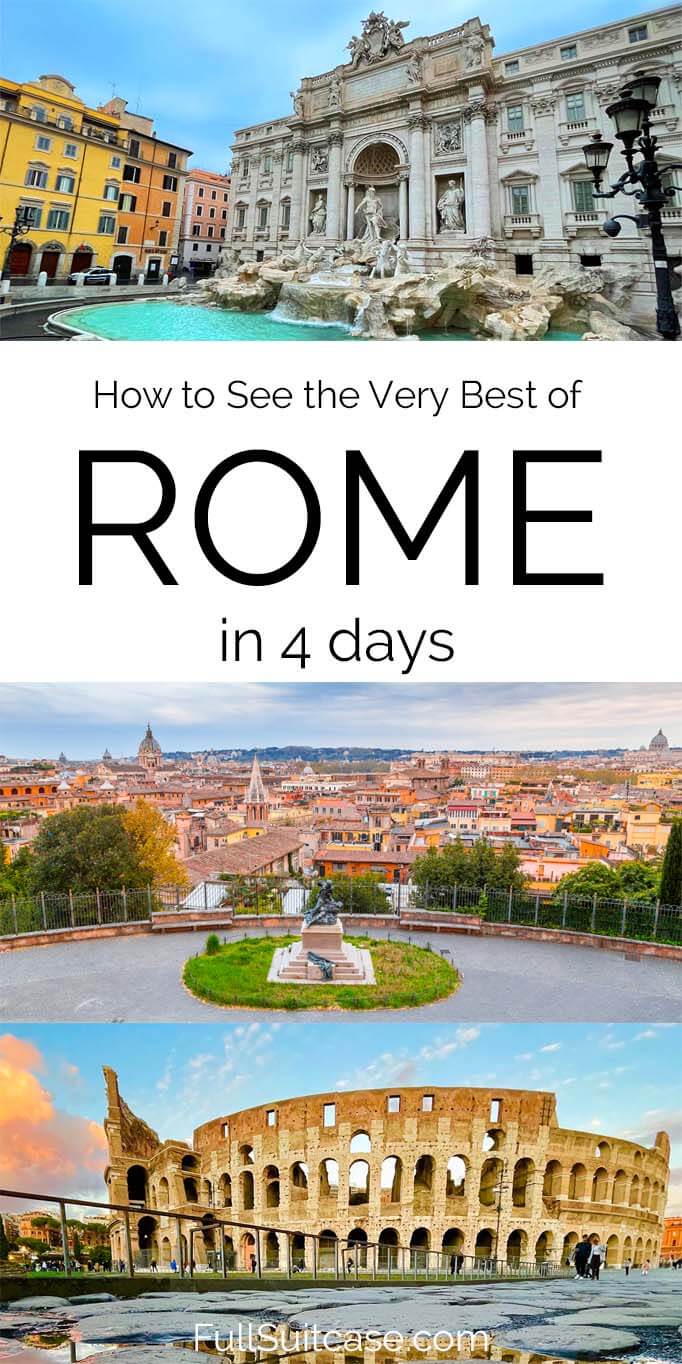
More travel inspiration for Italy:
- Best places to see in Italy
- Best towns to visit in Italy
- Best Sights & Attractions in Venice
- Best Things to Do in Florence
- Best Things to Do in Milan
- Best Things to Do in Siena
- Best Things to Do in Bologna
- Best Things to Do in Verona
- Best Things to Do in Naples
- Best Things to Do in Ravenna
- Best Things to Do in Montepulciano
- Best Things to Do in Como
- Best Things to Do in Rimini
- One Day in Venice
- Three Days in Venice
- One Day in Milan
- One Day in Florence
- One Day in Cinque Terre
- One Day in Naples
- Florence to Bologna: Travel Info & Itinerary
- Bellagio (Italy)
- Tuscany itinerary
- Amalfi Coast itinerary
- Emilia Romagna itinerary
- Dolomites itinerary
- …. For many more destinations, be sure to check our Italy travel guide . It contains an overview of all our articles for a wide variety of popular places all over Italy.
This site uses Akismet to reduce spam. Learn how your comment data is processed .
John Signorelli
Sunday 15th of October 2023
I used the information here to plan my recent trip to Italy. This article was great (as was every article you have on Italy). If anyone is wondering to plan your trip yourself and use this article or to use a tour company, I have zero complaints about what I learned from Jurga for our trip.
Our next trip will be to Athens, but I didn't see an article on that - can't imaging planning my visit without your advice.
Monday 16th of October 2023
Thank you for your feedback on this and all those other articles where you left comments, John. It's always great to hear from our readers who use the information on our blog on their trips! As for Athens, unfortunately, I still haven't been there. And other trips to Greece are from so long ago that it wouldn't make sense to write about it anymore... So I'm afraid I can't help you much with that. But we have many other destinations covered on our blog if you are looking for some trip inspiration for the future. I can highly recommend you look into visiting Portugal one day. We now go there several times a year and absolutely love it every time. If you were to return to Italy, southern Italy and especially the area around Naples - Amalfi Coast is also incredibly beautiful with lots of very interesting sights. Happy travels!
Monday 17th of July 2023
Hi there, I've been trying to book tickets for collesium, forum and palatine Hill priority entrance + arena floor on tiqets website but it says hi there early bird, tickets are unavailable. I am planning trip next month and am trying to book before too late for non tour tickets due to health reasons I can't do tour because of frequent restroom breaks... is there another site to buy same ticket without tour including arena floor? I can't get a hold of anyone on their website. Thanks.
Tuesday 18th of July 2023
Hi Sam, the Colosseum tickets are normally released 30 days in advance and it's indeed, the best time to buy them - as soon as they are available for your travel date. This summer, things have been crazy. A few weeks ago, there was no availability at all; from mid-August things look a bit better. The official site is coopculture, but it's not really user-friendly, so we personally never use it. We recommend using either Tiqets or GetYourGuide for all your tickets in Rome. When the tickets are released, they are normally available on all these websites at the same time. But you can always check the official site in case they release them a bit earlier. As said, this summer has just been crazy for the Colosseum tickets. That said, I still highly recommend going with a tour if you can manage it. So many people tell me they regret not doing a tour because it wasn't always clear where to go, they missed certain parts but were not allowed to backtrack, etc. etc. Hope this helps.
Saturday 17th of June 2023
I love your blog. This itinerary will be so helpful as we are going to Rome for four days this August. Can you advise me on the following: I arrive at 8 a.m. and can't check into my air bnb until the afternoon. Do you know of a place to store our luggage so we don't waste our first day waiting to check in?
Hi Jill, upon arrival at the airport, take a train or a bus to the central station (see all the options explained in our Rome airport transfers article). Once at the station, you could use this highly-rated luggage storage for your bags. PS One more thing for this summer. The Colosseum tickets are practically impossible to get these days. So be sure to book a guided tour asap if you want to be sure to go inside (see our guide to Colosseum tickets for more info). Rome is very busy at the moment. Have a great trip!
Monday 22nd of August 2022
Hi Jurga, I like your itinerary very much. Thank you for all the info. For Colosseum ticket, it includes Roman Forum and Palatine Hill also. Are there separate entries for the Forum and Palatine Hill? Can I go to the Forum first, get out to have lunch, then go Palatine Hill, and then see Colosseum at the last? Is this doable? The morning tickets are sold out, and no re-entry allowed, but I have to get out to have lunch, then enter to another, I wonder how they handle one ticket for three places. Thank you! -Chen
Hi Jurga, Thank you so much! Booked 12:30 tickets. I got another question. For Appian way, if I walk/hike it, can I see all the places in your pictures? I can't bike, but I can hike 7 miles. Or is there a tour bus? Thank you! -Chen
Hi Chen, you can enter Colosseum separately, but the Roman Forum and the Palatine Hill can only be visited together. So it’s three places but actually two tickets. You can do one of the two in the morning and the other after lunch, but you could also do everything after lunch if you prefer. Hope this clarifies. Enjoy your trip!
Finding the Universe
Travel tales, photography and a dash of humor
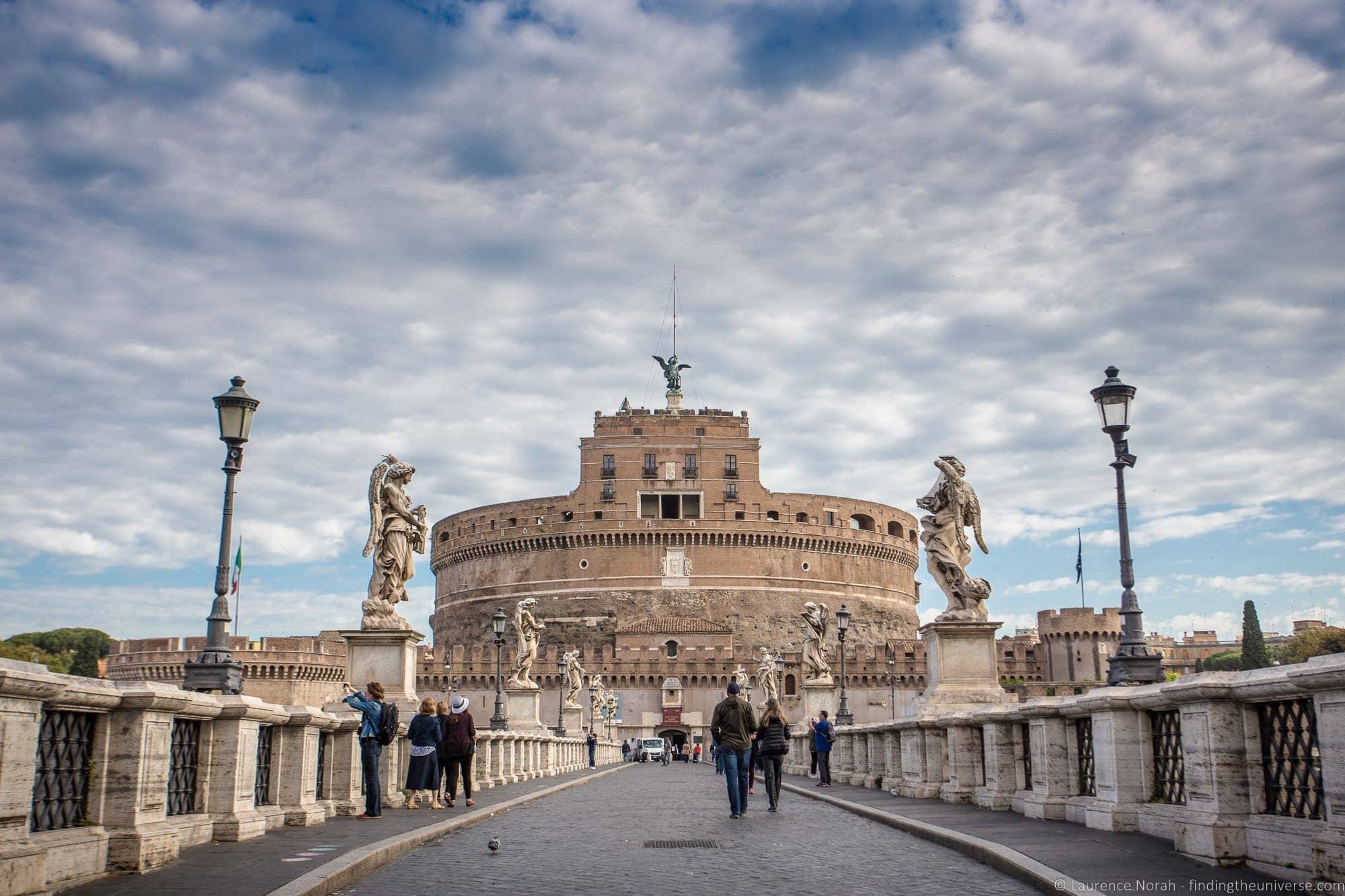
2 Days In Rome: The Perfect Rome Itinerary
Last updated: December 17, 2023 . Written by Laurence Norah - 35 Comments
In this post, we’re going to share with you our idea of how to spend the perfect 2 days in Rome. There is a lot to see in Rome, so you’ll likely want to return (throw a coin in the Trevi Fountain to be sure of that!), but as an introduction to the city, this itinerary will definitely get you started.
Rome is one of our favourite destinations, it’s a city we’ve visited multiple times and one we’re always happy to return to. We just love exploring all the ancient ruins, wandering down cobbled alleyways, eating delicious Italian food and trying all the different flavours of gelato !
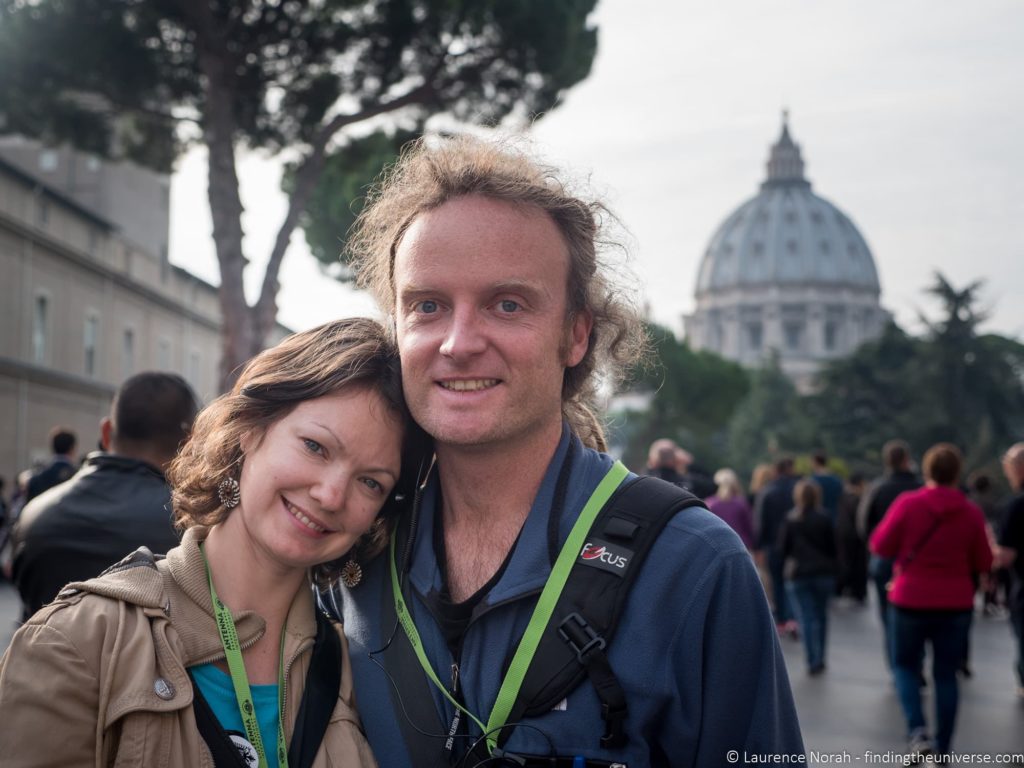
Our suggested Rome itinerary is designed more around the first-time visitor looking to see many of the more famous sights, but will also work for a return visitor looking for inspiration.
As well as the itinerary, we’ll also be sharing with you our tips for getting around Rome, advice on where to stay, how to save money, a map of our favourite Rome attractions and more!
If you are visiting Europe on a longer trip, this guide to two days in Rome would work well as part of a longer Europe itinerary like this , or a focused Italy itinerary like this . You might want to read these posts afterwards. For now though, let’s get started with our guide to spending two days in Rome.
2 Days in Rome: An Itinerary
Day 1 in Rome
Our first day in Rome has you exploring some of Rome’s most famous sights, from stunning 2,000 year old gladiatorial arenas to Renaissance artwork.
First on the itinerary for your time in Rome is a visit to the mighty Colosseum . For over two thousand years this has been a landmark location in Rome, and it was once home to the infamous gladiatorial battles that were watched by tens of thousands of Roman citizens, not to mention Roman Emperors.
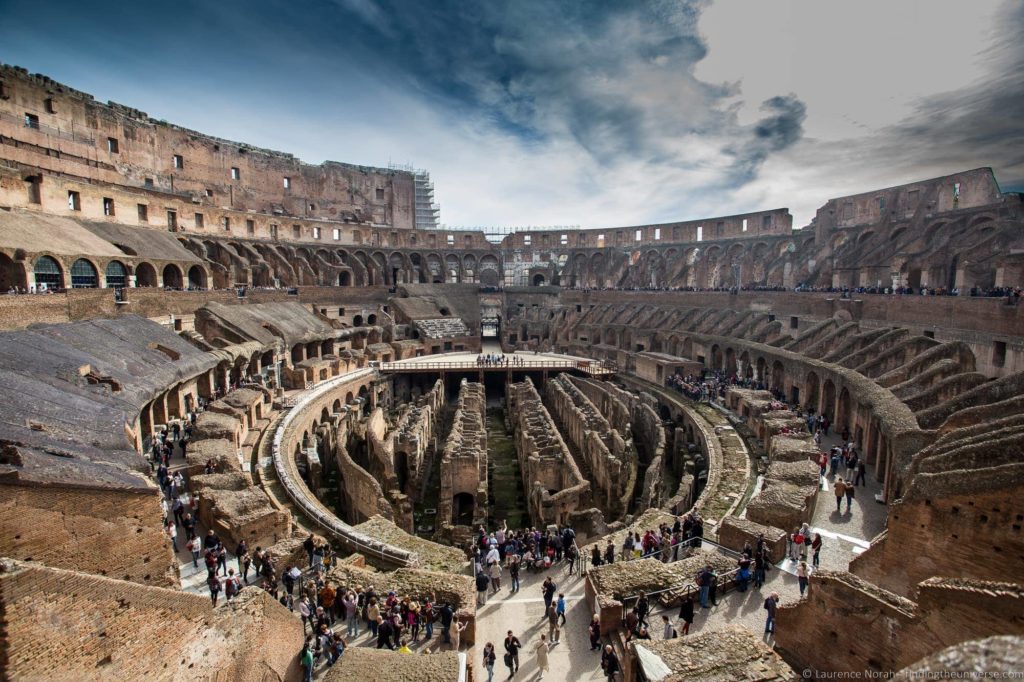
To be able to visit a place where historical figures would have sat to be entertained (by remarkably gruesome spectacles) is quite incredible, and you can almost feel the weight of history carrying through the stones here.
Of course, the years have taken their toll, and the Colosseum is not quite the same place it was in its heyday. Still, it’s a remarkable testament to Roman engineering that so much survives to this day. You’ll likely want to spend at least forty-five minutes to an hour here to soak it all in – and maybe longer!
We’ve put the Colosseum first on the list for our first day in Rome for a reason – it gets very busy, particularly in the summer months. This is a common theme shared across many of Rome’s top attractions, and we definitely suggest you look into ways to minimize your time queuing.
The first option to avoid the queues is to buy a ticket directly from the official ticket office website , which gives you the option to specify an entry date and time for your visit. Just be aware these tickets are non-refundable. They d0 also sell out, so be sure to book as far in advance as you can (tickets become available 30 days in advance of the entry date).
If you do decide to just get a standard entry ticket rather than taking a guided tour, then I highly recommend picking up a guide book which includes details on the Colosseum like this pocket guide , or downloading a free audio guide to your smartphone which covers the Colosseum like this one from Rick Steves .
This will really help you navigate the site, as there is so much to see and it can be quite overwhelming otherwise.
You can also buy tickets for the Colosseum on the tiqets website here , and GetYourGuide here . These include tours and tickets with addons like multimedia guides or bundles which include other attractions and activities in Rome.
These are going to be a little more expensive but can definitely be worth it if you want to take a tour or will take advantage of the other bundled products.
Note that Colosseum policy requires third-party sites to include an add-on such as a tour or multimedia guide when providing tickets, which makes them a little more expensive, but you are getting extra value as a result.
Another good option would be to take a tour (we recommend Take Walks who have a number of Colosseum tours ). Other tour options can be seen here . We highly recommend taking a tour of the Colosseum if your budget and timeframe allows for it, as it is a complex site with a lot of history. But it’s up to you of course!
Finally, you might consider investing in a Rome city pass that comes with fast-track entry to this and other attractions in Rome, such as the Roma Pass or Rome Tourist Card . We’ll cover more of these options towards the end of the post.
See our detailed guide to visiting the Colosseum for more information on how to book tickets and get the most out of your time here.
Note that as of October 2023 all Colosseum tickets are issued in the name of the person visiting, and you need to bring ID with you to use your ticket.
Roman Forum
Right next to the Coliseum, and included on the majority of Coliseum tickets and tours, is the Roman Forum. Since it’s right next to the Coliseum, and your ticket likely already includes it, we think it makes sense for this to be your next stop in Rome.
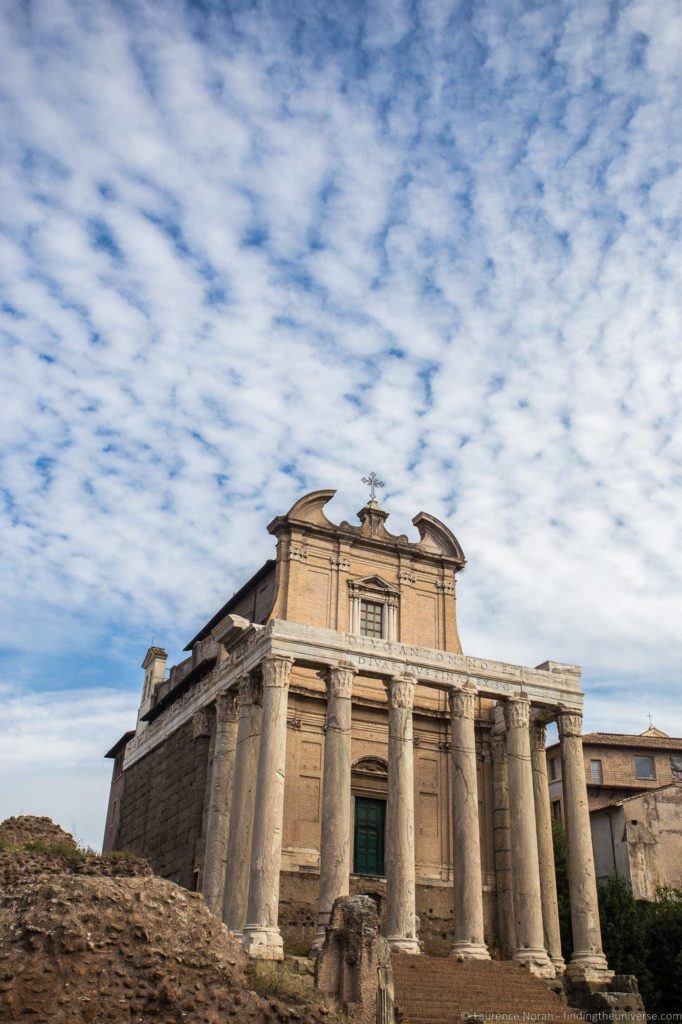
For centuries, the Roman Forum was the heart of the Roman Empire. The square plaza, surrounded by the government buildings of the empire, was where everything from the political to the religious life of the city took place.
Today you can visit the Roman Forum, which is a large open area dotted with excavations, ruins and various notable sights.
Again, you can take a guided tour, or you can see yourself around, although we’d definitely suggest taking some sort of tour to get the most out of your visit and help you to understand exactly what you are seeing. See more about our suggested tours at the end of the post.
The Forum is open every day, you can see full opening hours here .
Most people visit the Forum using their Colosseum ticket, which will give you access into the main parts of the Forum.
However, there is also a “S.U.P.E.R.” ticket, which can be purchased separately on the official site here . This gives access to a number of additional sites inside the Forum, which you may be interested in visiting depending on how deep into Roman history you want to go.
These additional sites vary depending on archeological works, but usually include the Palatine Museum, House of Augustus, Aula Isiaca, Santa Maria Antiqua, Curia Iulia, Domus Tiberiana, Domus Transitoria and Livia’s House. So that’s something else to consider.
Circo Maximus
The Circo Maximus (or Circo Massimo in Italian), was Rome’s largest public games venue, which played host to numerous events. Perhaps most famously of these were the chariot races, a high-energy sport that became the focus of the Circus.
Other sports and celebrations were of course held at the Circus, including religious celebrations and staged animal hunts, and it was also used as a sort of local market area when not otherwise in active use.
Today, the Circus is an open public park which you can visit for free, and it’s only a short distance to the south of the Roman Forum, so we think is worth your time to visit.
Capitoline Museums
Rome has so many incredible museums that it is hard to pick just one or two to visit over two days in Rome. However, we can very much recommend the Capitoline museums , which are right next to the Roman Forum, and in fact offer a unique view of the Forum.
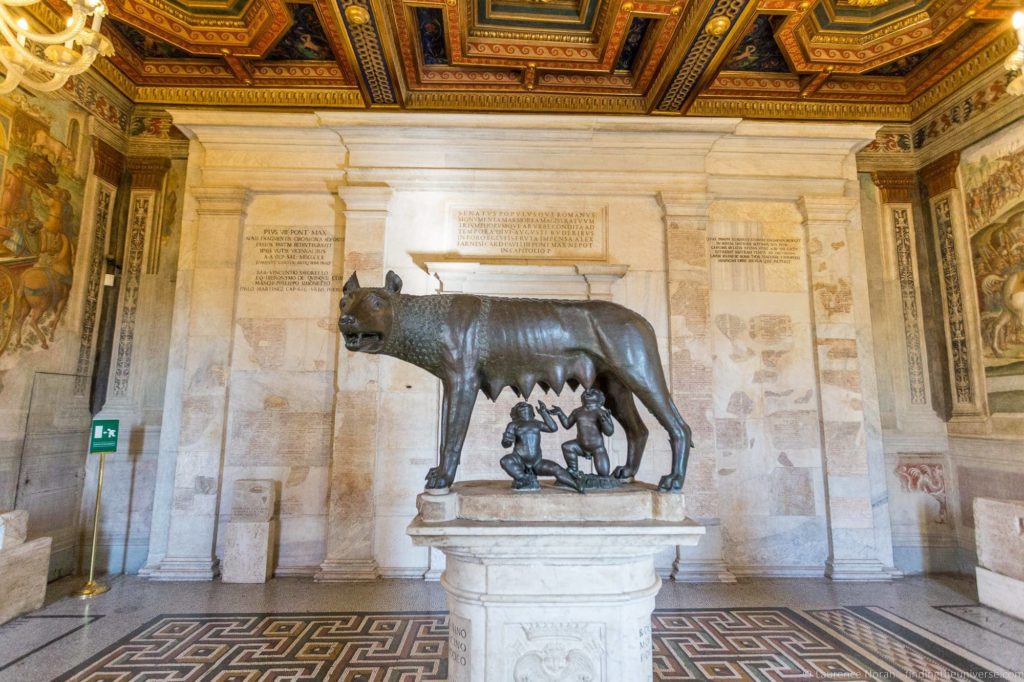
But you’re not coming here just for the view. The Capitoline Museums (which are actually just one museum housed in a number of buildings), are home to a number of treasures, including medieval and Renaissance art. They’re also well established, being the world’s oldest national museum, and in their present guise are set out to a design by Michelangelo.
The museum on Capitoline Hill consists of three main buildings that house different collections, with a primary focus on sculpture, although there are of course other items in the collection including jewellery and other art pieces. One of the most famous pieces, and one that you must see on your visit, is the sculpture of the “She-Wolf” feeding Romulus and Remus, one of the most well known symbols of Rome.
Entry to the Capitoline Museums is ticketed, with discounts available for Roma pass holders. They are open every day from 9.30am – 7.30pm.
Trevi Fountain
We’re going to finish off the first of our two days in Rome with a couple of Rome classics. The first of these is the Trevi Fountain, a massive Baroque installation that is arguably the most famous fountain in the world.
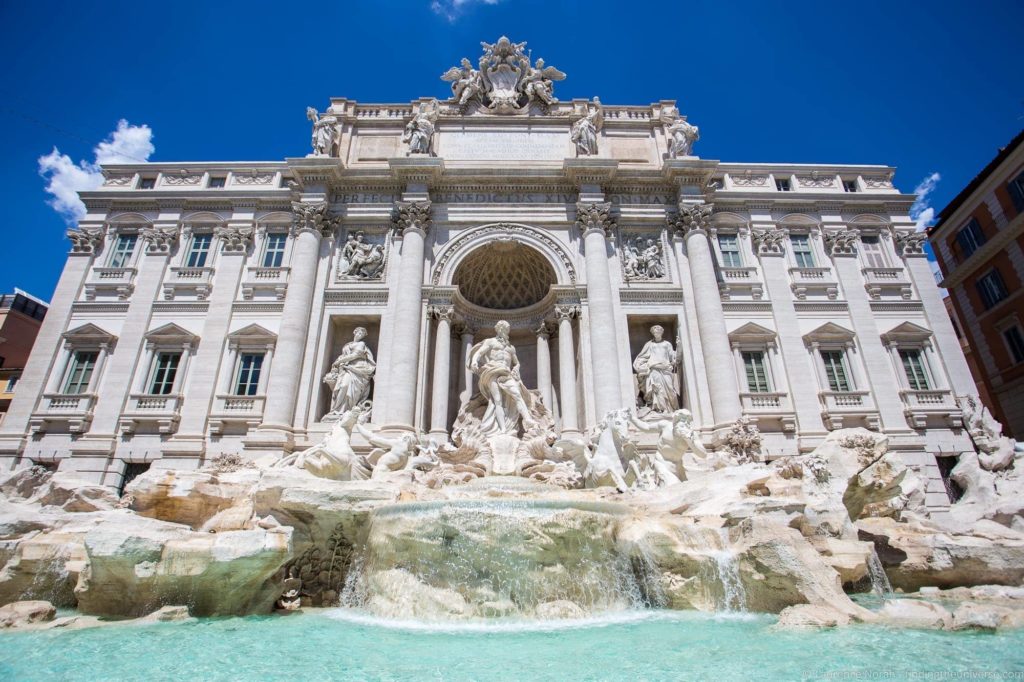
Dating from the middle of the 18th century, this huge fountain was designed by Italian architect Nicola Salvi, and is a must-see for visitors to Rome. It’s good to visit at both day or night, but do be aware that it’s likely going to be crowded here at pretty much any time of day!
It’s considered good luck to throw a coin into the fountain – and if you do so it’s said that you are guaranteed to return to Rom. As a result, over 3,000 euros worth of coins are thrown into the fountain every day! This works out well for the needy of Rome, as the funds are used to help provide them with food.
Just a short walk from the Trevi Fountain is another highlight of any visit to Rome – the magnificent Pantheon. Nearly two thousand years old, this is an incredible example of Roman engineering and is guaranteed to take your breath away.
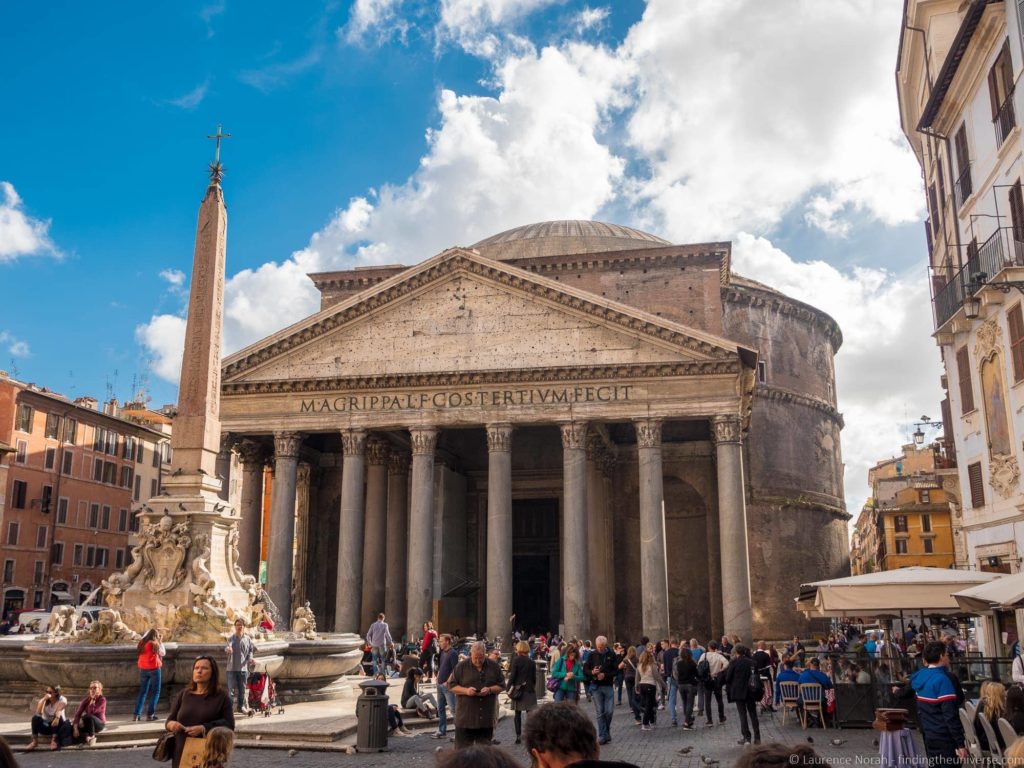
Originally built as a temple, and then turned into a church, the building was completed under the rule of the Emperor Hadrian. It’s a huge circular design, with the main area of the church sitting underneath a huge concrete dome, in the centre of which is a huge opening.
Despite being nearly two thousand years old, this is still the world’s largest unreinforced concrete dome. Clearly, those Romans built things to last!
As well as its mind-boggling construction the Pantheon is also noted for being the last resting place of a number of historical figures, including the Renaissance painter Raphael. You can see opening times and more information on the official Pantheon website here .
For a long time the Pantheon was free to visit but as of July 2023 there’s a small fee. You can pay this on-site, or you can buy it online in advance from the official site here (you’ll need to create an account).
Tickets with an audioguide are also available from GetYourGuide online here , although they are a bit more expensive.
You can also book an audioguide in advance here to help explain what you are seeing.
Have Dinner or Take an Evening Food Tour!
Well, that wraps up our first day of our two day Rome itinerary! Now it’s time to head to dinner, and you’ll find no shortage of options all around Rome.
The choice can be a little overwhelming, so we’d advise reading up in advance and getting some ideas for where you might want to eat so as to get a good option.
Another option to consider, rather than ending your day here, is to take a food walking tour. We’ve taken this evening food and wine tour of the Trastevere neighbourhood , and thought it was excellent.
It was a great way to try a lot of local food and wines, and also to get some recommendations for other locations to eat in Rome.
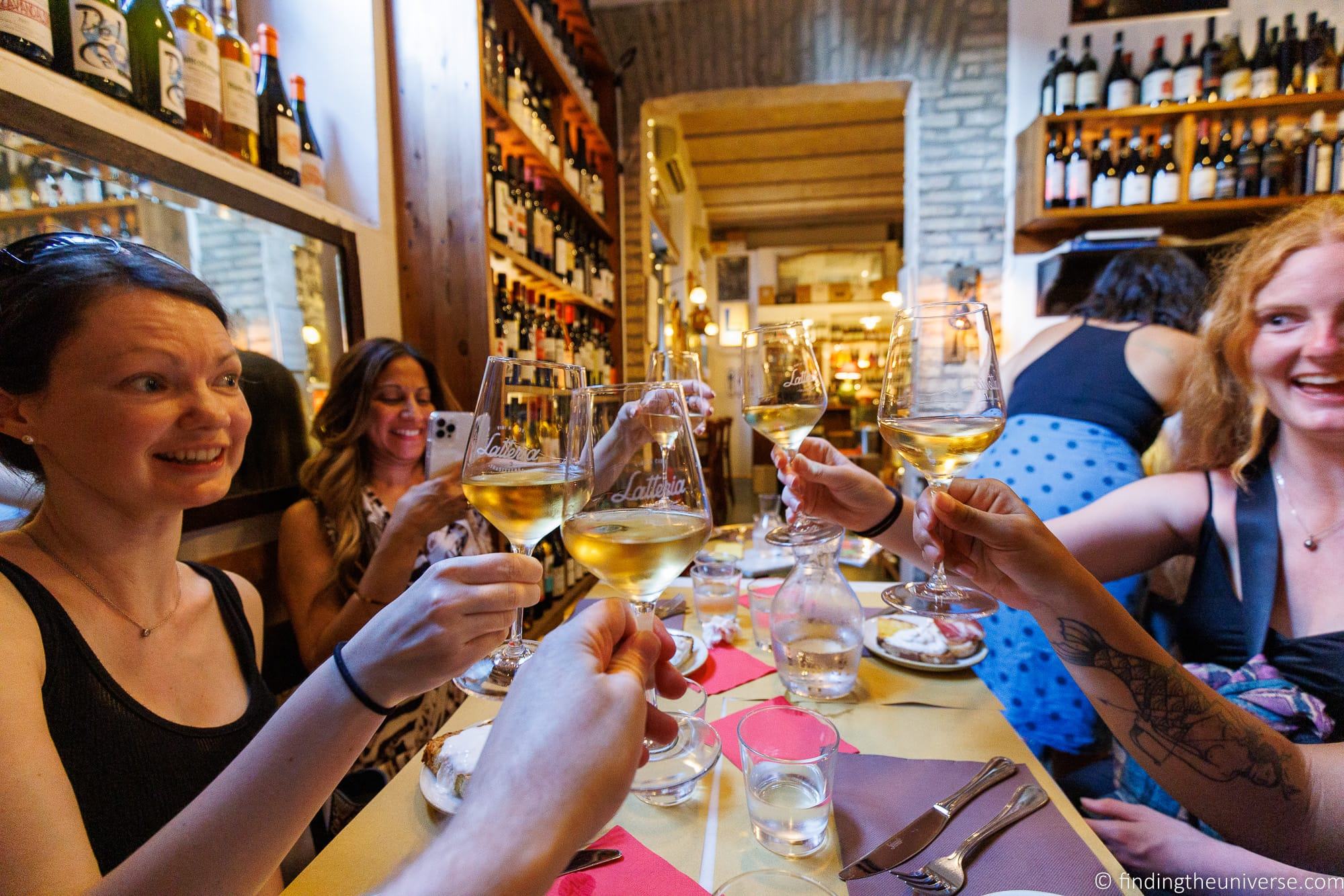
Day 2 in Rome
Vatican City
For your second day in Rome, we’re going to start by visiting the city inside the city – the Vatican City in fact. Whilst this wholly surrounded by Rome, it is its own state – the world’s smallest!
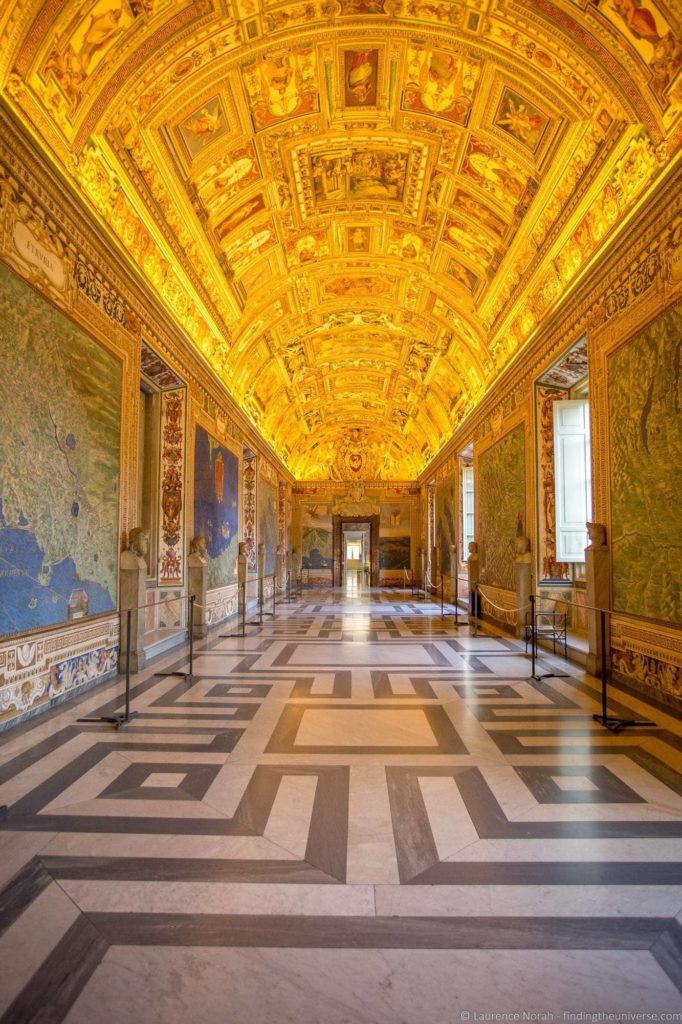
The Vatican City is home to a number of attractions, with the most popular being the Vatican Museums, the Sistine Chapel and St. Peter’s Basilica.
These attractions are well worth spending your morning exploring, and in fact you could spend the greater part of a day exploring here – the Vatican Museums alone are home to miles of exhibits!
If possible though, we’d advise limiting your time here to half a day, giving you time to see a few more attractions.
Half a day will give you time to see the highlights of the Vatican Museums, gaze at the incredible Sistine Chapel, and explore St. Peter’s Basilica – including taking the walk to the top of the dome, for spectacular views.
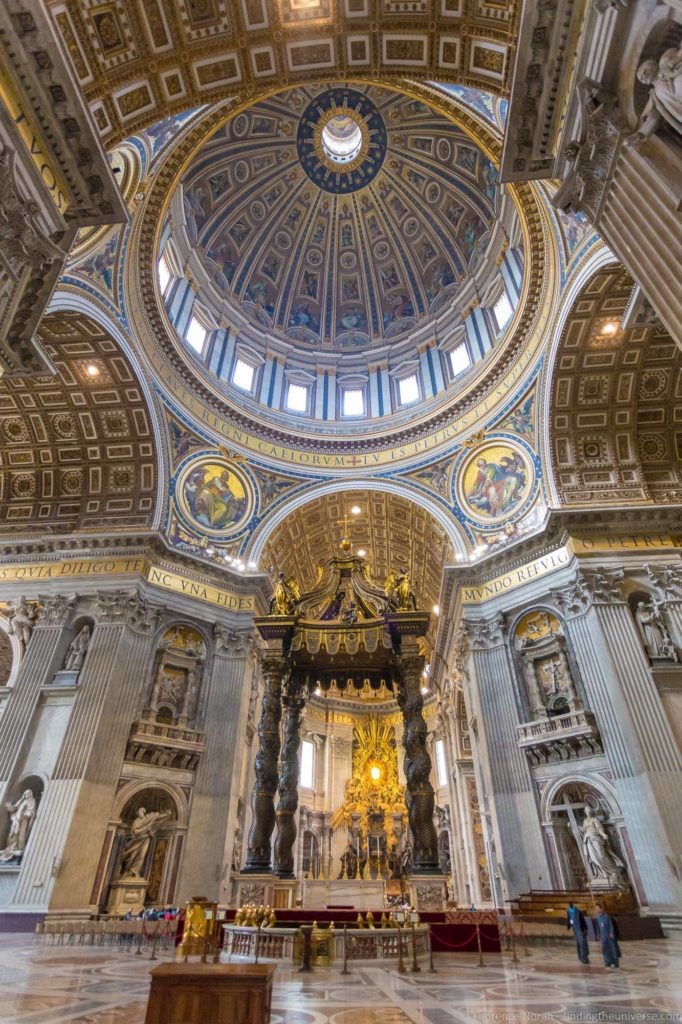
We’d highly recommend getting here early, and using one of our suggestions for saving time getting in – the queues for the Vatican Museums and St. Peter’s Basilica are legendary!
We have a number of recommended options for speeding up your access to the Vatican City attractions.
First, you can buy individual tickets online with GetYourGuide here and Tiqets here (latter with a 5% discount on their normal price). These tickets give you skip the line access to the Vatican Museums. This will let you skip the main line for the Vatican Museum, which also includes the Sistine Chapel – but not St. Peter’s Basilica.
You can also book tickets online directly from the Vatican , which is usually a little cheaper but in our experience the other sites are easier to use than the official site.
As of early 2023 St Peter’s Basilica doesn’t actually have an entry fee, but nor does it have skip the line tickets (skip the line tickets used to be an option and we hope they come back soon!).
So the best option if you want to skip the line at St. Peter’s Basilica is to invest either in a tour like one of these or a pass which includes a tour like the Rome Tourist Card . Some tours of the Vatican, like this one , also include skip the line access to St. Peter’s Basilica which can be a good option.
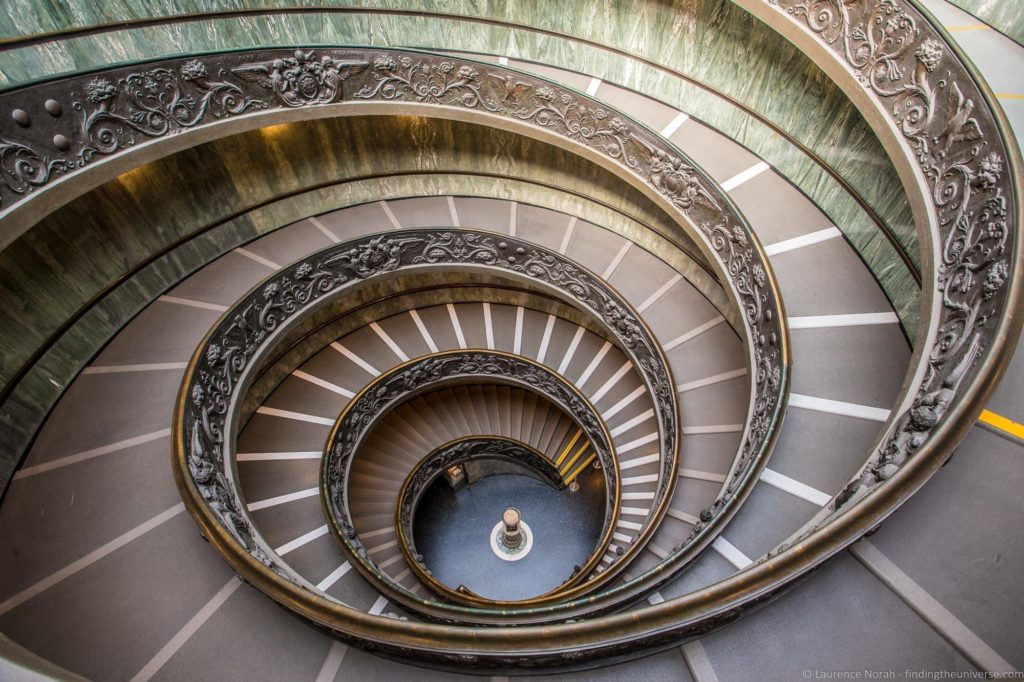
Finally, our last suggestion for skip the line access to the Vatican Museums and St. Peter’s Basilica is to take a dedicated early bird tour with one of our preferred walking tour companies.
We’ve taken two Take Walks tours that featured early access to the Vatican Museums and Sistine Chapel, the Pristine Sistine Tour and the incredible Vatican Key Master’s Tour (see our review of the VIP Key Master’s Tour here ). Both of these were fantastic experiences and worth checking out for your visit.
A guide can really help you understand more what you are seeing, so this is a good option if you prefer a guided experience. Take Walks also offer an after hours tour of the Vatican Museums on some days, if you feel like really maximising your time in the city.
Another option is this early-bird VIP guided tour of the Vatican which starts at 7.30am and includes breakfast at the Vatican.
Note, the Vatican is closed on Sundays and some other days – you can see all opening times and days on the official website here .
For lots more information on visiting the Vatican City and its attractions, see our complete guide to the Vatican , which has everything you need to know, including all the highlights, tips for visiting, how to buy tickets and lots more.
Castel Sant’Angelo
After the Vatican, you’re going to head to the Castel Sant’Angelo, which is one of my favourite buildings in Rome. This impressive construction has been sitting on the banks of the Tiber river for almost two thousand years, and is well worth a visit.
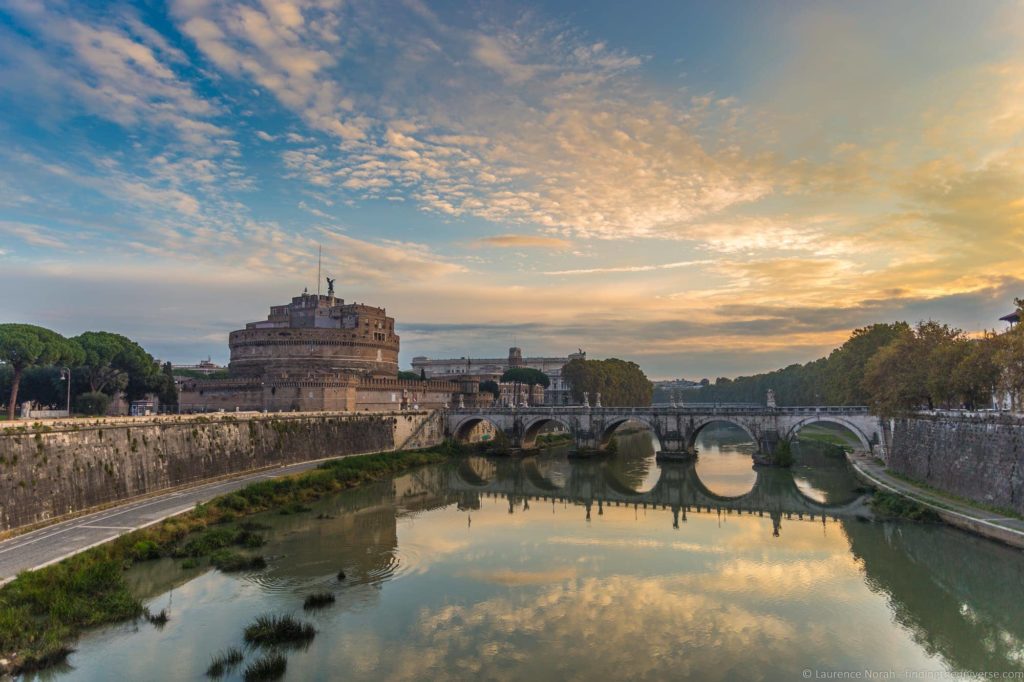
Originally constructed as a Mausoleum for the Emperor Hadrian and his family, when it was built this was the tallest building in Europe. It is still Hadrian’s tomb, but over time has played many different roles, including that of a fortress and a castle.
Today it’s a museum, and you can visit and marvel once more at the engineering brilliance of the Romans, for whom the term “planned obsolescence” would be anathema. The view from the top is worth the trek up, and you can also see the tomb of Hadrian of course.
There’s a fee to enter the Castel. Holder of the Roma Pass get free or discounted entry – more on this at the end of the post. The Castel is open every day from 9am – 7.30pm with some holiday exceptions – see more here .
You can buy tickets in person or from the official ticket site here . You can also buy tickets from GetYourGuide here or from Tiqets here . It’s always worth comparing as prices vary.
Piazza del Popolo
A short walk across and along the Tiber River will bring you to the Piazza del Popolo. This was once the northern edge of the city of Rome, and was the first part of the city that many travellers would have seen when arriving here – particularly in the 17th and 18th centuries.
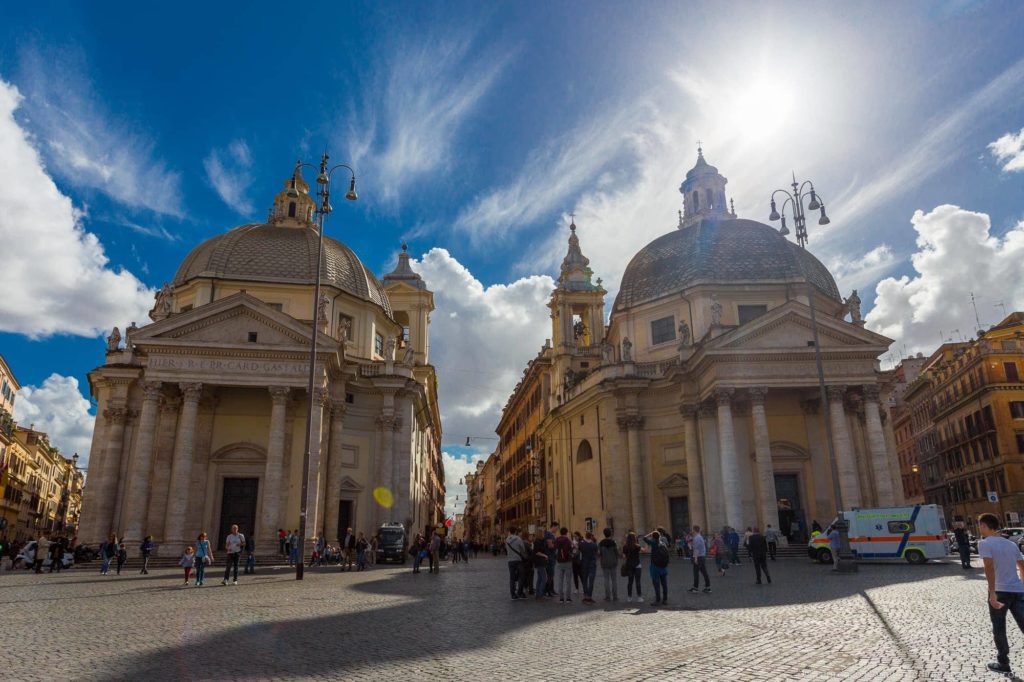
The square, whose name means “People’s Square”, is home to one of Rome’s ancient Egyptian Obelisks, as well as the two 17th century churches of Santa Maria dei Miracoli. It’s a nice place to get a coffee or a bite to eat, before heading on into the rest of our itinerary.
Spanish Steps
From the Piazza del Popolo, three roads span out into the city, and exploring these on foot is always a highlight of our trips to Rome. If you take the left-most road looking south, the Via del Babuino, it will lead you to the Spanish Steps, another iconic attraction of Rome.
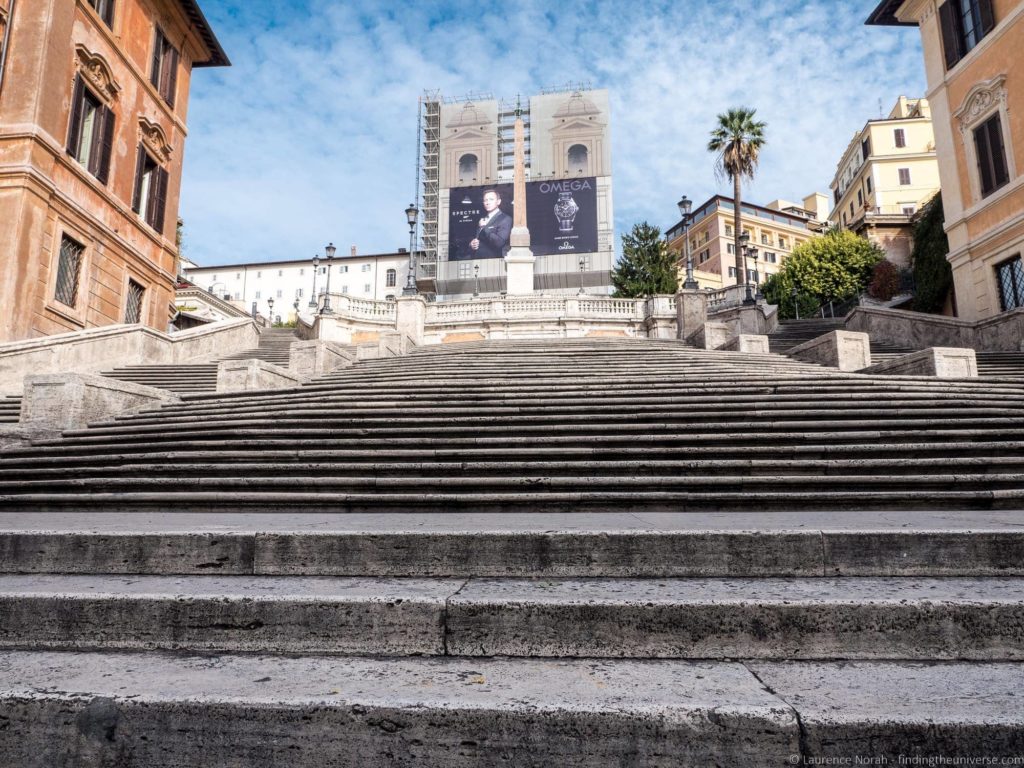
These impressive steps, which lead from a fountain at the base up to a church at the top, were opened in 1725, and have long been a popular place for visitors to see. They were made particularly famous in 1953, when the film Roman Holiday (starring Audrey Hepburn and Gregory Peck) featured them.
The name, in case you were wondering, is because the Spanish embassay to the Holy See is located on the square at the base of the steps, known as Piazza Spagna, or Spanish Square.
The steps are free to visit, and a photo of you standing on them (ideally eating gelato), is pretty much a must when visiting Rome!
Note that as of August 2019 , it’s no longer permitted to sit on the Spanish Steps as they have been classified as a monument, and there is the potential of being fined if you do so. So stick to standing on them instead!
Museums and Crypt of the Capuchin Friars
Moving on to a slightly off-beat sight now, but one we think you might appreciate. The Museum and Crypt of the Capuchin Friars, found under the church of Santa Maria della Concezione dei Cappuccini, is home to a unique display, quite unlike anything else you’ll see in Rome.
In five rooms, the bones of the monks of the Capuchin order are on display, arranged into various forms. It’s definitely unique, and with around 3,700 monks making up the display, is certainly going to remind you of your mortality. Out of respect, photography is not allowed here.
It’s also worth noting that the Catholic church is keen to stress that the display is not meant to be macabre – rather, it is a reminder of our own mortality, and how short our time on earth is. There’s a small fee to visit, which we think is well worth paying.
Chiesa di Santa Maria della Vittoria
Just around the corner from the Museum and Crypt of the Capuchin Friars is the Chiesa di Santa Maria della Vittoria. This church, dating from the 17th century, is famed for it’s sculpture by Bernini – the Ecstasy of Saint Teresa, which is definitely worth popping in to see.
If you are particularly interested in art, then instead of the previous two attractions, you might want to head instead to the National Gallery of Ancient Art , found in the Palazzo Barberini. This is home to one of Italy’s most important collection of paintings.
It’s been a long couple of days in Rome, and somehow we’ve not mentioned one of Rome’s most famous foods – gelato! The Italian version of ice cream is a must when visiting the city, but it’s hugely important that you only eat the good stuff.

Thankfully, we’ve already done the research for you, and put together a guide to the best gelato in Rome . Conveniently, our favourite gelato spot in Rome falls right at the end of our second day – Come il Latte.
The gelato here is deliciously creamy and absolutely fantastic – we can pretty much guarantee it was worth the wait!
If you are looking for something a bit more hearty to finish your day off with, you might also consider taking a food tour. We have a guide to our favorite Rome food tours that you might find helpful if that sounds interesting to you.
2 Days in Rome: Rome Map
To help you visualise our suggested itinerary for 2 days in Rome we’ve added all the sights above to a map.
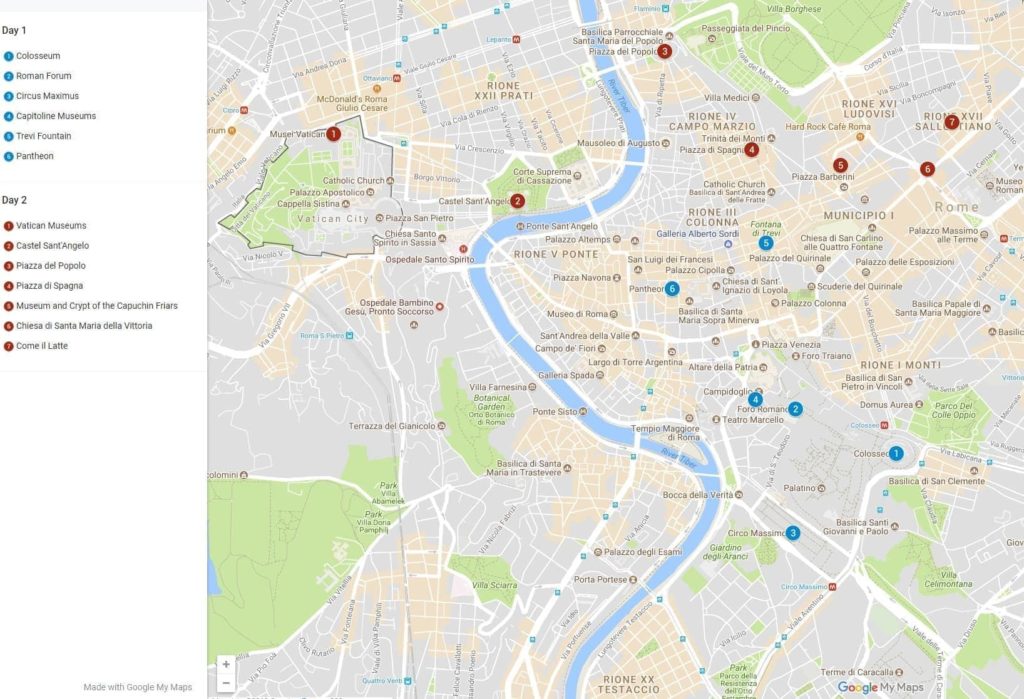
This should also help you plan where you might want to stay. You can also see this on Google Maps here .

Rome Itinerary Overview
To break the itinerary down as an overview:
- Day 1: Colosseum, Roman Forum, Circus Maxima, Capitoline Museums, Trevi Fountain, Pantheon
- Day 2: Vatican Museums, Castel Sant’Angelo, Piazza del Popolo, Spanish Steps, Museum and Crypt of the Capuchin Friars, Chiesa di Santa Maria della Vittoria, Come il Latte
When to Visit Rome
We have visited Rome at a number of different times of year, and it is certainly a city that can be visited at any time of year.
In summer just be aware that it can get very hot and very busy, as this is the busiest time of year in the city.
We’re not saying don’t go – you might just need to plan ahead and make sure you get all the necessary skip the line tickets so you can make the most out of your two days in Rome.
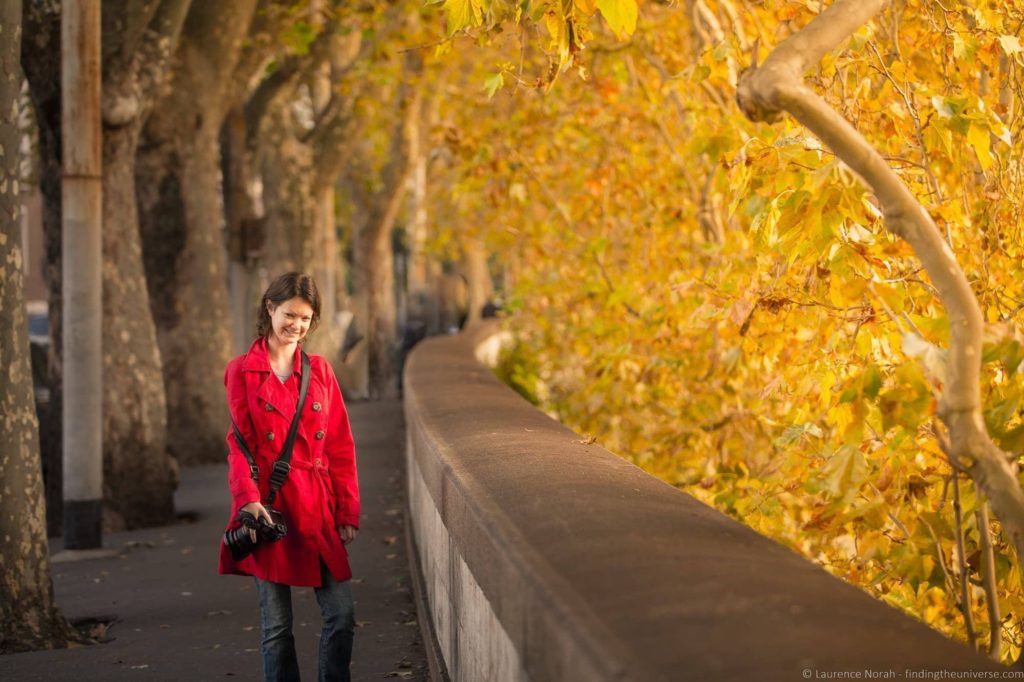
If you have flexibility, we think the shoulder seasons can be a really nice time to visit – between April and June, and then late September through to the end of October.
The weather in Rome at this time won’t be quite so fiercely hot, but you’ll still have plenty of hours of daylight and enough warmth to make it a pleasant experience.
Winter is also a good time to visit Rome. You’ll need to bring warmer clothes of course, but Rome tends to experience fairly mild winters with snow being very rare in the city. It’s also a much quieter time of year to visit.
Where to Stay in Rome
For a two day visit to Rome, we’re going to suggest a hotel (or hostel, depending on your budget!) is likely going to be the best option. Whilst we love the convenience of an apartment when we travel, we find that for shorter trips, the full service convenience of a hotel is going to be a better option.
One reason we love staying in an apartment is the flexibility it gives us for things like cooking for ourselves, doing laundry and having a space to work, but with only 2 days in Rome, we don’t think you’ll be doing any of those things!
In terms of location, we would definitely suggest picking somewhere central – so basically the area between the Rome train station (Termini), and Piazza Popolo in the north, and Piazza Navona in the west. This will put you right within walking distance of the main attractions in Rome, as well as close to hundreds of fantastic eateries and cafes.
For some options close to the historical city centre and all the sights in our itinerary, consider the following. These are ordered approximately by price, from low to high, but do always check prices for your dates as they can vary.
- The RomeHello – found just a few moments from Rome’s Termini Station, this hostel features a range of room types, from dormitories to private en-suite rooms. There’s free WiFi, fantastic reviews, and it’s a great value option.
- Orsa Maggiore Hostel – just across the river in Rome’s trendy Trastevere district, this female only hostel features a range of room types including dormitories and private rooms.
- Di Rienzo Pantheon Palace – a very well reviewed guesthouse option in the heart of the city, just moments from the Pantheon and other attractions. The building is a 16th century property, and rooms feature en-suite facilities, free wi-fi and breakfast
- The Mimosa Pantheon Hotel – right next to the Pantheon, and therefore well placed for the city’s attractions, this is a well reviewed good value 1* hotel. Rooms feature private bathrooms, air conditioning and free WiFi. A solid budget choice.
- The Navona Theatre Hotel – just five minutes walk from Piazza Navona, this is a very well rated 3* hotel within easy walking distance of most of Rome’s main attractions
- The Hotel Navona – another well reviewed 3* hotel in central Rome near Piazza Navona. This hotel is in a restored 15th century building which features restored original frescoes. Rooms have en-suite facilities, air conditioning and free WiFi
- Hotel Valentino Palace – a fantastic mid-range 3* property, just 150 yards from the train station
- Gioberti Art Hotel – 50 yards from Termini Station, a well rated excellent value 4* hotel
- NH Collection Palazzo Cinquecento – Good value 5* hotel just a few steps from the train station
Of course, this is just a small idea of what is available! For examples, here’s a well rated hostel and a fantastically located apartment .
When we travel we usually use Booking.com as our first port of call for accommodation. They have everything from hostels to apartments to hotels . The review system makes it easy to pick a good option, and they have an excellent cancellation policy.
If you prefer an apartment, then we recommend either Plum Guide or Vrbo .
Plum Guide carefully curate their listings so their options tend to be of a very high quality whilst still being available at a range of price points. We’ve stayed at a number of their properties around the world, and you can see our review of the Plum Guide here . See their listings for Rome here .
If you can’t find what you want from the above choices, or you want some new options to try out, we wrote a whole post on the best alternatives to AirBnB which you should check out!
We also have a page full of travel resources, which includes our tips for getting the best deals on accommodation, which you can find here .
How to Save Money and Time in Rome
As with many of the cities we’ve visited and written about, Rome has a number of options for saving money (and time!) on your visit, particularly when it comes to sight-seeing.
There are three main attraction passes for Rome that we recommend for a two-day visit. These are:
- The Rome Tourist Card .
- The Roma Pass
- The Omnia Card
There is also the Omnia Rome and Vatican Pass (which just combines the Roma Pass and Omnia Card), but this is only available for three days.
If you were visiting Rome for three days or more we would recommend considering the Omnia Rome and Vatican Pass , which includes the Roma Pass, however we don’t think it’s cost effective for two days.
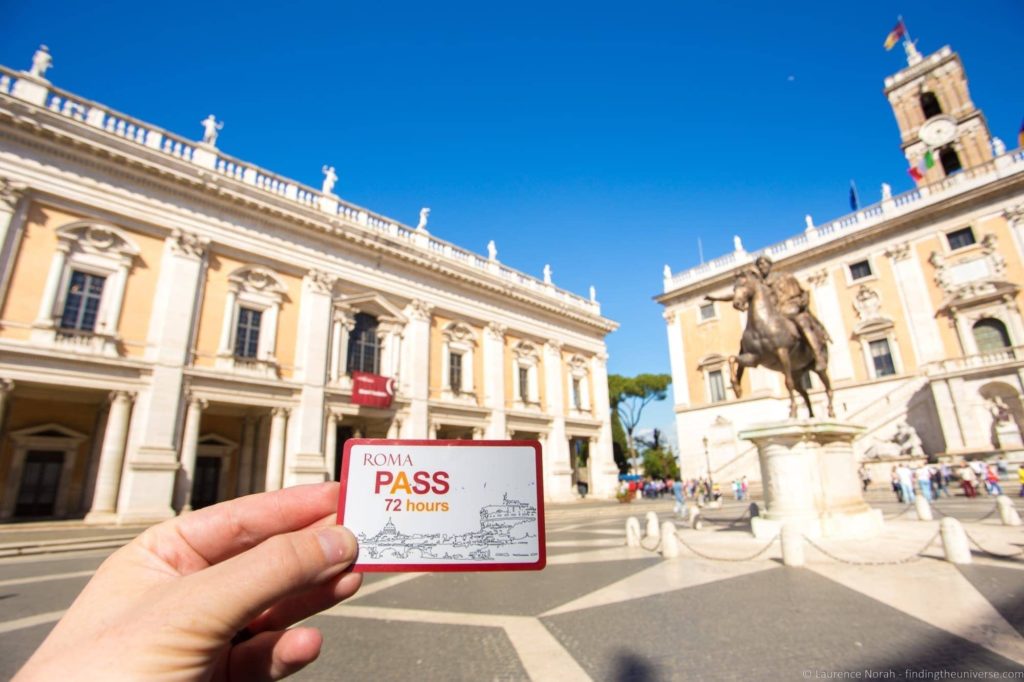
As previously mentioned in this post, Rome is a popular destination, and the lines at the major attractions, especially the Vatican Museums, St. Peter’s Basilica and the Coliseum can get quite long.
You definitely don’t want to spend your time in Rome standing in line if you can help it, especially if you are only in Rome for two days!
So your options are to pre book entry for the popular attractions, to take a tour that includes entry (we recommend Take Walks and Context Travel, see below for specific tours we recommend), or to pick up a pass that includes entry and fast track access.
The first pass we recommend you consider is the Rome Tourist Card , which includes pre-booked fast-track entry to the Colosseum, Vatican Museums & St. Peter’s Basilica, as well as some audio guides and discounts on other attractions. This card is very convenient and removes most of the hassle involved in booking attraction entry.
Another option to consider is the Roma Pass . This is available for either two days or three days . It also includes free public transport in the city. However it is a bit more complicated to use.
The way the Roma Pass works is that you get free access to the first attraction you visit with the 48h pass, and free access to the first two attractions you visit with the 72h pass.
Once you’ve used your free entries, you get discounted admission at the remainder of the attractions you visit, which includes a wide range of attractions across the city.
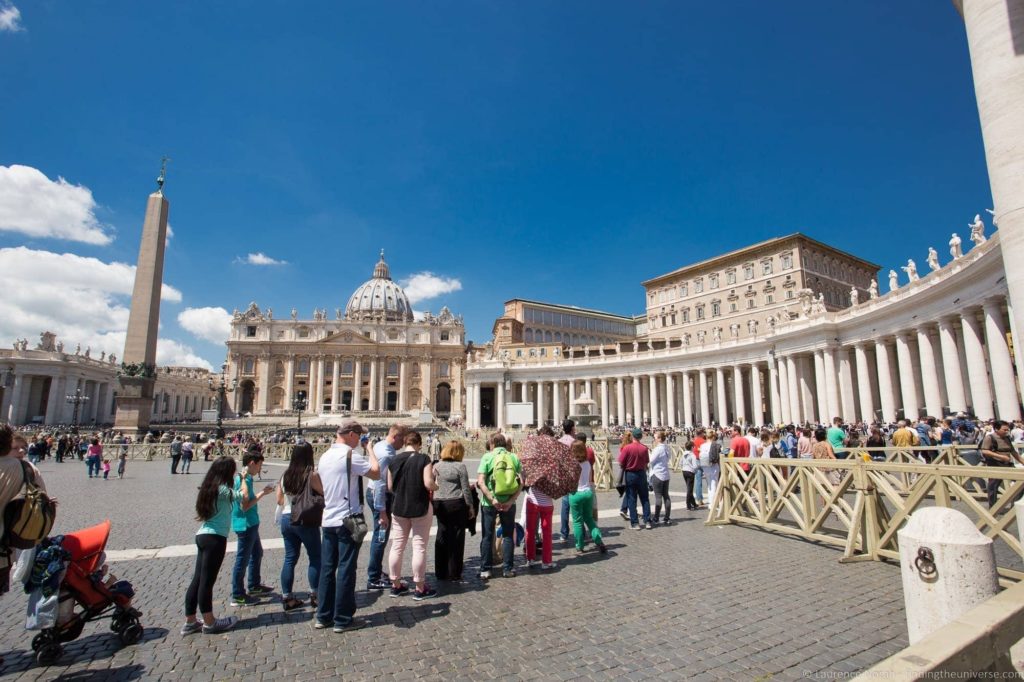
Based on our itinerary, the two day Roma pass would get you free skip the line access to the Coliseum and the Roman Forum (these count as one attraction), after which you would get discounted entry at the majority of other attractions on the list. If you picked up the three day pass , you would also get free entry to the Capitoline Museums as well.
The only disadvantage of the Roma Pass is that it doesn’t include the Vatican attractions, so you’re still going to be queuing for those. So you have a few time-saving options.
First, you can book a tour like this one or this one which includes the Vatican and St. Peters. Or you can book separate skip the line tickets or tours for the Vatican and St. Peters in advance. Finally, you could invest in a 1 day Omnia Card .
The one-day Omnia Card lets you skip the line at the Vatican, plus a hop on hop off bus tour is included, making it easy to get from the Vatican to the other sights in Rome.
The main disadvantage is that it does not, as of March 2023, include any kind of skip the line access to St. Peter’s Basilica, which is a definite disadvantage. At busier times of year the lines can be hours long, so this is definitely an issue.
Overall therefore, we think the best option is the Rome Tourist Card , or booking individual tickets / tours for attractions.
Whatever you choose to do, we highly recommend you come up with a plan in advance.
In summary: Our preferred suggestion would be the Rome Tourist Card OR a Roma Pass and a walking tour of the Vatican / St. Peters that comes with skip the line access
If you don’t want to do any of those, then you definitely will want to book your tickets for the most popular attractions online in advance.
How to Get Around Rome
For the two days on this Rome itinerary, the easiest way to get around is going to be by foot. The centre of Rome is very easy to get around on foot, and we think that seeing Rome this way is definitely a highlight of a visit to the city.
You’ll just keep stumbling across beautiful old cobbled streets, old churches and buildings, and hidden little restaurants and cafes.
Of course, there’s an extensive and easy to use public transport system in the city as well. If you invest in a Roma Pass this includes free public transport for the duration of the pass, so you can hop on and off buses or metros as you wish.
How to get into Rome from the Airport
Rome has two major international airports that you might fly into – Rome Fiumicino (FCO) and Rome Ciampino (FCO). Flights from the North America usually arrive at Fiumicino, whilst flights from Europe may arrive at either.
It’s easy to get into central Rome from either airport.
From Rome Fiumicino, you can take the train, bus, or taxi. There’s a train station on site which will get you into the city centre in around 30 minutes to an hour. Prices range from €8 – €14, depending on if you take the fast Leonardo Express or the local train services (FL1).
Note that the local train service (FL1) does not go directly to Termini – it goes to Rome Trastevere, and then you would need to change onto the FL5, which you can take to Termini.
There are also a number of bus options which cost €6 – €8, and which take around 50 minutes to an hour, and take you to Termini train station. There’s also a taxi stand. You can also arrange either a shared shuttle or a private transfer service , which needs to be booked in advance.
From Rome Ciampino, there’s no on-site train station, but there is a local train station just five minutes away by bus. This train costs around €1.50. There are also buses from Ciampino, which also cost €5. Ciampino also has taxis, although as this is a smaller airport there are generally fewer available. You can also book a shared shuttle or private transfer service in advance .
Both airports also have private and shuttle transfer options that you can book in advance.
Where to Store Your Luggage in Rome
It may be that on the day of arrival or departure in Rome, you might need to leave your luggage somewhere.
Usually your hotel or apartment will have left luggage facilities, however, if this isn’t the case (often the case with apartment rentals for example), you will definitely want somewhere to leave your luggage for the day while you sightsee.
Many of the attractions in Rome won’t let you take bags in with you, and even those that do will likely require you to do additional screening.
As such, we’d recommend you leave your luggage behind so you can explore without being weighed down. We’d suggest this luggage service , which has locations at Termini station as well as the Pantheon and other parts of the city.
We also suggest checking out Nannybag , a service which has storage points across Rome.
Should You Take a Tour in Rome?
Of course, this is up to you and your style of travel! We think that because Rome has so much history and there is so much you can learn on a visit, that taking a tour can be a really great way to do that. Some of the tours can also get you exclusive access to locations that you might not otherwise have been able to see, as well as skip the line access that can save you time.
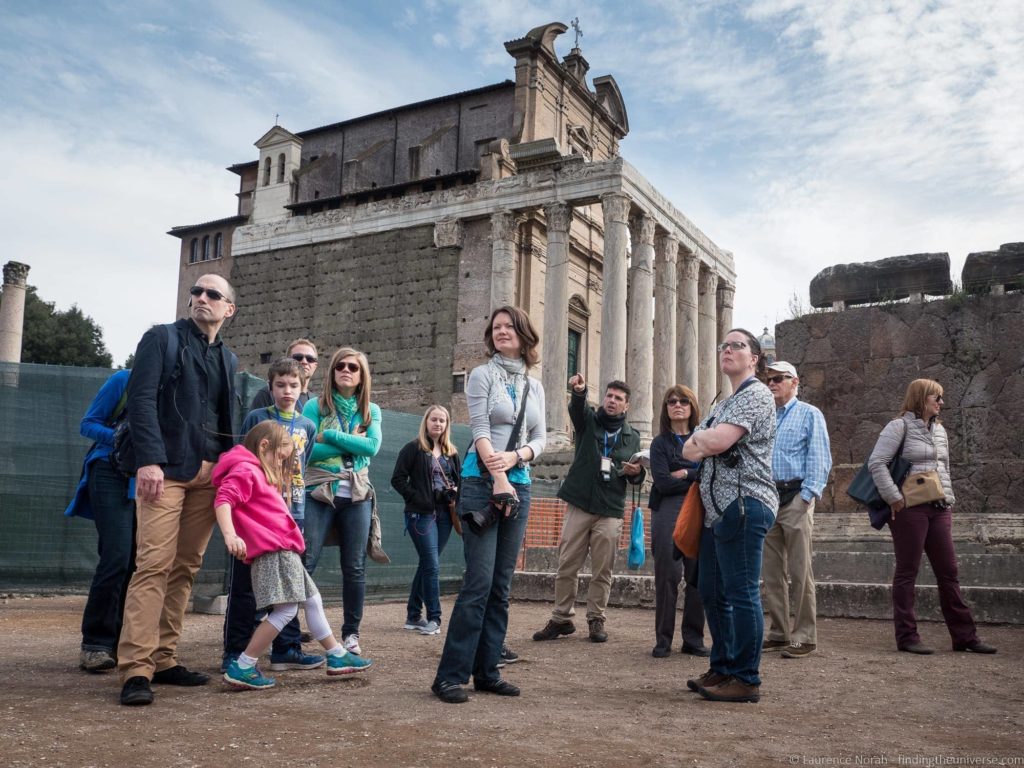
The three companies that we’ve used in Rome for walking tours (and many other cities around the world) are Take Walks , Devour Tours , and Context Travel . For Context Travel, you get an automatic 10% discount on any booking through any of the Context Travel links in this post.
The tours we’d recommend in Rome based on our itinerary are the following:
- Take Walks: Introduction to Rome tour
- Take Walks: Skip the line Colosseum Tour with Roman Forum & Palatine Hill
- Take Walks: Early Entry Sistine Chapel / Vatican Museum & St. Peters tour
- Devour Tours: Trastevere Gourmet Food and Wine tour
- Context Travel: Roma Antica Tour (Coliseum & Roman Forum)
We think that these are the best tours to match up with our itinerary, but of course these companies have many more options depending on your specific interests. You can read some of our experiences taking tours in Rome with both of these companies, Context Travel here , and Take Walks here .
We’ve written fairly extensively about our tours with these companies in Rome, and I link to these reviews in the further reading section below to help you decide if these are going to be good options for you.
There are of course other options for tours in Rome, including all the tours on this page , which offers a variety of things to do from different providers. This one in particular of the Vatican and St. Peter’s Basilica is a good value option.
So definitely check out the options to figure out what is best for you!
How Long to Visit Rome for?
This itinerary is for two days, which we think is a good amount of time to experience the highlights of the city. Certainly, spending a weekend in Rome will let you see everything you want to see as a first timer.
That said, you definitely won’t run out of things to do in Rome if you stay for longer. An extra day or two will let you visit some of the lesser visited attractions, as well as those attractions like the Appian Way which can take up a bit more time.
If you have longer, you can also take advantage of some of the day trips you can take from Rome, which I outline below.
Where to Go After Rome?
We’re often asked where to go after Rome, and our advice on the best way to get there.
We suggest that if you want to explore Italy a little bit further you should head to the relatively nearby cities of Florence and Venice . You could also head to Naples to see Pompeii, or head to the Amalfi coast.
Check out our suggested itinerary for 10 days in Italy for more inspiration and planning advice.
The easiest way to get to the majority of these locations is to take the fast train service. These run frequently and are very quick. Tickets are cheapest when booked well in advance, plus booking in advance will usually guarantee a seat reservation.
You can book train travel in Italy (and Europe in general), on our recommend train ticketing site: Trainline.com .
Another option if you would rather base yourself in Rome and don’t want to worry about booking train tickets, is to take a day tour from Rome. Some options from Rome include:
- This day tour to Tivoli where you can visit Hadrian’s Villa and Villa D’Este
- This day tour of Tuscany
- This boat-Hopping day tour of The Amalfi Coast from Rome
- A day tour to Venice
- This day tour of the Tuscan countryside
- This day tour to Pompeii and the Amalfi Coast
As you can see, you have plenty of options for your adventures from Rome!
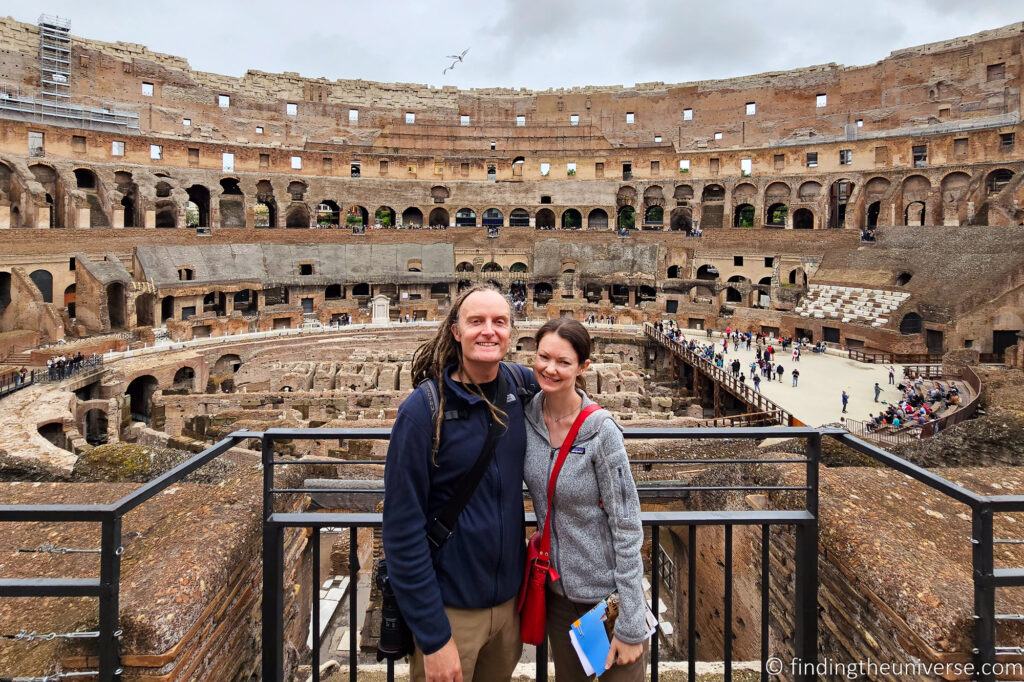
Further Reading for Your Rome Visit
We’ve written a number of posts and guides to visiting Rome, as well as Italy and Europe in general, that we think you will find useful. We also have a number of go-to guidebooks and other resources that we think you will find helpful for planning your time in Rome.
- If you have longer in the city, or are just looking for more options for what to do, take a look at our guide to spending 3 Days in Rome . We also have a guide to spending just a day in Rome , as well as well as things to do in Rome .
- If you’d prefer to take more of a guided visit to Rome rather than plan your trip yourself, we have a guide to doing just that here .
- If you are particularly interested in visiting the Borghese Gallery, one of Rome’s most popular museums, we have a guide to visiting the Borghese Gallery here.
- We have a detailed guide to the Colosseum to help you plan your visit.
- No visit to Rome is complete without eating gelato! To be sure you get the best stuff, take a look at our guide to finding the best Gelato in Rome .
- We also have a guide to where to find the best coffee in Rome , which also includes tips on how and what to order, as well as tips on saving money on your espresso shot!
- Speaking of food, we have a guide to our favorite Rome food tours here .
- If you’re planning on visiting Rome in summer, read our tips for visiting a European city in summer to stay sane
- Looking to visit more of Italy ? Check out our content on Venice , Milan and Florence for inspiration!
- We also have a detailed 10 day Italy itinerary to help you plan a trip in this wonderful country
- If you’re looking for a physical (or Kindle!) guidebook, we recommend the Rick Steves Rome guide , which has lots of practical information to help you make the most of your stay
And that’s it for our guide to how to spend 2 days in Rome! We hope you found it useful – as always, if you have any questions or feedback, just let us know in the comments below!
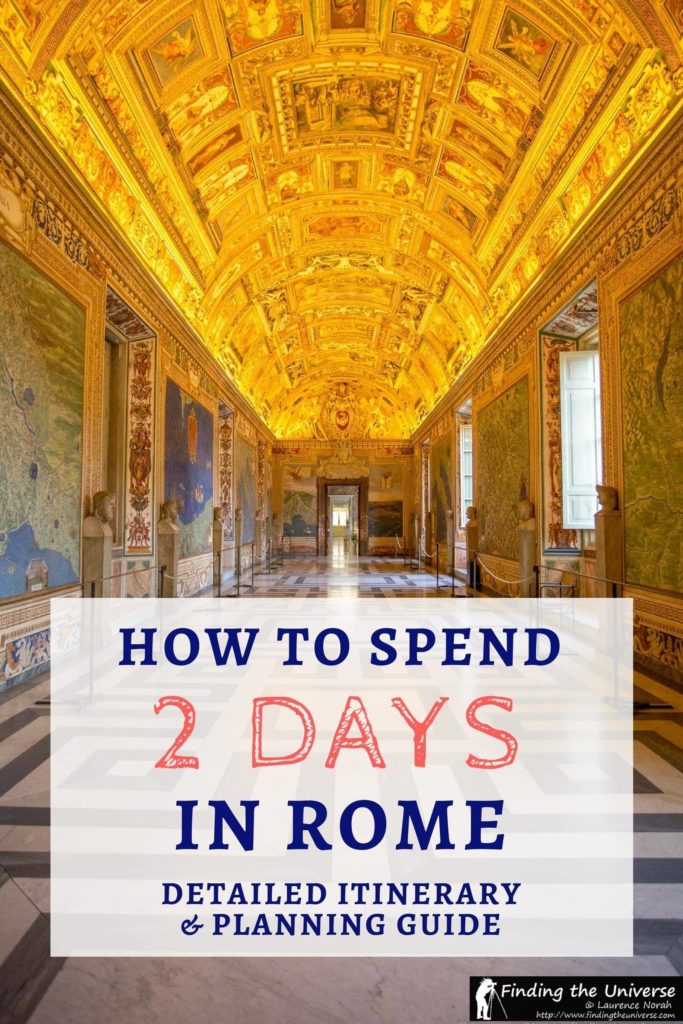
Enjoyed this post? Why not share it!
There are 35 comments on this post
Please scroll to the end to leave a comment
jeannette Carlile says
10th January 2020 at 11:57 pm
Going to a Sorrento in July for four nights and hoping to take in Rome (and possibly Venice) before hand. Fly into Rome and out of Naples from UK. Your two day guide for Rome looks just what we are looking for and will follow it very closely. A high speed train trip to Venice looks promising the day before we leave for Sorrento. I’m experiencing difficulties trying to see trains on the trainline link, saying no trains??, any idea what the issue is or are other sites available please?.
many thanks
Laurence Norah says
11th January 2020 at 11:06 am
Hi Jeannette,
Sounds like a lovely trip. Sorry to hear about the difficulties you are having with the trainline website. I just tried it for a trip from Rome to Venice and it brought back a number of results. Is this the journey you are trying to make? When using the site you definitely want to make sure it autocompletes the station, Rome is Roma Termini and Venice is Venezia. If this isn’t the journey you are trying to make let me know. You could also try either ItaliaRail or Trenitalia .
Happy to help out further if you let me know the route and dates 🙂
Cláudia says
6th November 2019 at 7:39 am
Thank you for the extremely useful information shared throughout the blog. I would like to suggest to include in this post a note referring the Vatican City’s schedule. As one of many people visiting Rome on a weekend getaway, I find it relevant to mention the Vatican Museums and St. Peter’s Basilica are closed on Sundays (except rare occasions). We have followed your program and bought the tickets for the Colosseum for Saturday only to find out later that Vatican City will be closed on Sunday.
Warm regards!
6th November 2019 at 9:02 am
Hi Claudia,
Our pleasure, and sorry to hear about the Vatican. I have updated this post (and our other Rome content) with this information, and to be complete, I’ve also added information on timings to all the other attractions as well 🙂
Thanks for your input, and happy travels!
Danielle says
25th September 2019 at 8:03 pm
I have to say this is the best blog post I’ve read! I can’t believe how helpful it is, so many good tips and links etc so thank you SO MUCH! I am going in 2 weeks and I’m so excited 🙂
25th September 2019 at 9:22 pm
THank you so much Danielle for taking the time to leave a comment. We’re always happy to help out and are thrilled to have been able to help you with your trip planning 🙂 Have an amazing time, and do report back how your trip was 😀
Carole Lamarre says
24th September 2019 at 12:04 pm
Hello, we will be in Rome in October for 2 days. Would the Colonna Palace be worth a visit, as we will be there on a Saturday? I have been to Rome before and saw major sites. Do you know how much time is requiered to visit the palace? Thank you, your blog is very interesting.
26th September 2019 at 10:29 pm
Thanks very much 🙂 So unfortunately we have not personally visited the Palazzo Colonna to be able to give our personal opinion. Certainly, as the largest private art gallery in Rome, if you enjoy art and relatively old buildings, then it should be an enjoyable experience, and likely less busy than somewhere like the Vatican. So it is up to you – sorry I can’t be of more help, but have a great time. if you do visit, we’d love to hear your thoughts!
Carole says
29th September 2019 at 12:55 pm
Thanks Laurence for your quick reply. Your blog is very interesting and it is nice to get a response. I will be visiting the Palazzo.
Reagrds, Carole
Donna Yanitski says
27th August 2019 at 11:53 pm
Hi My husband daughter and I are planning a quick “last minute” trip to Italy. We were hoping to see the Vatican City Colosseum Spanish Steps and Trevi Fountain – with skip the line passes. We will be there 1 1/2 days. Then we are hoping to go to Sorrento via Naples direct. Sorrento as a base where we would like to see Pompeii, Vesuvias, Benadictine Monastery, Positano Herculaneum. Leave flying out of Naples. We have only 8 days from landing to departing. Any suggestions? Thanks
30th August 2019 at 6:03 am
Sounds good to me 🙂 Just be sure to reserve your timeslot for the Colosseum (instructions will be given as part of the pass). Otherwise whilst your itinerary sounds busy it definitely sounds achievable 🙂
Have a great trip!
3rd August 2019 at 7:33 pm
Nice article, good info. Walks of Italy is just “Walks” now. Caesar was assassinated 44BC Colosseum was built 81AD. I would recommend Gallery Borghese before Capitoline museums if you only have 2 days. Tough call! Borghese make your reservation well in advance during high season April- October.
4th August 2019 at 9:15 am
Thanks for the input! I have updated the post accordingly. We know the owners of Walks quite well, and have been watching the slow transition to the new branding 🙂 It probably is time we reflected that in our guides too! We would agree that the Borghese is a better option, but the need to reserve always makes timings challenging on a shorter trip, especially now with the need to reserve for the Colosseum as well!
Thanks again for stopping by 🙂
Karen Brodie says
29th June 2019 at 4:27 am
Good evening.
I enjoyed reading your blog. We are expected in Italy for a few days; 2.5 days in Rome. I reserved the Pristine Sistine and The Coliseum/Roman Forum/Augustus Palace tours through Walk Italy. I want to purchase a “hop on hop off” bus pass so that we can can plan the other sights to see at our leisure: Piazza del Popolo, Spanish Steps, National Gallery of Art, Partheon, Trevi Fountain, and get some Gelato. Can you tell me where to get this pass and if there is an existing map of the bus tour? Thanking you in advance and thanking you for your writings!
29th June 2019 at 8:09 pm
Thanks very much! So there are a number of options for purchasing a hop on hop off bus in Rome. However, I would say that all the places you mention are within an easy walk of each other, so you might find that the hop on hop off bus doesn’t add a great deal of value. There are actually quite a few different hop on hop off buses in Rome. We took the one that came with the Omnia Rome and Vatican Pass as it was included, but you can also purchase them in advance for example on this site . If you want to see some example routes, Big Bus has their routes on their website here:
https://www.bigbustours.com/en/rome/rome-sightseeing-tours/
Matthew miller says
22nd June 2019 at 2:28 am
If we do the 9 to 10 hour highlights tour of rome do we still need to book timed admission to some of the places like Coliseum and Vatican and how can we know what time we will be at those locations if we are on a guided tour? That confused me a bit. We will be in rome july 17 and 18 want to book all this very soon. Do you think we may have issues since we are just 30 days out? Thank you for any advice you can give.
Also for men long pants are preferred for one of the religious tours but will they deny entrance with tasteful short pants on? Thanks!!
22nd June 2019 at 12:51 pm
Hi Matthew,
If you do the guided tour then it will include all of your tickets and times so you don’t have to worry about it.
Shorts are OK, they just have to cover your knees. So you need longer shorts 🙂
I hope this helps, have a great trip!
4th May 2019 at 3:42 pm
Hi I am planning a surprise weekend to Rome for my partner’s birthday in December. We will arrive Friday and then leave Monday with the weekend for sight seeing. Firstly, thank you for such a great post, it has helped tremendously and I don’t feel quite so overwhelmed with sorting everything out now. I was planning to get the 48hr Roma pass so we have the option of transport over the weekend as we will have our 10 month baby with us. But, as we are going in winter and it should be quieter, do you think that the Omni pass or tours would be necessary for Vatican, Sistine etc? It is quite an expense if not needed. Also, is there anything on day 2 that won’t be open on the Sunday? Thanks 🙂
5th May 2019 at 9:42 am
So for December you should be fine. I would just advise booking the Vatican in advance on their website – it costs a little bit more as there’s a booking fee, but I think it’s worth it as the Vatican is likely to be the busiest of all the sights you see. Also, don’t forget to schedule your Colosseum time as every entrance is timed now.
As far as I can ascertain, everything should be open on the Sunday from our list 🙂
Joanne McCabe says
27th January 2019 at 10:58 pm
Hi Laurence & Jessica, Have loved finding your blog, it’s full of great information- thank you! My husband & I will be in Rome on Sun 1st & Mon 2nd June which I now know is not ideal, wondering if you can recommend how we work a two day itinerary around “free Sunday” as it seems Walking tours don’t operate on sundays, was thinking of doing an early morning tour of the Vatican, Sistine chapel etc. which I think we will have to do on the Monday but am at a loss for Monday. Many thanks, Joanne
27th January 2019 at 11:21 pm
So one quick point of clarification – the 1st and 2nd of June is a Saturday / Sunday rather than a Sunday / Monday. So I just wanted to check your dates / days. Also, you are correct, the 2nd of June is a public holiday in Italy, essentially the national day. So on that day many services like tours will not be running.
The Colosseum will be open on the Sunday I believe, however your visit also co-incides with that being the first Sunday of the month, which is when it is free, meaning there can be huge lines to get in.
I guess my advice would be to visit the attractions of Rome which aren’t ever open or closed. So this would be many of the churches, the Trevi Fountain, historical centre, Pantheon (open 9-1 on public holidays) and sights like that. Then you could take one of the full tours on the Monday which has everything in it, like this Rome in a day tour .
Does this help at all?
Joanne says
28th January 2019 at 11:40 am
Hi Laurence, thanks for the speedy reply! My apologies, we arrive late on Sat 1.6 and will have Sun & Mon to sight see. Your suggestion of the Rome in a Day tour makes good sense given the holiday on Sunday. Thanks again, Joanne
28th January 2019 at 11:55 am
My pleasure Joanne, and no problem. We hope you have a great trip!
Tracy Heiner says
20th November 2018 at 1:58 am
We recently traveled to Paris and Rome (October 1st) celebrating our anniversary. We used the 3 day tour recommendation for both cities. I just want to say thank you for the detailed itineraries. While we made a couple of adjustments we felt like we really maximized our time. We can’t wait to go back!
I would highly recommend using the Walks of Italy tours no better way to get an education while seeing some of the most historic sights in the world. Well worth the money.
Thanks again for your efforts in sharing your experience!
Tracy (USA)
20th November 2018 at 12:13 pm
Thanks so much for letting us know that you used our guide and found it useful! It’s always so nice to hear from people that we were able to help out and that the itineraries worked for them. We also agree on Walks of Italy, they’re a fantastic walking company and one we’re always happy to recommend 🙂
Happy travels!
26th September 2018 at 2:09 am
Hi guys! I am from Australia and my family and I are planning to travel to Rome in January. Your blogs are so imformative and helpful! I was wondering if any of the “attractions” close down due to the cold weather? For example, does the Fontana Di Trevi run all year round or do they turn off the fountain in the colder months?
26th September 2018 at 4:43 am
As far as we know everything stays open – temperatures below freezing are very rare in Rome, so this shouldn’t be a problem. Sometimes things close for maintenance, but the Trevi fountain and Spanish Steps both reopened recently after major renovation, so you should be fine!
23rd August 2018 at 10:35 am
Hi! I’ve been to Rome end of July and I saw many things that you suggest here! I have made a video of our 2 days in Rome and I linked your blog, because I like it very much, hope you don’t mind it!! You can find it here: https://youtu.be/fyIEGkWyRHk I would love to hear your opinion about the video!
23rd August 2018 at 11:26 am
Hey Marco, thanks for sharing! Happy that you found our blog useful and of course you are welcome to link to it. The video looks great, looks like you had a fantastic trip 😀
Bailey says
9th July 2018 at 11:32 pm
We are heading to Rome next week and purchased the OMNIA Vatican and Rome Card. I noticed it does NOT include the Dome entrance , Necropolis and Treasury Entrance at St. Peters or the Vatican Gardens. Is that something we can add on once we get there?
10th July 2018 at 11:09 am
You are correct, the Pass features the highlights, for the addons you need to plan separately. Partly this is because some of the tours you mention require separate advance booking, and numbers are limited. Details for everything below:
For the dome access as you enter St. Peter’s Basilica, you head to the right of the main door into the church and the dome ticket booth is there. There’s no way that I know of to get advance tickets for that climb, and I believe it’s cash only. It’s around 10 euros.
Necropolis visits need to be scheduled in advance, as they control these quite carefully to limit numbers. You definitely need to contact them in advance if this is something you want to do, full details are here: http://www.vatican.va/roman_curia/institutions_connected/uffscavi/documents/rc_ic_uffscavi_doc_gen-information_20090216_en.html
For the treasury, the entrance is inside St. Peters Basilica, just follow the signs. You can buy a ticket at the entrance to the treasury.
The Vatican Gardens are like the Necropolis, and can only be visited by guided tour. These also have to be booked in advance. For information: telephone +39.06.69884676 (individuals) or +39.06.69883145 (groups). Bookings can be arranged by faxing +39.06.69885100 or by emailing: [email protected]
I hope this helps! I’d also check the length of these tours as once you’re on the tour you’re not likely to be able to cut it short 🙂
Luxx Press says
24th April 2018 at 1:10 am
wonderful blog! thank you so much for sharing and keep it up!
24th April 2018 at 10:14 pm
My pleasure – thanks for your comment 🙂
travlermb says
22nd April 2018 at 2:41 pm
Here is one of my favorite little know places in Rome (especially if you are into art): St Maria Sopra Minerva Basilica Piazza della Minerva (3 minutes from the Pantheon) It is a nondescript church that has a marble sculpture by Michelangelo called, Risen Christ. It is beautiful work and was once the only sculpture of Christ naked until his privates were hidden behind a bronze loincloth! http://www.basilicaminerva.it
Keep up the good work, I enjoy your posts!
22nd April 2018 at 4:41 pm
Thanks very much, great tip! We haven’t found this spot yet so we’ll be sure to add it to our list for our next visit!
Leave a Reply Cancel reply
Your email address will not be published. Required fields are marked *
Let me know when there's a reply to my comment (just replies to your comment, no other e-mails, we promise!)
Subscribe to our monthly Newsletter where we share our latest travel news and tips. This also makes you eligible to enter our monthly giveaways!
We only ask for your e-mail so we can verify you are human and if requested notify you of a reply. To do this, we store your data as outlined in our privacy policy . Your e-mail will not be published or used for any other reason other than those outlined above.
Let's be friends! Sign up receive our monthly newsletter with updates and new in-depth guides.

4 Days in Rome: How to Plan an Amazing Rome Itinerary
Wondering exactly how to spend 4 days in Rome? Or maybe you have more or less time and you’re trying to figure out how to plan an unforgettable Rome itinerary. Either way, you’re in the right place. We have each been to Rome multiple times – including a full ten days in 2021 – and have put all of our tips, tricks, and discoveries into this guide to help you plan an amazing trip, especially if it’s your first time.
We recently spent three months in Europe – the longest trip we can take on a tourist visa as Americans – and were astounded how often we heard about the Romans as we traveled around Spain and Portugal (not to mention Italy).
Everywhere we went, we found remnants of Ancient Rome, from temples to excavated ruins and city walls. In fact, many Spanish cities like Barcelona were founded by the Romans, though they obviously look very, very different today.
One of the things I find most interesting about Rome is the contrast between the elements of Ancient Roman history, which is perhaps the most well-known empire in human history (at least the most “well-known” in modern times), and the fact that Italy as a nation is relatively young.
One of the youngest in Europe, in fact. Italy didn’t become a sovereign nation until the mid 19th Century despite regions within its current borders being immensely important for two millennia, give or take.
Both Alysha and I have been to Rome multiple times before. In fact, I loved Rome so much after my first trip with family post-college-graduation that I did the exact same trip two years later, this time with friends. Alysha lived in Rome for six months in college, calling the more residential part of Prati, the neighborhood near the Vatican, home.
In 2021, we spent 10 days in Rome, split into two five day visits , and we fell in love with the city all over again. After that trip, we have almost completely re-written this guide to reflect our discoveries on that latest visit in hopes that you, like us, will fall in love with the city that has had such a profound impact on human history.
In this guide to planning your trip to Rome, you’ll find a detailed 4 day Rome itinerary, complete with things to do, see, eat, and drink, along with the important details you need to know like how to see the Colosseum and when to walk around the historic center to get that photo of Trevi Fountain without all the people.
You’ll also find logistics – like how to get around and the best time to visit – that are important for planning your trip.
We hope you enjoy this guide, that you find it helpful for planning your trip, and we help you discover something new and exciting, whether it’s your first time, or tenth.

Disclaimer: Some of the links in this post, like hotel links, are affiliate links, meaning at no additional cost to you, we make a little bit of money if you click through and book. That being said, we would never recommend something to you that we don’t stand behind 100%.
How Many Days in Rome?
Given the amount to do and see in the city, we think that 4 days in Rome is the absolute minimum you should plan for to avoid spending your entire trip running around from sight to sight without time to savor the atmosphere of the city and enjoy the dolce vita that makes Italy so special.
With four days, you’ll comfortably be able to fit in the Vatican, Colosseum, and Borghese Gallery alongside eating pizza and pasta, drinking plenty of wine, and exploring a few of our favorite neighborhoods (and getting some pretty magnificent views of Rome along the way).
Our biggest tip for planning a trip to Rome is to not do more than one major sight (e.g. the Colosseum, Vatican, or Borghese Gallery) on the same day .
Each of those places is going to take a lot of energy, and by the time you’re getting ready to go to the second one, you’re going to be exhausted and the experience isn’t going to be nearly as enjoyable.
If you have two or three days in Rome, it’s still doable. Below the main itinerary, we have our thoughts on how to spend one, two, and three days in Rome to help you plan a trip with less time.
Where to Stay in Rome
There are a wide variety of options in terms of accommodations in Rome, and which you choose is largely going to depend on your style and budget.
Which is why we’ve put together a detailed guide to help you decide where to stay in Rome , which has our favorite neighborhoods along with pros/cons and highlights for each. For more detail, head over and read that.
Here’s the short version.
- Our overall recommendation is to find a charming hotel or guesthouse in Trastevere , which is far and away our favorite part of Rome. Cobblestone streets, energetic piazzas, and some of the best bars and restaurants in Rome? Sign me up! We stayed at Horti 14 Borgo on our last trip, a gorgeous boutique hotel just outside of the center of Trastevere, and really enjoyed it. Especially the breakfast buffet.
- If it’s your first time in Rome , you can’t go wrong with the Centro Storico . Stay at Casa Pietra or Coronari Palace if you’re looking for a hotel or guesthouse. We stayed at these apartments on our latest trip, and they were almost perfect.
- If you’re looking for a slightly different experience , look at Monti , a hip part of Rome that’s near the Colosseum and Forum, and is packed full of bars, restaurants, cafes, and more. It’s a good central location, and generally feels much younger than, say, the Centro Storico.
You can find the long version over in our more detailed guide to where to stay in Rome .
4 Days in Rome: A Complete Guide to Planning Your 4 Day Rome Itinerary
Over the course of 4 days in Rome, you’ll marvel at the achievements of Ancient Rome, see some of the best art collections in the entire world, and delight in what modern Rome has to offer, like great wine bars, restaurants, and more.
Here’s an overview of the itinerary you’ll find below:
- Day 1 : The Colosseum & Roman Forum + Your First Aperitivo
- Day 2 : The Vatican, St. Peter’s Basilica, and Castel Sant’Angelo
- Day 3 : Self-Guided Centro Storico Walk + The Borghese Gallery
- Day 4 : Explore Two of Rome’s Best Neighborhoods
Day 1: The Colosseum & Roman Forum + Your First Aperitivo
Start your day where it all began – in the heart of Ancient Rome. Take the majority of the day to wrap your head around the centuries of history where this little quarter of the city played an outsized role, then spend the afternoon and evening experiencing aperitivo.
The Colosseum and Roman Forum
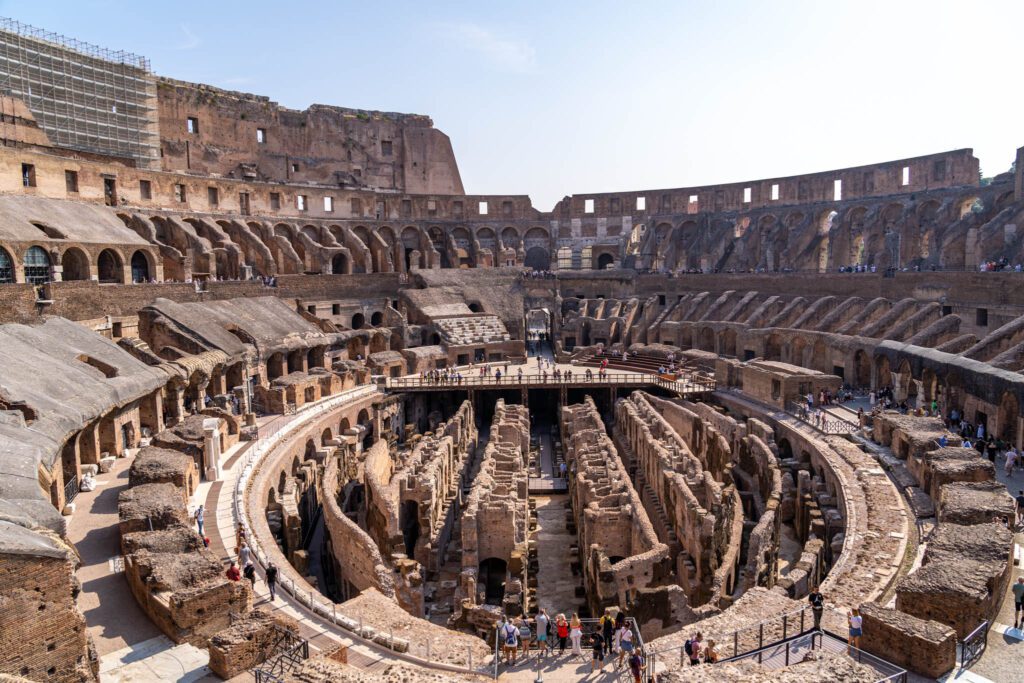
For all intents and purposes, these two sights should be grouped together. They represent similar periods in Roman history, they’re adjacent to each other, and they’re visited on the same ticket or tour.
Before or after your tour, there’s an excellent view of the Roman Forum from OUTSIDE the boundaries located here .
It’s well worth heading up and over the hill to Piazza del Campidoglio (with a replica of a famous Michelangelo statue in the middle) and Piazza Venezia , which houses the Altar of the Fatherland dedicated to Italy’s first king after unification, Vittorio Emanuele II.
The Colosseum (or the Flavian Amphitheater)
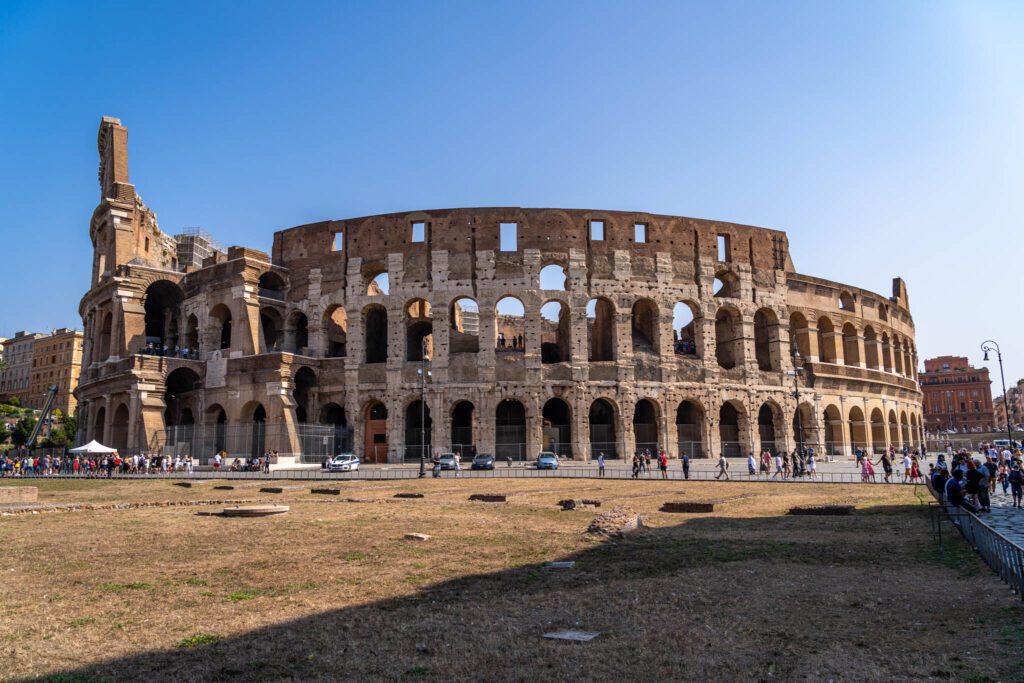
The Colosseum is the massive Roman amphitheater, the most well-known (and biggest) in the world. The structure was commissioned by Emperor Vespasian in 72 C.E. after the area was used as a private palace for infamous (and unpopular) Emperor Nero. It was kind of a gesture to the people that the ruling class hadn’t forgotten them.
Unfortunately, Vespasian didn’t live to see it completed. Instead, it was completed under his son Titus in 80 C.E., taking just eight years to build (which is insane when you consider that some churches take several centuries).
It’s most likely that the building, after some expansions and renovations over the years, could fit somewhere between 40,000 and 50,000 spectators, though you’ll still hear numbers as high as 80,000 thrown around which most historians agree is a little aggressive.
Another misconception about the Colosseum that is mostly perpetuated by media like movies and TV shows is that the gladiatorial games were brutal, bloody, and murderous.
That’s true to an extent, but our guide reminded us that, at the end of the day, the gladiators were highly skilled professionals AND they were the property of rich people who most definitely didn’t want their assets killed.
It’s more likely that the gladiatorial battles were similar to modern-day boxing matches than the bloodbaths you’ve seen Russell Crowe participate in.
They’ve reconstructed part of the wooden floor of the arena, and below that you can see the intricate series of cages, tunnels, and staging areas where gladiators and exotic animals were kept before being brought up onto the stage using an innovative elevator system.
It’s massive, and it’s an incredible feat of human ingenuity. I, Matt, have done the Colosseum four different times now, and each time my jaw hits the floor as you emerge onto the platform around the edge of the arena.
The Roman Forum
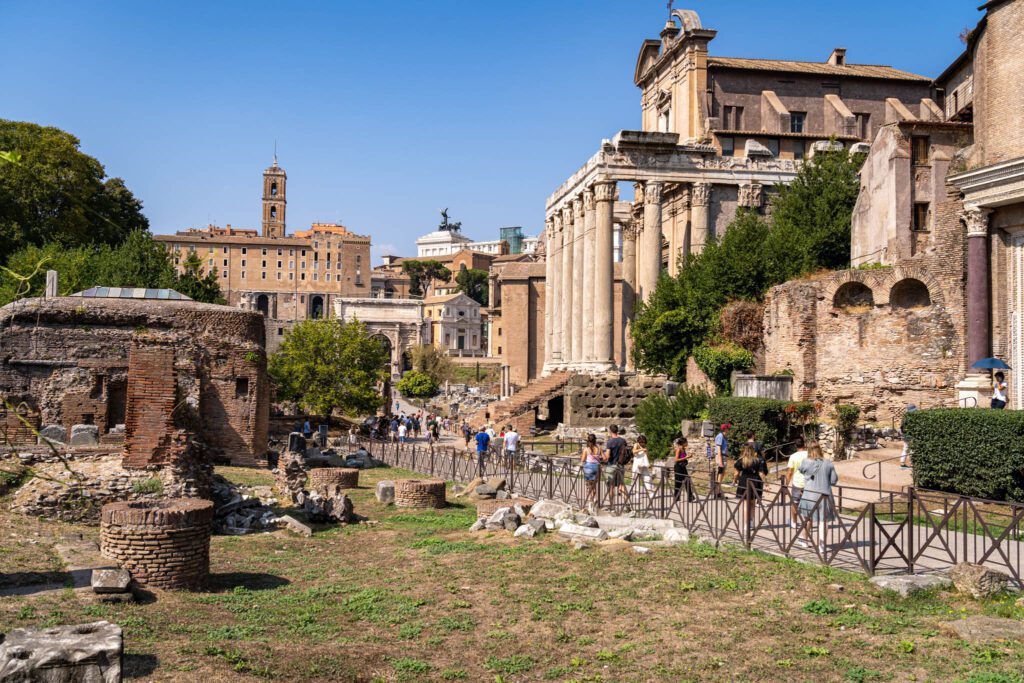
The Roman Forum – known in Italian as the Foro Romano – is a little different than the Colosseum. Unlike the Colosseum, which stands tall and intact (having been rebuilt and renovated over the years), the Roman Forum is mostly ruins.
Which makes it hard to understand what you’re looking at without a guide to help you decipher the difference between the Senate building and the Temple of the Vestal Virgins. Palatine Hill, one of the seven hills of Rome, is just to the southwest and is accessible from within the complex (you’ll find one of the best views in Rome from the viewpoint at the top).
The majority of the important buildings in Ancient Rome were within walking distance of this historic meeting place.
Contrary to popular belief, while there is a temple dedicated to Julius Caesar here, he was actually not killed in the Forum, but over near Largo di Torre Argentina.

How to Visit the Colosseum and Roman Forum
Like I mentioned above, I have done the Colosseum and Forum four different times now – twice with a guided tour, twice on my own – and I can say without a doubt that the Colosseum and Roman Forum are best experienced with a guided tour .
Specifically, a guided tour with someone who knows what they’re talking about, which is exactly what you’re going to get with Walks of Italy.
We did this Walks of Italy tour on this most recent trip to Rome, and we were blown away by the knowledge, richness, and detail that our guide – Dario – brought to the experience for us.
He busted all sorts of myths that we had fully believed to be true, and was able to weave together a cohesive story throughout the three hour tour that had us engaged the entire time.
And keep in mind, we had both experienced it already more than once before!
We highly, highly recommend booking a guided tour for the Colosseum and Forum. If you only have time for one guided tour in Rome, this should be the one.
Especially because the Forum is really just a bunch of crumbled buildings on the surface, and you need the history and context from a guide to really kick your imagination into overdrive and envision how this area might have looked when it was the beating heart of the Roman Empire.
If you’re not quite sure about a tour, read about our experience with the Walks of Italy Colosseum tour .

Visiting the Colosseum and Forum Independently
You, of course, can visit independently. We would suggest purchasing the audio guide, or downloading the Rick Steves audio guide ahead of your visit. It’s not going to be as interactive or interesting as a tour, but it will give you some of the context around what you’re looking at.
Buy your tickets in advance, and as far in advance as possible if you’re coming to Rome in the summer.
For more information and to buy tickets, go to the official website (we’re not giving you exact hours and ticket prices because they do change, and it’s better to just go to the official site to check them in real time).
You’re going to need at least three to four hours to do them both justice. Even in late September, exploring the Roman Forum was HOT. In the summertime, it will be borderline unbearable with very limited opportunities for shade and a brief respite from the sun. Bring plenty of water and sunscreen, you will need both.
Afterwards, take a well-earned break and grab lunch, head back to the hotel and relax, and get ready for a late afternoon walk up to one of the best viewpoints in Rome.
The Orange Garden and Keyhole
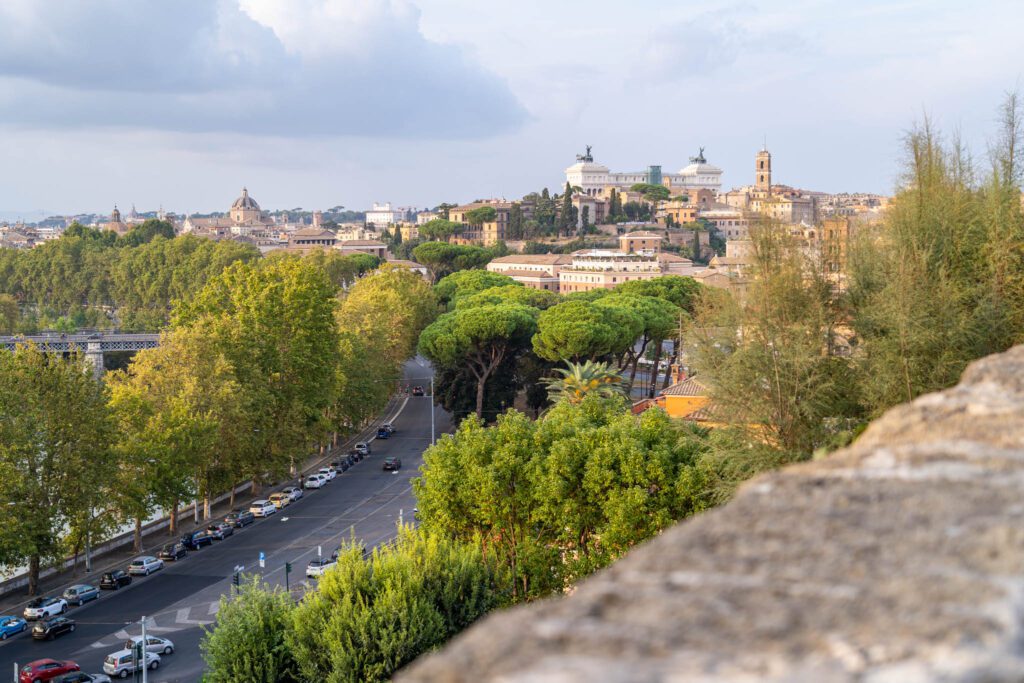
Post-nap, it’s time to get back out there and explore a bit more. This time, head to the Orange Garden ( here on Google Maps) , which is perched on a hill with great views of Rome and the Vatican.
Another worthwhile stop just a few hundred feet away is the keyhole ( here on Google Maps), which is a now-Insta-famous spot where you can look through, well, a keyhole, that has the dome of the Vatican perfectly framed. I say it’s Insta-famous, because if you’re here in peak season in the afternoon, you’re likely going to have to wait in line for the privilege of looking through said keyhole.
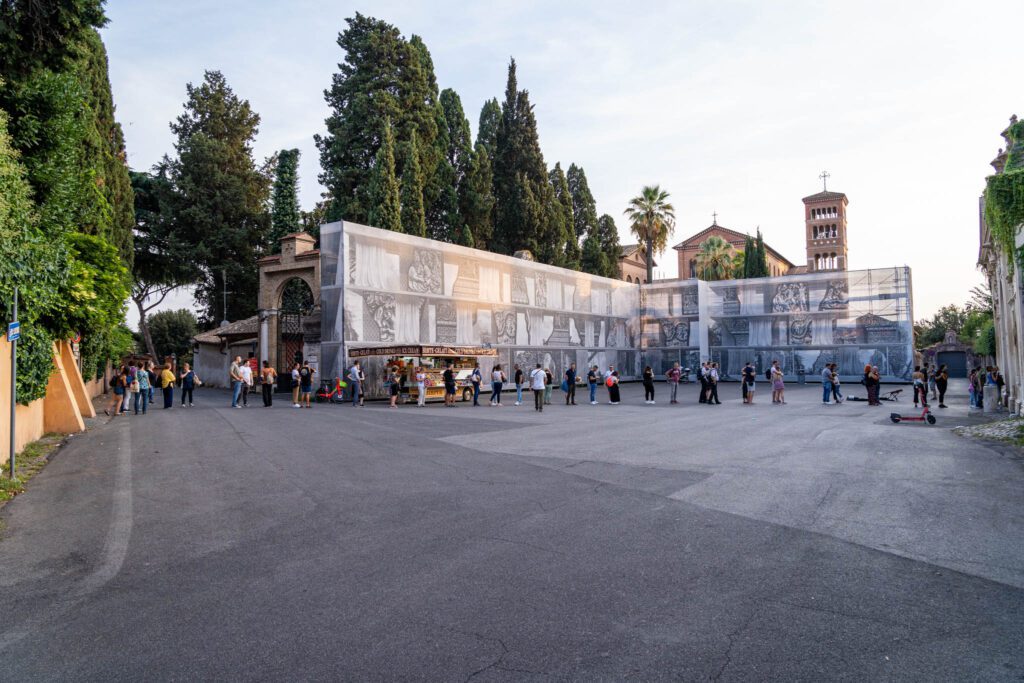
An alternative would be to do this part of the itinerary in the morning before the Colosseum, which is a vastly different experience. Instead of kids and tourists coming up to watch the sunset, the area is packed full of locals walking their dogs. And there was not a single person waiting to look through the keyhole, just us!
Your First Aperitivo
Aperitivo is a period during the late afternoon, between getting off work and dinner time (which is later than you’d expect in Rome) where people go out for drinks. And those drinks are served with a selection of small bites, like bruschetta, olives, and things like that.
If you’re American or Canadian, it’s a little like happy hour, except the food is complimentary with your drinks. While the days of full-on aperitivo buffets are behind us, at least in most of Rome, the idea behind aperitivo is still one of our favorite parts about spending time in Rome.
During aperitivo, our drink of choice (and what you’ll see many people drinking) is the Aperol Spritz. It’s a light cocktail – perfect for a summer day – that is made with sparkling water, sparkling wine (all of the bubbles, please!) and Aperol, an orange-colored bitter aperitif.
The spritz is usually 4-5 Euros (definitely don’t pay more than 6 Euros!), and is the quintessential aperitivo beverage to us. I made the mistake of ordering a Campari Spritz instead, just to try it, and won’t be doing it again. It was fine, totally drinkable if you’re into bitter liqueurs like Campari, but it wasn’t nearly as refreshing.
Anyway, after the orange garden, you’re in the perfect position to head to our favorite aperitivo spot in Rome – Zerosettantacinque – which is near where the Circus Maximus (a huge chariot racing track) used to be, which fits perfectly with the Ancient Rome theme of today.

The location is great, the drinks are good, and they bring you a little selection of bites to go with your drinks (and have a bigger menu of food, if you’re still hungry).
Dinner and Drinks in Monti

After a spritz or two, head into nearby Monti, the hip neighborhood on the northern side of the Colosseum, for dinner.
I say hip because there are multiple record shops and vintage clothing stores on one of the streets, which is a clear sign that the kids hang out there (by “the kids” I’m referring to 20-somethings wearing bell bottom light wash jeans and those glasses with thin wire frames and big lenses that look like Harry Potter’s glasses).
We walked through here a couple of times at various times of day. After dark is, by far, the most lively time to be here.
Grab dinner at either Cimarra Pizza and Cocktails or Al Vino Al Vino , and indulge in your first gelato of the trip at Fatamorgana , one of our favorite gelato shops in Rome with rotating seasonal flavors and fresh ingredients.
P.S.: We loved this piece on how to spot “good” gelato. Spoiler: the gelato with super bright colors that is spilling out of the tubs outside the shop near Trevi Fountain is, unsurprisingly, not the best you can find.
More Rome Travel Guides to Help You Plan Your Trip
- ITINERARY : How to Plan an Amazing Rome Itinerary
- WHERE TO STAY : The Best Places to Stay in Rome
- COLOSSEUM TOUR : Our Favorite Colosseum Tour in Rome (Review)
- GLUTEN FREE : Gluten Free Restaurants in Rome
Day 2: The Vatican, St. Peter’s Basilica, and Castel Sant’Angelo
On your second day, tackle the second world-famous attraction in Rome, the Vatican. Home to the Sistine Chapel and St. Peter’s Basilica, the Vatican is fascinating even if you’re not really religious. It’s an impressive collection of art, with the crown jewel being the Sistine Chapel.
A word on fashion for this day, not because we want to make sure you’re as stylish as possible, but because the Vatican is a religious site. That means your shoulders and knees should be covered up , even if it’s blistering hot in the summer.
Otherwise you may not be able to enter certain parts of the complex, namely St. Peter’s Basilica.
But First, Coffee

Before your trip to the Vatican, head to Pergamino Caffè for some of the best coffee in Rome. I’m a coffee lover, particularly if I get to choose which coffee is used to make my coffee, and this is the perfect place for that.
They have coffee roasters from all over Europe, heavily focused on Italian roasters, and will prepare you a cup of great coffee, whether you’re into lattes or filter coffee.
It’s on the south side of the Vatican, just around the corner from the main entrance to the Museums, which makes it a perfect spot pre-Vatican.
The Vatican and St. Peter’s Basilica
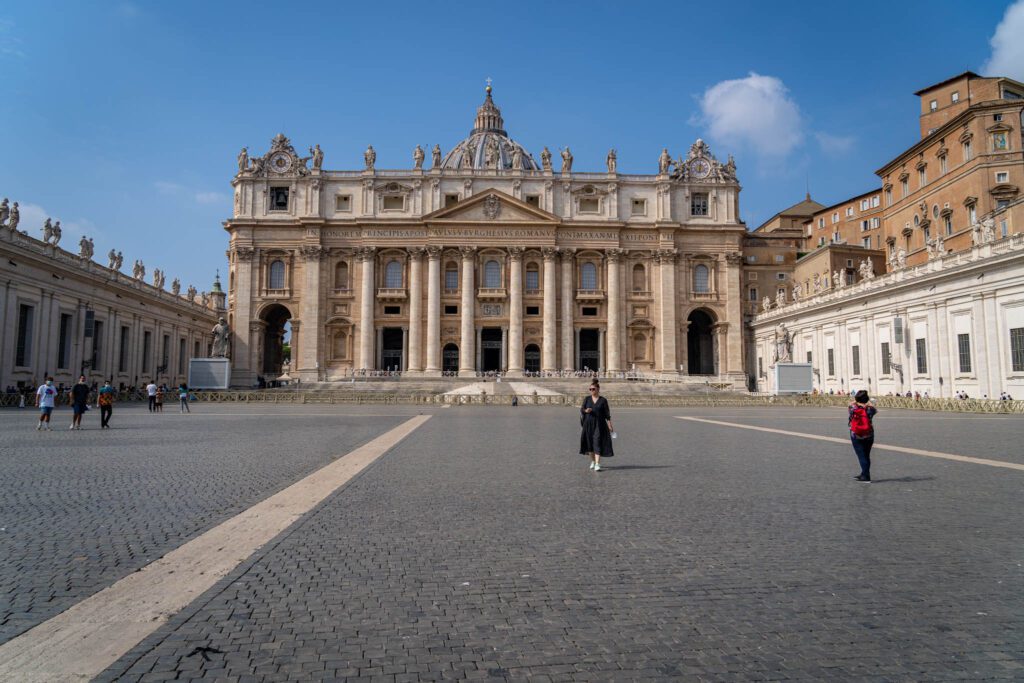
Arguably the most famous museum in the world makes its home in the collections of the Vatican. They show a whopping 20,000 pieces of art and culminate with the legendary Sistine Chapel, where the ceiling frescos bear the work of Michelangelo.
One contradiction that always pops up in the back of my mind when visiting huge, ornate churches has to do with the role of the church.
Why, you might ask, does an organization that preaches the Bible, which unequivocally condemns rich people who do not give away their wealth, have such an ornate and over-the-top display of wealth? Great question to ask the Pope, if you run into him (or her, in case you’re reading this at a time when we’ve gotten a female pope).
As a religious site, I have questions about the Vatican and St. Peter’s Basilica. If you put those questions aside for a second and just consider it as a collection of art, it’s a pretty incredible display featuring a who’s who of Italian art history.
There are essentially two pieces – the Vatican Museums (which include the Sistine Chapel) and St. Peter’s Basilica . You should visit both, and you should try to be either on the first or last tour of the day (obviously, the way we have it written would have you here for the first tour of the day).

Buy tickets here – toggle the site to English with the language selector in the top right.
For the best experience, we’d recommend either picking the tickets that include an audioguide , or, even better, book a guided tour that includes a live guide .
We’d go with the “Pristine Sistine” tour with Walks of Italy (have we mentioned that we really like them?), which gets you into the Museums an hour before they open to the public, when you at least have a shot at experiencing the magic of the Sistine Chapel before it’s packed wall-to-wall with smelly, loud tourists, which can really ruin the vibes.
Lunch in Prati
After the Vatican and St Peter’s Basilica, head into Prati, the neighborhood immediately adjacent to the Vatican, for lunch.
This is the part of Rome that Alysha called home for six months in college (albeit a more residential part of the neighborhood a ways away from the Vatican), and it’s a little bit more upscale and family oriented than other parts of the city center.
However, despite being so close to a tourist attraction – which is usually a bad sign in terms of food quality and value – there are some truly outstanding places to eat here.
If you’re looking for the best pizza-by-the-slice in Rome, go to Bonci Pizzarium , a tiny hole-in-the-wall where you’ll find a daily selection of rectangular pizzas served in rectangular slices, which is different from what you might get in the US. Pizza toppings rotate all the time.
I went here with friends years ago, and unfortunately the whole “gluten free” thing is a major problem in this case, so we didn’t go back this last time.
If you’re sick of Italian food (really? On day two?), we LOVED El Maiz , a Venezuelan restaurant serving arepas, cachapas, and tostones.

We love Venezuelan arepas, and were pleasantly surprised to find them in Rome. The tostones – fried green plantains with toppings – here are spectacular, and were among the best things we ate in Rome. Although the queso cachapa (kind of like a sweet corn crepe stuffed with about a pound of cheese) is delicious too.
Castel Sant’Angelo
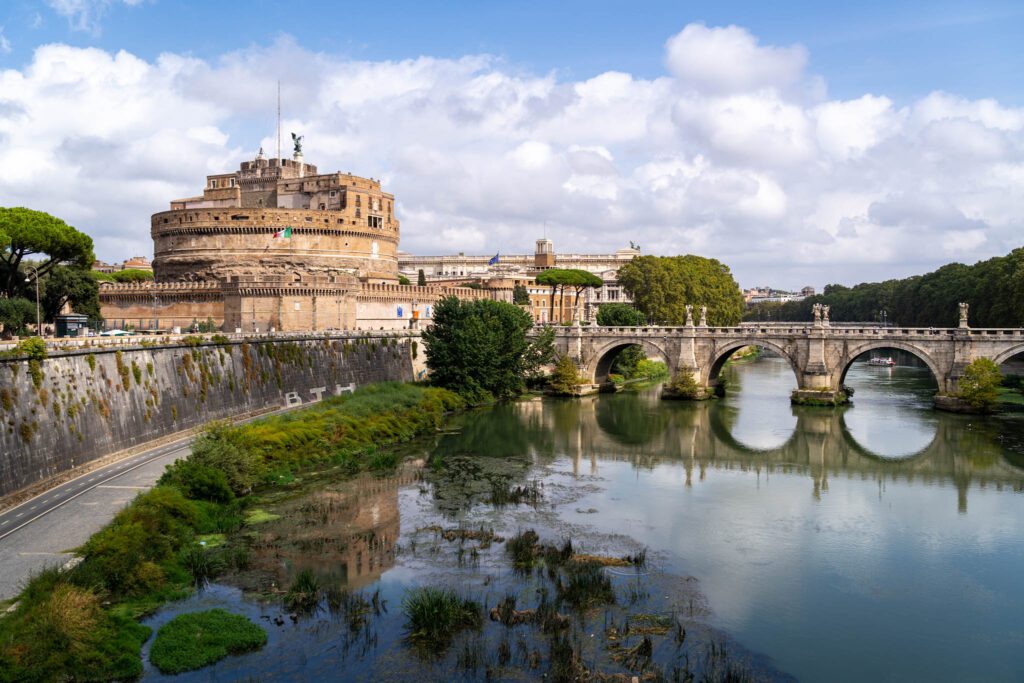
After lunch, make your way towards the river to Castel Sant’Angelo , which is a place that we ordinarily would have skipped, but found ourselves doing on day 8 or 9 because we had plenty of time to fit it in.
It was built by the Roman Emperor Hadrian as a mausoleum, and then the Catholic Church grabbed it and turned it into a fortress. Today, it’s part art museum, part abandoned castle with some cool art installations inside.
It’s a bit expensive to get in – 14 Euros at the time of writing – but we enjoyed it. The best part, by far, is the terrace on top, which has a lovely view of the Vatican.
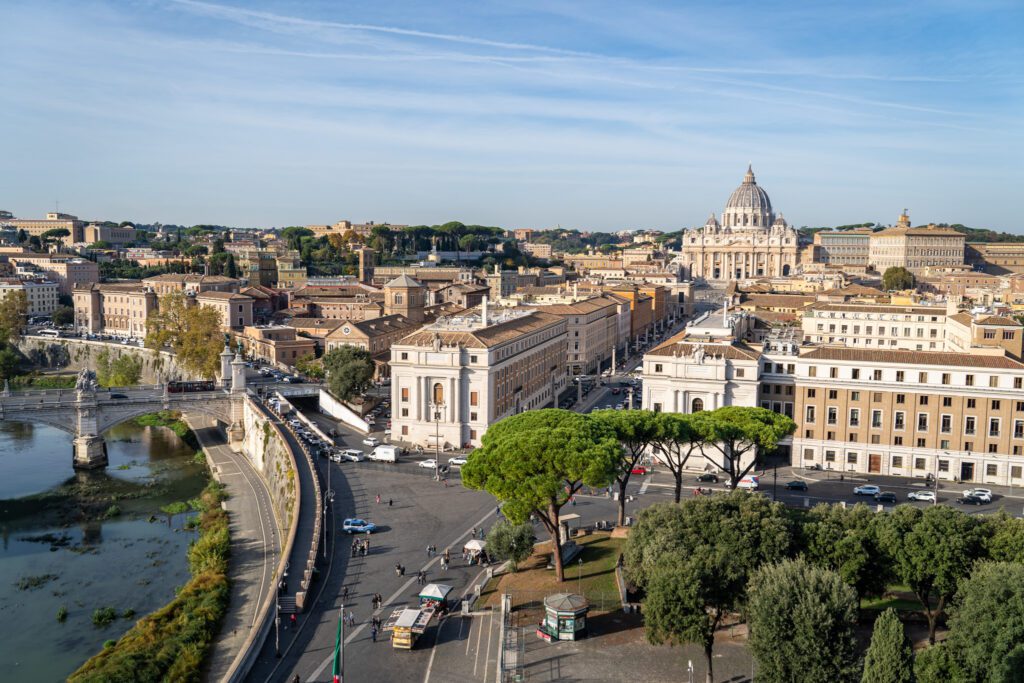
Buy your tickets in advance – especially in 2021 and beyond when attendance is limited. We didn’t and ended up waiting a bit because the timeslot at the beginning of the day was sold out.
The view from the other side of the bridge directly in front of Castel Sant’Angelo is also spectacular. If you decide not to go inside, definitely make sure to head to the other end of that bridge (and give a firm “no, grazie” to all of the people trying to sell you various things as you cross the bridge).
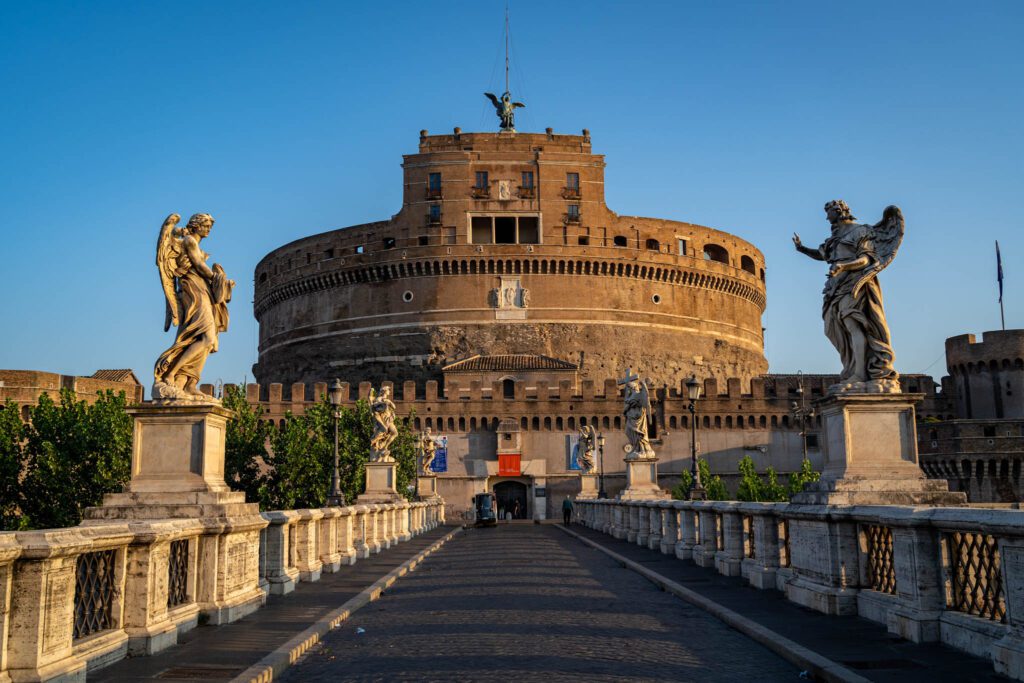
That photo spot is roughly here on Google Maps, and that picture was taken at 8:00 am, before the bulk of the tourists showed up.
Our Favorite Wine Bar in Rome
When in Rome, drink good wine. And our favorite wine in Rome came from Enoteca Il Piccolo , a charming little wine bar in the Centro Storico known for a rotating selection of natural wines from local producers.
Not only was the wine – specifically a pet-nat, lightly bubbly white wine – great, but the experience was unique too! For context, we speak minimal Italian – enough to get by, order food, and pay, but that’s about it.

I attempted to describe, in Italian, what kind of wine I wanted (Alysha went straight for the bubbles – CLASSIC!), and it was a little bit of a disaster. An older gentleman, who I believe was the owner, was helping me, and he took my attempt, turned around, left, and brought me back a great glass of wine that perfectly matched what I was hoping for. All with about ten words spoken between us.
They have a nice little terrace outside that is a great place for a glass of wine on a warm afternoon, and sell wine by the bottle if you want to get one to enjoy later.
Dinner in the Centro Storico
After you’ve enjoyed some Italian wine, it’s time to dive into the best part about Rome – the food! In the Centro Storico, you’ve got a lot of options, but they generally get worse the closer you get to popular places like Trevi Fountain and Campo de’ Fiori, so we’d recommend picking a place around a few blocks from those main spots if you can.
For what it’s worth, we really enjoyed Pantha Rei , a restaurant tucked away on an alley near the Pantheon with gluten free (and gluten-full) options. You can see the Pantheon from their outdoor terrace.
Roscioli Salumeria con Cucina is one of the most highly rated restaurants in Rome – make a reservation if you want to eat here! This is our top pick based on recommendations from locals (though, for gluten reasons, we didn’t eat there ourselves) if you are able to get a table.
Post-dinner, get gelato at either Grom (our favorite gelato in Rome) or Frigidarium , probably the most famous gelato shop in the world.
Here’s a guide to eating in Rome that we really enjoyed, despite not being able to eat at 95% of the places she recommends (plus, if you’re truly a foodie, you should probably do one of her food / walking tours ).
Day 3: Self-Guided Centro Storico Walk + The Borghese Gallery
Today, pick yourself up out of bed as early as you can to make it to the Centro Storico before it’s flooded with tourists, then spend a leisurely afternoon exploring the Villa Borghese and taking in the most popular art museum in Rome – the Borghese Gallery.
Cap it off with a foodie experience – either a cooking class or a food walking tour – to dive deep into the food culture of Rome and try some amazing bites from local spots you probably wouldn’t discover on your own.
An Early Morning Self-Guided Walk of the Centro Storico
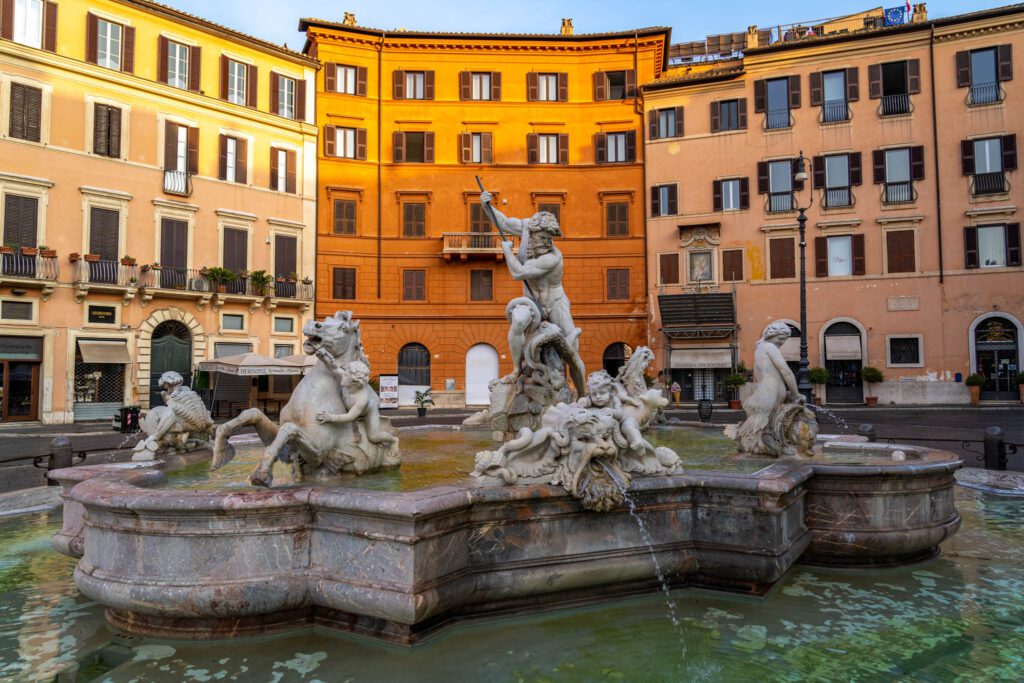
As we mentioned above, you’ll want to get out to start this walk before 9:00 am. At the very latest. Otherwise, this entire route is just packed wall-to-wall with people at basically any other time of day.
Follow a route roughly northeast from Campo de’ Fiori to the Spanish Steps, ending at Piazza del Popolo.
Here’s a handy map of this route , along with the stops mentioned.
- Piazza Navona – This vast square is built atop an ancient stadium (hence the shape). It’s a pandemonium affair, with trattorias and wine bars spilling onto the uneven cobblestones. The Fontana dei Quattro Fiumi (by Gian Lorenzo Bernini, no less) looks especially wonderful at night, as does the Fontana di Nettuno at the north end of the square.
- Campo de’ Fiori – A flower / produce market by day that also has some of the most tasteless souvenirs imaginable (don’t buy souvenirs here), this is a perfect spot to start your exploration of Rome’s city center.
- The Pantheon – Once a Roman temple, now a Catholic church, the Pantheon has a mighty imperial façade that was rebuilt in the 2 nd century AD. The great rotunda inside has a hole in the roof that lets in a solitary beam of sunlight, sometimes illuminating the tomb of the revered artist Raphael. There can be huge lines to get in later in the day, another reason to get up early!
- Trevi Fountain – They say you’ll return to Rome if you throw a coin in the Trevi Fountain. Good luck getting close enough to do that. The spot is always packed with crowds, even early in the morning, but it’s still an iconic sight that’s famed for appearing in films like La Dolce Vita . Whatever you do, don’t eat nearby, where you’ll pay 50% more for 100% worse food.
- Spanish Steps – 135 steps of pure elegance await here. They’re an icon of Rome and link the Borghese Gardens to the Piazza di Spagna, where a gorgeous Baroque fountain by Pietro Bernini decorates the flagstones.
- Piazza del Popolo – Your final stop, this is where you’ll find the city’s oldest obelisk – the narrow tower in the middle of the square, inspired by the Egyptians – and the former northern gate of the city of Rome. However, the square isn’t nearly that old – it was actually designed in the 19th Century. Head up to the Terrazza del Pincio ( here on Google Maps) for an incredible view of the square and St. Peter’s Basilica.
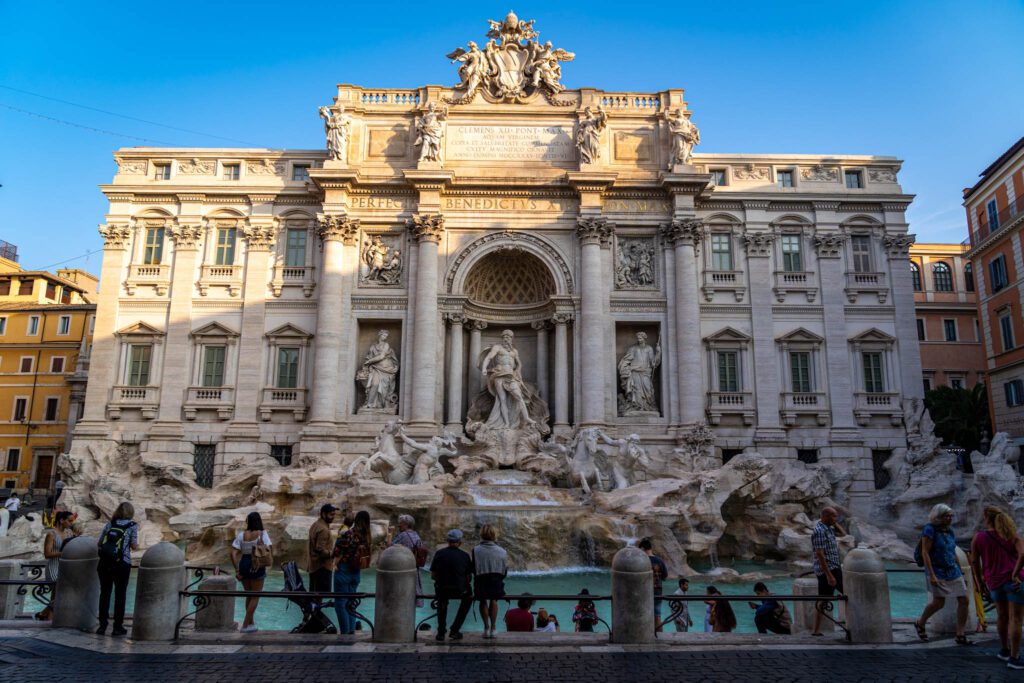
The Borghese Gallery and Gardens
Spend the afternoon exploring the best green space in the city – the Villa Borghese – and experiencing the only art museum (unless you count the Vatican Museums, I suppose) on this Rome itinerary, the Borghese Gallery.
Tickets for the Borghese Gallery are notoriously hard to get because of the extreme limits on people allowed inside at a given time, so book your visit as early as possible. Only 360 people are permitted into this exclusive art gallery every day.

We recommend you pre-book tickets as soon as humanly possible so that you have a chance to experience what we think is the most interesting museum in Rome (sorry, Vatican). You can do so here .
Alternatively, if you’re interested in taking a deeper dive, grab a spot on the excellent Borghese Gallery Tour with Take Walks . It might seem expensive, but you’ll get to experience masterpieces, most notably by the swashbuckling painter Caravaggio (his spine-tingling David with the Head of Goliath is housed within), with all the context and details you’ll want to have to truly appreciate what you’re looking at.
We always do tours of art museums after some great experiences at the Prado Museum in Madrid and the Uffizi Gallery in Florence , and highly recommend it if you’re, like us, not really an art gallery kind of person.
The stories behind the artists and paintings that an expert brings to the table really give you a deeper, richer experience, and help you focus on the important things in a huge museum full of amazing art.
The Villa Borghese is the epicenter of one of Rome’s most lovely parks. If you’re feeling lazy, grab a seat here under the trees and just watch the world go by. Don’t miss the Temple of Asclepius and the lake , which was our favorite part.
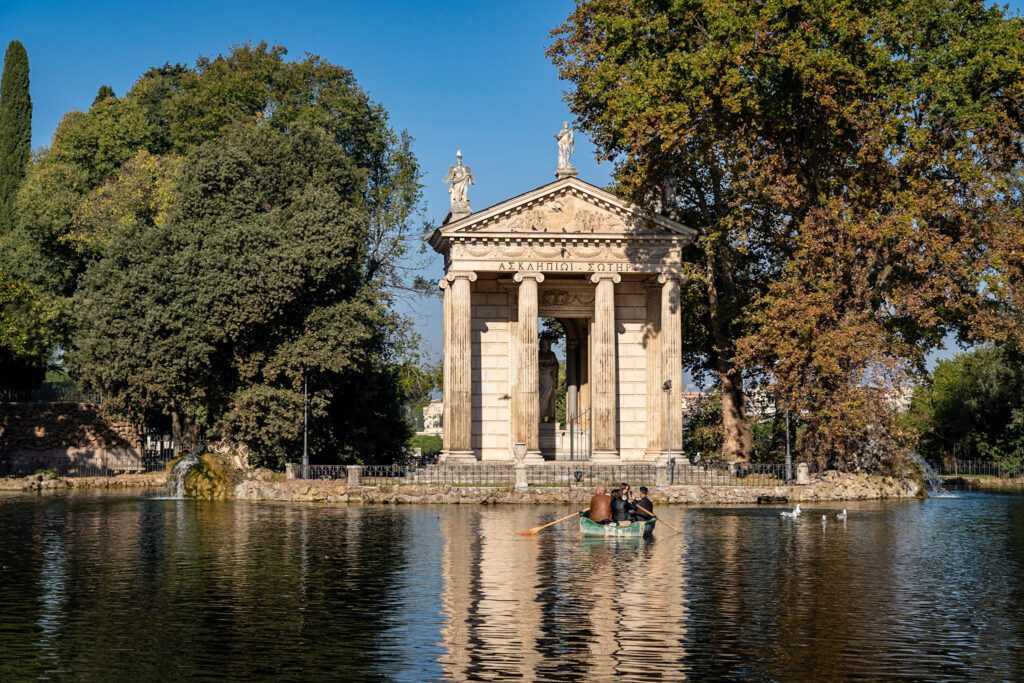
Choose Your Own Foodie Adventure
Diving into the food culture in places we’re visiting is one of our favorite aspects of traveling, and we try to include a food tour, cooking class, or market tour in most places we visit.
Unfortunately, the reality is that because Matt has Celiac Disease and can’t have even a speck of gluten without being sick for days, a food tour or cooking class wasn’t in the cards for us.
HOWEVER. That does NOT mean it shouldn’t be for you! We’d highly recommend it because it gives you a local’s perspective on the city’s food scene – what and where to eat and drink – and you get to connect with fellow travelers and try some amazing food.
Here are some options for you, split between food tours and cooking classes. Our bias is to do a cooking class, because we LOVE to cook, but we also enjoy a good food tour.
Option 1: Learn to Cook Italian Food with a Cooking Class
We’ve done all sorts of cooking classes around the world (read about our cooking class in Mexico City here), and while the gluten-filled nature of Italian food made it nearly impossible to do one in Rome, that doesn’t mean you shouldn’t.
Here are four cooking classes that would definitely be on our list if, you know, Matt could eat gluten.
- Handmade Pasta Class at the Pantheon : You’ll get a brief overview of Roman cuisine before diving in, where you’ll learn how to make two traditional kinds of pasta, along with multiple sauces. And, of course, you get to eat it. Vegetarians welcome.
- Handmade Pasta & Roman Sauces with Riccardo : We love experiences that take us to real people’s homes, in neighborhoods where most tourists don’t make it to. This is that. Join Riccardo – who was born and raised in Rome – in his family home where you’ll make handmade pasta, classic sauces like carbonara and cacio e pepe (our two favorites), and get to connect with the food culture in Rome in a really special way. Plus, wine, obviously, because this is Italy. Vegetarians welcome.
- Handmade Pasta with Grandma : Every culture has the phenomenon of “grandma cooks best,” with classic family recipes passed down from nonna to nonna, and unsurprisingly Italy is no different. You’ll make ravioli, fettuccine and farfalle – all from scratch – in their family home. Note that this tour is a ways outside of Rome (you meet here ) so you’ll need to find your way there and back on the train. Vegetarians welcome.
- Pasta-Making Class – Cook, Dine & Drink Wine With A Local Chef : Hosted by Walks of Italy, which we’ve already mentioned is one of our favorite tour companies in Italy, you’ll get a full rundown of handmade pasta, along with aperitivi and prosecco beforehand, and gelato for dessert. The class takes place in Trastevere. Vegetarians welcome.
Option 2: Dive into Rome’s Food Culture with a Food Tour
Here are some food tours that caught our eye though, sadly, we also skipped these because of the whole gluten and cross-contact issue.
- Hidden Rome Food Tour in Trastevere with Dinner and Wine : Explore Trastevere – our favorite neighborhood in Rome – through the eyes of a local foodie. You’ll simultaneously taste amazing food from places that you wouldn’t have discovered on your own, and also get the background and context for how that food came to be a staple in Rome. Plus, wine and limoncello along the way! This tour combines the history and cultural aspects with great food, which is what we usually look for in a tour.
- Twilight Local Food and Hidden Places : A local born and raised, Selene and her team will take you on a tour-de-Rome’s best food. Along the way, you’ll learn about the history and culture of Rome. Followed by pizza al taglio and carbonara, among other delectable tastings. This tour covers the Centro Storico, mostly.
- The Roman Food Tour in Trastevere : This tour, which covers Prati, the neighborhood to the north of the Vatican, includes a tasting of meats and cheeses and the best pizza al taglio in Rome (which we already featured above in the Vatican section…).
- Taste the Best of Rome (Evening Tour) : 25 tastings over four hours – so you’ll want to show up hungry! You’ll meander through Prati, stopping at five locally owned spots to try a variety of delicacies from truffles, to meats and cheeses, and more.
Day 4: Exploring Two of Rome’s Best Neighborhoods
On your last day in Rome, spend the day exploring two of Rome’s most interesting neighborhoods – the ever-popular Trastevere, full of bohemian charm with cobblestone streets and ivy-adorned buildings, and grittier Testaccio, which we like because it feels like real people actually live there (and the food scene is great, too).
A Morning Walk Above Trastevere

We think that Trastevere is best in the afternoon and evening, when the activity spills out into the cobblestone streets and charming piazzas.
However, there is a great market at Piazza di S. Cosimato ( here on Google Maps) where you can find fresh produce, meats, cheeses, and other products perfect for people who have a place with a kitchen and are looking to do some cooking.

The real reason to head to Trastevere in the morning is to tackle one of our favorite walks in Rome, which we sort of accidentally discovered on one of our last days in Rome on our latest trip.
The walk takes you up the hill behind Trastevere to Belvedere del Gianicolo – where you’ll find a great view over the city – and then back down the other side.
Along the way, there are some really good explanatory panels that describe the historical importance of this area during Italy’s struggle for independence in the mid-19th Century.
Giuseppe Garibaldi, an Italian general during the period immediately before the unification of Italy, is considered to be one of the most important figures in modern Italian history, and there was a battle on this hill above Trastevere that was key in establishing Italy’s independence.
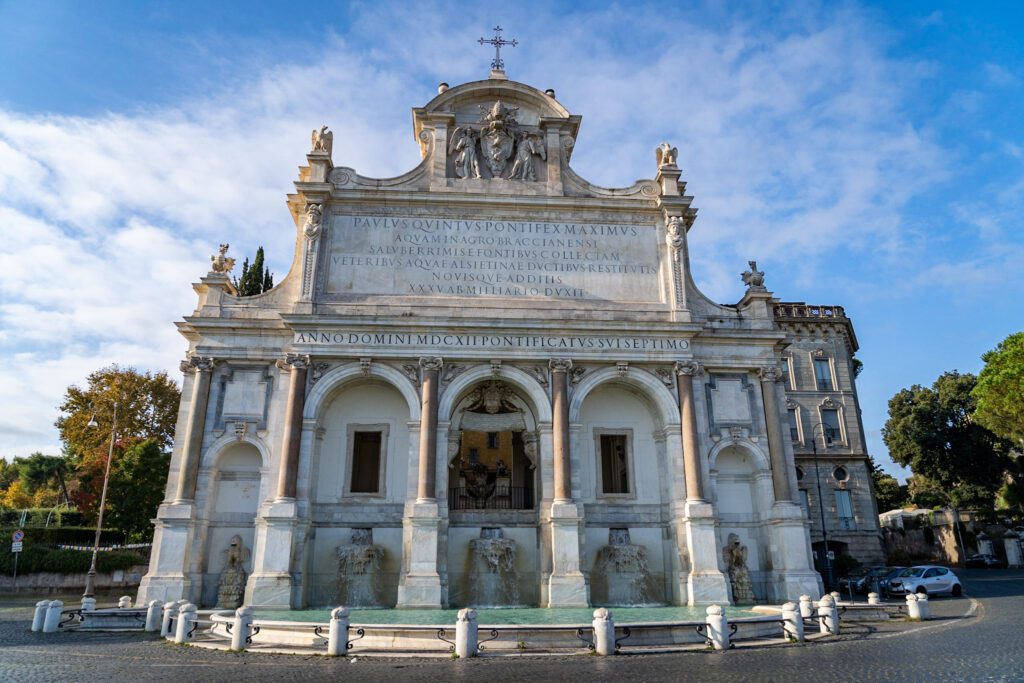
Though, it should be said that the Italian Republic he fought to establish was short-lived, and came back under a new name and brand a decade or so later, which is what has remained to this day.
There’s a statue of him in the middle of the plaza at the Belvedere del Gianicolo.
Here’s a map of the route , and the stops we’d recommend, which ends at Roma San Pietro , where you can catch the train out to Testaccio , the other neighborhood you’ll be exploring today.

A contrast from Trastevere and the rest of Rome’s historical center, the first thing we noticed about Testaccio is that it feels like real people live there.
A neighborhood that, 20 years ago (even less, really) was full of warehouses is today one of the best neighborhoods for foodies in Rome.
To get to Testaccio, grab the regional train from Roma San Pietro to Roma Ostiense , which should only take about 20 minutes and leaves you with a few minutes walking into the heart of the neighborhood.
It costs a couple of Euros per person – buy tickets from the machines at the station, and be sure to validate them before boarding the train .
The first thing to know about Testaccio is that it’s a great food neighborhood.
The food scene is centered around Mercato Testaccio , a big food market that’s roughly half stands selling produce, meat, and cheese, and half stands selling ready-to-eat food (plus some other stands selling random knick knacks and/or shoes). This is where you should have lunch.
It’s not overrun by tourists. It’s not wildly overpriced for what it is. It’s a place where locals go to shop and eat. If you’re interested in going deeper, look at this Testaccio Food Tour .
Here are some other places to check out in Testaccio:
- Tram Depot : A lovely outdoor spot to grab coffee and a pastry or two in the Italian sun. It’s a former tram, now refurbished and serving up good coffee to mostly locals (we were the only tourists there as far as we could tell).
- Non-Catholic Cemetery : When Rome was still a devout Catholic city, the remains of protestant foreigners weren’t permitted to be buried in the regular cemeteries alongside the Catholic citizens. Instead a few non-Catholic cemeteries sprung up to accommodate them and the one in Testaccio is one of the most famous. Remains of Percy Shelley and John Keates can be found buried here. There are also some great views of the Piramide di Caio Cestio, an Egyptian-style pyramid in the middle of Rome, commissioned by a rich Roman guy in the 1st Century B.C.E. that still stands today.
- Volpetti Salumeria : A popular market selling all manner of meats, cheeses, preserves, baked goods, and wine. It is open everyday and perfect for grabbing picnic food to enjoy while exploring Rome. Mingle with the locals as they go about their daily shopping to purchase the ingredients used in real Italian cooking.
An Evening in Trastevere
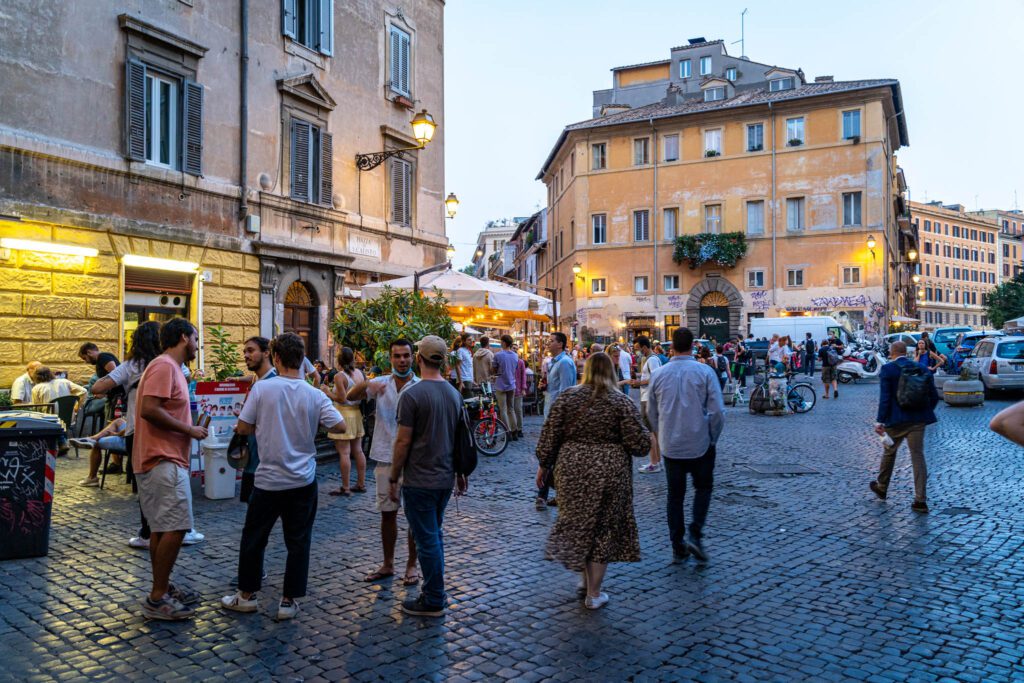
For your last evening in Rome, return to where you started the day – Trastevere – and explore the neighborhood at its best, which is undoubtedly when the sun starts to set over the Tiber.
We don’t have much of an agenda for you here – we think the best thing to do is to wander the streets and soak in the atmosphere. Did we mention that we LOVE Trastevere and we think it’s the coolest place to stay in Rome ? We did? Oh, okay, cool.
While we don’t have an agenda, we DO have some recommendations for you to start your exploration.
Don’t miss the Basilica Santa Maria , a beautiful church in the center of the neighborhood filled with gold mosaics by Cavallini. This is one of the prettiest and most underrated churches in Rome – though you wouldn’t really know it from the façade – so it’s a must see in this area.
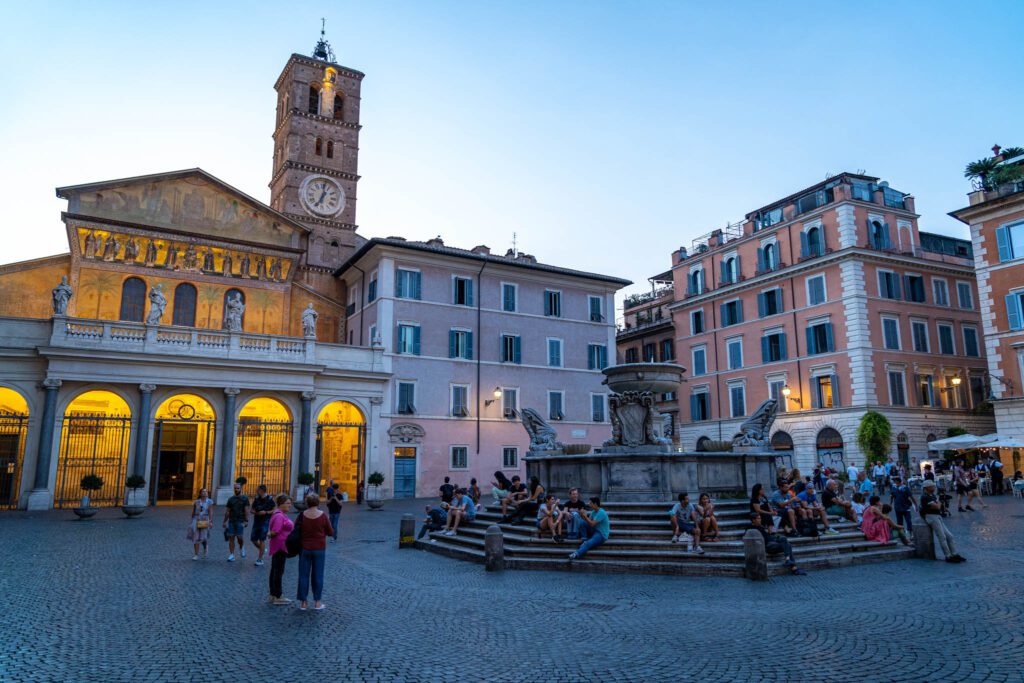
The square in front of it is a meeting place of sorts so is an amazing place to sit and people watch by the fountain.
The other thing you should know about Trastevere is that it has amazing nightlife . Trastevere is one of the liveliest neighborhoods in Rome packed with little bars and trattorias that stay open to the early hours.
There are no clubs here but plenty of small wine bars and craft beer to sip on until the first light of dawn. In summer, bars and restaurants spill out into the streets with tables and chairs outside to enjoy the long sunlight hours.
We like Mama Eat for dinner because they have great gluten free options, and Freni e Frizoni was recommended to us by both a friend and the host at our hotel, though we found it to be expensive and full of tourists (though the spritz was good and the location is great).
Les Vignerons is an amazing little wine and beer store run by a very passionate man (we had a small disagreement, exacerbated by my terrible Italian, about gluten free beer) that is perfect for picking up a bottle of wine, beer, or – and this was a surprise to us – cider! Highly recommend it if you’re looking for a place to buy wine or beer.

What to Do with Less Time in Rome: Planning a Shorter Rome Itinerary
If you have less time in Rome, you could either try and fit the same amount of things to do in a shorter time period, or you could be more selective about what to do and see, and save the others for a later trip.
We’d recommend the latter approach, which is generally how we approach travel. Pick a few sights, go deep on those, and save the rest for another visit.
For each of these itineraries, you can use the relevant sections in the detailed itinerary above to help you figure out the logistics around each of the sites mentioned.
What to Do with One Day in Rome
If you only have one day in Rome, I hope you’re ready for a whirlwind. If you come to Rome and it’s your first time, you’re going to want to see the Colosseum, the Vatican, and the Centro Storico.
Fitting all three of those sights in a single day is going to be exhausting, and it’s exactly the kind of travel that we don’t usually recommend because it’s just running from place to place without the time to truly experience the place you’re exploring.
But, if you only have one day in Rome, here’s how we would spend it.
First, do a morning tour of the Colosseum and Roman Forum .
Afterwards, have lunch in the Centro Storico (we’d recommend Antico Forno Roscioli ) and get gelato at either Fatamorgana or Grom . You can also try to fit in an authentic Italian espresso-at-the-counter experience at Tazza d’Oro too.
After lunch, do the walk from Campo de’ Fiori to the Spanish Steps, passing by Trevi Fountain and the Pantheon along the way.
In the late afternoon / early evening, do a tour of the Vatican at closing time , when it’s much more peaceful. End with dinner in Prati or Trastevere.
Another option would be to do a full day tour of Rome with Walks of Italy , which includes skip-the-line tours of both the Vatican and Colosseum.
What to Do with 2 Days in Rome
If you have two days in Rome, spend it on four main things: the Colosseum and Forum, the Vatican, a walk through the Centro Storico, and an evening in Trastevere.
Spend your first morning taking a guided tour of the Colosseum and Roman Forum , which will give you a richer experience and help you understand the context behind what you’re looking at. Have lunch in Monti before heading to the Centro Storico and walking from Campo de’ Fiori to the Spanish Steps, ending at Piazza del Popolo. Head back the way you came and get some
On your second day, do an early morning tour of the Vatican , head up to admire the view from the top of Castel Sant’Angelo, then head to Trastevere for aperitivo, dinner, and drinks.
What to Do with 3 Days in Rome
With 3 Days in Rome, follow the full itinerary above as written with one change. Cut day four, and spend the evening of day one in Trastevere instead.
More Time? Here are Some Additional Things to Add
If you have more than four days in Rome, there’s still plenty to do and see in the Eternal City. We spent 10 full days in Rome on our latest trip, and we were still finding new things to do and see on the last day (and we didn’t even do the Vatican or Borghese Gallery since we’d already done them before).
One thing we would NOT recommend is a day trip to Pompeii. It is just way too far to go in a day – you’ll need to travel about six hours when it’s all said and done. You need at least 1-2 days.
The Catacombs : Take a tour of the Capuchin Crypts to get into the dark history that lies under Rome’s streets.
A Day Trip to Tivoli : Every major European city seems to have a palace somewhere nearby, built by someone rich at some time in history. For Rome, that’s Tivoli, built by Emperor Hadrian. It’s probably the best day trip from Rome. Here’s a guided tour to get there and back in about half a day.
Pasta / Wine in Frascati : Get out of the city for an evening and head out to nearby Frascati, a well-known wine region in Lazio, for a cooking class / wine tasting extravaganza .
Wine tasting near Rome : One thing we loved about our trip to Italy is trying alllll the different Italian grape varietals! At home, we really get only a handful of grapes. In Italy, each region has their own unique grapes, and it’s fun to try them all. For Rome, Frascati is the place to go for wine tasting, and makes a fantastic day trip. The best way to do it without a car is a guided tour – here’s a tour that gets stellar reviews.
The Best Time to Visit Rome
There’s no hard and fast rule about the best time to visit Rome. The Italian capital is blessed with four distinct seasons.
Our overall pick would be the fall, but each quarter of the year offers its own unique delights.
- Summer – High season in Italy. Rome is super busy and very hot. Hotel prices skyrocket and there are long lines for many of the main attractions. The bonus is that you get to see the city buzzing with life and the weather is usually sun, sun, and just a little extra sun for good measure.
- Fall – Our favorite time in Rome. Seriously, we don’t think you can beat this city in September and October. There’s just something so lovely about the changing color of the cork oaks along the Tiber River and the balmy evenings. The only downside to autumn is that there’s the chance of some rainfall.
- Winter – Rome takes on a brooding, mysterious air in the winter. There can sometimes be freak snow storms, and we’ve seen frozen fountains on Piazza Navona in the past. Hotel rates tend to be cheaper in winter and there’s way fewer people crowding the main attractions. You’ll need the thermals and a coat though!
- Spring – Like fall, spring is downright stunning in Rome. There can be quite a bit of rainfall, but that’s balanced out by the flower blooms in parks like Villa Borghese and Doria Pamphili. May is another sweet spot for crowds because the summer rush hasn’t started quite yet.
Getting to Rome
Rome is one of Europe’s major capitals, which means it’s really well connected to other spots around the world by both air, road, and rail. Getting in shouldn’t be hard, no matter if you’re starting in New York City or London.
Flying to Rome
Rome has two airports: the Leonardo da Vinci International Airport (FCO) in Fiumicino and the Rome Ciampino Giovan Battista Pastine Airport (CIA) in Ciampino.
The first is the capital’s main international hub. That’s where you’ll touchdown from long-haul flights from the US, but also on cross-Europe flights with premium carriers like British Airways or Lufthansa.
Ciampino is primarily an arrival point for low-cost airlines like Ryanair and EasyJet, which are worth knowing about if your trip to Rome is part of a continent-wide adventure.
Getting into the city from both airports is a cinch:
- From Fiumicino Airport (the Leonardo da Vinci International Airport) : Take the train. It’s pricier than the bus at around $18 each way, but far faster (30 minutes from A to B) and won’t slow down when traffic gets bad – and it can get really bad in Rome! The train is called the Leonardo Express . It leaves from the station within the airport (follow the train signs) and arrives at Termini Station.
- From Ciampino (Rome Ciampino Giovan Battista Pastine Airport) : Sadly, there’s no direct train route from the airport in Ciampino to the center of Rome. The buses are pretty reliable, though. Take the service with either Terravision or SITBus. They cost up to $9.50 per person, each way, and take 50 minutes to arrive at Termini Station in the center.
Don’t be tempted to use Uber to get to your hotel from the airport. Rome is a taxi culture. Only the deluxe Uber Black cabs are offered on the app. A taxi from either airport to the center should cost around $50.
Arriving by Train
Rome is the hub of a highly efficient Italian railway network that can take you south all the way to Sicily via the pizza mecca of Naples, and north to Vienna and Munich on high-speed and overnight trains that go through the Alps.
There are also many shorter, slower trains – known in Italy as Regionale trains – that connect the capital with surrounding towns in regions like Lazio, Tuscany, and Umbria (all of which are worth exploring if you have more time in Rome).
These days, virtually ALL trains to Rome come into the huge Termini Station . We’ve always loved arriving there. It’s a feast for the senses. Everywhere you look there’s something going on, from business travelers clinking espressos to huge locomotives purring to a stop.
Termini Station is also a convenient arrival spot. It’s got a direct link to the Rome Metro network, and there’s a major bus interchange right out front.
It might be worth adding a warning : The area immediately around Termini isn’t the most welcoming in the city. It can feel a tad rough and gritty. Keep your wits about you if you’re arriving late there and don’t let it put you off the town right away!
Getting Around Rome
Rome was founded way back in 750 BC. In the 2,700+ years since then it’s been expanded and altered and built on more than most cities around the world. So, it should hardly come as a surprise that it’s not the easiest town to navigate.
The streets can be narrow and winding, particularly in the Centro Storico (the medieval core of Rome). There are even roadways that have to work around ancient monuments – we remember waiting 30 minutes once to pass under an arch in an ancient aqueduct!
The upside? Walking might just be your best bet.
Rome isn’t small but it’s not massive a la London or Paris. Many of the main areas you’ll want to see as a first-time visitor on a 4 day trip to Rome are all linked by paths along the Tiber River. What’s more, doing Rome by foot is a joy in its own right.
You just never know when you’ll stumble upon an imperial arch built by one of Rome’s famous emperors, or an inviting little vinoteca beneath the stone pines.
The Rome Metro
The ever-expanding Rome Metro currently has three lines. They all intersect at Termini Station. Really, the Metro is for commuters who want to reach the suburbs of Rome, because the main lines extend very far to the east and the north of the town.
That said, there are a few stops near the major attractions – Circo Massimo, Repubblica, Spanga, Colosseo – that you might make use of.
The bus network in Rome is very extensive. It covers everywhere the Rome Metro doesn’t and even doubles up to offer alternative routes to popular spots like the Colosseum and Vatican City.
At last count, there were 338 individual bus lines running throughout the Italian capital. The main interchange is just out the front of Termini Station, but you can catch buses from anywhere along the routes they run. Look for the map of where you can go at the individual stops.
Always remember to validate your ticket at the crunching machines on the buses – this is a common mistake among first-time travelers to Rome and often ends in a fine!
Rome’s above-ground trams connect the major suburbs to the east and west. For that reason, they might not be of such great use to visitors looking to explore the heritage-rich heart of the capital (where the main sights are).
However, there are some tram services in Rome that can be handy, like the one from Trastevere to Argentina (just south of the Pantheon) or the Colosseum, for example.
Tickets for Public Transportation
All the tickets for all the different types of public transportation in the Eternal City are linked. Buy one and you can travel on trams, buses, and metros to your heart’s content. There are a variety of fare options:
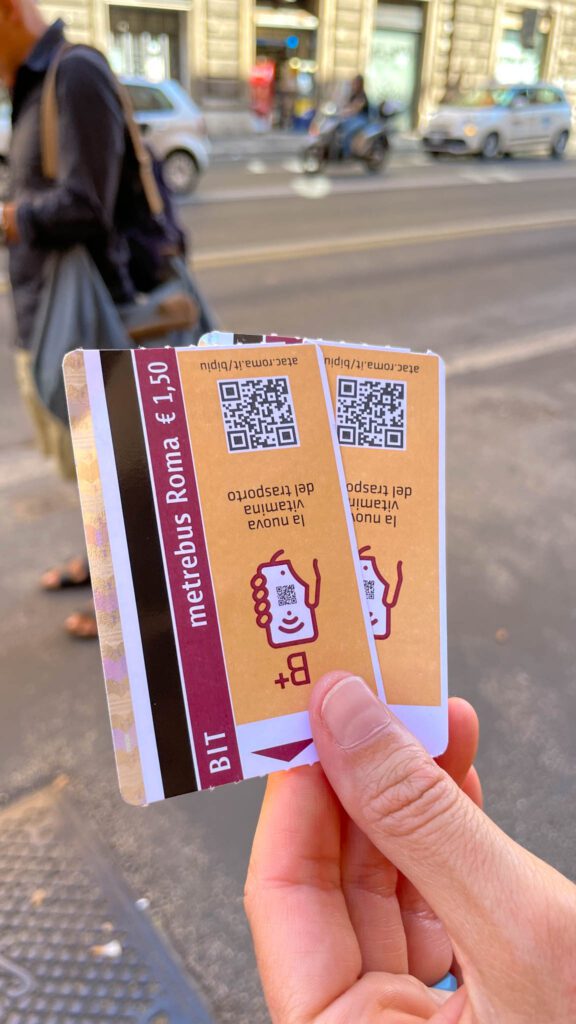
- 100-minute tickets (€1.50/$1.80) – Valid for any public transportation in Rome for 100 minutes with unlimited transfers.
- 24-hour ticket (€7.00/$8.35) – Valid for any public transportation in Rome for 24 hours after the moment you validate.
- 48-hour ticket (€12.50/$15) – Two days of unlimited travel on any public transportation from the moment of validation.
- 72-hour ticket (€18/$21.50) – Three days of unlimited travel on any public transportation in Rome from the moment of validation.
All tickets can be bought at the kiosks by the stations (there are lots around Termini Station) or from machines on the Metro platforms. Make sure you validate tickets at the punch stations before use!
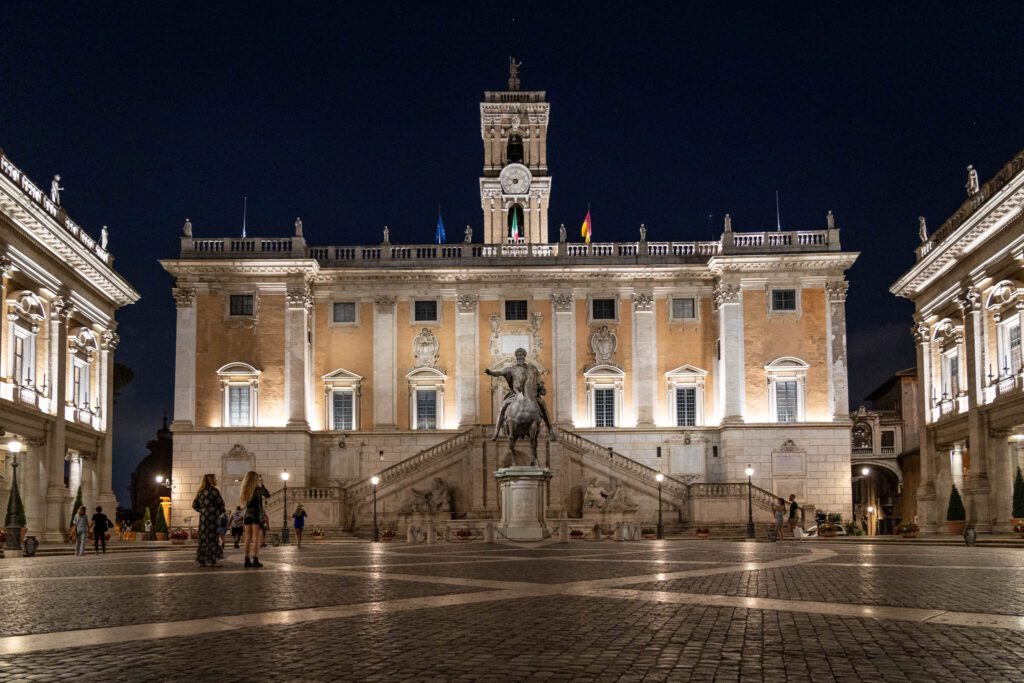
Matt is the founder and main writer behind Wheatless Wanderlust, which he started back in 2018 as a way to share his gluten free travel guides with his fellow Celiac travelers.
Since then, Matt and his wife Alysha have visited 18 national parks, spent three months in Europe and six weeks in Colombia, and have explored every corner of the Pacific Northwest, which is where Matt grew up.
He writes super detailed guides to the places they visit, bringing together personal experience and historical context to help YOU plan an amazing trip.
I just spent the last hour reading this blog and OMG, it is wonderfully written and EXACTLY what I was looking for. I am thinking of planning a trip to Rome next March and I am SOLD after reading this. You wrote in great detail, to the point where I could see myself there. I’m looking forward to planning this trip and I soooo appreciate this blog. Keep it up!!
What a great blog, my very first research for our (traveling with my husband) upcoming trip to Rome in about 20 days. We just returned from Milan after a 2 month trip to northern Europe in late summer. Now heading to Rome via Milan and this was the perfect information I was looking for. Though we are traveling in November, am sure Rome might not be as cold as Philly. Enjoyed reading this and will definitely keep this as our guide to our 4 day adventure. Looking forward to reading about your other destinations. I read about you both and it seems like I was reading about me n my husband (yes we do lot of research and of course the excel spread sheet, google mapping, travel folders etc). We are big travel enthusiasts and travel extensively, yes 3 months at times too, just too lazy to write up a beautiful blog like yours. Have done many countries and yet always feel there is till so much more to explore. So keep on traveling and sharing your experiences. Thank you once again.
Thanks for the kind words! We put a lot of time and effort into it, and we’re glad you found it both useful and entertaining (the balance we’re always trying to strike). We do love a good excel spreadsheet when we’re planning. Cheers!
Leave a Reply Cancel reply
Your email address will not be published. Required fields are marked *
This site uses Akismet to reduce spam. Learn how your comment data is processed .

The Ultimate 3 Days in Rome Itinerary: A Complete Guide to Rome
Use this 3 days in Rome itinerary to plan an epic trip to the eternal city of Rome during your Italy trip . Know where to stay, what to do, how to get around, useful tips that’ll enable you to travel smarter, and how to spend each day to make the most of your time!
Rome…
a city where the past seamlessly intertwines with the present, where every cobblestone whispers tales of emperors and gladiators, where every alleyway holds a secret, where every piazza beckons you to stay just a while longer, and where the food makes you drool!
If you’re someone who enjoys history, art, architecture, or food, then Rome is absolutely and totally for you. And even if you don’t, you will still be in awe of the sights in this city.
Before we get into the 3 days in Rome itinerary, let’s first discuss some essential things you must know!
When to Go to Rome
The best time to visit Rome is April to June (spring) or September to October (fall), when the weather is pleasant and it isn’t very crowded. The city’s iconic landmarks, such as the Colosseum and the Vatican, are more enjoyable without the summer heat or the winter chill.
However, if you do go in other periods, go with your expectations set. Winter (November–March) will be cold with shorter days, but prices will be low and the crowds will be minimal.
If you go during the summer (July–August), you’ll find Rome to be lively, but that comes at the cost of high temperatures, crowds, and high costs. This is the time we were in Rome! Prices sure were high, but we loved the vibe! If you’re travelling during this period, then ensure you book your accommodation six months or more in advance.
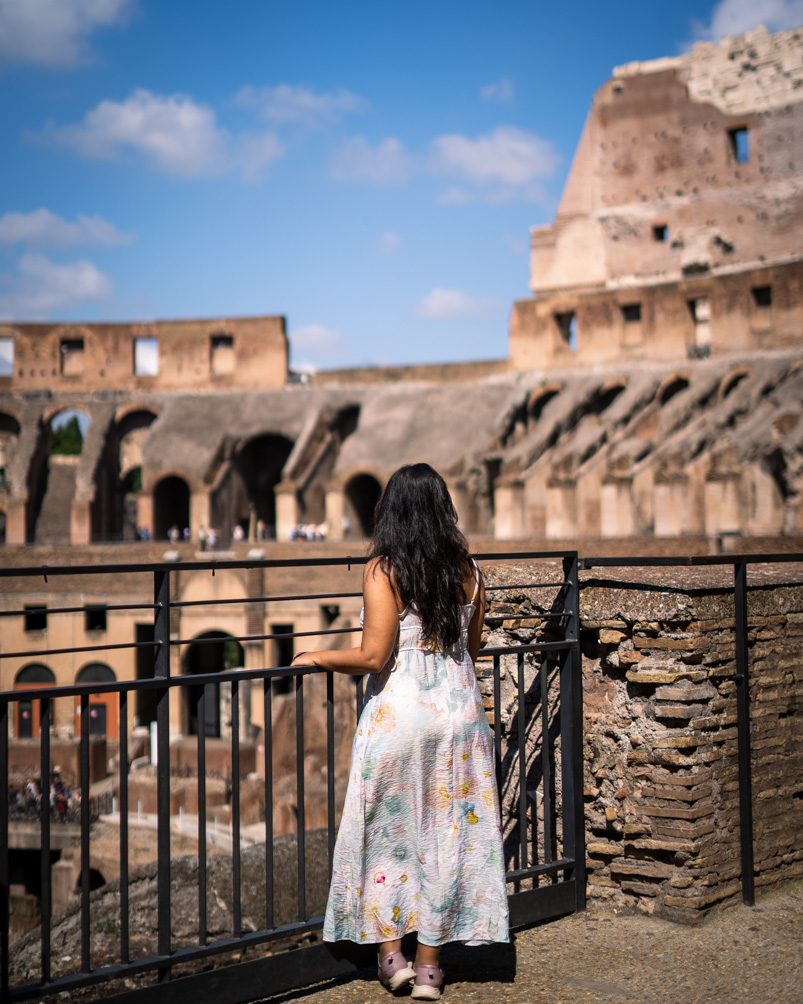
Where to Stay in Rome
Selecting the right neighbourhood can have a huge impact on your Roman holiday. These are the areas to consider:
The Historic Centre (Centro Storico): The centre offers a quintessential experience, placing you near iconic sites like the Pantheon and Trevi Fountain. You’ll be at the best location possible if you stay near these sights, and you’ll hardly need to use public transport, but prices will be high. Trastevere: Trastevere is a great alternative if you’re looking for a vibrant, bohemian atmosphere with great food options. It is a bit away from the main sights, but they’re not too far, and you’ll surely love the lively evenings in this area.
The one area you should avoid is around Roma Termini , the main train station in Rome. It is not particularly safe, and I have heard horror stories of how people moved from there after spending just one night there.
Hotel Options in Rome
Here are a few options for mid-range stays with great ratings in excellent locations . Each one of them has AC, private bathrooms, free Wi-Fi, and soundproofing.
- Domer Trevi (in Centro, near Trevi Fountain)
- Navona Jacuzzi Rooms (in Centro, near Piazza Navona)
- Feronia Guest House (in Centro, near Pantheon)
- B&B Suites Tastrevere (in Trastevere)
Where We Stayed
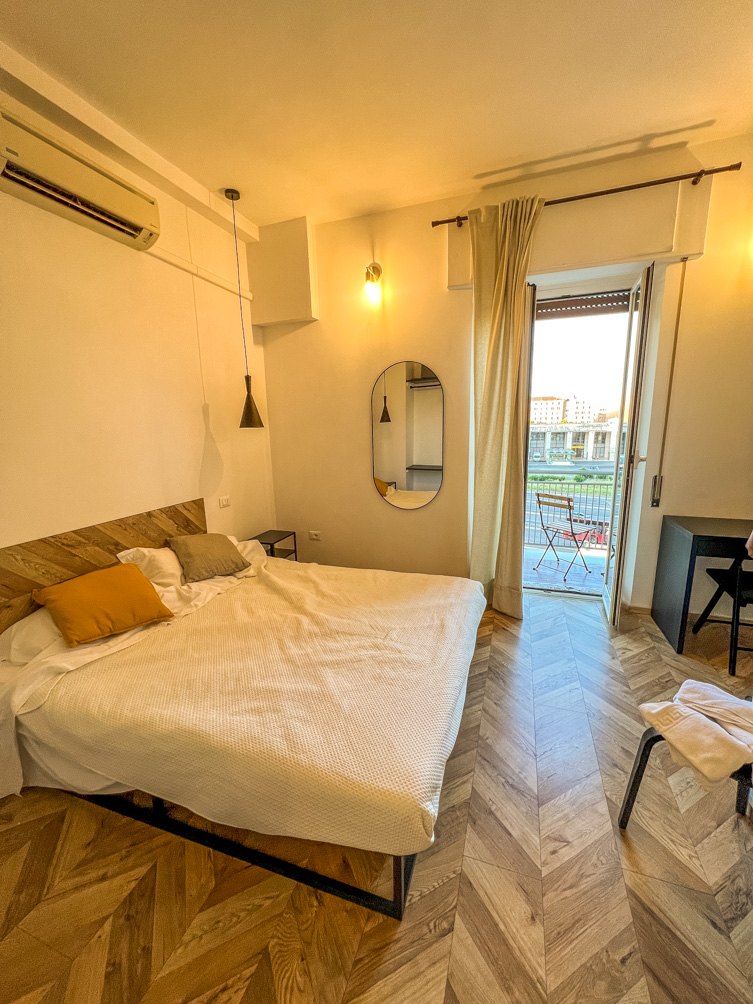
We stayed at CasaValentina in Aventino, Rome . It was a bit away from the centre, but it fit our budget in the summer months and had an excellent connection to public transport. The bus stop, the metro station, and the train station were just a few minutes walk. We had a clean and aesthetic room, a private bathroom, a balcony, and air conditioning. The stay also had free coffee and snacks (excellent for a quick breakfast early in the morning) in the common area. The wifi was great too! We wished there had been some restaurants and grocery stores around, but all in all, it was great value for money in an expensive city like Rome.
See prices and booking options for CasaValentina
3 Days in Rome Itinerary
This is an interactive map with all the spots mentioned in the itinerary already marked on it. Attractions for each day are denoted by a separate colour, and recommended eateries are also marked. You can expand this map for a closer look and even add the spots to your own Google Maps for future reference.
Day 0: Giardino Degli Aranci OR Food Tour/Cooking Class
Since the Rome itinerary given below requires a full 3 days, I’m assuming you will arrive a day before to settle in your hotel.
On this day, you can watch a gorgeous sunset at Giardino Degli Aranci, or the Garden of Oranges. It is a garden with bitter orange trees, and it offers a breathtaking perspective of Rome, particularly St. Peter’s Basilica. It is free to enter and popular with locals.
Otherwise, if you’re a foodie hoping to understand more about the divine Italian cuisine, then join one of the handpicked food tours or cooking classes given below.
Day 1: Colosseum, Roman Forum, Capitoline Hill and Trastevere
Rome day 1 walking route map.
Morning: Colosseum
Timing : Varies all year. Check timings and updated information here
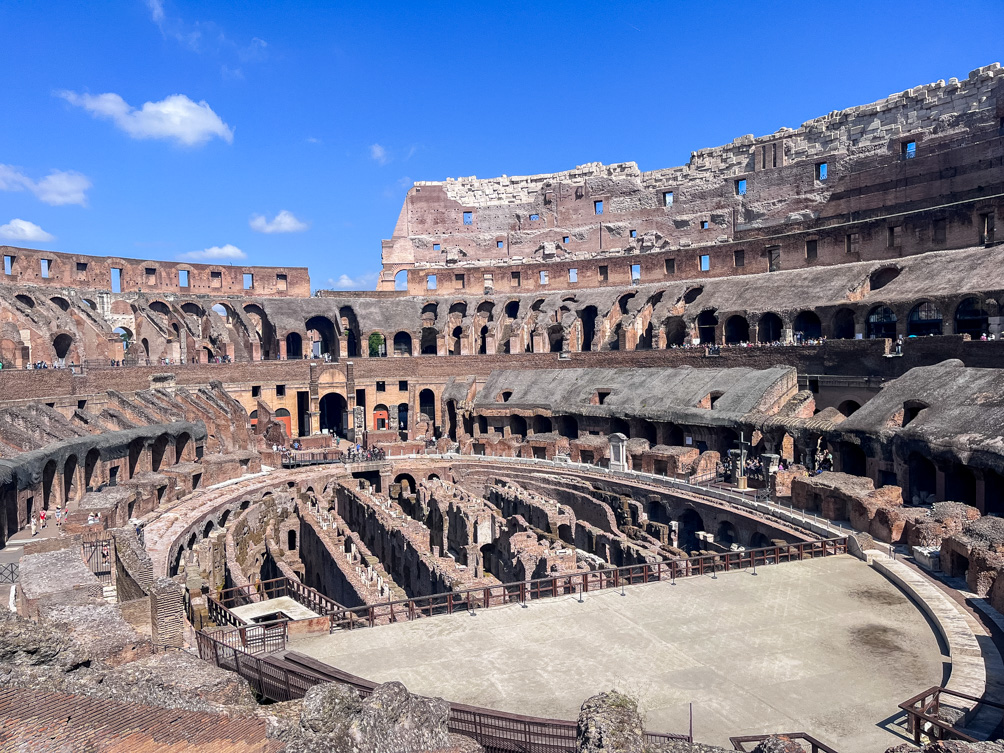
Admire the magnificence of the Colosseum, where stories of gladiatorial combat come to life. Constructed between the years 72 and 80 AD, the Colosseum has a capacity to hold 80,000 spectators for public events like gladiatorial matches . A must-see for its sheer grandeur, it reflects the engineering prowess and historical might of ancient Rome . It is one of the seven wonders of the world, and hence, it can’t be missed on your first visit to Rome.
Tips for visiting the Colosseum
- It is best to go to the Colosseum at opening time, which varies throughout the year, so check timings for your dates .
- To tour the Colosseum without having to buy an additional guided tour or audio guide, listen to the Rick Steves Audio Europe tour ‘The Colosseum’ but you won’t be able to ask your questions and have to find your way around yourself.
- Buying a ticket to the Colosseum also gives you free entry to the Roman Forum and Palatine Hill . So don’t lose your ticket.
- The “Sperone Valadier,” which is next to the Arch of Constantine, is where you can enter the Colosseum.
- Buy the tickets beforehand so that you can visit the Colosseum at your preferred time without having to buy tickets in black. Yes, people sell exorbitantly priced tickets near the Colosseum because it can be near impossible to buy tickets on the day of and because buying the tickets on the official website can be highly problematic sometimes. So I highly recommend buying the ticket through this website . Or better yet, do a well-rated guided tour to make the most of your visit to this world wonder. Check the availability of the tour below.
You’re probably going to be famished after a few hours at the Colosseum, especially if you arrive without eating a heavy breakfast. In that case, you can head to one of the restaurants nearby (about a 200-metre walk). These restaurants will have a view of the Colosseum, but beware that these will be restaurants catering to tourists.
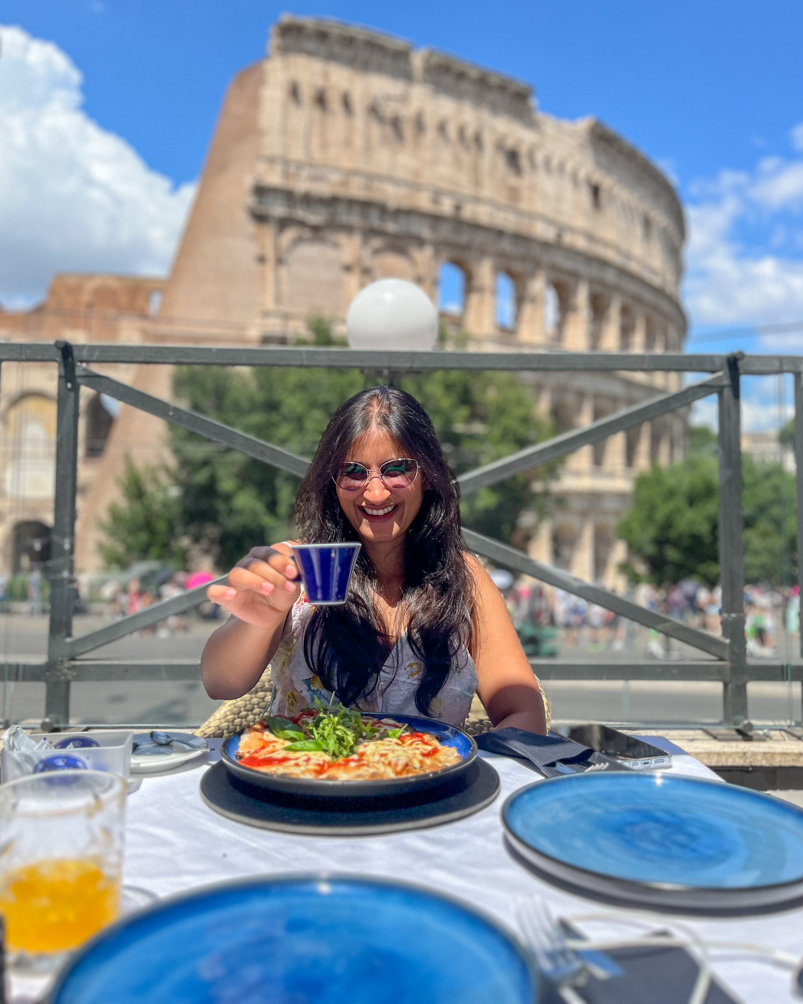
- Ristoro Della Salute
- Ristorante Pizza Forum Roma
- Royal Art Cafè Roma: This is where we ate!! The food was enjoyable, and the view was fantastic.
- Il salotto del Colosseo
Afternoon: The Roman Forum
Walk about 400 metres to the Roman Forum.
The Roman Forum, which dates to the 7th century BC , is situated next to the Colosseum. The social, economic, political, and religious centre of the incredibly large Roman Empire was located on this 5-acre plot of land. With its strewn columns and the remnants of palaces and temples , it is now a treasure trove of archaeological discoveries. This is where Marc Antony uttered the well-known line, “Friends, Romans, countrymen, lend me your ears,” in Shakespeare’s words. Even a temple honouring Julius Caesar exists. Walking around the Roman Forum was, to us, more interesting than even the Colosseum.
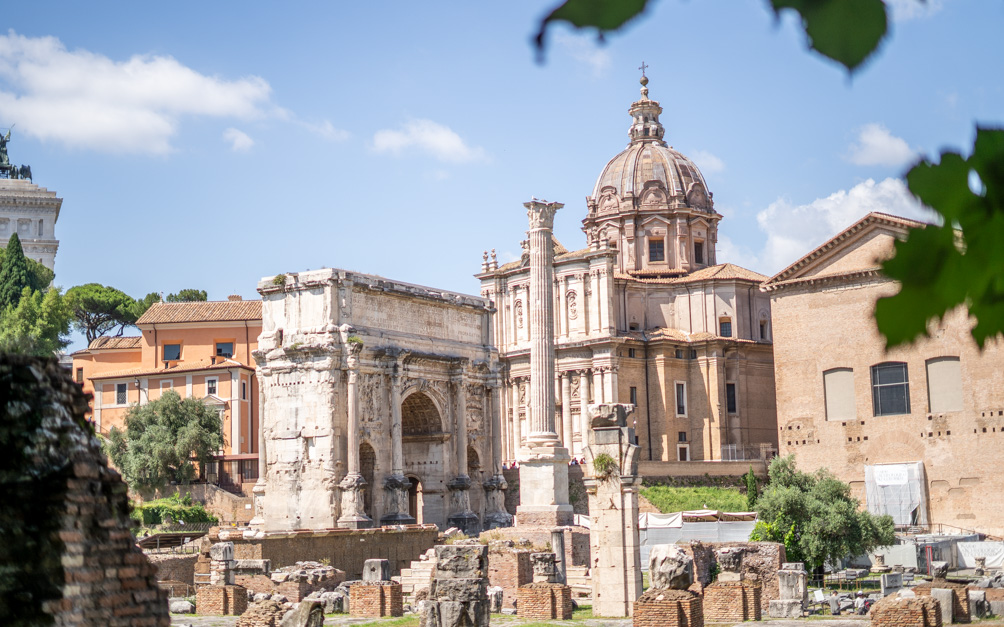
Tip: To learn more about the Roman Forum and make sense of the ruins, download and listen to Rick Steve’s Audio Europe guide ‘The Roman Forum’ while walking around the area. If you’re following this audio tour, first walk up Palatine Hill, ‘where Rome was born’ and then continue with the audio tour.
Afternoon: Capitoline Hill
From the Roman Forum, exit at the far end and go up 200 metres on the Capitoline hill towards the Capitoline museums. Don’t forget to look down at the Roman Forum when you’re up the hill. The view is amazing.
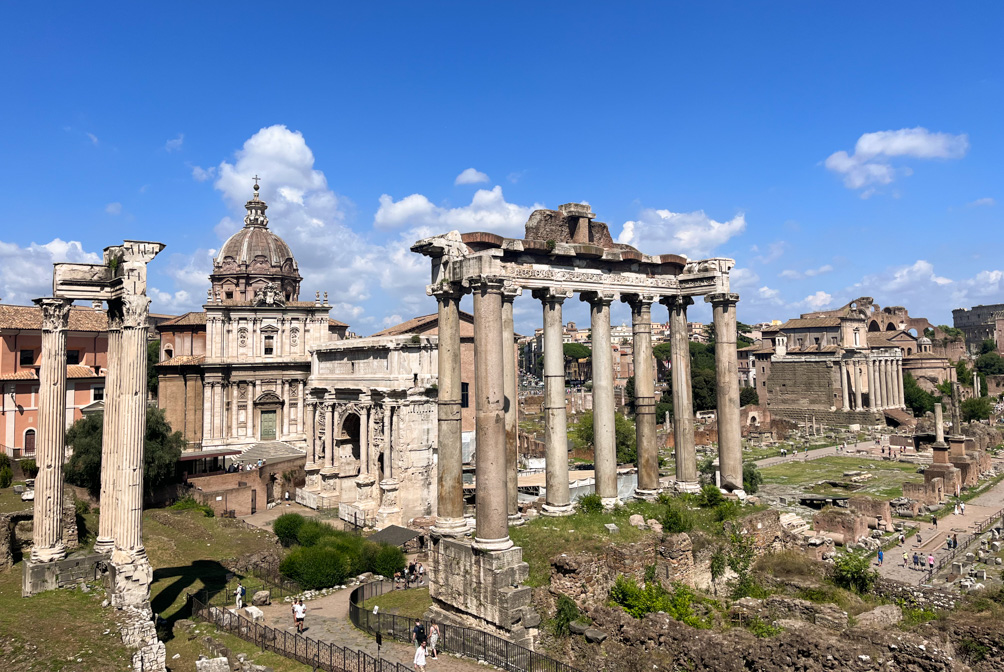
The Capitoline Museum is the world’s oldest public museum . The history of the museums dates back to 1471, when Pope Sixtus IV donated important ancient bronzes to the people of Rome and located them here. Since then, the museum’s collection has grown to include a large number of ancient Roman statues, a collection of medieval and Renaissance art, and many other items.
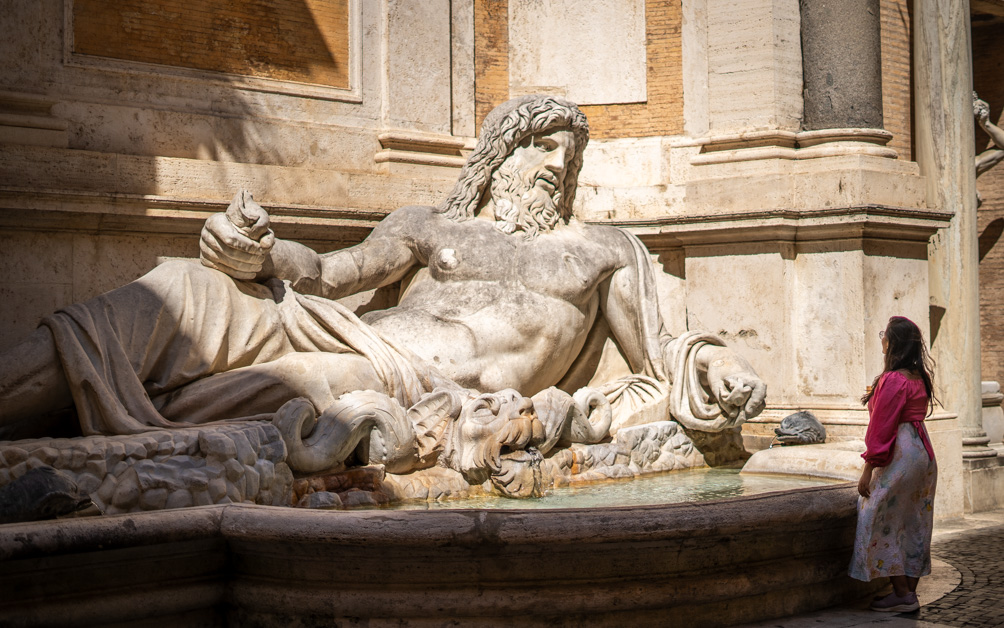
We checked out the museum because it was free that day, being the first Sunday of the month, and we enjoyed it. However, since you’re going to be seeing so many more superb museums, go inside this one only if you’re especially interested. But do check out the architecture of the museum from the outside and the piazza with the statue of Marcus Aurelius in the centre (a copy of the original is inside the museum). The plan for the piazza was conceived by Michelangelo, and it is a sight itself.
Evening: Monument to Victor Emmanuel II
Walk 180 metres to the Victor Emmanuel II Monument. The Victor Emanuelle II Monument honours the first king of a united Italy and was finished in 1935. With its imposing structure and columns and statues, it is a visual celebration of the identity of the country. This is another attraction you need not enter but just see from the outside!
Evening: Largo di Torre Argentina
If you’re tired, head back to your hotel for a bit before venturing out again. If not, walk 600 metres to Largo di Torre Argentina to see where Julius Caeser was assassinated. Pay and go in if you’d like, or just see the archaeological site from the outside like we did.
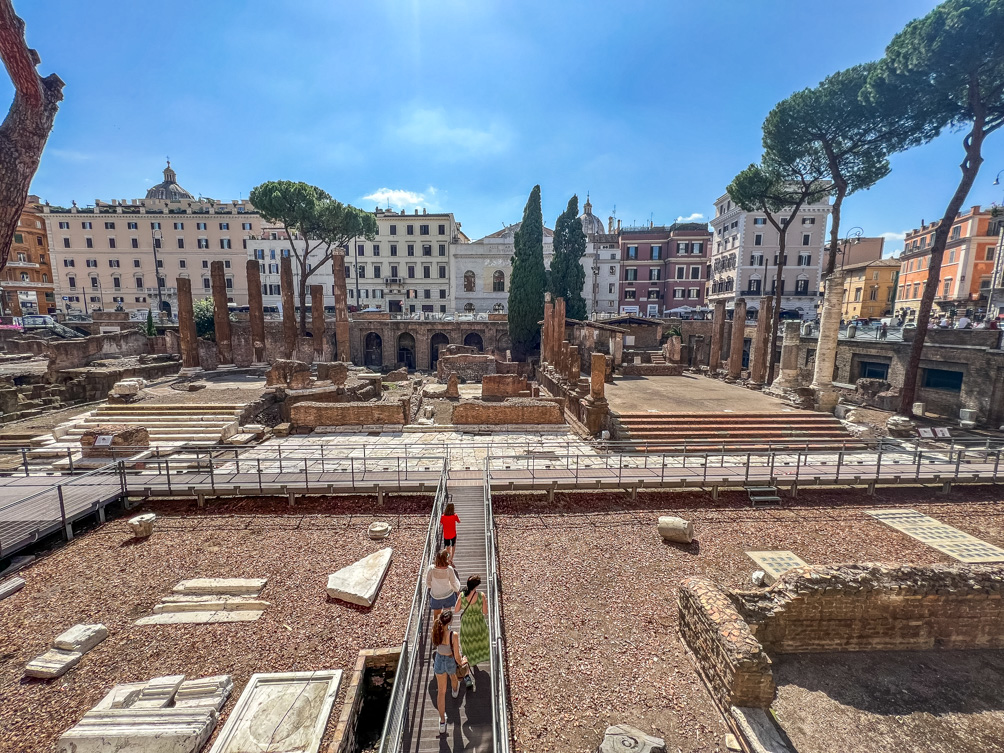
Finally, I’d recommend heading to Trastevere for an evening saunter since it’s very lively and you’ll surely want to visit again on another day. However, if you don’t have any energy left, alternatively grab dinner near your hotel and call it a night.
Late Evening: Ponte Sisto and Trastevere
Get to Ponte Sisto around sunset. Ponte Sisto is a pedestrian bridge with wonderful views over the River Tiber. Watch the perfect sunset here, overlooking St. Peter’s Basilica. Later, cross the river to the bohemian allure of the area called Trastevere.
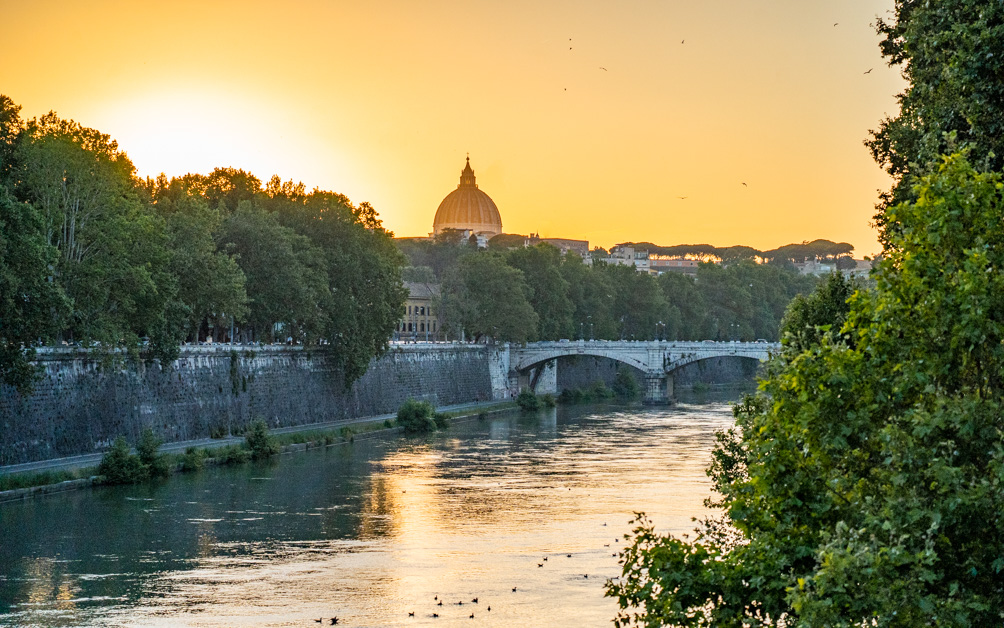
Trastevere’s charm lies not only in its narrow cobblestone streets with vibrant buildings but also in its lively bohemian spirit . The area is a cultural melting pot with vibrant nightlife and an array of authentic eateries. Wander around and discover hidden piazzas, indulge in local trattorias serving up Roman delights, and feel the heartbeat of Rome’s artistic and laid-back soul.
Have dinner at Tonarello , a casual eatery specialising in pasta, meatballs, and other simple Roman dishes. Plus, there is patio seating and an acoustic guitar. There is usually a huge queue that moves quickly since Tonarello has a lot of seating space. Anyone who has had a meal at Tonarello will tell you that the line is worth it.
Day 2: Vatican City and Centro Storico
Today, you’ll visit Vatican City. It is an independent city-state, the smallest country in the world, found within the city of Rome (yes, within) . It is the headquarters of the Roman Catholic Church and is ruled by the Pope. Why should you visit? Well, this is a place where art and faith converge, and trust me, you’ll be blown away by its beauty.
Early Morning: St. Peters Basilica
Timings: 08.00 a.m. – 07.00 p.m. The final entry is at 05.00 p.m. It is closed on Sundays, except the last Sunday of each month. See here for the latest timings . Cost: Free
Consecrated in 1626, St. Peter’s Basilica is the largest church in the world and is widely believed to be the final resting place of Saint Peter himself. The church is a masterpiece of Renaissance architecture . The church was designed by artists like Raphael, Bernini, and others, but the dome was designed exclusively by Michelangelo. Additionally, Pieta, the well-known sculpture by Michelangelo , is housed here.
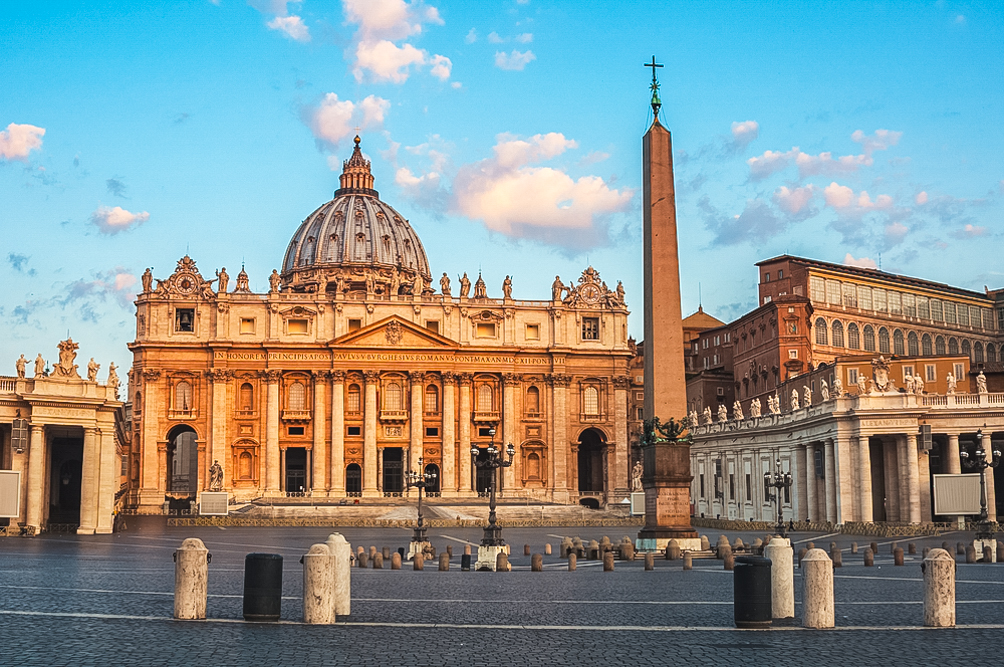
Although the Vatican is a country, you won’t even realise it when you enter it because there is no boundary wall or security. You can see St. Peter’s Square any time you want. However, to enter St. Peter’s Basilica, you will have to queue up for security , and usually, this queue is very long. Therefore, it is best to go here first thing in the morning, though I have heard that sometimes it can get empty at noon or late in the evening, but it all depends on your luck.
Additionally, you can climb the basilica ‘s dome for breathtaking views of the Vatican. It costs €8 if you take the stairs or €10 if you take the elevator. Unfortunately, you can’t purchase the ticket beforehand, only at the ticket counter. The queue for entry to the dome is always long.
Morning: Vatican Museums
Timings: Entry starts at 8 a.m. Closing time charges per season, and Sundays are closed except the last Sunday of the month. Check the timings here . Ticket Purchase: Buy your ticket here .
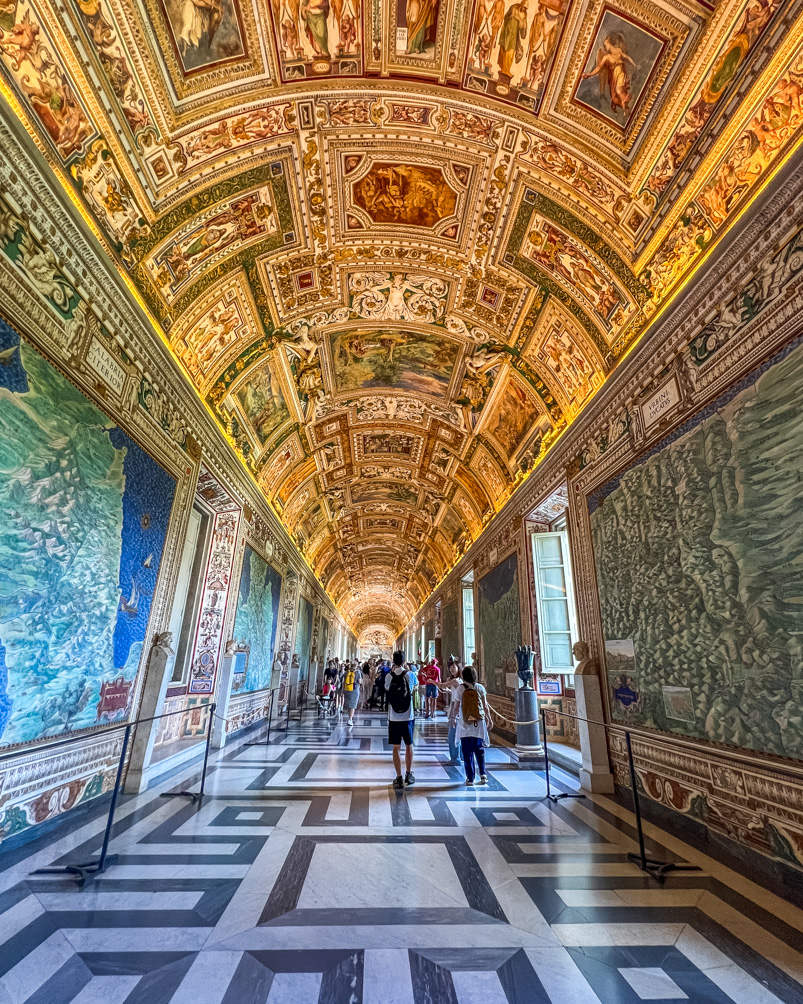
Founded in the early 16th century, the Vatican Museums are a set of 26 museums spanning 14 km that house an unparalleled collection of art (over 70,000 pieces) accumulated by various popes over the centuries. Don’t worry, you don’t have to visit 26 museums but rather pass through several galleries, as the museums are all attached.
The museums are fantastic. T he Sistine Chapel, adorned by Michelangelo’s frescoes, is the crowning jewel. The Sistine Chapel technically resides in the Apostolic Palace, home of the pope, rather than the Vatican Museums. However, the only way to see the Sistine Chapel is through the Vatican Museums, and all tickets to this site allow you to visit the Sistine Chapel as well.
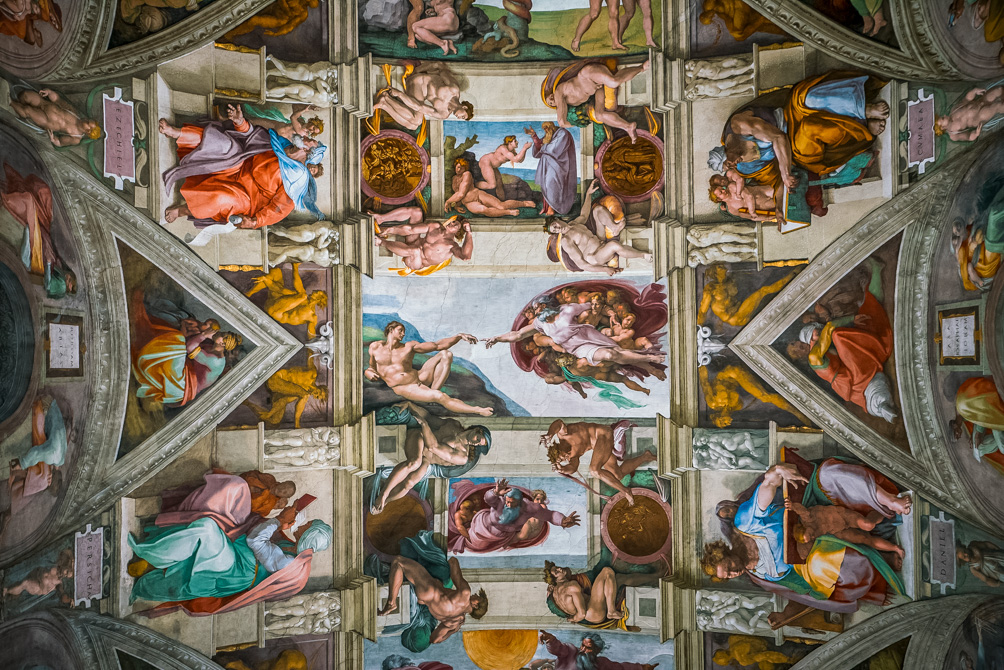
Tips to make your Vatican City visit a breeze
- The best way to see the Vatican is on a tour. Not only can you get into St. Peter’s Basilica early, but you can also avoid the long queue at the Vatican Museums. This is the way we did it! It’s not cheap, but I highly recommend it for saving tonnes of time by not queuing up and seeing the highlights in the Vatican Museum. It is also the best way to go up the dome for a limited time. Here are some tours we recommend. Early-Morning Vatican Museums and Sistine Chapel Tour : Start with the Vatican Museums at opening time and enter St. Peter’s Basilica via a secret passageway. Usually, you need to queue up twice to see both the sights—the Vatican Museums and St. Peter’s Basilica—and this tour is the only way to avoid it and thereby save tonnes of time. This secret passageway entry reduces your walking distance greatly! Do not take this tour on a Wednesday, as the secret passageway may be closed. Vatican Museums and St. Peter’s Tour with Dome Climb : Climb the dome first before seeing St. Peter’s Basilica, then finally head to the Vatican Museums and get in without lining up.
- If you’d like to stop and look at particular things for a long time or walk at your own pace, then tours might not be for you. In that case, here’s what I would recommend. Visit St. Peter’s Basilica at opening time. Queue up a bit before opening time so you’re one of the first ones to enter. You do not need to buy a ticket for this, as it is free. Just download and listen to the Rick Steves Audio Tour ‘St. Peter’s Basilica’ and walk at your own pace, admiring the most beautiful church on this planet. For the Vatican Museums, buy a skip-the-line ticket. The queue outside the museums is the biggest we have ever seen in our lives (over a kilometre long), so it is highly recommended to a get this skip-the-line ticket . Also, to see the most renowned pieces of art and understand the history around them, listen to the Rick Steves audio tour, ‘Vatican Museums’ and later ‘Sistine Chapel’
You are going to be famished after all that walking, so head to one of the restaurants nearby. We were at Ristorante dei Musei, which was a short 140-metre walk from the exit of the Vatican Museums. The Cacio e Pepe (a Roman specialty pasta made with pepper, Romano cheese, and spaghetti) was the best we tried in our time in Rome. The restaurant is rated 4.6 on Google, and we highly recommend it.
Afternoon and Evening: Walk through Rome’s Centro Storico
Rome is best explored on foot, along its winding lanes made of cobblestones, while taking in the scenery and stopping for gelato and nibbles along the way. You get a real feel for the city.
If you’d like to learn about the sights and city as well, then I highly recommend using the Rick Steves Audio Europe Guide ‘Heart of Rome’. It’s a free audio tour that’ll guide you on the walk, and you’ll gain fantastic insight into the city. Stop the audio guide wherever and whenever you like, and continue when you’re ready again. The distance you’ll cover will be about 3 km. Don’t forget to add the following spots to your walk, as they are not mentioned in the audio tour: Two Sizes (for Tiramisu) before Piazza Navona and St. Ignatius Church near the Pantheon .
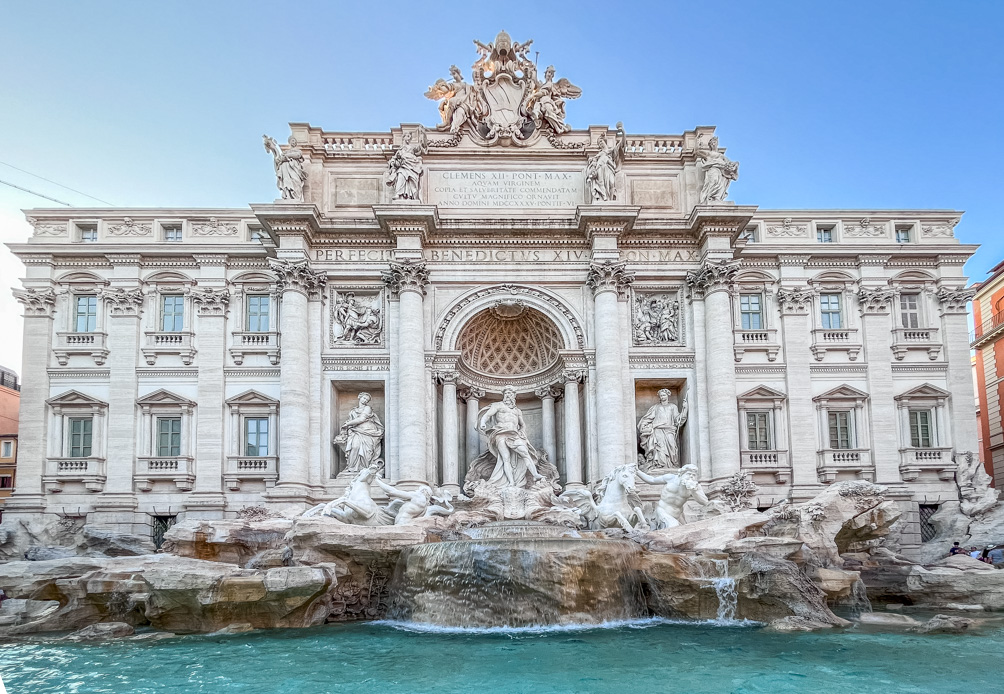
If you’re not interested in covering all the sights given in the app, just go to the iconic spots mentioned below. The distance you’ll have to walk will be about 2.7 km.
Rome Centro Storico Walking Route Map
- Two Sizes (for the best Tiramisu ever!)
- Piazza Navona : Our favourite piazza in Rome—it is so grand!
- Pantheon : The Pantheon is ancient Rome’s best-preserved temple. An engineering masterpiece from AD 125 featuring a massive dome that fills the interior with light. For 1300 years, the dome was the biggest in the world, and it is still the biggest unsupported dome in the world today. Entry is until 6:30 PM, and you will need to book tickets beforehand. See the tips below.
- Gelato at Giolitti : It’s a super old gelateria
- Church of St. Ignatius Loyala : See a beautifully painted ceiling, by looking through a mirror. Don’t forget to notice the fake dome!
- Piazza Colonna : The Obelisk here has beautiful intricate carvings (pictured somewhere above in this 3-day Rome itinerary)
- Trevi Fountain (have the Colosseum-shaped popsicle at Lucciano’s near Trevi) and toss a coin into the fountain to ensure your return to Rome.
- Spanish Steps : Nothing much to see but it’s a popular sight in Rome
- Pompi Tiramisu : Another Tiramisu we loved!
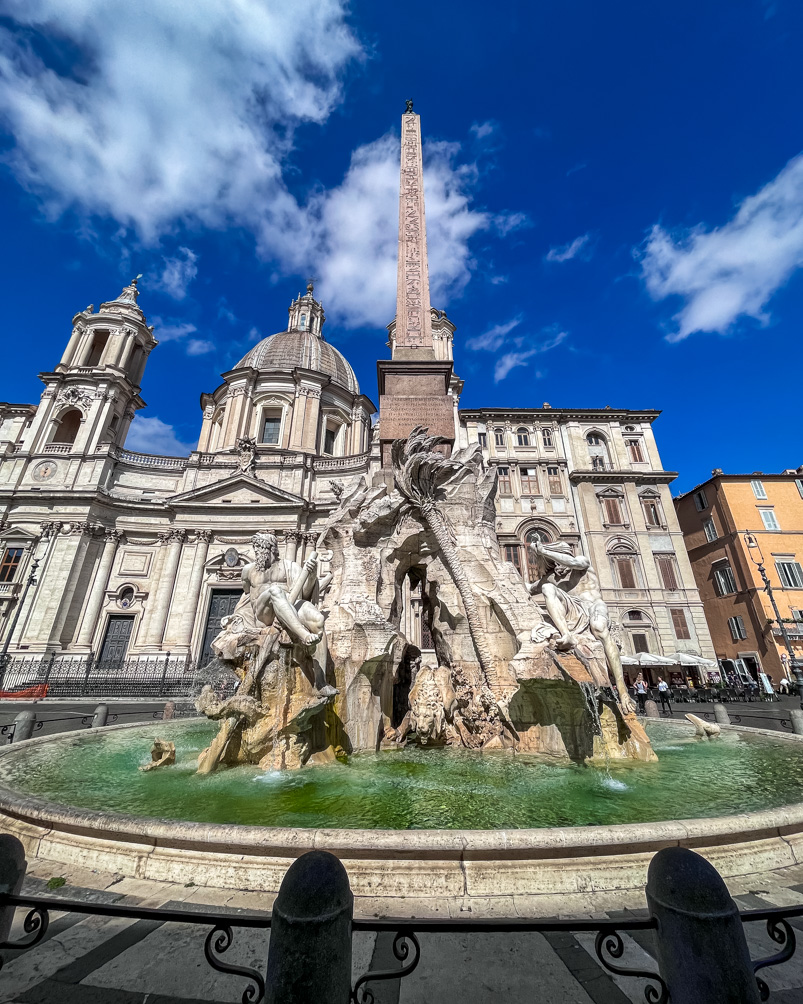
Tips for booking tickets for the Pantheon in Rome
The Pantheon used to have free entrance until July 2023. That’s when we went, and there was a lot of chaos. The lines to purchase the Pantheon tickets even now can be extra long. So it is best to purchase these beforehand, but unfortunately, it is not so straightforward.
- Purchase the ticket from the official website for €5 + 1 (convenience fee). You need to register yourself on the website before the purchase can happen. Two issues can come up . Firstly, not getting the verification email . Secondly, the website not accepting international credit cards . In this case, there is a workaround: select “Other Payment Methods” and choose the PayPal account option . If that also doesn’t work, then go for option 2.
- Purchase a ticket from here . It will cost more, but it will save you the headache of standing in a long queue and deal with an annoying website.
Day 3: Palazzo Colonna and Villa Borghese
Start your day by visiting the Trevi Fountain in the morning if you’d like to see it without the maddening crowds. It is best to visit between 5 and 8 a.m. to appreciate the beauty of the fountain in peace.
Later, head to Palazzo Colonna. However, if you’re not in Rome on a Friday or Saturday, then head to the Basilica di Santa Maria Maggiore. If you’re a superhuman that can make it to both of these spots, why not?
Morning: Palazzo Colonna
Timings: Fridays only for guided tours (English at 10:00 AM) and Saturdays between 9:30 AM and 1:15 PM Cost: €16.5-26.5 (short itinerary: €16.5 and full itinerary: €26.5 and Guided Tour: 31.5)
Read details and book tickets here .
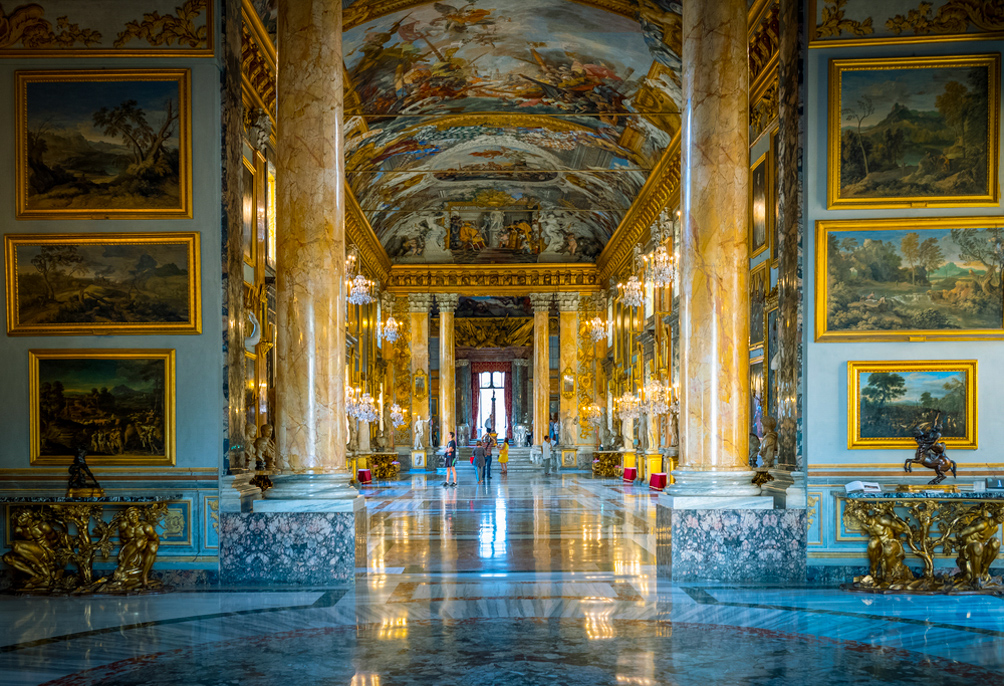
Palazzo Colonna is a masterpiece of Baroque architecture—an opulent palace that was the residence of one of Rome’s most prominent families that counted popes, princesses, and generals amongst their ranks over the centuries. The palace’s undisputed highlight is the awe-inspiring Galleria Colonna, or Great Hall, which is a glittering gallery full of paintings and frescoes.
If you’re not in Rome on Friday or Saturday, then you’ll have no option but to skip this attraction! You can alternately wake up a bit late or add in an attraction you might’ve missed on the previous day.
Morning: Basilica di Santa Maria Maggiore
Timing: 6 AM to 7:45 PM Entry: Free
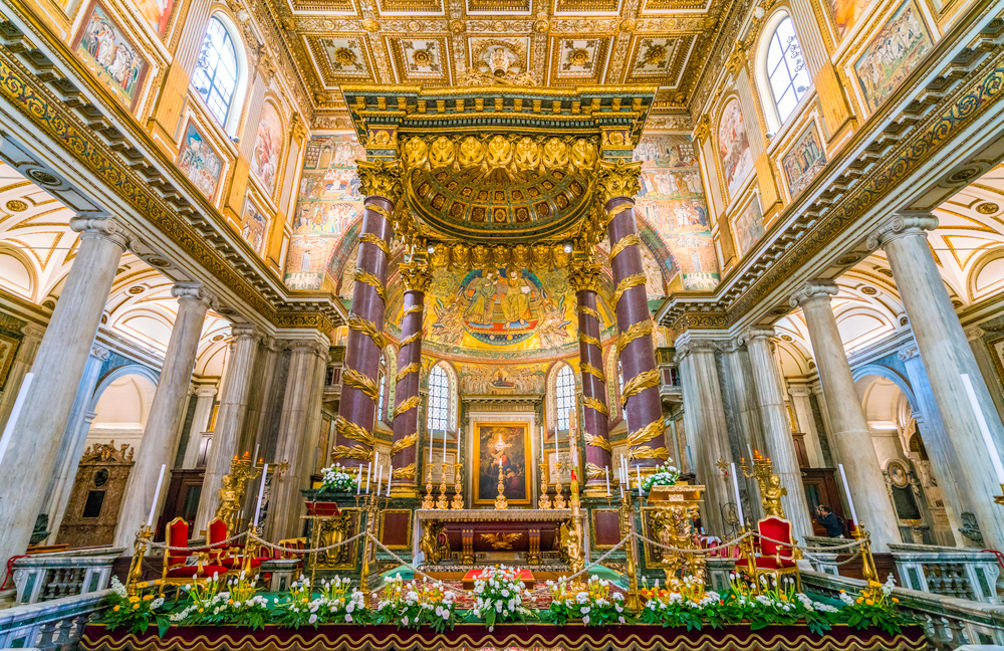
Constructed in the 5th century, the Basilica di Santa Maria Maggiore is one of the four major papal basilicas in Rome that was built after a miraculous snowfall in August. Inside, you will be treated to a visual feast of intricate mosaics and frescoes spanning multiple artistic periods. In addition, the basilica is home to Rome’s largest bell tower and the Sistine Chapel, which was built before its Vatican equivalent !
Afternoon and Evening: Villa Borghese
Timing: 9 a.m. to 7 p.m. in 2-hour slots. The last slot is at 5:45 p.m., is for 1 hour and 15 minutes, and is discounted. Cost: €13, plus a €2 online reservation commission. Book your ticket here .
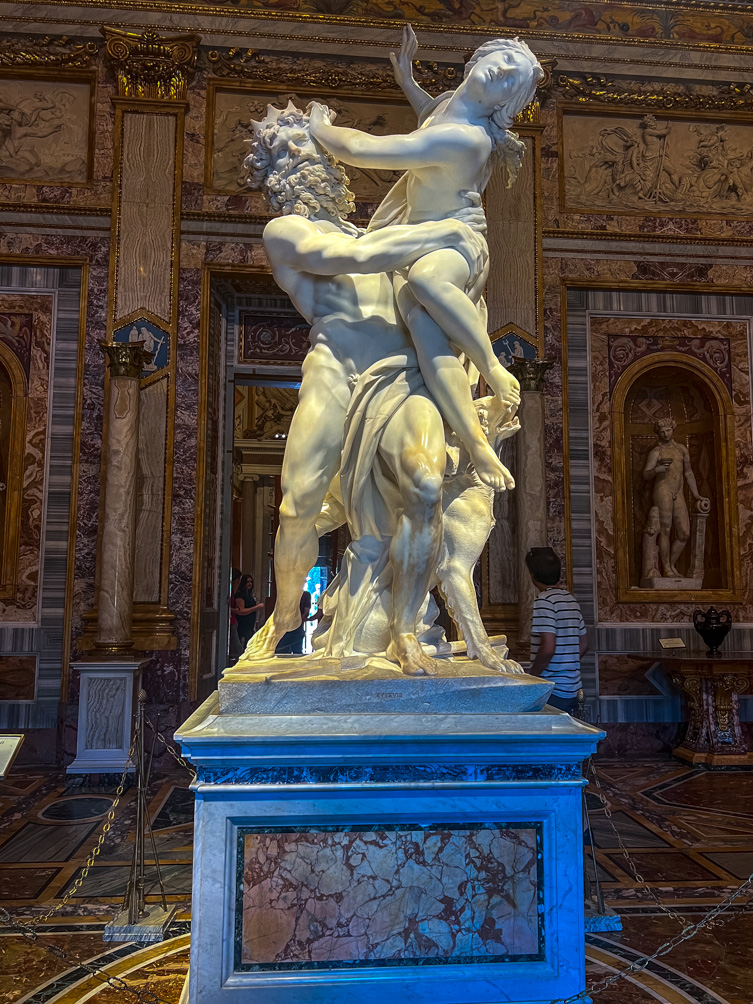
Villa Borghese is somewhere you can spend half a day easily. Explore the 17th-century Borghese Gallery , a villa constructed by a well-known noble family in Rome who were involved in politics and the Church (this family has produced a pope and several cardinals). Even though you have seen so many stunning churches and galleries in Rome, the gallery will still astound you . It houses a treasure trove of art, including works by Bernini, Caravaggio, and Raphael.
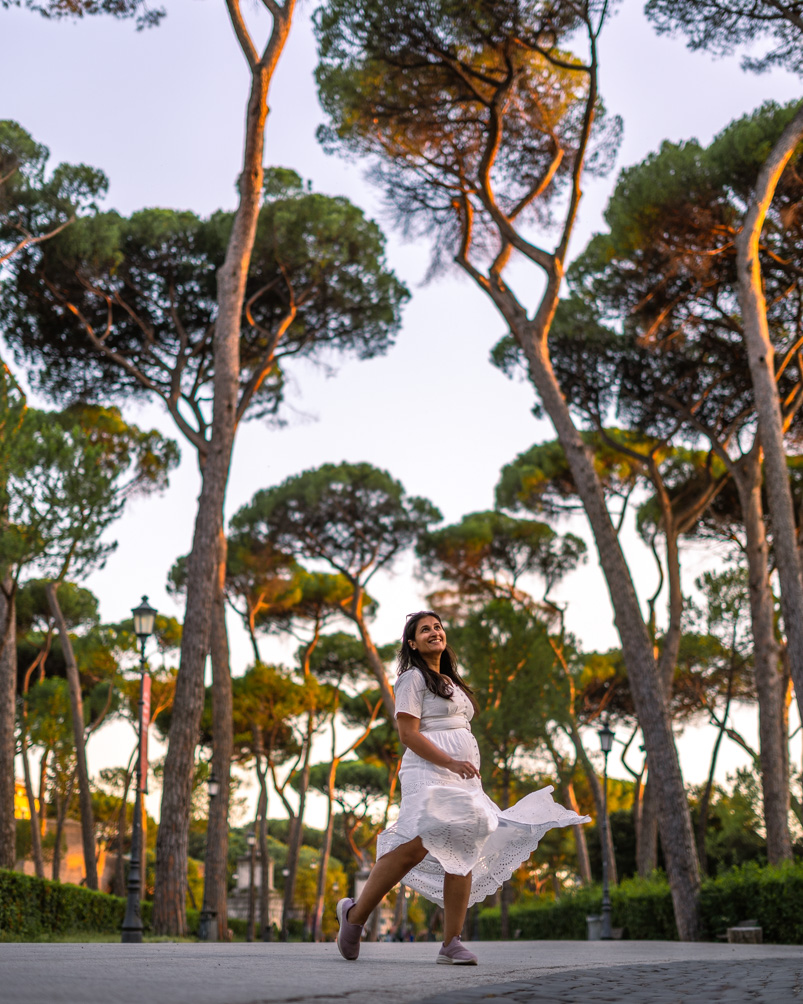
After or before the gallery visit, walk or cycle around its lush manicured gardens (which are free to access) and row a boat for 20 minutes on a serene lake with the backdrop of a temple.
Tip: If you’d like to visit the Borghese Gallery and the park, then I suggest renting a vehicle of some sort at the park entrance because the park is massive. Even getting to the Borghese Gallery from the entrance might be a bit too much for some (I had blisters on my feet from all the walking in Rome and would’ve loved to have a vehicle to see the park). There are plenty of options, like bikes, small golf karts, quad bikes, and Segways.
There is a restaurant in Rome that is known to be the birthplace of Alredo pasta. It is called Alfredo alla Scrofa. Head here for dinner!
How to Reach Rome City from the Airport
Rome has two airports. Leonardo da Vinci-Fiumicino Airport is the largest airport in Italy, hence the most used. It is located more than 34 km from the city centre. The other is Ciampino Airport , which is closer but still 16 km away from Rome. This airport is mainly used for budget airlines.
There are many ways to get to the city centre from the airports, including shuttles, trains, private transfers, and taxis.
The least expensive way to go from any of these airports to the heart of Rome is to take a shuttle bus to Termini train station , which is the main train station and has access to the metro. These transfers range in price from €6-7 , based on the specific airport. These shuttle buses are offered by two companies for both airports.
Buy tickets for a shuttle from Leonardo da Vinci–Fiumicino Airport : SIT Shuttle and Terravision .
Buy tickets for a shuttle from Ciampino Airport : SIT Shuttle and Terravision .
The train only connects the Leonardo da Vinci-Fiumicino Airport with the city and, hence, cannot be used for the Ciampino Airport.
You can take one of the two train options from the Leonardo da Vinci-Fiumicino Airport airport to the city.
- The Leonardo Express is a Trenitalia non-stop train connecting Fiumicino Airport with Rome Termini. It takes roughly 30 minutes and leaves the airport every half-hour, or every 15 minutes during peak hours. The train runs between 5:35 a.m. – 11:35 p.m. Tickets cost €14.
- The second option is the regional train called the FL1 . It goes to several stations in central Rome, but it does not go to Termini . You can get off at Trastevere, Tuscolana, Ostiense, or Tiburtina stations, depending on where you’re staying. Trains leave every 15 minutes or so, and the cost is about €8. This was the train we took, as our Airbnb was just across Ostiense Station.
It is best to buy the train ticket from the ticket kiosk at the station itself for the lowest prices . However, if this seems like it might be a headache on your first day (it even took us a bit of time to figure out the whole process), then you can also purchase the ticket for Leonardo Express online . After using the train, you might also have to use a bus, metro, taxi, or simply walk to get to your hotel.
3. Private transfer from the airport
If you’d like to reach your hotel directly without any hassle, then you can also book a private transfer. Your driver will wait for you once you exit the airport or the hotel. Some companies charge per adult, while others charge per group.
Price: €48 from Fiumicino Airport, €30 from Ciampino Airport
Taxis charge a flat fare from the airport to any place within the boundaries of the Aurelian Walls in Rome. Remember to only get a cab from an official taxi stand!
Important ! Before boarding the train, always get your train ticket validated from the smaller ticket machines you will find at the entrance to the train. These are usually green in colour and are quite small and easy to miss, so be on the lookout for them to avoid getting fined! If your ticket is purchased online, then validation is currently not necessary, but this may or may not change in the future, so it is always better to check.
How to Get Around Rome
Rome’s well-functioning public transport system makes getting around easy. Convenient transport to important sites is provided by the city’s network of buses, trams, metros, and trains. Simply use Google Maps to figure out how to get from one place to another, and it should show you all the possible options. Our recommended modes of transport are the bus, metro, and on foot!
Bus: Due to its excellent connection and few walking requirements, the bus was our preferred mode of transportation, especially on weekends when there was no rush Buses on weekdays can be chaotic, so set your expectations accordingly! You can find bus routes and timetables at the bus stops. Most buses run from early morning until midnight, with night buses operating during the remaining hours (if you’re out late, look out for bus stops with a blue owl symbol). We did not download any apps, but you can also download the Roma Bus App to plan your travel routes and stay updated on the go.
Do not forget to validate your ticket on the bus’s front, middle, and rear machines (see the photo below). If you don’t, you could be fined roughly €60 .
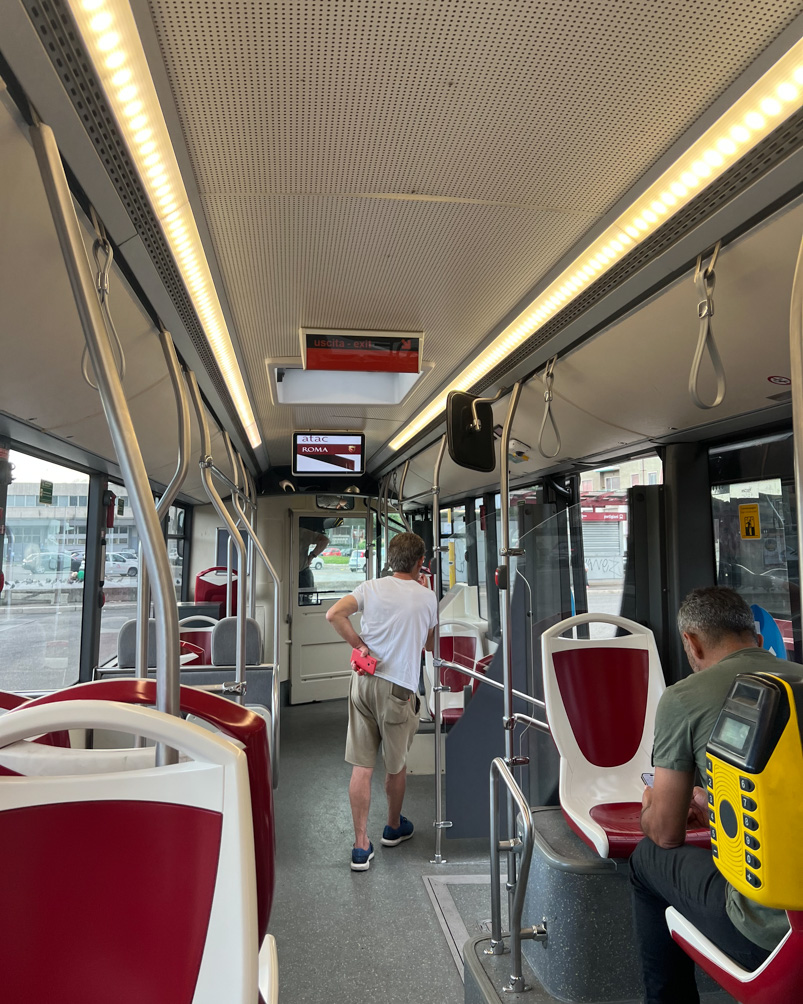
Metro: Obviously, you avoid all the traffi c, making this another excellent mode of transportation. The metro runs every day from 5:30 a.m. to 11:30 p.m. and until 01:30 a.m. on Saturdays. However, we didn’t use the metro as much.
On foot : The rest of the time, you’ll be walking on foot, and trust me, this can be amazing. Walking down Rome’s meandering cobblestone lanes reveals many of its enchanted nuances. That being said, let me warn you that you might be walking much more than you’re used to (think 15000–20000 steps a day), and that too on cobblestone streets, so please wear the most comfortable pair of shoes you own . If you’re staying in the city centre, most places will be accessible by foot!
While trams are also available in Rome, you will likely not use them on this Rome itinerary except maybe to travel between Torre Argentina and Trastevere because trams aren’t available in the Centro Storico.
Hop-on, hop-off bus transport is more expensive than regular ATAC transport unless, obviously, you’re getting a tourist card.
E-bikes and electric scooters are two more well-liked modes of transportation. While these can be fun, I would recommend not relying on them throughout your time in Rome, as there are some safety risks as helmets are not provided and traffic in Rome can be crazy. But if you’d like to, we’d recommend Bird and Dott for e-bikes and Lime for electric scooters. Remember that only one person per vehicle is allowed
Tips and Must-Knows for Public Transport
- All public transport (ATAC) , including trams, buses, metros (except tourist buses), and some regional trains (Trenitalia 2nd class, Roma-Lido, Rome-Viterbo, and Rome-Giardinetti), are covered by the same ticket. But you can’t use these tickets to travel to the airport!
- Once the ticket is validated, it can be used on multiple modes of ATAC transport within 100 minutes to get to your intended destination.
- On all ATAC transit, children under the age of ten travel free when accompanied by a paid adult.
- You can choose from several different metro or bus tickets:
- BIT Ticket : You may take the tram, bus, and metro for seven days with this 24-euro ticket.
- Roma 24H/48/72H Ticket : This is valid 24, 48, and 72 hours after activation, respectively, costing 7€, 12.5€, and 18€. I highly recommend getting the 72-hour ticket for this 3 days in Rome itinerary.
- CIS Ticket : With this ticket of 24 € you can travel for 7 days on the tram, bus, and metro.
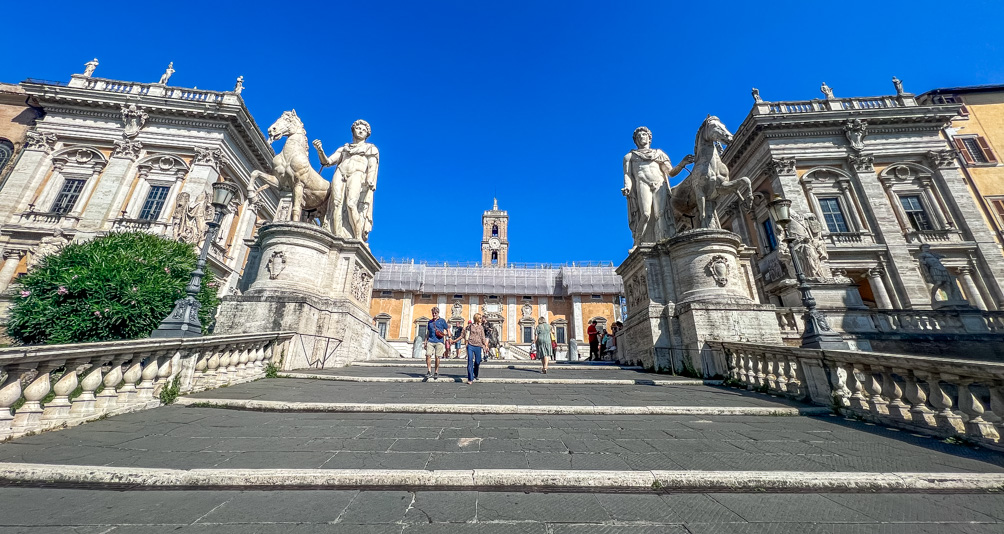
Is it worth buying any Rome City Passes?
The Go City Pass and the Omnia Pass seem to be extremely expensive and not worth it for this itinerary. However, I’m linking them both so you can make an informed decision.
The only pass worth considering for this itinerary is the Roma Pass. Let me list down the benefits per the Roma Pass Website.
- The first 2 tourist sites are included
- Reduced ticket prices for all tourist sites visited thereafter
- Free use of the city’s public transport for the validity period of the card
- Discounts for exhibitions and attractions
- Dedicated booking arrangements for tourist sites
- Free access to toilet services of the P.Stop network
- Valid for museums and public transit for 72 hours following the initial validation.
Does this benefit you?
If you follow this itinerary, then buying the Roma Pass may turn out to be Euro 5 more expensive for you if you enter all the main sights but do not enter the Capitoline Museum or Largo di Torre Argentina . If you enter one or both of the aforementioned sites, then you will save Euro 6.5–7.5 by buying the Roma Pass.
The benefits and savings from the Roma Pass increase as you go to more and more paid sites that are listed in their brochure within the pass validity period.
All in all, I do not think there is any need to buy the Roma Pass if you’re following this itinerary. If you’re adding some other sights to your itinerary that aren’t mentioned below, then I would suggest going through the details of the Roma Pass by yourself to ascertain if you’re going to benefit from it or not.
Other Tips for Visiting Rome
- Secure your access to popular sites by booking tickets in advance , particularly for attractions like the Colosseum, Vatican, and Gallery Borghese. This 3 days in Rome itinerary has the ticketing websites mentioned for easy bookings.
- When dining, venture beyond the tourist hotspots to discover authentic trattorias where locals savour their meals. Do not follow ‘where to eat guides’ guides you find on Instagram unless they are by locals. However, we have provided a few dining options that we enjoyed.
- Beware of the scams. Read more about it here. And always be careful with your belongings, as pickpocketing is a huge issue in Rome.
- We recommend downloading the Rick Steves Audio Europe App for the best free tours possible. Throughout the itinerary, I have mentioned these guides so you’re well aware of where you can use them. Download each guide before you set out for the day, and don’t forget to carry earphones to listen to them.
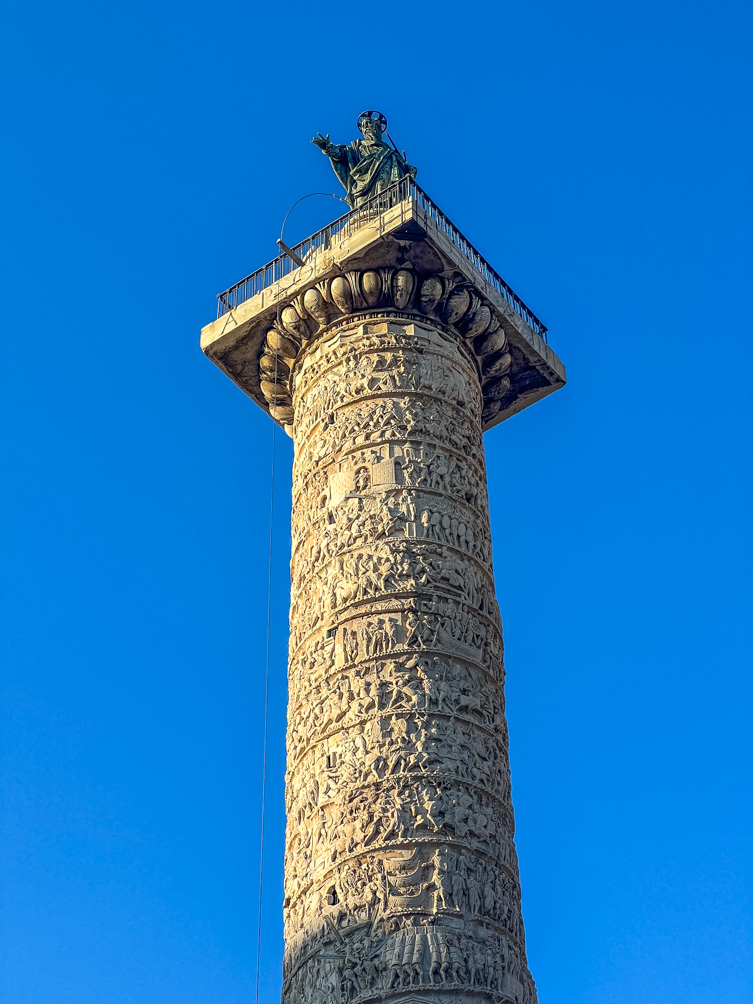
- Remember that the Vatican is closed on Sundays, and Colonna Galleria is only open on Fridays and Saturdays. Switch around the days on your 3 days in Rome accordingly. This itinerary works perfectly if your day 1 is Wednesday or Thursday; otherwise, you may need to switch the days around.
- Rome has multiple attractions that are free on the 1st Sunday of every month: Colosseum, Pantheon, Roman Forum, Capitoline Museums, Borghese Gallery, etc. However, certain locations (like the Borghese Gallery) require reservations; the only way to secure a spot is to give the attraction a call.
- The Vatican Museums are free to visit every last Sunday of the month from 9 a.m. to 2 p.m .
- Remember to cover your knees and shoulders when entering churches ; otherwise, you may not be allowed inside
- You will not need to buy drinking water in Rome . Rome is renowned and prides itself on its availability of fresh and clean drinking water. Carry a refillable water bottle and fill it at any of the water fountains in the city. These fountains will have a long nose or spout. You can drink directly from it too by blocking the main nozzle, which will direct the water upwards through a secondary hole on the spout. If the water is not drinkable, then a signboard will mention ‘aqua non potabile’
That’s all for the 3 days in Rome itinerary. I hope you found this blog post helpful in planning your trip. Do let me know what you found most useful, and leave your questions in the comments sections below. I would love to help!
Other Reads from Italy
10 Days in Italy Itinerary 2-Day Florence Itinerary A Day Trip to Lake Como from Milan Cinque Terre in One Day How to Visit Saturnia Hot Springs in Tuscany 4-day Road Trip Itinerary for the Dolomites
This blog post, ‘3 Days in Rome Itinerary’, has affiliate links that enable us to earn a small commission when you make a purchase, with no extra cost to you. We only recommend products and activities we like and those that might interest you. If you like any suggested product, do buy from the given links.
Leave a Comment Cancel Reply
Your email address will not be published. Required fields are marked *
Save my name, email, and website in this browser for the next time I comment.
How to see the best of Rome in one day: Rome city center itinerary (with recommended food stops!)
Tried and tested, beautiful itinerary to see the best of Rome in one day. Perfect Rome itinerary for first time visitors to Rome to make the most of your trip to Rome even if you only have a day in the Eternal City.
Visiting Rome in a day requires a good bit of prioritizing, there is just so much to see there!
However, you may be surprised by how many of Rome’s most famous sites can be seen in the space of the same afternoon.
While not little, Rome’s city center is pretty compact and if you have a good itinerary such as the one on this page, you can quickly tick off your list very many locations, sometimes having to walk a little bit, some other times so near each other you will hardly believe your eyes!
I often go to Rome city center to binge on its attractions and it is on the basis of my walks that I designed this Rome city center itinerary.
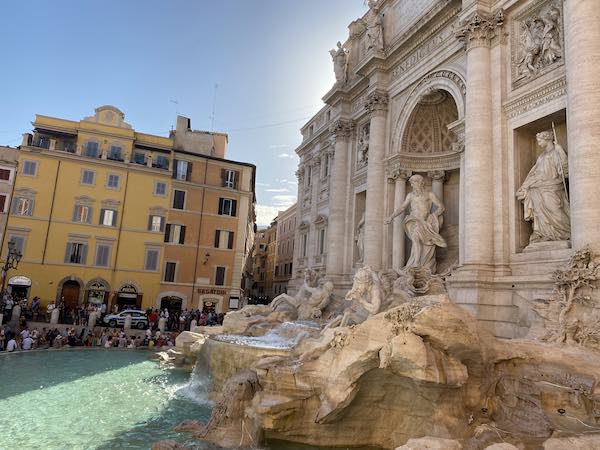
I have written this itinerary to see Rome in one day following an order of attractions that limits the number of times you need to retrace your steps and go around in circles.
Nevertheless, depending on when you are staying you will find it is easy to shuffle things around and visit all these places in a different sequence.
If you are unsure about the location of certain attractions compared with one another, have a look at our sightseeing planning tool here
Table of Contents
How to use this 1 day in Rome itinerary
However you decide to do it, take into account the following:
- If planning on visiting a large attractions such as the Colosseum of the Vatican, plan your day around it.
Book as early as possible to get a convenient slot and plan the rest of the day around the time of visit you can secure, not the other way round.
The Colosseum can take as little as 1,5 hours to see, The Vatican realistically will take at least 3 hours.
If you want to see Rome (as opposed to just one to two of its attractions) , I recommend you only pick one of the two. If you want to see two, you can start with the Vatican early morning and the Colosseum in the evening.
- The Colosseum is a little detached from the rest of the attractions so it makes sense to either start or finish your visit day there.
I suggest you keep it as a last stop if you are taking the evening visit.
Otherwise, start your day here and instead spend your evening around piazza Navona, which has more restaurants and wine bars for a pleasant meal out.
- If you want to see the Vatican museums you need to arrange your whole day around it.
You can visit the Vatican and stretch to Rome city centre in a day but this will only really leave time for a glimpse of one location, for instance Piazza Navona or Campo de’ fiori.
This is why a visit to the Vatican is not included in this itinerary if, on the other hand, you want to see St peter’s from outside, you can fit it in with the rest: the colosseum is the furthest from it so wither stay local or plan on taking the bus from one to the other.
If you need help with understanding public transport in Rome, find our guide here .
Good to know : if you only have one day in Rome, you may feel you need to pay a premium to get skip th like tickets and make the most of your time. I have good news! Big attractions in Rome now have timed entrance tickets so if you buy them online, there is no line! No need to pay a premium, just buy timed entrance tickets from the occigual websites and you’re ok!
Please note: this post contains affiliate links and, should you make a purchase through them, we might make a small commission, at no extra cost to you.
One day in Rome recommended itinerary: with recommended food stops!
Stop 1 of our one day in Rome itinerary: Colosseum (and Forum)

The Colosseum, Roman Forum and Palatine Hill are ancient Rome and a wonderful first stop for a Rome itinerary for location and visual impact.
Come here for the first Colosseum visit of the day and visit either in your own time or with an express tour to make the most of your short time in the city.
You can find here >> standard entry tickets
Or here >> my recommended, fast tour of the Colosseum (suitable for all visitors, including families with babies and toddlers!)
TOP TIP : The Colosseum, Roman Forum and Palatine Hill are one beside the other and you access them with the same ticket. I recommend you visit the Colosseum, then go for coffee nearby and finally take a stroll across the Forum. This way, you get a taste for the Forum / Palatine without the visit taking up all your day.
- These are my tips for visiting the Colosseum
- And this is all you need to know about visiting the Roman Forum
Cute coffee places nearby:
Cafe Cafe, via dei Santi Quattro 44
In the park on the hill in front of the Colosseum you also have a cute kiosk with coffee, juices and tables in the shade with colosseum views (a great spot if you have kids too)
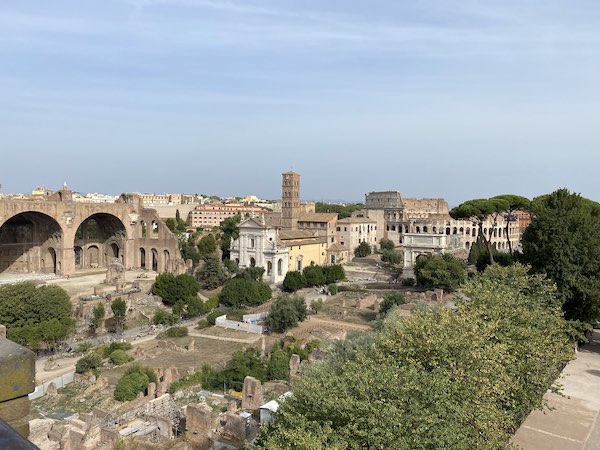
Stop 2: Piazza Venezia and Campidoglio
A short walk away from The Colosseum lies piazza Venezia.
The square is beautiful and famous for several reasons including the presence of one of Rome’s most peculiar monuments, the Vittoriano.
You are sure to have seen pictures of it and you will immediately spot it for size but also for its well-deserved nickname: the typewriter or, as English speakers often call it, the wedding cake!
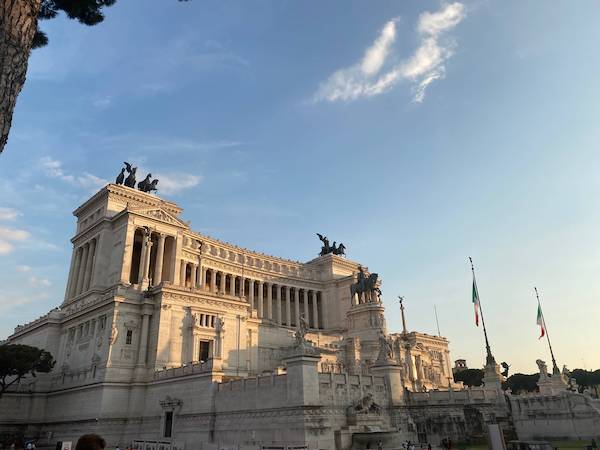
The Vittoriano is built over several terraces and the one on the first and second level have free access (the one of the top floor, on the other hand, has ticketed entrance: cost is 10 Euro at the time of writing).
A climb up the Vittoriano is worth is: I particularly love the terrace to the left of the monument, which overlooks the Forum and Trajan’s market, one of the best views over Rome !
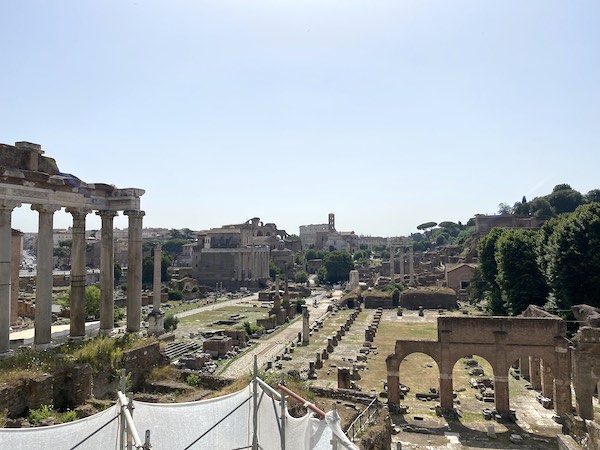
Behind it, sits on one of the most beautiful spots in the whole of Rome: the Campidoglio hill.
Do take the time to climb up and enjoy both the square with the large Marcus Aurelius statue in the center and the view over the forum from behind the main building.
For an extra treat, head to your left when leaving the piazza and take in the view from Terrazza Caffarelli.
This is a lovely place any time of the day however, if you come in the morning you get the clearest view. If, instead, you prefer a romantic atmosphere, I recommend sunset: at that time, this is one of the most romantic spots in Rome !
In Piazza Venezia, you will also find Palazzo Venezia and the balcony from which Mussolini spoke the II world war declaration and the beautiful Trajan’s Column , the ‘first film in history’, both worth noticing.
Good to know: the Campidoglio is open day and night. In the evening, the forum is lit and the view fantastic!
Stop 3 – lunch
Depending on your pace this may be a good time to stop for lunch. Recommending a place to eat in Rome city center is honestly too hard for me to do: too much choice and too many options – sit down, sandwich, pizza?
With one day in Rome, my preference would be to have a stand up lunch (pizza al taglio is a good option) and reserve time for a proper meal in the evening.
If you want a sit down meal, I recommend Enoteca Corsi which is a very local and nice lunch spot. Via del Gesù, 87/88, 00186 Roma RM, Italy
You can find here >>> my complete guide to Rome for foodies , with many recommendations and Rome restaurants I love.
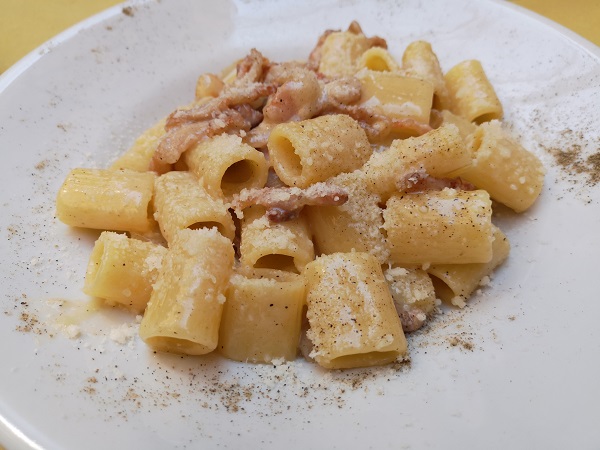
Stop 4 – The Pantheon
A short stroll along via del corso brings you close to the Pantheon , one of the most atmospheric corners of Rome.
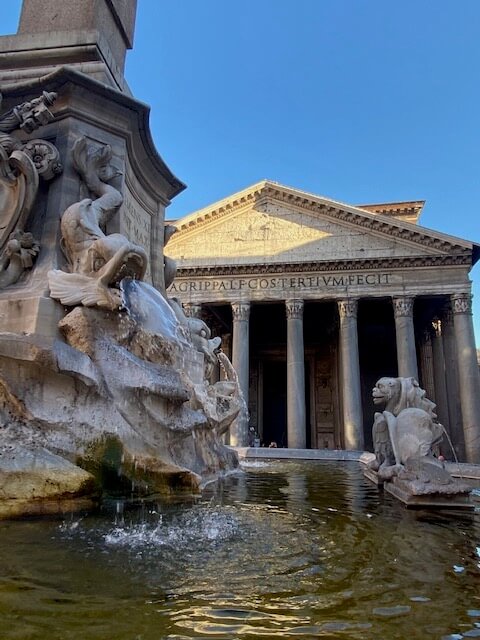
The old temple is now a church and packs a punch in terms of beauty and charm thanks not just to its incredible facade and architecture but position.
The Pantheon is in the middle of Rome’s famous cobbled streets and a delight to visit.
Since summer 2023 the Pantheon is ticketed: you can book tickets in advance or queue on the day, should you happen to be here at a quiet time.
Read here: how to book Pantheon tickets
Stop for coffee at:
Make our visit even better with a coffee in nearby Caffe’ Tazza d’oro, one of the best in the city ( find all our favorite here ). Prefer gelato? You can get a delicious one near the Pantheon too: find out where here.
Stop 5 – Piazza Navona and Campo de’ Fiori
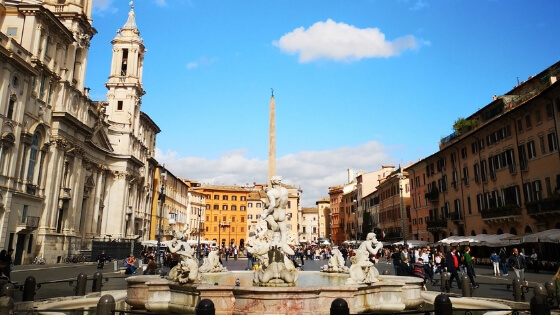
Piazza Navona and Campo de’ fiori are two of Rome main square and I put them under the same heading as they are very close to each other, on the two sides of Corso Vittorio.
However, they are very different from each other. Piazza Navona is grand and monumental while Campo de’ fiori is dusty and ‘real’, traditionally the location of a morning market.
Visit Piazza Navona first and then head to Campo de’ fiori for aperitivo for the best experience.
Stop 6 – Spanish steps and Trevi fountain
No Rome itinerary would be complete without a stop in Piazza di Spagna and Fontana di Trevi , among the best known sights in the whole city.
You can visit both much earlier in the day but I think it is worth keeping them last since they tend to get very crowded.
The evening is your best bet to see them without clouds of tourists literally obscuring your sight and they are super romantic thanks to the lights that get them to sparkle as Rome evening settles in.
Stop 7 – dinner
If you have followed this one day itinerary at this point you are happy yet tired and ready for dinner.
The options in Rome are endless and you can choose between staying local to Trevi, head again towards Piazza Navona (in which case I love enoteca Cul de sac and Mimi and Coco) or even get a cab to Trastevere for seeing one extra bit of Rome and traditional Rome food . I love Tonnarello there.
However, you end your day, I hope you will have enjoyed your visit and this post helped you answer the question: what is the best itinerary to see Rome in one day?
Safe travels!

This Rome in a day itinerary was published in 2019 and has been fully updated with recent food and tour recommendations in September 2023
My name is Marta, I am a travel-loving mama born and bred in that messy, wonderful, infuriating, awe-inspiring unbelievably beautiful city that is Rome. A classics graduate and professional travel blogger, on this site I share my insider tips to help you plan your dream trip to Rome, Italy.
Visiting Rome with kids: tips + all you need to know (by a local mom)
Christmas markets in rome you will love this holiday season, you may also like, what to wear in rome in june: full..., rome scavenger hunts for kids you’ll love (with..., how to see rome in two days: perfect..., how to enjoy rome on a budget: 22..., fun and interesting facts about the colosseum for..., christmas markets in rome you will love this..., visiting rome with kids: tips + all you..., the pasta making class in rome you’ll love:..., free things to do in rome you’ll love..., how to buy tickets for the pantheon +..., privacy overview.

5 Days in Rome Itinerary: What To See & Do
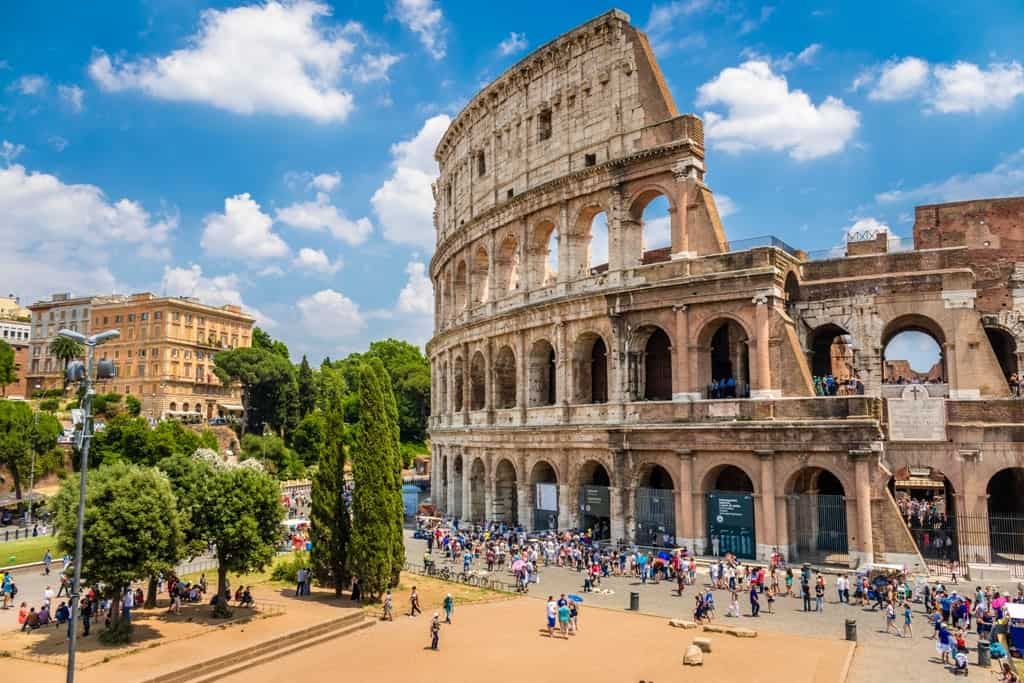
This post is also available in: French
5 days in Rome is the perfect amount of time to see the popular attractions, get off the beaten path, and spend some extra time exploring. This 5-day Rome itinerary will show you exactly how to optimize your time in this ancient city and see everything on your bucket list.
Spending five days in Rome is enough to make you relish in this splendid open-air museum, and being there I couldn’t help but be transported to different eras with every masterpiece I encountered.
Dotted with treasures, with history, myth, and legend – Rome is a city unlike any other. Having five days to spend in Rome is a great way to get a taste of the city’s mysteries and glamour! Here’s how to fit all the major attractions in five days.
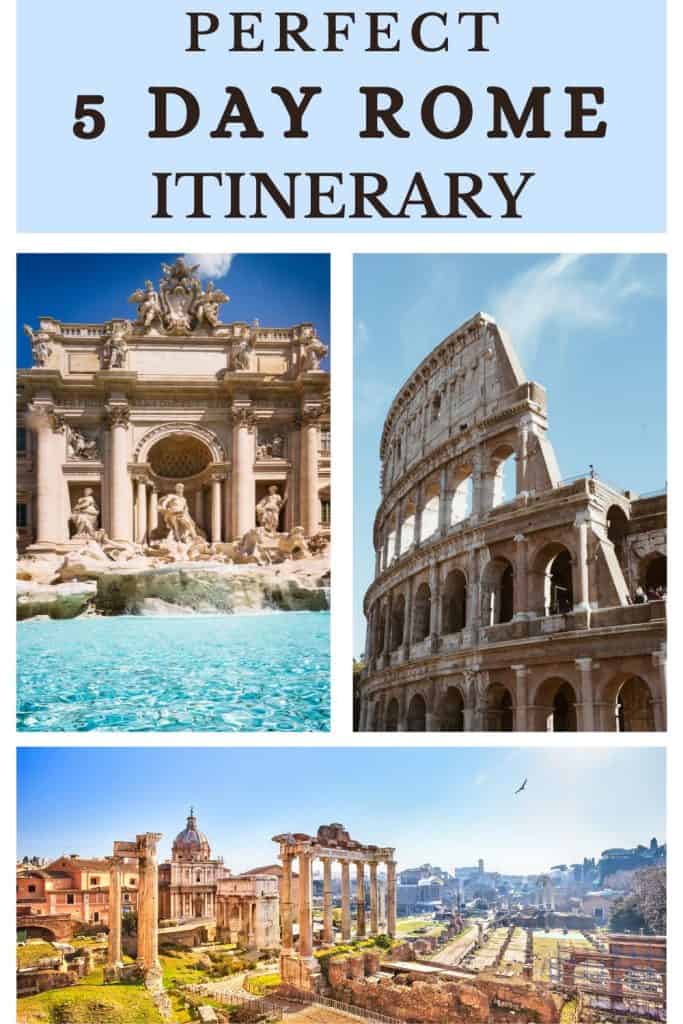
Disclaimer: This post contains affiliate links. This means that should you click on certain links, and then subsequently purchase a product, I will receive a small commission.
Table of Contents
Rome Quick Guide
Planning a trip to Rome? Find here everything you need: Top-Rated Tours and Day Trips to Do in Rome: – Colosseum, Roman Forum, Palatine Hill Fast-Track Tour – VIP Colosseum Underground Tour with Roman Forum & Palatine Hill – Borghese Gallery Tour & Tickets: With Bernini, Caravaggio, & Raphael – Pristine Sistine, early entrance small group Vatican tour – Vatican Museums, Sistine Chapel, and Basilica Tour – From Rome: Pompeii and Mount Vesuvius Day Trip with Lunch Where to stay in Rome: Navona Colors Hotel (close to Navona square), Palazzo Medusa (near Navona Square), Piazza Del Gesu Luxury Suites (near piazza Navona)
How Many Days In Rome Is Recommended?
This is almost a trick question. If you’re short on time you can squeeze a lot of Rome’s best sites into a 2-da y or 3-day itinerary …but I truly feel that to give a real feel for the city, you’ll need about 5 days in Rome.
With 5 days, you can see all of the major attractions in the city without rushing, plus have plenty of time to wander, relax, and really just soak up all that the city has to offer. Depending on the time of year you visit, Rome can be super crowded and you’ll need to reserve specific time slots at many of the attractions.
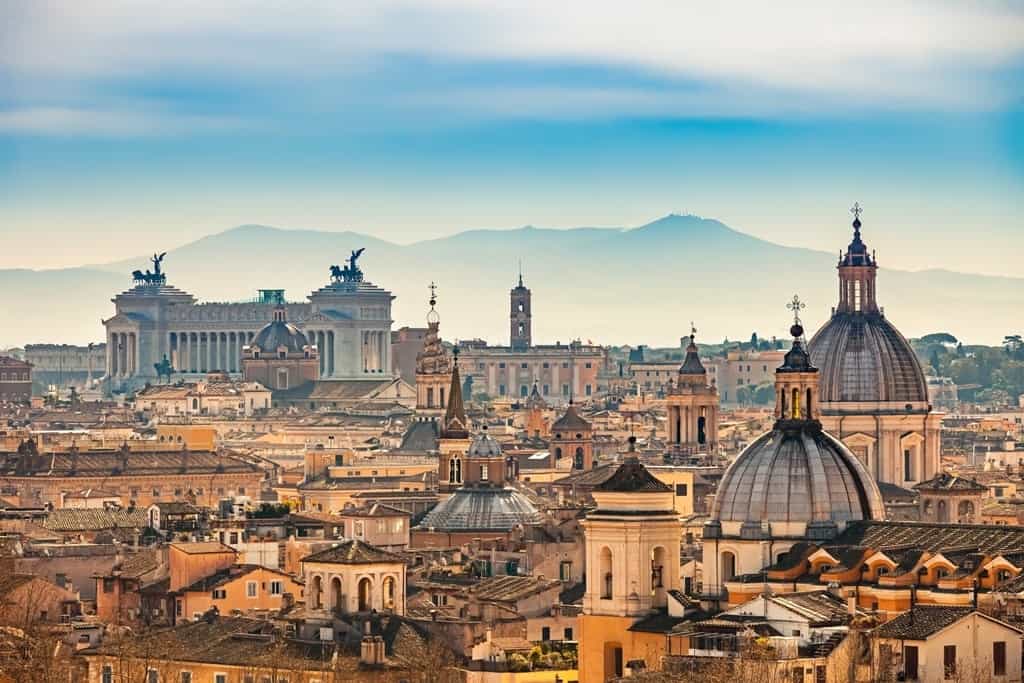
Where to Stay in Rome
The Orange Hotel : The Orange Hotel offers incredible design, proximity to the most major sites, and a very quintessential vibe that reflects Italian architecture. The rooms are modern and spacious, a breakfast buffet with Italian delicacies is served daily on the rooftop restaurant, that enjoys views of St Peter’s Basilica. The neighborhood is lovely with the Vatican and a metro stop just steps away. There was also a great choice of restaurants, bars, and shops nearby. Click here for more information and to check the latest prices. Royal Rooms – Via Del Corso : You could stay at Royal Rooms which is about 201m away from Via Margutta and enjoys all types of amenities – from shopping, nearby plazas, cafes and things to do, along with amenities like a bidet, shower, hairdresser and much more. – Check here the latest prices and more details. Palazzo Medusa : Located just outside Palazzo Medusa, this property is one of the best in Rome and is a lot of people’s top pick there. Not only do you get a large TV, bathroom, hairdryer, and more, you also get to enjoy a wonderful gastronomic experience, bike rental, and super comfy beds! – Check here the latest prices and more details. Navona Colors Hotel : The thing about Navona is that it sells well and it sells fast. It’s an incredible choice for travelers – there is food, the city walks around, and bike rental. But there’s also the unbeatable location of being 192 m from Piazza Navona. You’ll thoroughly enjoy the Baroque architecture of the hotel.- Check here the latest prices and more details. Piazza Del Gesu Luxury Suites : This is where comfort and slide go hand in hand, and the hotel itself has a hard to compete with the location. Located directly on the Piazza Navona, this hotel is a 5-minute walk away from history – the Pantheon… You’ll also enjoy free city views, free WI-FI, furnishings, and everything you need.- Check here the latest prices and more details.
Check out my post on the best areas to stay in Rome by a local .
How To Spend 5 Days in Rome: A Detailed Itinerary
- Day 1: Pantheon, Piazza Navona, Campo dei Fiori
- Day 2: Piazza Venezia, Monumento Nazionale a Vittorio Emanuele II, The Roman Forum & Palatine Hill, Colosseum
- Day 3: Villa Borghese and Galleria Borghese, Piazza di Spagna and Spanish Steps, Fontana di Trevi, Via Veneto, Via del Corso,
- Day 4: Vatican City, St Peter’s Basilica, Castel San Angelo,
- Day 5: Day trip to Pompeii, or Food Tour, or Pasta Making Class,
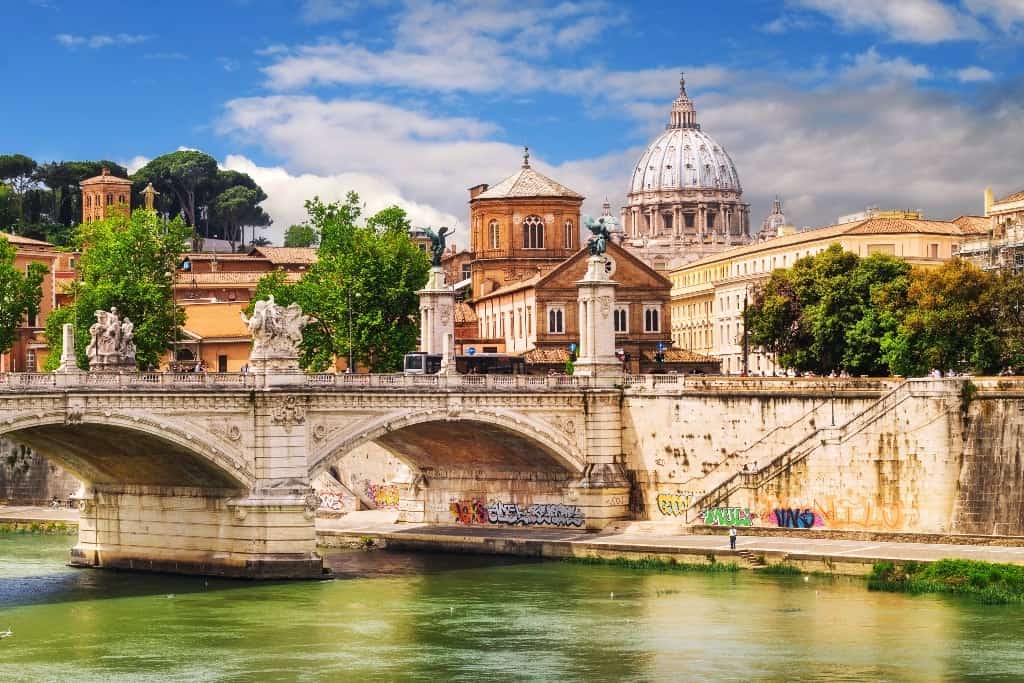
5 Days in Rome: Day One
After arrival, I spent some time in my hotel settling, taking everything in, and ready for all the sightseeing I would be doing in the next few days. I decided to make the Pantheon my first stop!
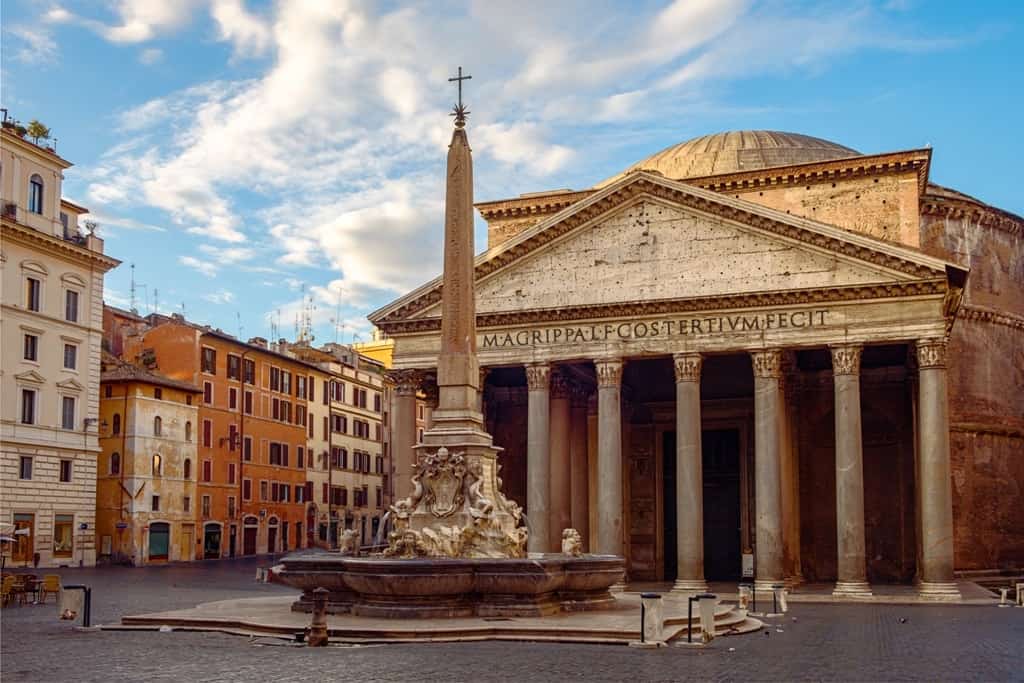
The Roman Pantheon, the most complete and best-preserved Roman building (and building in general) in the world is a sight to behold. The concrete structure is the largest in the world, and the building is simply wonderful. Interestingly enough, on the walls, you can see the dates that reveal the age – a structure dating back to 125 A.D!
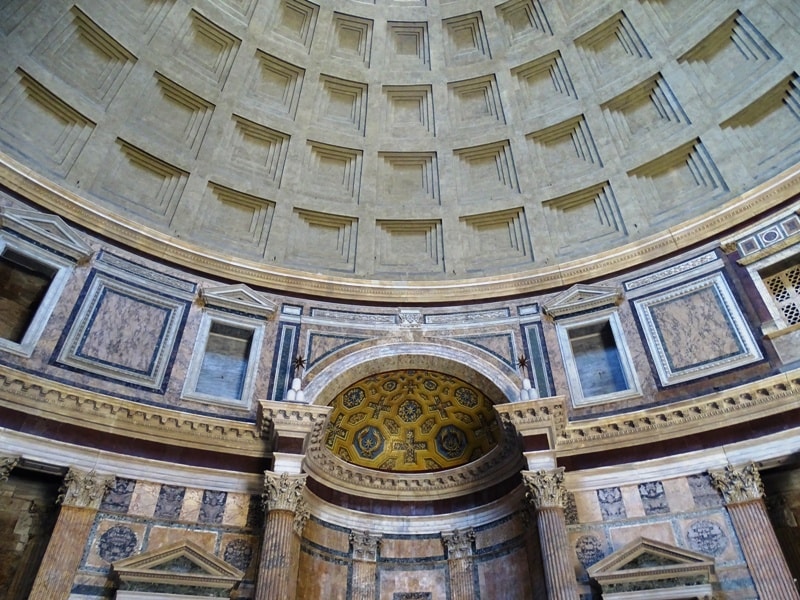
Apart from the exterior, the interior itself is even more impressive. The Oculus inside is the only source of light, and you’re advised to stay silent, so the play of lights, architecture, the dome, and the designs inside along with the silence made this experience so much better.
Piazza Navona
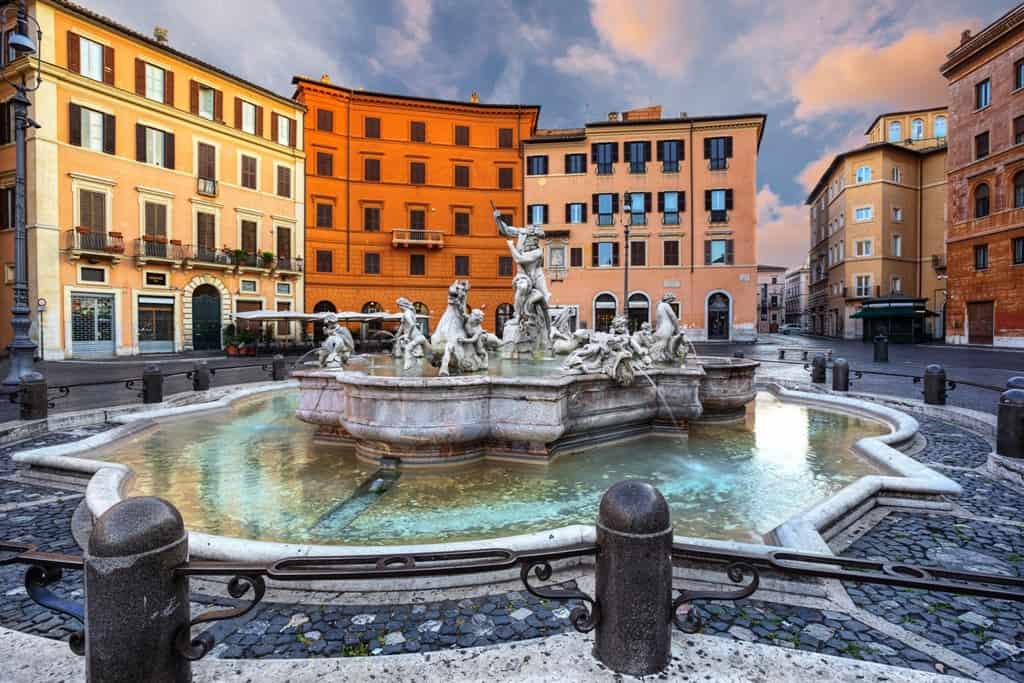
I then headed to the famous Piazza Navona, lined with Baroque palaces, shops, cafes, and lavish fountains. Originally a circus, the piazza was a lively place to be filled with energy, tourists, and street artists!
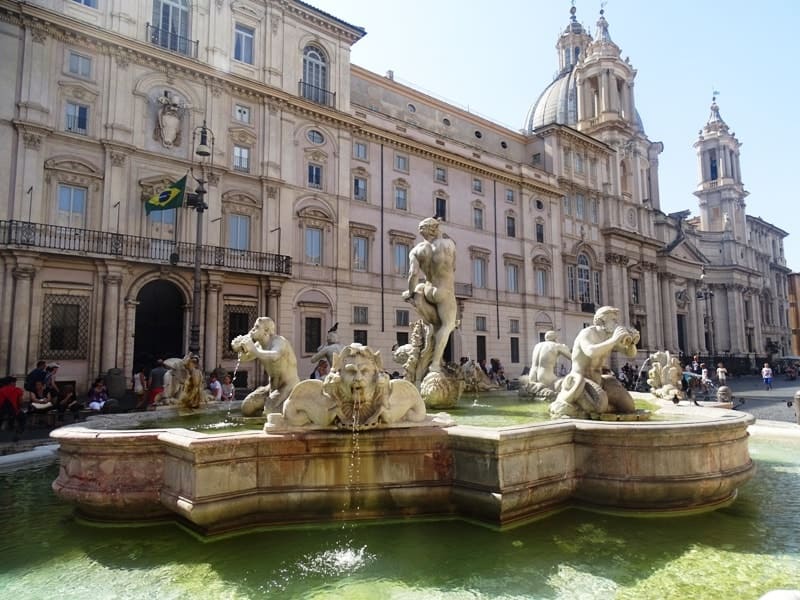
I walked around the Bernini Fontana dei Quattro Fiumi, a fountain that has an Egyptian obelisk as a masterpiece, and then took pictures of Fontana del Moro and Fontana del Nettuno.
Campo dei Fiori
After being in Piazza Navona, I went over to Campo Fiori, by far the city’s liveliest plaza ringed by a medieval castle and a bustling market. The plaza is noisy, colorful, and vibrating with life and the market is a true reflection of Roman life with fresh veggies and nice drinks.
At night, the plaza turns into an open-air bar with hundreds of people drinking in the streets from the bars that line the plaza.
5 Days in Rome: Day Two
Piazza venezia.
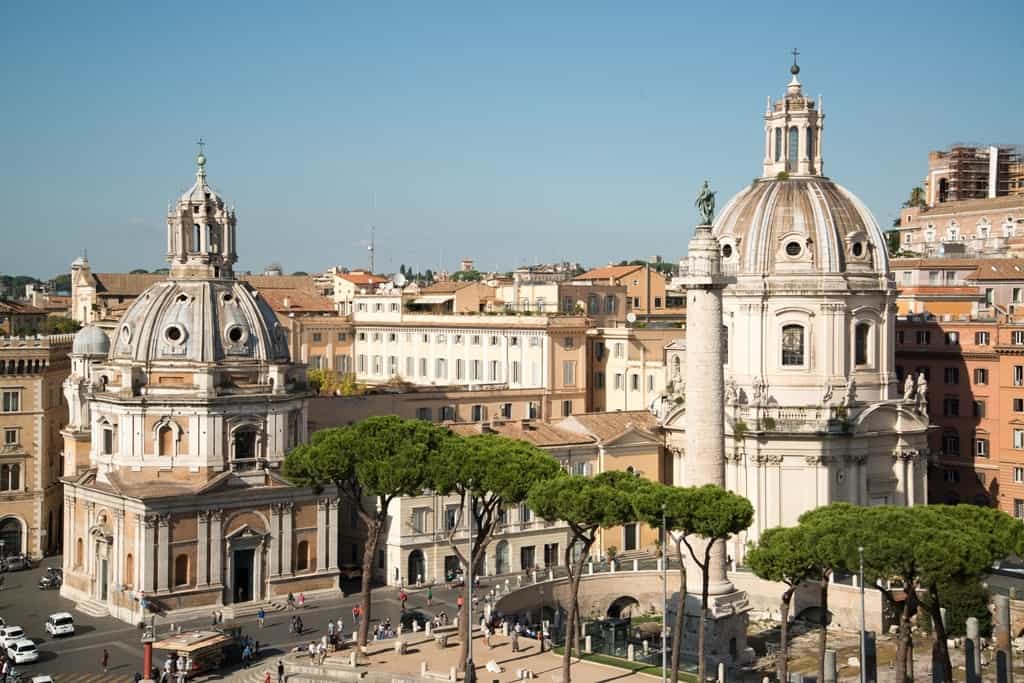
I started my second day in the Piazza Venezia, the geographic heart of the city with proximity to some of the most important attractions. There’s plenty to see there, from palaces, shopping streets, fun restaurants, and even a hill!
Monumento Nazionale a Vittorio Emanuele II
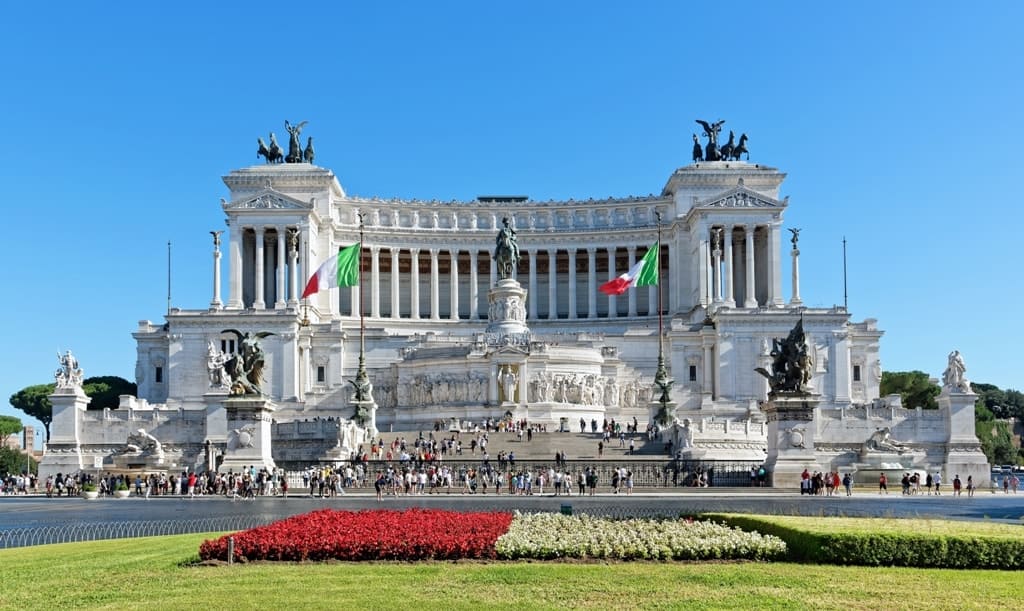
Passing by this remarkably large building, I couldn’t help but explore. White-washed with marble, and showcasing medieval architecture – this building was built to honor the unification of Italy.
What struck me at first was the contrasting white marble with the surrounding brown-colored, normal buildings. It just completely stood out and entering it I couldn’t help but be amazed at the statues, columns, grand stairways, and of course the statue of the horseman.
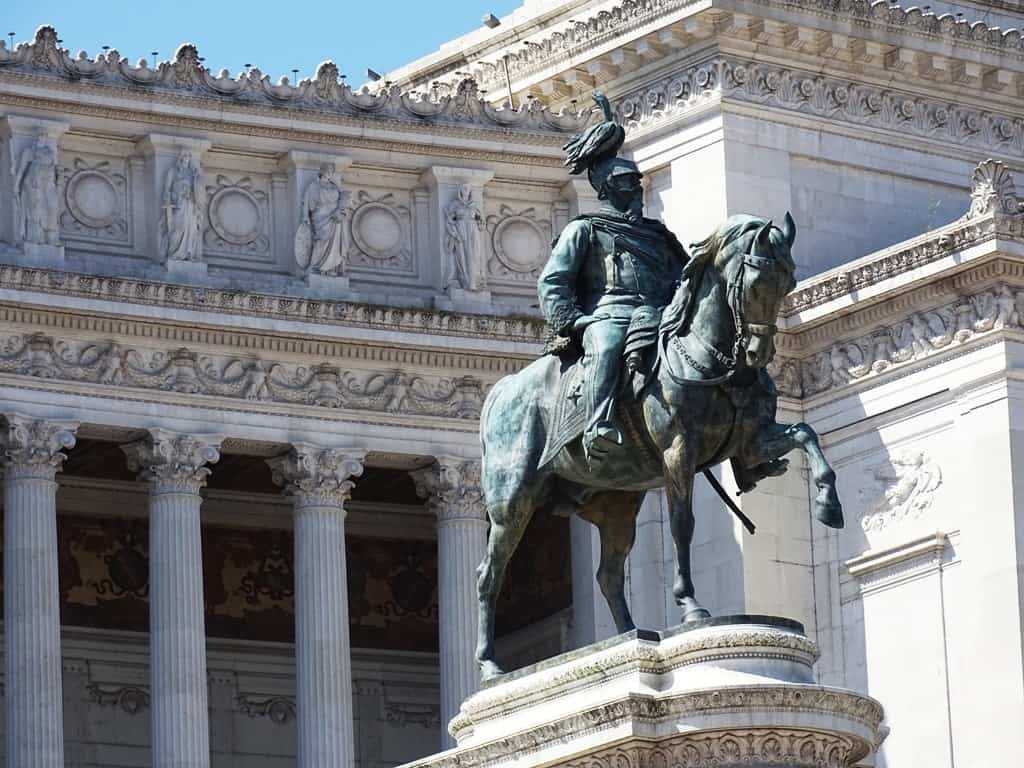
After exploring, I went to the top for 360-degree panoramas of the entirety of Rome – from there I could see pretty much all important sites including the Colosseum, the monuments, and of course, the squares!
The Roman Forum & Palatine Hill
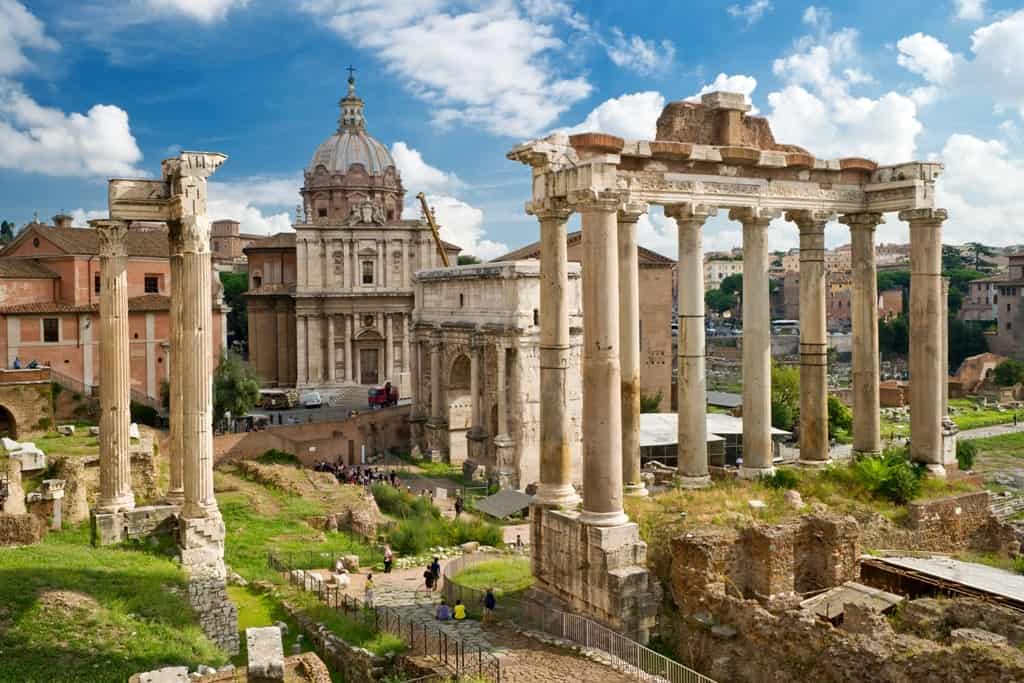
The Roman Forum was once the greatest sight in all of Europe, the center of the Roman Empire, and Rome’s pulsating hub where life ebbed and flowed. It was once dotted with temples, palaces, shops, stalls, and much more from the Empire.
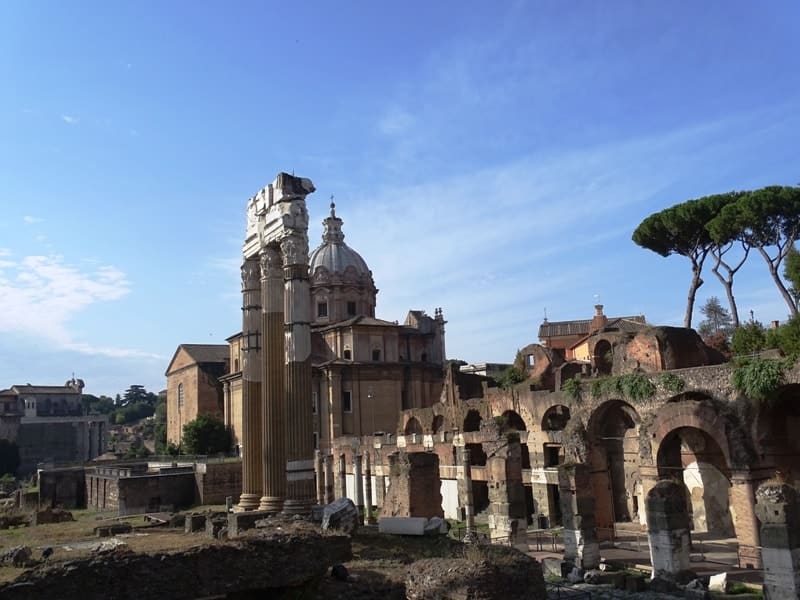
Today, the site is still filled with history, and I was able to get a glimpse into the past grandeur of this place. There was an abundance of things to see; from triumphal arches to remains of buildings, and temples.
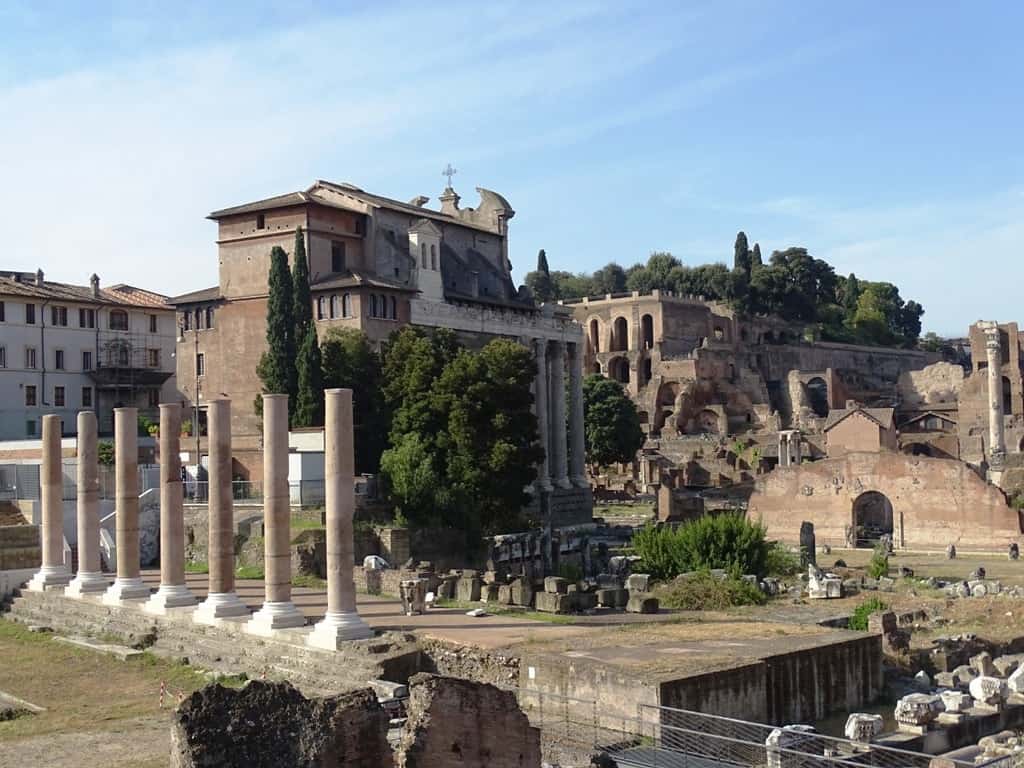
I then arrived at the most important attraction in all of Italy…The Colosseum…The personification of majesty, grandiose, and splendor of the Ancient world.
Of course, it’s as symbolic to Rome as the Eiffel Tower is symbolic to Paris, and the monument perfectly juxtaposes gore and glory together. You’ll find a structure that has survived earthquakes, fires, riots, wars, and still stands proudly, showcasing survival and lavishness!
2000 years’ worth of history are perched in the Colosseum, and exploring the structure, the second floor, the passageways, and the arena is a wonderful experience.
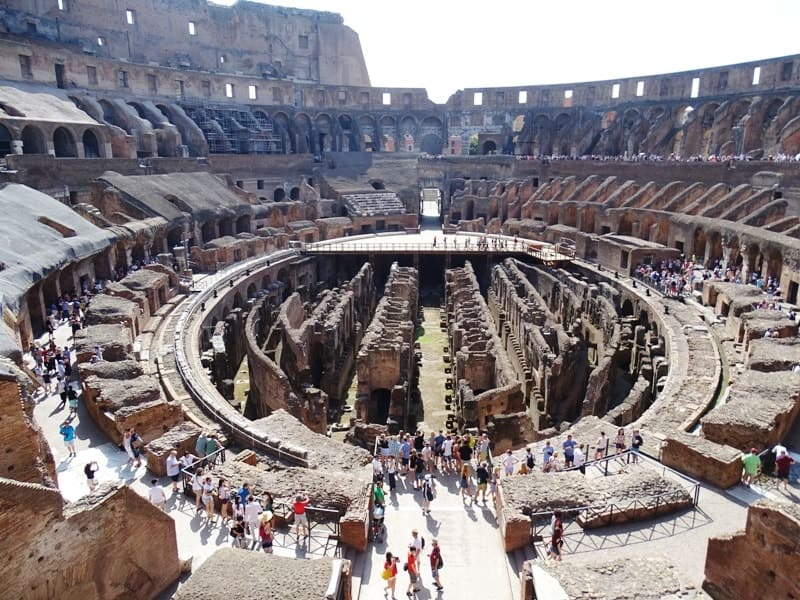
Tip: The Roman Forum, the Colosseum, and Palatine Hill were incredible places to visit, and the most important monuments in Rome, so needless to say, the lines were massive. Luckily, we bought skip the line tickets that helped make our tour so much easier and convenient.
I highly recommend the VIP Colosseum Underground Tour with Roman Forum & Palatine Hill by the company Walks of Italy. You get to skip the line in all the attractions and have VIP access to the Colosseum.
5 Days in Rome: Day Three
Villa borghese and galleria borghese.
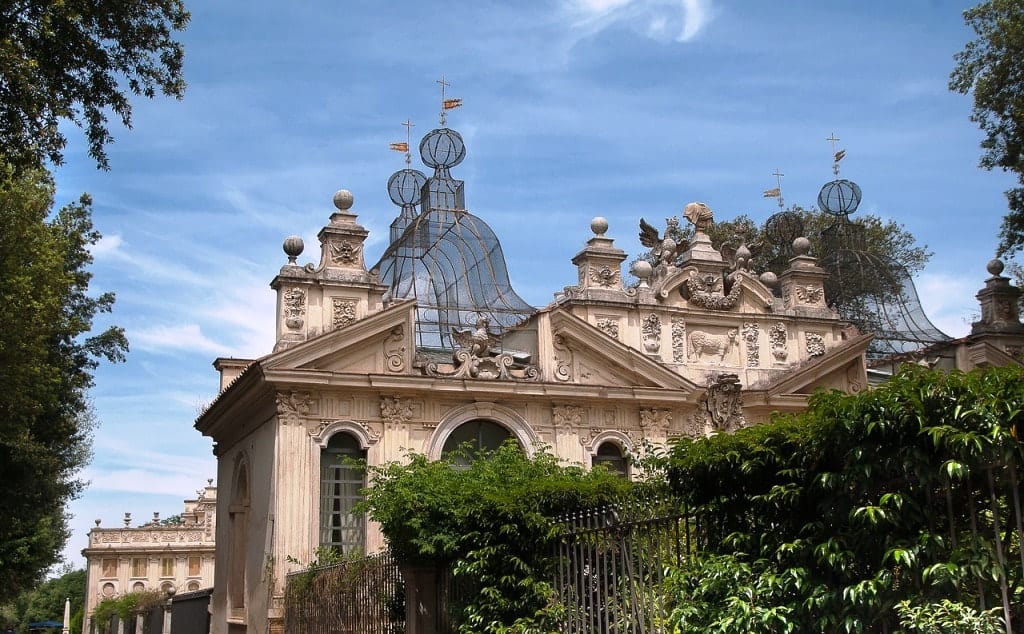
Now Rome is known for its extensive collections of art, museums, and galleries. On every corner, there were displays of art in museums, piazzas, churches, and even in plazas.
The Galleria Borghese is one of the greatest museums in Italy, with one of the world’s largest private art collections. The villa that the museum is housed in was used for entertainment and now is used to display the art collection.
I loved that you could see major works by artists like Bernini, Titian, Caravaggio, Raphael, Correggio, Rubens, and Canova, while also admiring the incredible works of marble, the statues, and the Renaissance gallery. I bought skip-the-line tickets that made the entire ordeal much easier since the lines were discouraging!
After exploring the gallery, I spent some time amongst beautiful flowerbeds, fountains, and temples in Rome’s largest park – Villa Borghese.
I highly recommend a guided tour at the Villa Borghese and I highly recommend the Borghese Gallery Tour & Tickets: With Bernini, Caravaggio, & Raphael by the company Walks of Italy.
Piazza di Spagna and Spanish Steps
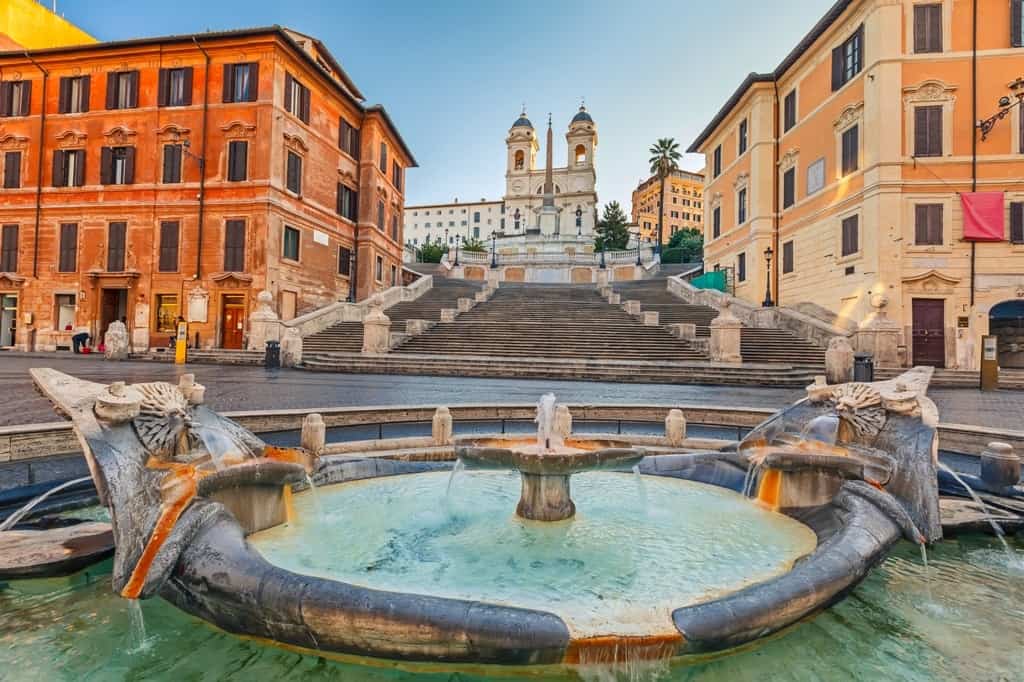
Piazza di Spagna is one of the most renowned plazas in all of Rome, with the iconic golden hues of Spain perched in the middle of Italy. Fountains, the iconic steps, and a bustling vibe all give this square its personality.
Fontana di Trevi
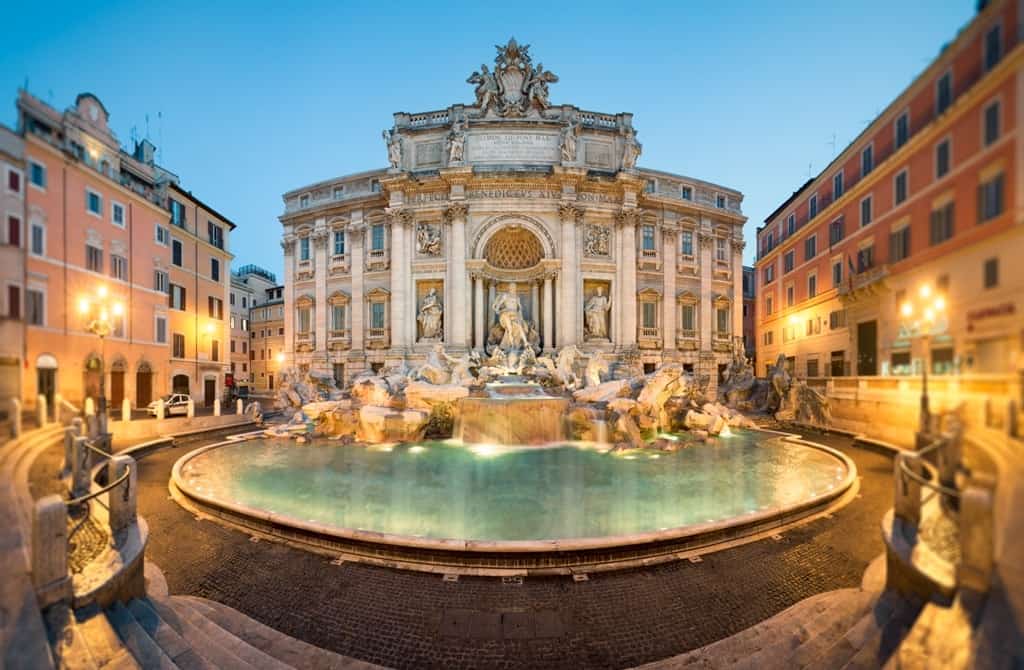
I had to elbow my way through the crowds to get to the gorgeously illuminated Fontana di Trevi. The true epitome of magic and fantasy – an attraction straight out of a storybook fairytale.
The Trevi Fountain is an iconic sight in Rome, and it was even more awe-inspiring to see it in real life. Great examples of Baroque art, the sea god Neptune, winged horses, and allegorical figures all give this fountain the ethereal vibe it permeates.
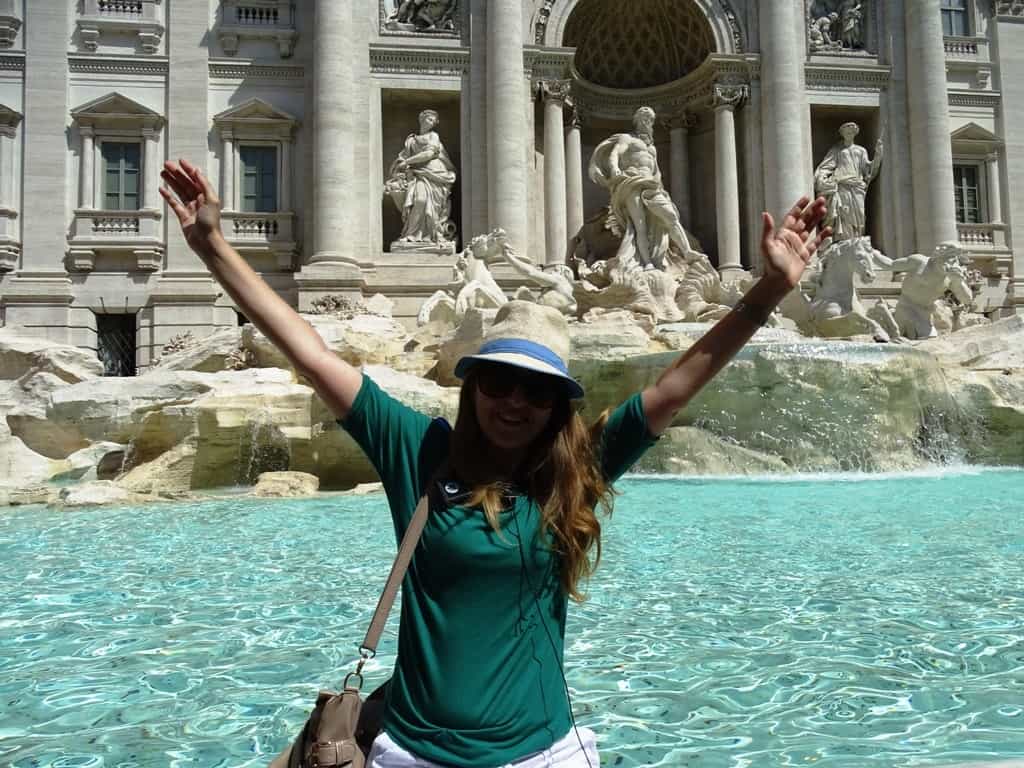
This is where you come to toss one coin so you can come back again to Rome, according to legend. If you want romance, toss two, and if you want to marry your partner, toss three!
After a long day of exploring some of Rome’s most important attractions, it was time for me to shop at the Via Veneto. The classic boulevard boasts some of the best shops in Rome, along with lively bars and vintage shops. There was an array of handbags, accessories, antiques and much more.
Via del Corso
The shopping doesn’t end there! The longest street in Rome is dotted with high-street stores, designer shops, boutiques, and an array of international brands. Not much of an authentic Roman shopping experience, but an authentic one nonetheless.
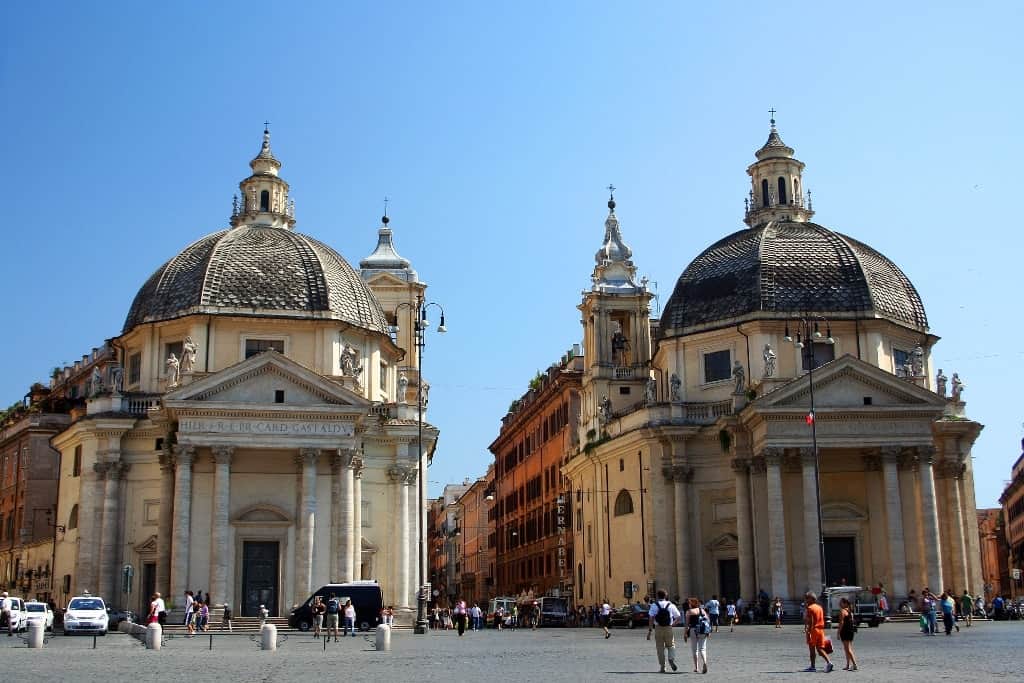
You can also do a little bit of sightseeing as you walk the street with the Piazza Venezia and Piazza del Popolo.
5 Days in Rome: Day Four
Vatican city.
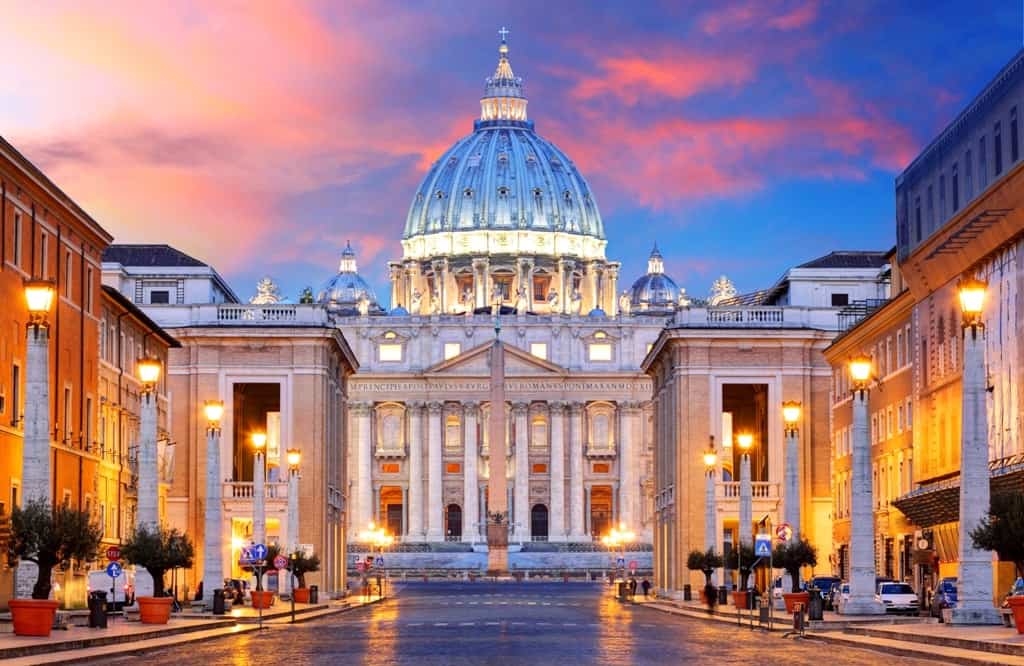
My fourth day was one of the most life-changing experiences to be had. Vatican City, the Holy See and the smallest country in the world, this place is nothing short of magical, and holy. An unparalleled spiritual discovery, the Vatican is dotted with holy buildings, lavishly decorated churches, galleries, and gardens.
Tip: Visiting the Vatican is an essential Rome experience, and it will be quite overwhelming! Before anything, you should know that the queues are huge. No matter how much you think you can wait, you can’t. The queues go on for seemingly forever, so I recommend a skip-a-line tour .
Another way to enjoy the Vatican if you don’t have much time is by this Pristine Sistine, early entrance small group Vatican tour . The reason I like this tour is that you get inside the Vatican one hour before it opens, the group is small and you get to see the Vatican in under 3.5 hours.
All 3 times I’ve been there were with the skip-the-line guided tour, and it added to the overall comfort and convenience of my entire visit there.
The Vatican Museum and the Sistine Chapel
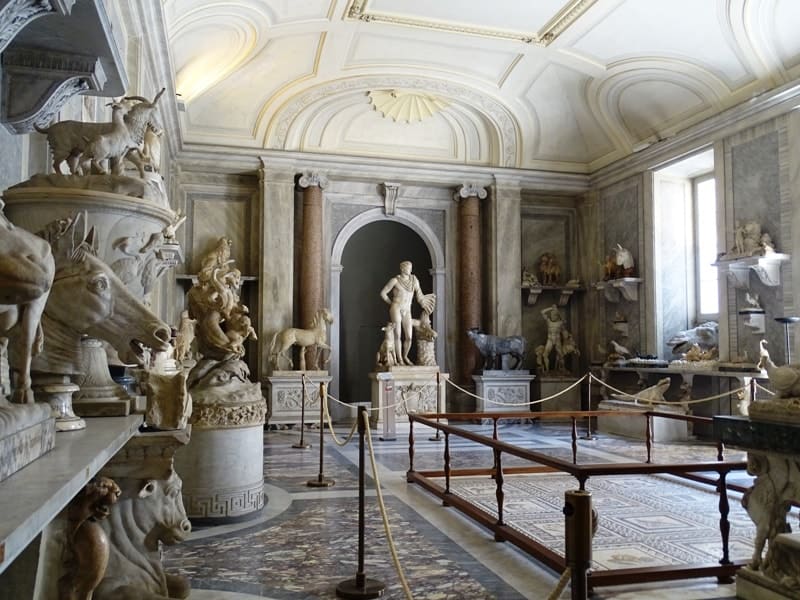
No museum in the world compares to the Vatican Museum. It is simply without any doubt, the most beautiful museum in the world. Countless masterpieces are housed in this building, along with paintings and sculptures.
The largest museum complex in the world is almost impossible to explore in one day. There are over 1,400 rooms filled to the brim with priceless art that dates back 3,000 years.
Think Egyptian mummies, classical sculptures, tapestries, canvases and everything ranging from Renaissance art to detailed frescoes. You could also check out the Hall of the Maps showing you some of the most important lands and their old maps.
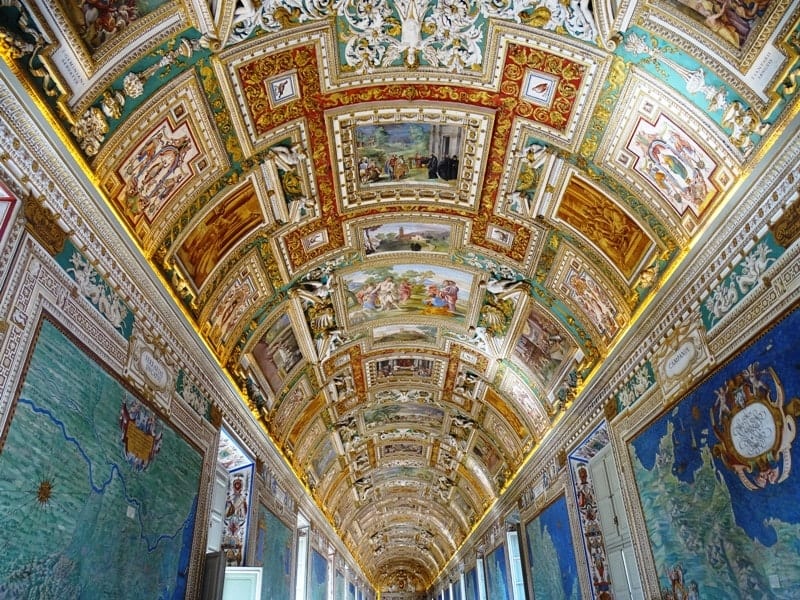
The Pinacoteca Vaticana and the Stanze di Raffaello are also definitely worth checking out.
St Peter’s Basilica
The Vatican is ridden with superlative, and it doesn’t end at the museum. The St Peter’s Basilica is the largest church in the world with some of the most lavishly decorated interiors in the world. It’s a celebrated edifice, with unparalleled size and opulence, and is an unforgettable experience in general.
You can check out the breathtaking interior, La Pieta, the moving sculpture of the Madonna, or the main basilica halls. There are tombs to discover, colored windows, and golden angels!
Climbing the Dome
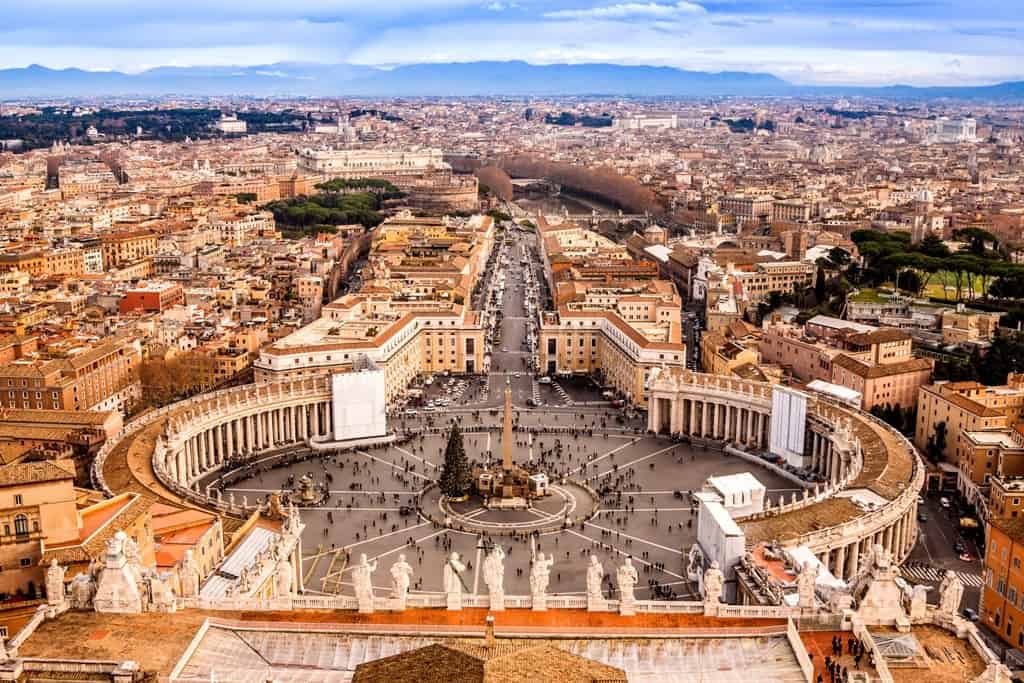
After exploring the Basilica, you can reach the dome (either through an elevator or a 320-step climb), and get rewarded with the most breath-taking, gasp-deserving views in Rome. You’ll get panoramas of Rome, the buildings, the winding alleys, the plazas…This is when you realize the true grandeur you’re surrounded with.
Check out some great tours of the Vatican: Skip the Line: Vatican Museums, Sistine Chapel & St. Peter’s Exclusive Early Morning Vatican Tour.
Castel San Angelo
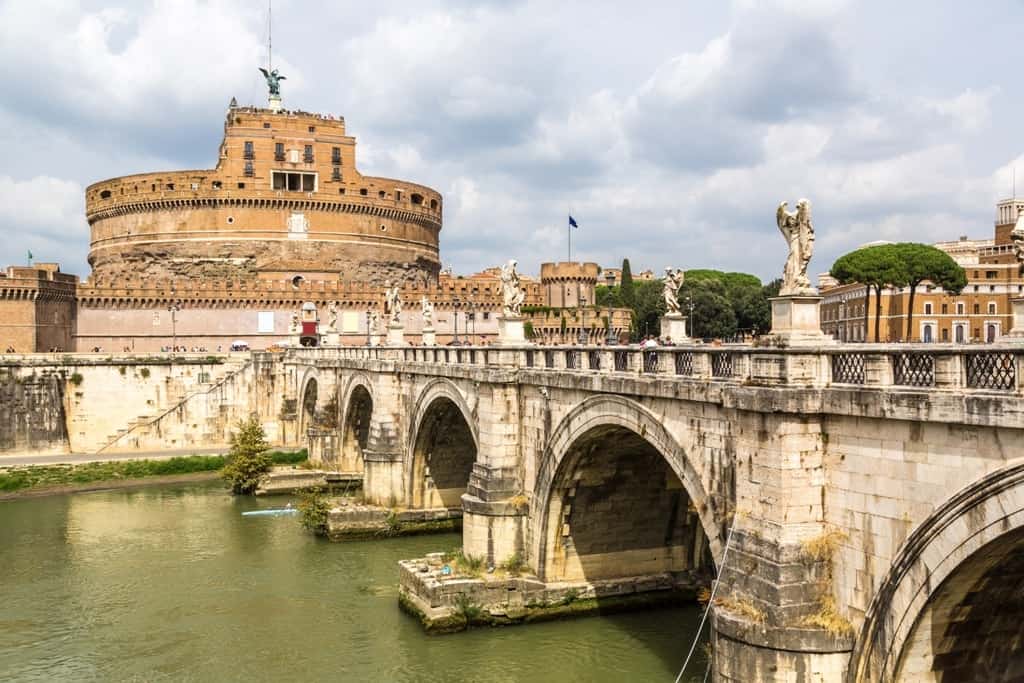
Enter through a stone ramp and check out the Castle that dates back to Roman Times to the year 135! You can explore the mausoleum, the prison, and the warehouses, or the upper terrace with unparalleled views!
Book here your skip the line tickets and 1 hour tour of the Castle
5 Days in Rome: Day Five
The great thing about the fifth day is the flexibility you have. You’ll be done exploring the main attractions of Rome, and it would be the perfect time to explore your options.
Day Trip to Pompeii
You can have a day trip to Pompeii where you get to explore the mountains, and the volcanic crater, get gorgeous views of the Bay of Naples, and travel back in time to explore the lost city of Pompeii. The city is filled with ruins; frescoes, winding streets, and much more that are surprisingly very well preserved. The place there takes a full day to see.
Find here more information about the day trip to Pompeii
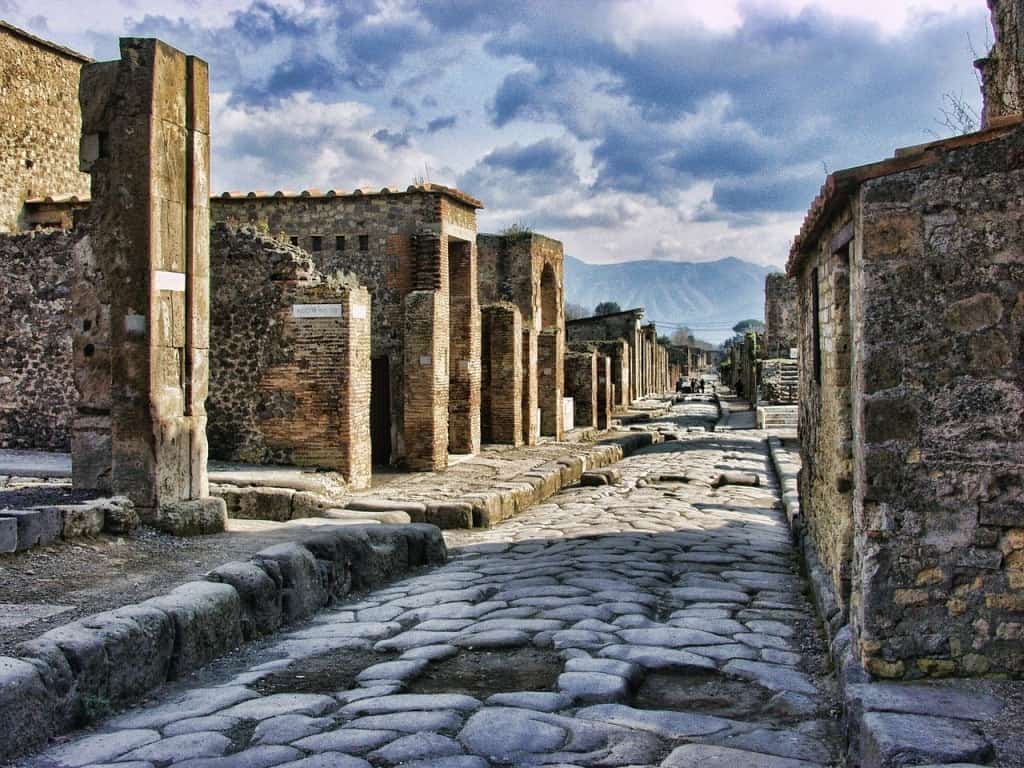
Food Tour or Pasta-Making Class
You can also have a food tour if you’re more of a foodie and want to experience the delicious Italian cuisine. It’s practically a walking tour where you taste different wines and tours around Rome!
If you want to learn how to make that delicious food so you can take and utilize your skills back home, then definitely go to a pasta-making class !
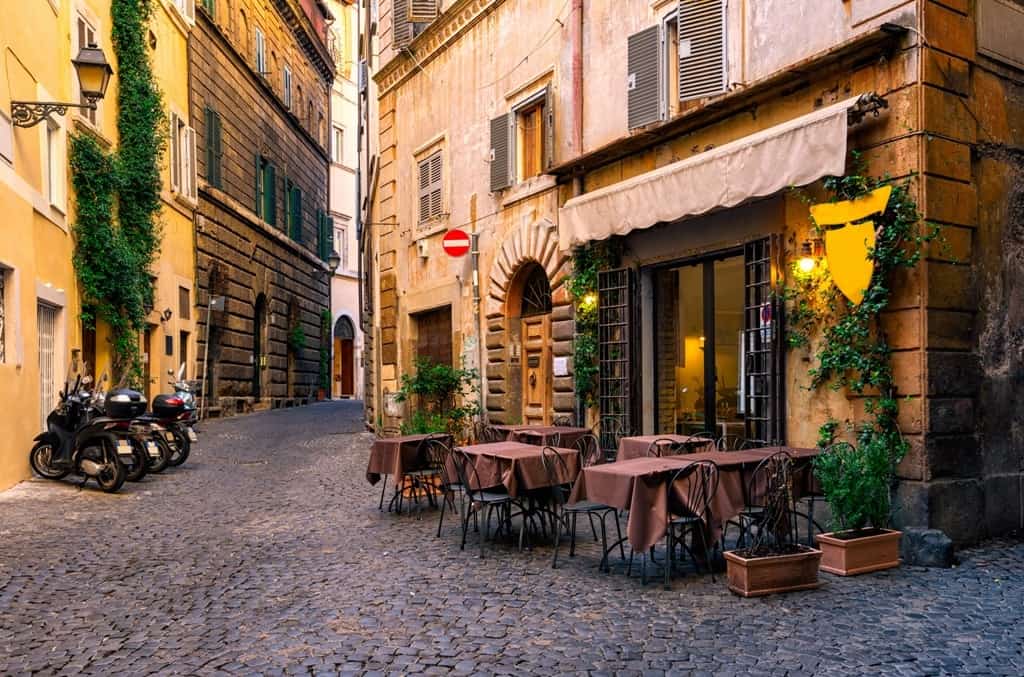
Does Rome Have a City Pass?
One of the first things I do when I decide to spend several days in a city is research to see if they have a city pass. Not all cities do but I find that they’re typically a great investment as they usually offer free or discounted entry into attractions and sometimes free transportation as well.
A great city pass option in Rome is the “ Explore Go Rome ” pass via Go City. With it, you’re able to visit more than 40+ attractions in Rome for free, saving up to 50% vs buying individual tickets. It includes free entry to the Vatican, the Colosseum, Hop on Hop off bus, Italian Cooking Class, the Catacombs, and more.
Click here for more information and to buy your Rome city pass.
How to get from and to the airport in Rome
Rome has two airports, Fiumicino and Ciampino. All intercontinental flights on major airlines land in Fiumicino while budget airlines and flights from other parts of Italy and Europe land in Ciampino. Luckily, both are close to the city center so just pick whichever one makes the most sense for your travel plans!
From/to Fiumicino airport:
Fiumicino airport is only 26 km away from Rome. Train: The Leonardo Express is a direct train that connects Fiumicino Airport and Termini Station in Rome in 30 minutes. Tickets cost 14 euros each way. Remember to validate your ticket in the machine before entering the train. Tickets are valid for 90 minutes. Regional FL1 Train connects the airport with other stations in Rome (not Termini) like Tiburtina. From there you can take the metro to the city center. Tickets cost 8 euros. You will need another ticket for the metro (1,50 euros) Remember to validate your ticket in the machine before entering the train. Tickets are valid for 90 minutes. Shuttle Bus: The cheapest way to travel between Fiumicino airport and Rome’s city center is by a shuttle bus that makes 2 stops in the center (Termini Station and Piazza Cavour near the Vatican). Journey time is 55 minutes depending on traffic. Tickets cost 6 € one way and you can buy them online. Book your shuttle bus from and to Fiumicino airport here. Taxi: You will find taxi stands outside all the airport terminals. Always use the official taxi services and do not take offers from drivers inside the terminal. Private Airport Transfer with Welcome Pick-Ups : The easiest and most comfortable way to get to the city center is by a private transfer service like Welcome Pick-Ups . It costs exactly the same as a regular taxi, only now you will have already prepaid for it, your driver will be waiting for you at the arrivals hall holding a sign with your name on it, a bottle of water, and a city map. You will not have to worry at all about the language as all drivers speak English. Click here for more information and to book your trip
From/to Ciampino Airport:
Shuttle Bus: The cheapest way to travel between Ciampino airport and Rome’s city center is by a shuttle bus that makes a stop at Termini Station. Journey time is 40 minutes depending on traffic. Tickets cost 5 € one way and you can buy them online. Book your shuttle bus from and to Ciampino Airport here. Private Airport Transfer with Welcome Pick-Ups : The easiest and most comfortable way to get to the city center is by a private transfer service like Welcome Pick-Ups . It costs exactly the same as a regular taxi, only now you will have already prepaid for it, your driver will be waiting for you at the arrivals hall holding a sign with your name on it, a bottle of water, and a city map. You will not have to worry at all about the language as all drivers speak English. Click here for more information and to book your private transfer.
Where to Eat in Rome
Of course, it’s no secret that Rome offers one of the best gastronomic experiences in the world. Who doesn’t love Italian food with all its flavors and diversity? You can experience Italian food on every street, and in every back alley and neighborhood, but you can also choose some of the best!
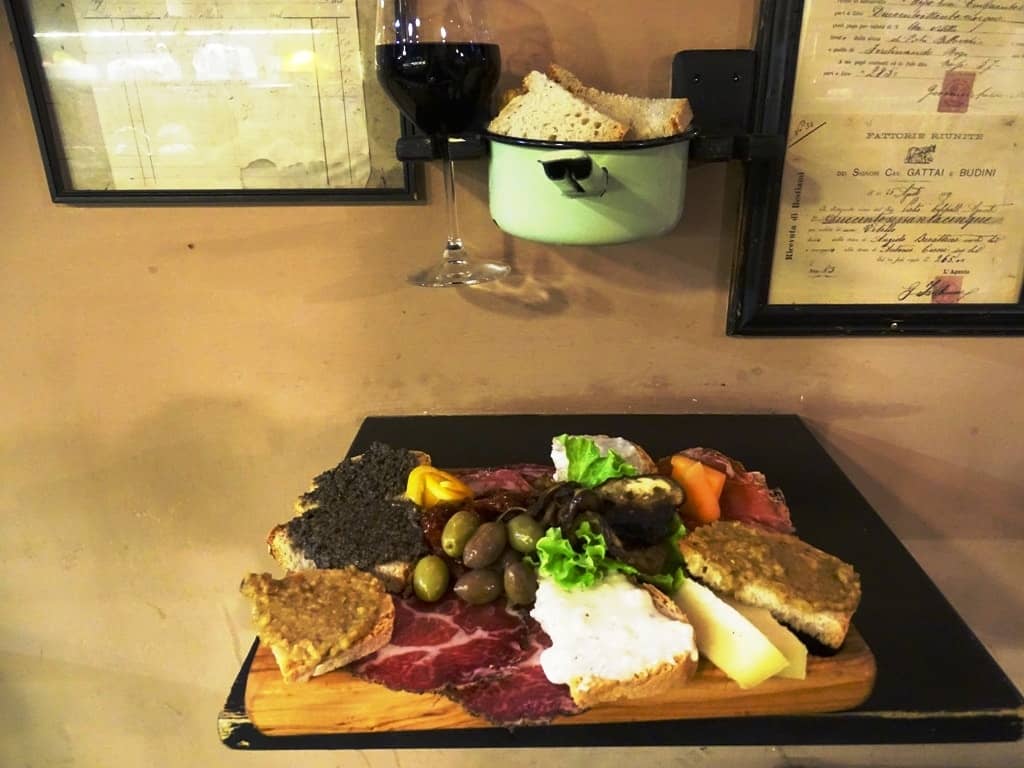
La Proscuitteria : This is one of the best places to eat in, Rome and is renowned for its incredible food and wine. It’s a small place, very cozy, with incredible staff and it is just around the corner from the Trevi fountain! This is where you go to have a quintessential Italian food experience! Address: Via della Panetteria, 34/A, 00187 Roma Via della Scala, 71, Trastevere, 00153 Roma Via del Governo Vecchio, 21, Navona, 00186 Roma
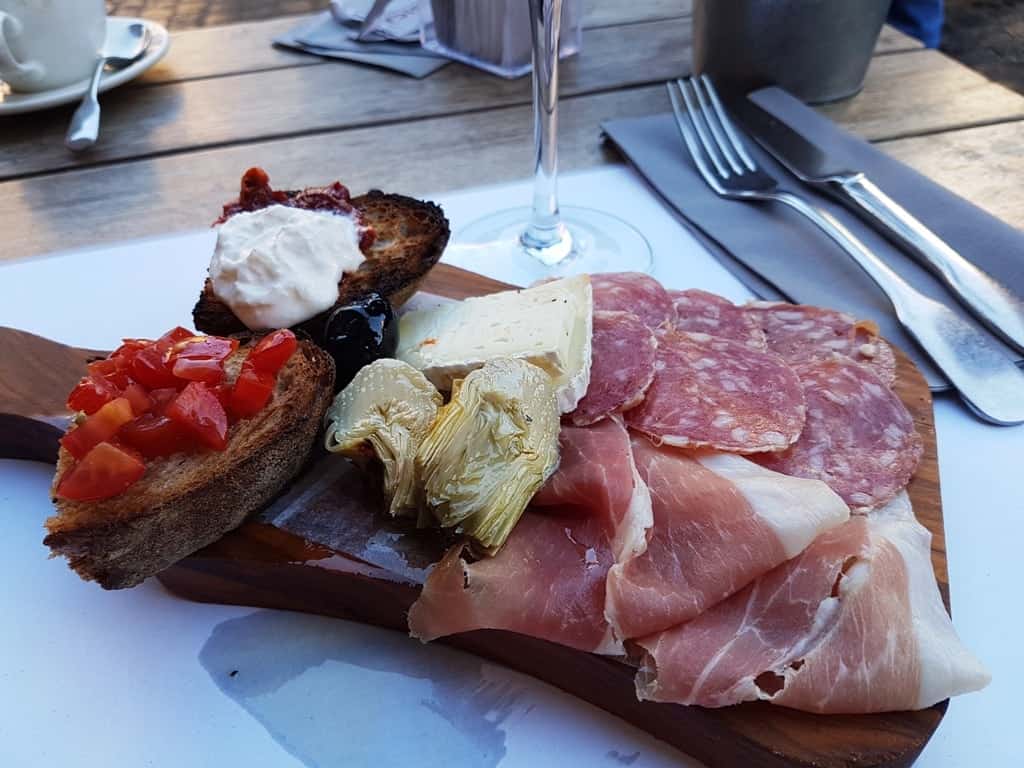
Obica: This modern mozzarella place gives you authentically delicious Roman pizza, and has a great breakfast, fresh food, and decent portions. Address: Piazza di Firenze, 28, 00186 Roma Piazza Campo de’ Fiori, 16, 00186 Roma

Antica Enoteca di Via della Croce : A restaurant that dates back to 1842, this place has managed to keep its wooden bars, its authenticity, and its interior! Very close to the Spanish Steps, the restaurant has great food like soups, pasta, polenta, and pizza and it’s not at all overly priced. Address: Via della Croce, 76, 00186 Roma Pizzeria da Baffetto : If you want the best pizza in town, this is where to go! Delicious, warm pizza in a gorgeous, cozy environment, and it’s definitely worth the wait for the legendary pizza. Address: Via del Governo Vecchio, 114, 00186 Roma Café Sant Eustachio : Rome is known for its bustling café culture, and this is simply one of the best there. Great coffee, a great location next to the Pantheon, a cozy atmosphere, and unique coffee combinations! Address: Piazza di San Eustachio, 82, 00186 Roma
San Crispino : You can’t really go to Rome without trying the renowned gelato! This place has been offering the best gelato since the early ’90s, with different flavors and a quirky exterior. Address: Via della Panetteria, 42, 00187 Roma
You can also check out my post: What to eat in Rome .
When Is The Best Time to Visit Rome ?
Like most major European destinations, the best time to visit Rome is the off-season or shoulder season. I think the best month to visit Rome is October but, truthfully, any time of the year can be lovely.
Winter : the Christmas period is one of the best choices for a trip to Rome because you’ll have the chance to see the lights, the Christmas trees, and the colorful decorations, other than to visit the Christmas markets. Roman winter is quite mild (the temperature rarely goes below 10°C) allowing you to stay long hours in the open air.
Spring : it’s the most popular period to visit Rome, both because of Easter celebrations and its warm and sunny weather attracting large crowds of tourists. It’s the best time of the year to discover the Roman parks, but some rainfalls are still possible.
Summer : Roman summer is too hot to go sightseeing, but it could be the right moment to explore the surroundings, like the Roman castles or the Lazio coastline with the seaside resorts of Anzio and Ostia.
Autumn : the best period to enjoy warm weather, fewer tourists around, and a charming atmosphere created by the seasonal light and colors.
The best month to visit Rome : October
How to get around Rome
By subway : fast, cheap, and efficient, the subway has 3 lines (A, B, and C) taking you everywhere in town. 1 ticket costs 1,50 euro and it lasts for 100 minutes after validation. You can also choose the ticket named “Rome 24h” lasting 24 hours after validation and costing 7 euros. As an alternative, choose Rome 48h or 72h costing respectively 12,50 euro and 18 euro. Download the subway map here.
By bus : they are slow and often late due to the frequent traffic jams, but you can choose from more than 400 lines! Tickets are valid both on subway trains and buses. Download the map here.
By car : it’s not a good choice, because of heavy traffic
On foot : it’s the best way to discover the city, especially if you stay in the city center!
Practical Tips For Your 5-Day Rome Itinerary
Here are a few key things to help you make the most of your 5 days in Rome:
- PREBOOK ATTRACTIONS. My most important advice to you would be to get a skip-the-line ticket pre-booked. Nothing really prepares you for the harrowingly long queues except booking in advance and getting a skip-the-line ticket. This itinerary would not have been possible without it, and each attraction would have taken an entire day to get there. Pre-booking attractions is truly the key to exploring Rome in 5 days.
- Check your luggage. Don’t want to haul your suitcase around after checking out of your hotel on the last day (or before checking in on the first day)? While some hotels may store your luggage for you, there are other options as well, like the Termini Station Luggage Storage .
- Dress appropriately for the Vatican. Note that when entering the Vatican and other religious sites, you’ll need to have your knees and shoulders covered.
- Download offline maps. To make sure you don’t get (unintentionally) lost while wandering the streets, be sure to download offline maps (such as on Google Maps) before leaving wifi or at least that you have plenty of data on your phone.
- Wear comfortable shoes. You’ll be walking a lot on this 5-day Rome itinerary, so be sure to bring shoes that are comfy. Make sure you break them in ahead of time too, there’s nothing like blisters to ruin a vacation!
- Stay hydrated. This is easy in Rome because there are water fountains everywhere. It’s especially important during the summer months when it’s hot.
- Ignore strangers handing you things. In crowded areas, you may find strangers attempting to hand you a rose or bracelet or even attempting to help you with your things. It’s best to ignore them or politely say no thank you to avoid needing to pay later (even if they say it’s “free”).
Overall, Rome was an overwhelmingly beautiful experience. There was so much to do, and getting bored or tired of the sites was almost impossible. I hope you enjoy this Rome 5-day itinerary as much as I did!
Sharing is caring!
17 thoughts on “5 Days in Rome Itinerary: What To See & Do”
Your photos are beautiful. I love the editing. What kind of software did you use. Also your notes and itinerary for Rome was perfect. I was in Rome last year and had a wonderful time.
Thank you very much. Some are mine some are bought from Shutterstock.
I am really pleased with your itinerary! May I know where you bought the tickets for the places you went? Did you booked it beforehand like the colosseum, palatine hill etc or you can buy it on the place itself on the spot? Thanks
Thank you very much, Al. I bought my tickets online a month in advance. The lines are huge in most attractions so I suggest a skip the line ticket bought a few days earlier.
Can you tell me how you traveled between sites on Day 1 through Day 4… Is that all walk-able or do we have to take taxis.. We are planning trip end of March..thanks
Rome is definitely walkable. Where are you staying? If you stay at the center you can walk everywhere otherwise you can also take the metro which is extremely easy to navigate. No need to take a taxi at all. Beware with taxis though you cannot hail a taxi you can take it from a stand and always be careful to take the official ones.
Thanks for your prompt response. Another question.. We are visiting for 5 days just like you… Do you recommend any day trips from Rome..
You are welcome. As a day trip, I recommend Pompei. Alternatively, you can get a glimpse of Florence too. It is close by highspeed train. I would choose Pompei though.
My son is planning his first trip to Italy. He wants to focus on Rome, Pompei, and Florence. Love the 5-day for Rome. Do you have similar recommendations for Florence? Thanks.
Thanks Scott. I haven’t written a detailed post only for Florence yet but I think this post will help him https://travelpassionate.com/italy-itinerary-10-days/ let me know if you have any questions.
Was glad to have found this website after looking for sample itineraries in Rome.
Very disappointed to discover this article seems to be a sort of advertisement for all sorts of getyourguide tours. Practically all the links lead to their web page where they sell all kinds of tours. It is ok to sell tours but that should also be mentioned explicitly so as not to mislead readers.
Thank you for your message. I am recommending some tours from Get Your Guide as I use them myself. I highly recommend that you book a guided tour or skip the line tickets when visiting Rome. You don’t have to do it from my site or Get Your Guide though. I have a disclaimer at the end of the post but you are right it is not very visible so I am going to move it at the top. I have no intention to mislead anyone and I am sorry if I made you feel this way. Enjoy your trip to Rome it is a beautiful city.
A trip to Rome is all I ever need this year. I’m thinking of filing a leave, but I remembered that I don’t have anyone to be with me on that trip.
Rome is a great city for a solo trip as well. I was on my own the first time I visited too.
So glad I came across this page! Can I know how you managed to snap the pictures without any human in it??
Thank you. You need to wake up very early in the morning in order to take photos without people. Some of these are not mine though.
I love your blog! Always a great help for my travelings 🙂
Leave a Comment Cancel reply
Save my name, email, and website in this browser for the next time I comment.

Rome was called the “ Eternal City ” by the ancient Romans because they believed that no matter what happened in the rest of the world, the city of Rome would always remain standing . Exploring the city center by foot surrounded by glorious monuments and colossal remains takes you back in time to the “glory that was Rome”.
Rome Travel Guide
- General Information
- Things to do
- Getting to Rome
- Public Transport
- Money-saving tips
- Where to Eat
- Where to Stay
- 3-Day Itinerary
Why visit Rome?
With its unparalleled history, Rome is the third most visited city in Europe and the fourteenth worldwide. It attracts visitors from all over the world who are impatient to discover the city’s impressive monuments and archaeological sites ; not to mention its renowned cuisine and its lively atmosphere.
When exploring the Colosseum , visitors will easily imagine how the gladiators fought for their lives in the arena, cheered by the crowd. In the Circus Maximus , travelers will picture the chariots crashing into each other in order to be first in the race, and in the Roman Forum visualize what the Roman public life was like.
Looking for accommodation?
If you haven’t booked your accommodation yet, we suggest visiting our search engine , where you’ll find all types of hotels, hostels, and apartments with the best rates guaranteed . You can get up to a 75% discount and pay once you get to your destination.
- Accommodation in Rome - find the best deals
top activities
Vatican Museums & Sistine Chapel Guided Tour Skip the endless queues for the Vatican Museums and the Sistine Chapel—explore the most iconic landmarks in the Vatican City accompanied by an expert guide .
Sistine Chapel, Vatican Museums + St Peter's Basilica On this tour, you'll get access to the Sistine Chapel first thing in the morning, avoiding all the crowds . We'll also visit St Peter's Basilica .
Colosseum, Roman Forum & Palatine Hill Tour Travel back in time to Ancient Rome and discover the Colosseum, the Roman Forum, and Palatine Hill on this guided tour with priority access !
Colosseum Tour + Gladiator's Entrance When in Rome, don’t miss the eternal Colosseum! Access the arena through the Gladiator’s Gate, the entrance used by the ancient Roman fighters.
Borghese Gallery Guided Tour Discover the extraordinary collection of paintings and sculptures housed in the Borghese Gallery , one of Rome's must-see art museums .
Florence & Pisa Day Trip Discover two incredible jewels in Tuscany on our Florence & Pisa Day Trip from Rome. You'll see the Duomo , the Ponte Vecchio and the Leaning Tower .
Pompeii & Naples Day Trip Set off on a full day trip and discover the ruins of Pompeii , followed by a panoramic tour of Naples , one of the world's oldest constantly populated cities.
Rome Night Tour On this night tour of Rome , we'll visit the most iconic piazzas , streets and monuments of the Italian capital when the city comes to life at dusk.
Italian Pasta & Tiramisu Workshop If you love Italian cuisine, then don't miss out on this Italian Pasta and Tiramisu Workshop . You'll learn how to make some staple Italian dishes!
Rome Fiumicino Airport Shuttle Bus Are you travelling to Rome? Book this shuttle bus between Fiumicino Airport and Rome so you can get into the city centre comfortably and quickly.
Audience With Pope Francis An audience with Pope Francis is a unique spiritual experience . Your guide will take care of everything, so you can go relaxed.
This tourist bus is the perfect way to discover Rome . You can choose different routes with numerous stops and hop on and off as many times as you want!
Rome Electric Tuk Tuk Tour Explore the Eternal City through an eco-conscious lens with our electric tuk tuk tour of Rome and roam the Italian capital's streets in a zero-emission vehicle!
Set off on a day trip from Rome across the Italian countryside to discover the birthplace of St Francis in the charming town of Assisi .
Rome Ciampino Airport Shuttle Bus With this shuttle service between Ciampino Airport and Rome, you'll be in the centre of the Italian capital in less than an hour. The eternal city awaits you!
Basilicas Tour and Secret Underground Catacombs Discover some of the most symbolic sites in Christian history: the Catacombs and two of the world's most important Basilicas on this tour of the Eternal City.
Trastevere Food Tour Feast your eyes and stomach during a 3-hour food tour in Trastevere, one of Rome’s most bohemian neighborhoods and sample the delicious Italian gastronomy.
Castel Sant'Angelo Tour + Terrace Access A refuge for popes and an ancient Roman mausoleum , Castel Sant'Angelo harbours great secrets. On this guided tour we'll unveil its most hidden mysteries.
Day Trip to Venice by High Speed Train Experience a day trip from Rome to Venice on a high-speed train and explore its beautiful canals and historic centre at your own pace.
St Peter's Basilica Guided Tour + Dome Climb Enjoy the best views of Rome by climbing the 320 steps leading up to the dome of St. Peter's . We'll also visit the interior of the Basilica!
Roam the underbelly of Rome on this tour of its underground system . Walk the Appian Way and Caffarella and dive into the lesser-known side of the Eternal City !
Private Walking Tour of Rome Explore the Eternal City's most iconic sights accompanied by an expert guide just for you and your partner, family or friends. Discover the best of Rome !
Rome Sightseeing Cruise on the Tiber River Take a sightseeing cruise along the Tiber River and enjoy spectacular 360º views of Rome from the water. You can hop on and off as many times as you want!
Trevi Fountain and its Underground World On this tour of the Trevi Fountain and its underground world , we'll reveal the hidden treasures and history of the most fountain in Rome .
Ponza Island Day Trip Enjoy a day trip from Rome to Ponza Island . Cruise along the waters, feel the breeze in your hair and cool off with a dip in the Tyrrhenian Sea!
Hadrian's Villa and Villa d'Este Day Trip Visit the two treasures of Tivoli on this day trip: Hadrian's Villa, Roman Emperor's retreat, and Villa d'Este, a Renaissance mansion with magnificent gardens.
Papal Audience & Vatican Museums Tour Enjoy this unique experience of the Holy See with this combination tour which includes an audience with Pope Francis and a visit to the Vatican Museums .
Tuk Tuk Tour around Rome Tour Rome in the most comfortable way on this tuk tuk tour. We'll explore its seven hills and learn tons of historical fun facts about the eternal city.
OMNIA Rome & Vatican Card The OMNIA Card is a sightseeing pass that includes priority access to Rome’s main attractions like the Colosseum, Roman Forum, and Vatican City .
Palazzo Santa Chiara Opera Concert Treat yourself to a unique experience during your stay in Rome when you attend a fantastic opera concert at the Palazzo Santa Chiara .
Rome Mysteries & Legends Free Tour Wandering ghosts and enigmas in Caravaggio's works ... Discover the hidden side of the city with this free tour of Rome's mysteries and legends.
La Traviata with Ballet Entrance Ticket Enjoy one of the most famous operas of all time in the magical setting of the St Paul's Within the Walls Church with this La Traviata Ballet Entrance Ticket.
Castel Sant'Angelo Ticket + Audio Guide Explore the intriguing history of Castel Sant'Angelo with this admission ticket + audio guide. Uncover the mysteries of one of Rome's most cryptic monuments !
St. Peter's Basilica Tickets: Dome Access + Audioguide Secure your ticket to St. Peter's Basilica for an experience that includes access to its magnificent dome and a self-guided tour with an English audio guide .
Free Walking Tour of Rome The city of the Caesars, of Baroque and, of course, The Eternal City. Discover Rome with this free walking tour of the Italian capital .
The impressive dome of the Pantheon of Agrippa has fascinated the whole world for centuries. Discover it with this guided tour of Ancient Rome .
Baths of Caracalla & Circus Maximus Guided Tour Go back in time on this walking tour of the Bath of Caracalla, the most luxurious thermae of the Roman Empire . Then marvel at the remains of the Circus Maximus.
Rome Pub Crawl Are you ready to discover the vibrant nightlife of the Italian capital ? Join us on this pub crawl through Rome and experience it for yourself!
Italian Pizza Workshop Visit Rome and enjoy a delicious pizza made with your own hands . Try this Italian Pizza Workshop and learn how to make one of the country's most famous dishes.
Rome Catacombs Tour & Appian Way Visit the catacombs of Rome with an expert English-speaking guide during a 3-hour half day-trip, also discovering the fascinating Villa di Massenzio.
Rome Photo Tour Discover the most Instagrammable locations in the Italian capital and show off your trip with this Rome Photo Tour. Benvenuti a Roma !
Rome Hard Rock Cafe Come to the Rome Hard Rock Cafe and enjoy an exquisite menu of American food in an emblematic place where the rhythm of rock is felt in every corner.
Go City: Rome Explorer Pass The Go City: Roma Explorer Pass tourist card gives you access to the main attractions in the Italian capital, such as the Sistine Chapel and the Colosseum.
Mostra di Leonardo Ticket Discover some of the most amazing inventions by the Italian genius Leonardo da Vinci with this ticket to the Mostra di Leonardo museum.
Welcome to Rome Tickets Immerse yourself in Rome's thrilling history when you buy a ticket for the fascinating Welcome to Rome multimedia experience .
Ostia Antica Half-Day Tour from Rome Discover the legacy of the Imperial City on a guided tour of Ostia Antica, an ancient harbor town only 30 km from Rome. Travel back in time with this tour!
Capitoline Museum Guided Tour Marvel at one of Rome’s most important museums , the Capitoline Museums, followed by a visit to Piazza del Campidoglio on top of the Capitoline Hill.
Rome Bike Tour Tour the Italian capital on two wheels whilst you enjoy an electric bike tour of the Colosseum, the Pantheon, the Roman Forum and much more .
Visit the largest Roman amphitheater in the world on this guided tour of the Colosseum. An absolute must if you're in the Italian capital!
Capri Day Trip Like the writers and artists before you, you'll fall in love with Capri on this unmissable tour. Discover the island's myths, legends and Blue Grotto .
The Three Tenors Concert The church of St. Paul's Within the Walls in Rome opens its doors to you to offer you the show The Three Tenors. Enjoy an unforgettable opera concerto.
Tiber River Cruise with Appetizer Discover Rome from a privileged perspective as you relax with this Tiber River Cruise with Appetizer. You'll see symbolic places such as the Umberto I Bridge.
Rome Private Tour with Driver Fall in love with Rome with this private tour with driver. Choose your route, and enjoy a comfortable tour solely for you and your travel companions.
Trastevere and Jewish Ghetto Tour Enjoy a walking guided tour of Trastevere and the Jewish Ghetto and soak up the neighborhood’s bohemian atmosphere with numerous landmarks to visit.
Rome Squares and Fountains Guided Tour Set off on a walking guided tour of Rome and discover some of its iconic landmarks, such as the Fontana di Trevi, Piazza di Spagna, and Piazza Navona .
Wine Tasting in Rome Italy is world-renowned for its tradition of wine-making. Indulge your senses on this wine tasting tour of Rome with an expert sommelier!
Rome Fascist History Tour discover the architecture designed in Rome at the time of Benito Mussolini's fascist dictatorship with this Rome Fascist History Tour.
Rome: Angels and Demons, the Illuminati Adventure Quest Impersonate Robert Langdon himself for a day in this puzzle hunt in Rome: Angels and Demons , the Illuminati Hunt. The best way to explore the city!
Janiculum, Trastevere and Jewish Quarter Guided Tour On this fascinating tour of the Gianicolo , Trastevere and the Jewish Quarter in Rome, we'll gain a truly unique perspective of the Italian capital.
Bioparco di Roma Ticket With your ticket to the Bioparco of Rome you will discover this zoo located in the heart of the city, inside Villa Borghese, an ideal plan for families!
Rome Street Art Tour Discover secrets and the most interesting glimpses throughout the most colourful district with this Rome Street Art Tour. Explore the captivating capital city!
Entrance to IKONO Rome Looking for a unique plan in the Italian capital? With a ticket to IKONO Rome , you'll get to explore this creative space and become a part of the art!
Lake Albano Kayak Tour If you're in Rome and want to escape from the hustle and bustle of the big city , join us on this kayak tour on Lake Albano .
Roma World Entrance Ticket Don't miss out on your ticket to Roma World , a theme park in which you'll travel back in time to the ancient and powerful Roman Empire .
Rome Private Day Trips Explore the beautiful Italian cities of Naples, Pompeii, Ostia or Assisi with these Rome Private Day Trips. You'll have an exclusive guide just for your group.
Private Photoshoot outside of the Colosseum Remember your trip to Rome forever with this private photoshoot outside the Colosseum - we'll make sure you look your best beside the iconic monument!
Cinecittà World Ticket With this entrance ticket to Cinecittà World you can visit real film sets and travel to the imaginary worlds of movies and TV series .
Rome Layover Tour Take advantage of your time at Rome airport to explore the Italian capital with this Rome Layover Tour. You'll discover the charm of the beautiful Eternal City.
Roma World Ticket + Roma on Fire Show With this ticket to Roma World, you'll be able to enjoy a visit to this amazing theme park about the Roman Empire on the outskirts of the Italian capital.
Private Tuk-Tuk Tour of Rome Would you like to see the Eternal City in the most comfortable way ? On this private tuk-tuk tour of Rome , we'll tour the capital of Italy in an exclusive group.
Capri + Pompeii Day Trip Pompeii and Capri are two must-see stops in Campania. Discover their history and beauty on this day trip from Rome . Don't miss out!
Ischia 5-Day Tour Are you in Rome? Join us to visit the most beautiful islands in the Napolitan archipelago on this 5-day tour of Ischia . You'll love it!
Aqua World Ticket Do you want to combat the heat in Rome ? With this ticket to Aqua World, you'll have a blast at the swimming pools and slides at Cinecittà World
Naples to Capri Tour: 2/3 Days Relax in southern Italy with this Naples to Capri Tour lasting 2/3 days. Discover Pompeii's incredible history, Sorrento's cuisine and Capri's beauty .
Florence Excursion by High Speed Train Known as the "City of Art", Florence is one of the most beautiful cities in the world. On this day trip, we'll tour its historic centre and the Uffizi Gallery.
5 Day Tour: The Best of Italy The best of Italy in just 5 days! Asisi, Siena, Florence, Bologna, Padua, Venice and Montepulciano are the cities we take in on the tour.
Colosseum Guided Night Visit Visit one of Rome's most iconic monuments all lit up at the most magical time of day on our Colosseum Guided Night Visit at dusk .
Pontifical Villas of Castel Gandolfo Day Trip From Pope Alexander VII to Benedict XVI , numerous popes have spent the holidays at the Pontifical Villas of Castel Gandolfo . Explore its links with the Vatican!
Day Trip to Siena, San Gimignano and Chianti On this tour to Siena, San Gimignano and Chianti , we'll discover the beautiful region of Tuscany - including medieval towns, and a visit to a wine cellar!
The Four Seasons by Antonio Vivaldi With this classical music concert, you'll experience all Four Seasons of the famous Antonio Vivaldi . An unforgettable concert in an incomparable setting!
Vatican Museums Private Tour Step into the legacy of the Italian city-state on this Vatican Private Tour. Visit the Vatican Museums and the Sistine Chapel with just your family or friends!
Colosseum Private Tour Discover the World Heritage Site and one of the Seven Wonders of the World with this Colosseum Private Tour . Explore the Roman site with an exclusive guide.
Pompeii & Minori Tour: 3 Days Discover the impressive ruins of Pompeii , explore the Almafi Coast & enjoy 2 nights in Minori on this incredible 3-day tour.
Capri Tour: 2/3 Days Be captivated by the glamour of the Italian island with this Capri Tour lasting 2 or 3 days. Explore the fascinating Mediterranean cave, the Blue Grotto.
Vatican Gardens + Vatican Museums & Sistine Chapel Ticket Discover the green lung of Vatican City on this tour of its gardens. You'll also visit the Sistine Chapel and take a self-guided tour of the Vatican Museums.
The most complete guide of Rome
This guide has been written by travelers like yourself and it's designed to help you plan your stay in Rome, so that you get the most out of the city as possible, whether you're staying for 2 days or a month. Find out what the top attractions and the best places to eat are, which museums are worthwhile, and where to stay in Rome. If you’re traveling on a budget, we have also an article on how to save money while visiting this fascinating city, and the daily costs , so that you're prepared before getting to Italy.
The information provided in this guide was updated in January 2023 . If you find a mistake or would like to make a suggestion, please do not hesitate to contact us .

Our travel guides
- top attractions
- where to stay
- and much more

5 Amazing Ancient Ruins in Rome (That Aren't the Colosseum)
R ome is full of ruins. You practically can’t turn a corner without seeing an ancient temple or statue or column. Obviously the Colosseum is the most popular site to visit, but don’t stop there! Here are the best ancient ruins in Rome that AREN’T the Colosseum!
Want to go underground to a 1st century Roman street? How about walking through the ruins of an ancient palace? Here are the best ruins to add to your Rome itinerary .
Pro Tip: Save money visit Rome’s museums and ancient sites with the Go City Pass . You can get the Explorer Pass and choose how many of the included attraction you want to see. But be sure to check the prices of your specific activities to make sure it’s the right deal for you!
Basilica San Clemente
The Basilica San Clemente is such a fantastic attraction in Rome that I think is completely underrated! A lot of people don’t know about it, but it was one of our favorite places we went in Rome. And anytime I know someone going to Rome, I always talk them into visiting this gem.
Within walking distance of the Colosseum, the Basilica San Clemente is a modern Basilica with an interesting history that you can literally descend into.
In the late 1800s, the Prior of the church began excavating beneath it and uncovered a 4th century basilica. Further excavations revealed a section of 1st Century Rome that had been destroyed in the fire of Nero in 64 A.D. At this level you can find an altar of Mithras, an alleyway, and what is thought to be an apartment room and school room.
The thing that is so amazing about San Clemente is that you can see these layers of history and the way Rome has been built on top of itself over and over again. It is such a unique experience to be able to descend into the different levels of Roman history and walk around in them.
Tips Visiting Basilica San Clemente
The Basilica San Clemente is location at Via Labicana 95, just a few blocks east of the Colosseum.
The San Clemente Basilica is a sacred site, so be sure to wear appropriate and modest clothing (as you would when visiting St. Peter’s Basilica).
Palatine Hill
The Palatine Hill was once the home of ancient Roman emperors and elites. Now it is an open air museum of sorts, and it’s one of our favorite ruins to visit in Rome because it has such a relaxing feel to it. Wandering through the Palatine Hill truly makes you feel like you are not in the middle of a busy city!
Stroll through the grassy meadows just southwest of the Colosseum and explore the Palace of Domitian, which includes a stadium, as well as the houses of other nobility, and ancient temples. The Palatine Hill also provides some beautiful views of Rome and the Colosseum.
Tips for Visiting the Palatine Hill
Tickets to the Palatine Hill include admission to the Roman Forum and the Colosseum. You can also pay extra to book a guided 3 hour tour through the Colosseum, Palatine Hill, and Roman Forum.
Don’t rush yourself here and be sure to allow plenty of time to enjoy this beautiful place!
Roman Forum
The Roman Forum is just east of the Colosseum and was once the center of Roman government. It’s smaller than the Palatine Hill and can get more crowded, but it is full of truly rich history.
Here you can find the public forums and a civic hall, temples, statues, and even the ruins of an ancient Roman jail. It really is like walking through a central city block in ancient Rome (although of course you have to picture that all the buildings are in their prime.)
We highly recommend finding some kind of guide for your visit, whether you go on a guided tour or use something like the Rick Steves Roman Forum audio tour and map .
Visiting the Roman Forum
Tickets to the Roman Forum include admission the Palatine Hill and Colosseum. You can also pay extra to book a guided 3 hour tour through the Colosseum, Palatine Hill, and Roman Forum or purchase an audio guide ticket.
The Jewish Ghetto
The Jewish Ghetto is an area of Rome just north of Tiber Island. The Jewish Ghetto was established in 1555 and for centuries was home to Rome’s Jewish population.
Today it is part of the regular city of Rome, but several ancient ruins still exist in the area. We love this area because the streets are lovely to stroll through and you stumble upon the ruins of the ghetto which are just interspersed with everything else.
This area was also subject to tragic round-ups of Jews during WWII, and if you look at the ground you can see gold markers indicating where various members of the community were arrested.
Visiting the Jewish Ghetto
There is no ticket for the Jewish Ghetto — it is just part of the city of Rome! Downloading a guide for your visit might be helpful though.
Largo de Torre Argentina
The Largo de Torre Argentina is located just north of the Jewish Ghetto. Here you can see the ruins of several temples and a theater. You can’t actually wander through these ruins, but you can walk along the edge of them. My favorite thing here is that the Largo de Torre Argentina is home to a colony of cats!
Visiting the Largo de Torre Argentina
There is no ticket for the Largo de Torre Argentina; rather it makes a great quick stop as you are wandering through the streets of Rome.
More Ancient Ruins in Rome
Even beyond these five ruins to see, there so many more ancient ruins in Rome. Here’s a some to considering visiting:
- Circus Maximus — A ruins of a chariot stadium and a place where ancient Roman’s gathered for games and competition. Located just south of the Palatine Hill. (You can actually see it from certain spots on the Palatine Hill.)
- Via Sacra — A major street of ancient Rome that leads to the Colosseum and has lots to see along it still.
- Baths of Diocletian — The largest public bath in Rome (Seriously, it’s a huge complex!) and part of the National Museum of Rome. Located just northwest of the Termini train station.
- Baths of Caracalla — Once the second largest public baths in Rome. Located south of the Colosseum.
- Teatro Marcello — A theater planned by Julius Caesar and built by Augustus. Located just north of Tiber Island.
- Pyramid of Cestius — A Egyptian-style pyramid that was the burial spot for Gaius Cestius, an ancient Roman magistrate. Located in the southern part of the city.
- Via Appia — The Appian Way was one of ancient Rome’s most important roads, and part of it runs through Rome. The most popular part to visit in Rome is the Parco Regionale dell’Appia Antica.
- Ostia Antica — Technically this isn’t quite in Rome, but its a large archaeological park of an ancient city near Rome’s port. It takes about 30 minutes to drive there from central Rome, or about 1.5 hours on public transportation.
You Might Also Like
- 3 Day Rome Itinerary for First Time Visitors
- 10 Day Italy Itinerary: Rome, Florence, Cinque Terre, and Milan
The post 5 Amazing Ancient Ruins in Rome (That Aren’t the Colosseum) appeared first on Flying Off The Bookshelf .
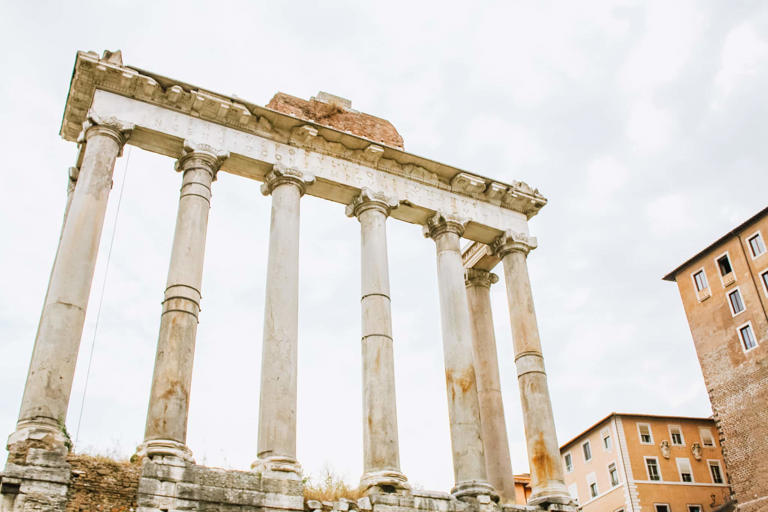
National Geographic content straight to your inbox—sign up for our popular newsletters here

Carthage was Rome’s greatest rival. Go see its side of the story.
Roman conquerors tried to erase the past of this ancient Tunisian port city—but these historic sites shed light on the true glories of Carthage.
From 650 B.C. to 146 B.C., Carthage was the most powerful trading and commercial city in the Mediterranean. Its sophisticated 200-dock harbor and wealthy population supported a sprawling metropolis of temples, markets, and estates outside present day Tunis, a 20-minute drive away. It even loomed large in Greek mythology as the home of the legendary Dido , whose racy story of forced marriage and illicit love inspired poetry, operas, and countless classical oil paintings.
But some 2,000 years ago, Carthage was razed to the ground by its rival, the Roman Republic . Carthaginians were murdered or sold into slavery, and the Romans built a new Carthage on the ruins.

Since the Romans sacked the city and destroyed most of its libraries and archives, “virtually nothing” known of the Carthaginian people has been gleaned from primary sources. “With Carthage, you’re dealing with something where there are huge holes,” says Richard Miles, author of Carthage Must Be Destroyed: The Rise and Fall of an Ancient Civilization .
Now, Carthage is seeing revitalization efforts helmed by the Tunisian Ministry of Culture and the European Union that aim to restore several Carthaginian sites, providing visitors with an improved experience and better protecting what remains of the city’s nearly lost legacy.
‘Carthage must be destroyed’
Around 200 B.C., “Carthage [was] the original Mediterranean superpower,” says Miles. Thanks to its vast control over trading ports and various North African land routes, “Carthage was the great connector. It [took] all sorts of influences—Greek, Phoenician, Italian, [and also from] the Iberian Peninsula, Nubians, and the Libyans in North Africa—and it melded them together into something that is unique.”
( Find mosaics and mystery in an outpost of the Roman Empire .)
As the Roman Republic’s power grew across the sea, however, so did its rivalry with the Carthaginians. Three wars flared between the two empires, spanning nearly a hundred years.

In 149 B.C. Rome laid siege to Carthage, burning its famed fleet before nearly leveling the city. “The destruction of Carthage was an act of vengeance,” Miles says, adding that the Romans wanted to ensure that the Carthaginians never rose again to challenge them. “ Delenda est Carthago [Carthage must be destroyed]” were words often repeated by Roman senator Cato.
Exploring ancient Carthage
Yet, Rome was unable to erase Carthage from history in its entirety, says Miles. Declared a UNESCO World Heritage site in 1979, the ancient site of Carthage, at the peak of Byrsa Hill, overlooks the Punic port that grew the city’s power. Here visitors can explore the once thriving Byrsa Acropolis, which holds a museum, a necropolis, and several remarkably maintained Carthaginian houses.
“The houses—just before the destruction [of Carthage]—are perfectly preserved. That part of the Byrsa Hill is something you have to visit for sure,” says archaeologist Stefano Cespa, who, with the German Archaeological Institute of Rome , has spent the past decade excavating Carthaginian sites around the city.

The redevelopment effort will renovate the adjacent Carthage National Museum (expected to reopen in June 2026) that will “connect the museum exhibition halls to the outdoors and the views of Carthage,” says Gabriela Carillo, an architect who is assisting the project. Other aspects of renovation will address the site’s landscape, accessibility, and environmental concerns.
From the complex on Byrsa Hill, visitors can descend to explore the crescent-shaped port that once served the Carthaginians’ impressive naval fleet. Miles adds that the port may have played a direct role in the city’s destruction since the military fleet docked there violated the treaty between the empires of Rome and Carthage. Today, the port is used only by fishing boats, and a small walking path runs around the rim.

Just down the street is the Tophet of Salammbo—a graveyard that, according to Cespa, was the burial ground for animals and children used for ritual sacrifices. However, he adds that may have been a rumor spread by the Romans and Greeks. To date, over 20,000 urns buried under stone slabs have been found here, making it one of the largest cemeteries from the Phoenician period.
( Here’s where to search for traces of the ancient Chola dynasty .)
Relics from the Roman Republic’s rule over Carthage can also be seen on the hill and around the city. The Baths of Antoninus —a sprawling complex of ruins standing beside Tunisia’s presidential palace—is one of the more popular historic sites, replete with remarkably well-preserved walls, tunnels, and porticos. Nearby is an expansive Roman theater, where visitors can observe archaeologists as they restore structures and refurbish intricate mosaics.
A short walk away are the twin sites of the Circus of Carthage , which was modeled after the Circus Maximus in Rome. Cespa and his team have been surveying these sites—called Quartier Magon and Quartier Didion—for several years. “You have almost 2,000 years of stratigraphy in these two sites,” Cespa says. “There you have all the phases of ancient Carthage, from the Phoenician foundation through the Punic age, then the Roman age and medieval, late Byzantine, and Islamic period.”
“It shows that you can’t totally destroy something,” says Miles. “There’s always a little bit of the past that survives.”
What to know
Related topics.
- WORLD HERITAGE SITES
- ANCIENT ROME
- ANCIENT HISTORY
- ANCIENT CIVILIZATIONS
- HISTORY AND CIVILIZATION
- HISTORIC SITES
You May Also Like

Searching for traces of the ancient Chola dynasty

Atlanta isn’t all that Georgia has to offer. Here are 7 other worthy trips.
Introducing nat geo kids book bundle.

10 best things to do in Ireland

An architectural tour of the Georgian capital, Tbilisi

10 whimsical ways to experience Scotland

10 best things to do in Switzerland

Indiana Jones and archaeology in Sicily: how to plan a walking tour of Syracuse
- Perpetual Planet
- Environment
History & Culture
- History & Culture
- History Magazine
- Mind, Body, Wonder
- Paid Content
- Adventures Everywhere
- Terms of Use
- Privacy Policy
- Your US State Privacy Rights
- Children's Online Privacy Policy
- Interest-Based Ads
- About Nielsen Measurement
- Do Not Sell or Share My Personal Information
- Nat Geo Home
- Attend a Live Event
- Book a Trip
- Inspire Your Kids
- Shop Nat Geo
- Visit the D.C. Museum
- Learn About Our Impact
- Support Our Mission
- Advertise With Us
- Customer Service
- Renew Subscription
- Manage Your Subscription
- Work at Nat Geo
- Sign Up for Our Newsletters
- Contribute to Protect the Planet
Copyright © 1996-2015 National Geographic Society Copyright © 2015-2024 National Geographic Partners, LLC. All rights reserved
Which AI trip planning tool is the best? Here's how Expedia's and Booking.com's compared.
- Expedia Group's Romie and Booking.com's AI Trip Planner are AI-powered travel tools that can help travelers plan and manage their trips.
- Both tools can recommend destinations, places to stay, and things to do and even create a full itinerary for your trip.
- However, these AI travel planners are still in their early stages and can't yet be relied on completely.
This new travel adviser can help travelers plan and manage their trip – and then come with them on vacation.
Expedia Group revealed a new artificial intelligence assistant last month that users can access anytime via their phones. Named Romie, the alpha version available now via Expedia’s iOS app in the U.S., can help build itineraries, summarize travel plans discussed in group chats, warn customers of trip disruptions and more.
Jeff Miller, Distinguished Product Manager at Expedia Group, said “travel is a complicated business and part of the complexity is about orchestrating and managing all the parts of your trip.” The company previously introduced a travel planning feature powered by ChatGPT last year, but the new assistant marks an expansion of its AI capabilities.
“Romie’s job is to meet you where you are, not wait for you to come,” he said. The feature uses the same OpenAI models that power ChatGPT, but Expedia is “open to using other tech or models” as well.
Make travel easy: We tested ChatGPT itineraries in 5 US tourist spots
Learn more: Best travel insurance
Romie is the latest AI-powered travel tool , joining other travel platforms utilizing the technology to make a seamless, more customized experience for travelers. In an Oct. 2023 Booking.com survey of more than 27,000 travelers across 33 countries, 56% said they want to use AI to help inform upcoming travels.
Last summer, Booking.com launched its own AI Trip Planner, which also uses ChatGPT to help travelers find accommodations and build out personalized itineraries.
“Imagine having a conversation (with) the AI Trip Planner and being able to render or change what you see (on the Booking.com website) to match the content of your conversation,” Adrienne Enggist, Senior Director of Product at Booking.com , told USA TODAY. “The hyper-personalization, really, can be supercharged to make your travel planning more productive, much easier.”
USA TODAY’s Nathan Diller and Kathleen Wong tested Romie’s itinerary-building capabilities against Booking.com’s AI Trip Planner to see what it’s like using AI to plan a trip to Rome from Sept. 9-12. Here’s what they found.
What is it like to use Romie?
I started by making a hotel booking on Expedia, which users need to use Romie’s itinerary-building features. iPhone users in the U.S. can opt-in to access the early version of Romie via the EG Labs section of the Expedia app, but the company does not yet have a public launch date.
I reserved a room at Suitedreams – just under $627 for three nights in September – with an “excellent” rating and over 1,000 reviews. Then I phoned a friend (or AI assistant, rather) to help with the rest.
When I clicked through to my itinerary, Romie suggested restaurants near the hotel unprompted, with distances listed. When I clicked on one, it took me to a chat function where I could see various restaurants’ Yelp ratings, hours of operation and other info. I could peruse certain details from there, but other buttons moved me to the Yelp app.
Romie cannot complete restaurant reservations for users, but I was able to add bookings to my itinerary by telling the chatbot when I’d be eating. Miller emphasized that Romie is not “just automatically charging your credit card on your behalf.”
“We don't think that experience is quite ready yet, let’s put it that way,” he said. “But we do think that we can still guide you to be able to take action for yourselves.”
Romie also recommended “some of the best things to do” in Rome, like the Colosseum and the Vatican Museums. The chatbot was also able to suggest bookstores when I asked and give me directions to one I selected. When I requested other activities near my hotel, Romie provided several tours I could book through the Expedia app.
I did run into some hiccups when I clicked on the Colosseum option Romie listed on my itinerary page. The AI program pulled up a “B&B in Rome 2 stops from” the landmark, even though I already had a hotel. When I clicked on the listing, it took me to what looked like an external website that suggested I book it on Airbnb – a competitor to Expedia Group’s Vrbo.
When I asked whether I needed tickets for the Vatican Museums, Romie said yes, sharing a website where I could buy them. But the URL was not hyperlinked and I could not click through, nor could I copy and paste it from my phone, meaning I’d have to manually type it into my browser.
Curious to try another method of communication, I added Romie to my phone contacts to use its text message feature. Romie was similarly able to recommend coffee shops near my hotel that way, but this time, I had to tell the bot where I was staying. Unlike in the app, it did not have my booking information.
I also requested help with booking a rental car. Romie acknowledged my parameters – my travel dates and the budget I shared – and sent me an Expedia link. However, when I clicked on it, I was shown hotel listings.
At one point, I asked for a full itinerary for my three-night trip. Romie asked about my interests – I listed food, historical sites and art – and offered a detailed plan with activity and dining suggestions for the morning, afternoon and evening. I tried that separately with the in-app chat function and was given less of a true itinerary than a list of things to do.
“Launching an early version of Romie in EG Labs provides registered participants with the opportunity to test out products and share their feedback in real-time to help Expedia troubleshoot bugs prior to public launch,” Miller said.
Romie’s other features fell outside the purview of my hypothetical trip, but Miller said the tool will get to know users’ preferences over time, with “progressive intelligence” being a key principle.
“An assistant that forgets what you told it isn't very useful, especially in a complex process like travel planning that we all know takes weeks or sometimes months,” he said. “So, that notion that Romie’s learning as it goes and remembering is very important to what we think an assistant needs to do.”
Based on my test run with the current version of Romie, I’d recommend it to travelers as a starting point for generating ideas and tracking itinerary items of interest. However, given the apparent glitches in the user experience, I wouldn’t rely solely on the tool.
– Nathan Diller
How to use AI to plan a vacation: And what you should know first
What’s it like to use Booking.com’s AI Trip Planner?
Booking.com’s AI Trip Planner is only accessible via the Booking.com mobile app in English-speaking markets, including the U.S., U.K., Australia and New Zealand. Once I created an account, a pop-up screen prompted me to “start chatting” with the AI Trip Planner. The AI tool greeted me and asked how it could help my trip planning – it also warned me that it’s “still learning.”
According to Enggist, the AI language model is still in its “early discovery, early planning space.” It acts like a well-traveled friend who can provide guidance based on your answers, interests and tastes. The tool can recommend destinations, places to stay, and things to do and even create a full itinerary for your trip.
“It’s less about generating search results and more about curating lists of things that are potentially ideal for you,” she said.
In the future, Booking.com hopes to “extend the helper all the way through the journey,” like updating your ground transportation if your flight is delayed, Enggist said.
I asked the AI Trip Planner to find me a hotel room in Rome for three nights in September, and it asked for specifics, like a preferred location or type of hotel. I said it would be my first time, and I didn’t know where to start. The tool responded with three hotel options, all of which are based in Rome’s city center, highly rated and cost between $264 and $602 for the stay.
While I could learn more about the hotels and read their reviews on the app, I couldn’t book directly through the AI Trip Planner. For that, I’d have to go to the hotel’s page on the app or website. I also couldn’t book a rental car through the AI Trip Planner.
I then asked the AI Trip Planner to come up with things for me to do during my trip, and it gave me eight “popular attractions and activities,” such as visiting the Colosseum and the Pantheon – typical Rome must-dos. I asked if the tool could help me get tickets to the Colosseum, and it told me that I had to visit the website for the Colosseum or a third-party vendor like Viator to do so.
“The AI Trip Planner makes recommendations that are more niche or more hidden gems,” Enggist said. However, I found that even when I gave more specifics about what to do – like if I were a foodie – the first results were still the most popular or famous choices, which also means crowds and often overly touristy places.
When I asked for vegan restaurant recommendations, it gave me five. Although there were no links for me to learn more or how to contact the restaurants, I was able to ask for more detailed descriptions, like what I could expect from their menu and the atmosphere.
I asked the AI Trip Planner to help me get from one of the recommended hotels to one of the suggested vegan restaurants. I was pleasantly surprised at how detailed the results were: I was told the stations and lines if I wanted to use the metro, or take a 20-minute walk “through some of Rome’s most beautiful neighborhoods.”
Finally, I asked the AI Trip Planner to give me a three-day itinerary in Rome if I love food and am vegan. It broke down each day into the morning, lunch, afternoon and dinner, including what to do and where to eat each meal. The itinerary is a good starting point for travelers, but since it told me to visit the Colosseum and Roman Forum in the afternoon – which is peak visiting time – I’m not sure it accounts for crowds or long lines.
While I wouldn’t depend on the AI Trip Planner for my complete trip itinerary, I would certainly turn to it for help finding accommodations and initial ideas in the beginning stages of my trip planning.
If I were hoping to go on a beach vacation and had a budget in mind but no destination, this is where chatting with the AI Trip Planner would come in handy. I also liked how it helped narrow down my hotel options based on location and price, which is sometimes a challenging yet essential part of planning a vacation. Based on the vagueness of the AI Trip Planner when asked about day-to-day activities, I likely wouldn’t use the tool for restaurant recommendations or things to do since you need to leave the platform to book or get further details anyway.
These AI travel planners are designed to personalize and simplify the travel planning process. Although they aren't yet at the stage where you can rely on them completely, only time will tell.
– Kathleen Wong
The Key Points at the top of this article were created with the assistance of Artificial Intelligence (AI) and reviewed by a journalist before publication. No other parts of the article were generated using AI. Learn more .

IMAGES
VIDEO
COMMENTS
Find & Book the Best Rome Itinerary. Attractions, Activities, Excursions & More in Rome. Quick & Easy Purchase Process! Full Refund Available up to 24 Hours Before Your Tour Date
Official Site. Best Tours, Best Prices. Guaranteed. Browse Our Top Rated Tours. Elevate Your Cruise Experience With Fun & Unique Shore Excursions. Book Today.
A perfect one day Rome itinerary should be carefully planned. From the Vatican landmarks to the sights of Ancient Rome, this city owns some of the well known tourist attractions in Europe - monuments, religious sites, museums and squares. While all are well worth a visit, careful and experienced planning is the key for a successful trip, especially when all you have is one day.
Discover Rome with free itineraries, guides and maps from Visit A City. Explore the best attractions, museums, churches and more in the Eternal City.
Exploring Rome in 6 days can be a great adventure but you have to know what you are looking to see before you start planning your itinerary. Are you interested mostly in Rome's top attractions such as the Vatican churches, the Colosseum and the famous Piazzas or perhaps it is the less visited sites that you seek to explore? Take a look below and see several suggested pre-planned 6 days Rome ...
A visit to Rome in 5 Days will allow a visit to many of the glorious sights, landmarks and attractions of the capital of Italy. You may choose to spend your time enjoying Rome's top attractions attractions while walking through the charming piazzas or visit some of the best art museum in Europe. Take a look below at the 5 Days pre-planned itineraries you can use when planning a trip to Rome ...
Popular Sightseeing, Tours & Activities. If you are planning a 3 days visit to Rome, here are some itineraries you can start planning your trip with. Should it be all around the must-sees such as the Colosseum and the sights of the Vatican or perhaps you are looking to do some shopping along the way? Take a look below at the suggested ...
This pre-planned 3 days Rome itinerary will allow you to explore Rome's must-sees, landmarks, museums and attractions. See how you can make the best out of a 3 days stay in Rome as you make your way through the Sistine Chapel with its world famous ceiling fresco, the Vatican Museums, the Colosseum and all other Rome's attractions - religious and imperial.
Today you get to visit one of the world's most popular attractions (the Colosseum), stroll through ancient Rome, take in the view from one of the best viewpoints in the city, and end the day with dinner with a view. Here is an overview of the itinerary: 9:00 am: The Colosseum. 10:30 am: Roman Forum & Palatine Hill.
Start at 9:00 at the Colosseum. Then explore the Forum (skip the Palatine Hill), hike over Capitoline Hill, and cap your "Caesar Shuffle" with a Pantheon visit. After a quick lunch, taxi to the Vatican Museums, then head to St. Peter's Basilica (open until 19:00 April-Sept). Taxi back to Campo de' Fiori for dinner, then finish your day lacing ...
Tours & Sightseeing. from $20.28. Take your time in this 2 days low pace itinerary of Rome's top attractions. Visit all the important landmarks such as the Sistine Chapel, the Colosseum and St. Peter's Basilica in your own pace and without a rush. For those who seek for a truly relaxed vacation and plan to spend 2 days in Rome - this plan may ...
3 Days in Rome Itinerary Rome Itinerary Day 1. Colosseum, Roman Forum, Altar of the Fatherland, Trastevere. Ciao! Welcome to Rome! Today you get to visit one of the world's most popular attractions (the Colosseum), stroll through ancient Rome, take in the view from one of the best viewpoints in the city, and end the day with dinner with a view.
4 Days in Rome Itinerary 4 Days in Rome Itinerary: Day 1. Colosseum, Roman Forum, Altar of the Fatherland, Trastevere. Ciao! Welcome to Rome! Today you get to visit one of the world's most popular attractions (the Colosseum), stroll through ancient Rome, take in the view from one of the best viewpoints in the city, and end the day with dinner with a view.
Best Things to Do with One Day in Rome. One Day in Rome Itinerary Options. One Day in Rome: Itinerary #1. 7:30 am: Early Morning Tour of Vatican City. 10:30 am: St. Peter's Basilica. 11:30 am: Lunch. 12:15 pm: Travel to the Colosseum. 12:45 pm: The Colosseum. 2:15 pm: Roman Forum & Palatine Hill.
Stroll to the Spanish Steps. 21-minute walk from Galleria Borghese. After a stop off at the Galleria Borghese and possibly the Capuchin Crypt, most of the second day of this 4 day Rome itinerary focuses on iconic Roman sights and popular tourist highlights, starting with the famed Spanish Steps. READ NEXT.
Overview: how to see Rome in 5 days. Day 1: Colosseum, Altare Alla Patria & Trevi Fountain. Day 2: Vatican Museums, Chapel Sistine & St Peter's Basilica. Day 3: Roman Forum, Pantheon & Piazza Navona. Day 4: Trastevere, Piazza Santa Maria & Janiculum Hill. Day 5: Piazza di Spagna, Piazza del Popolo & Villa Borghese.
Discounted entry at over thirty other sights in Rome, including the Baths of Caracalla and Appia Way attractions. A 72 hour travelcard for Rome which covers all the major public transport, including buses, trams and metro. A 3 Day Hop-on Hop-off Bus ticket. A detailed guidebook to Rome and map of the city.
What's in this article. 5 days in Rome overview and highlights. Day 1 - Explore the Centro Storico. Day 2 - Ancient Rome. Day 3 - Villa Borghese, the Tiber and more. Day 4 - Vatican. Day 5 - Roman secrets or a day trip. Practical information. Our final thoughts on Rome.
TIP: If you need airport transfers to/from the city center, you can find all the best options here (by train, bus, or pre-booked taxi). ROME 4 DAYS ITINERARY & TIPS: DAY 1: Historic Center, Colosseum, several hidden gems, Trastevere. DAY 2: The Vatican, Food Tour & Jewish Quarter.
2 Days in Rome: An Itinerary. Day 1 in Rome. Our first day in Rome has you exploring some of Rome's most famous sights, from stunning 2,000 year old gladiatorial arenas to Renaissance artwork. Colosseum. First on the itinerary for your time in Rome is a visit to the mighty Colosseum. For over two thousand years this has been a landmark ...
48-hour ticket (€12.50/$15) - Two days of unlimited travel on any public transportation from the moment of validation. 72-hour ticket (€18/$21.50) - Three days of unlimited travel on any public transportation in Rome from the moment of validation.
Roma 24H/48/72H Ticket: This is valid 24, 48, and 72 hours after activation, respectively, costing 7€, 12.5€, and 18€. I highly recommend getting the 72-hour ticket for this 3 days in Rome itinerary. CIS Ticket: With this ticket of 24 € you can travel for 7 days on the tram, bus, and metro.
How to use this 1 day in Rome itinerary. Stop 1 of our one day in Rome itinerary: Colosseum (and Forum) Stop 2: Piazza Venezia and Campidoglio. Stop 3 - lunch. Stop 4 - The Pantheon. Stop 5 - Piazza Navona and Campo de' Fiori. Stop 6 - Spanish steps and Trevi fountain. Stop 7 - dinner.
A great city pass option in Rome is the "Explore Go Rome" pass via Go City. With it, you're able to visit more than 40+ attractions in Rome for free, saving up to 50% vs buying individual tickets. It includes free entry to the Vatican, the Colosseum, Hop on Hop off bus, Italian Cooking Class, the Catacombs, and more.
Travel guide of Rome with up to date tourist and general information on the city: accommodation, transport, maps, activities and top attractions. ... 3-Day Itinerary 3-Day Itinerary; Map Map; Day trips and guided tours Airport transfers ... the city of Rome would always remain standing.
For first timers to Italy, Rome, Florence and Venice typically top the "must-see" list. On this 10 day Italy itinerary, you have enough time to visit these three cities and add in another spectacular destination, the coastal towns of the Cinque Terre.
14 Day Italy Itinerary: Day 3. Vatican City & the Borghese Art Gallery. This day exactly follows Day 2 of our 2 Day in Rome itinerary. I recommend referring to this itinerary for more details, lunch recommendations, and the walking route from Vatican City to the Borghese Gallery. Morning: Vatican City. Vatican City is the smallest country in ...
10 Days in Italy: 5 Itineraries Italy Itinerary #1: The Classic. Our classic Italy itinerary includes Rome, Florence, and Venice, and the Cinque Terre. It's a great option if this is your first visit to Italy, since you get to visit three of Italy's most popular cities along with a visit to a spectacular coastal destination.
Visit This Budget-Friendly Neighborhood Gem Blending right into the old-age Neoclassical facades that make up much of Rome's cityscape, Bar San Calisto can be all too easy to miss by those not ...
Here are the best ruins to add to your Rome itinerary. Pro Tip: Save money visit Rome's museums and ancient sites with the Go City Pass. You can get the Explorer Pass and choose how many of the ...
From 650 B.C. to 146 B.C., Carthage was the most powerful trading and commercial city in the Mediterranean. Its sophisticated 200-dock harbor and wealthy population supported a sprawling ...
Make travel easy:We tested ChatGPT itineraries in 5 US tourist spots. ... The tool responded with three hotel options, all of which are based in Rome's city center, highly rated and cost between ...